PLM 10000Q, 14000, 20000Q Brochure
User Manual: PLM 10000Q, PLM 14000, PLM 20000Q - Brochure
Open the PDF directly: View PDF ![]() .
.
Page Count: 106 [warning: Documents this large are best viewed by clicking the View PDF Link!]
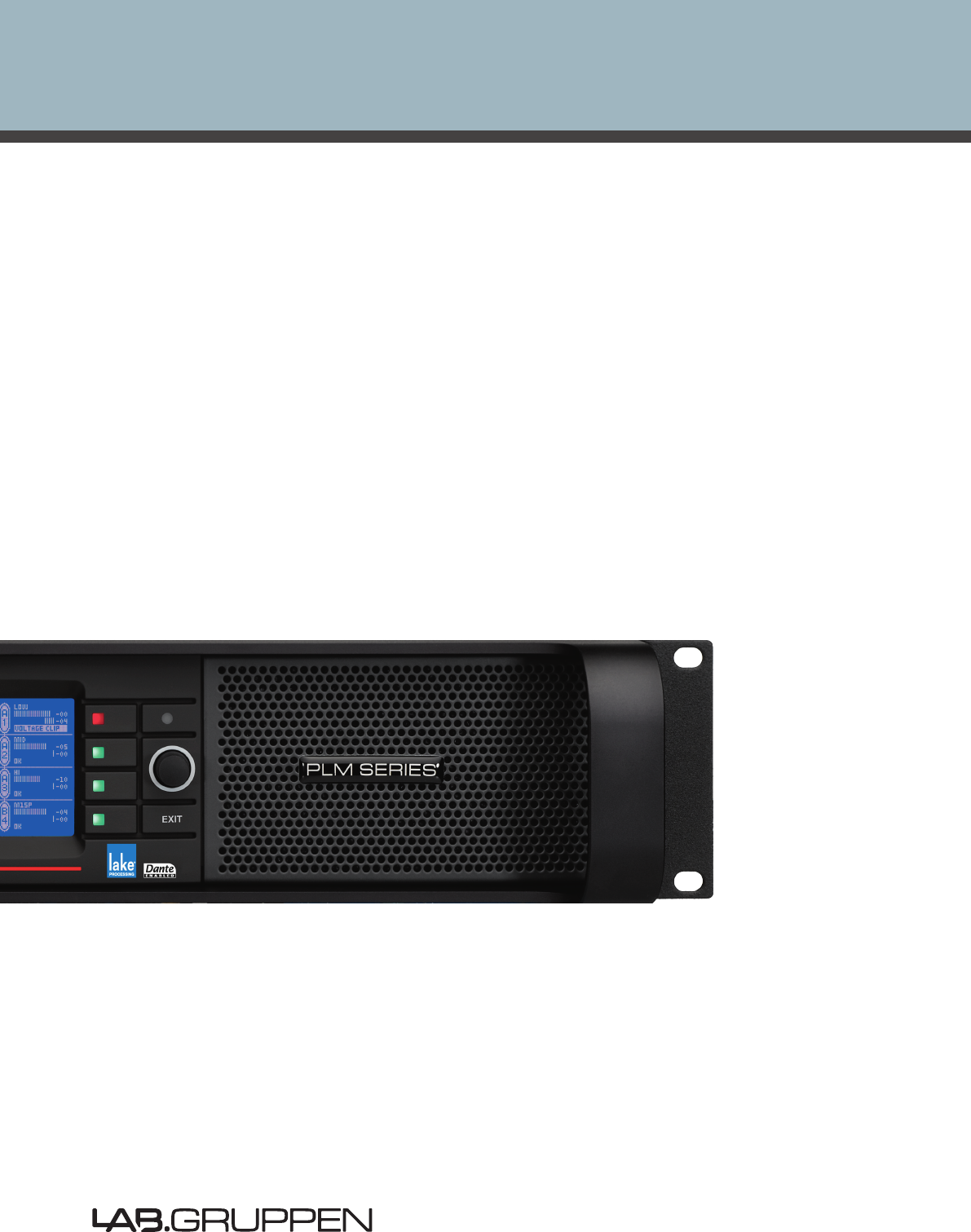
Operation Manual
PLM™ Series
Powered Loudspeaker Management™ systems
Operation Manual
Rev 1.3.0
Item: OM-PLM
Operation Manual
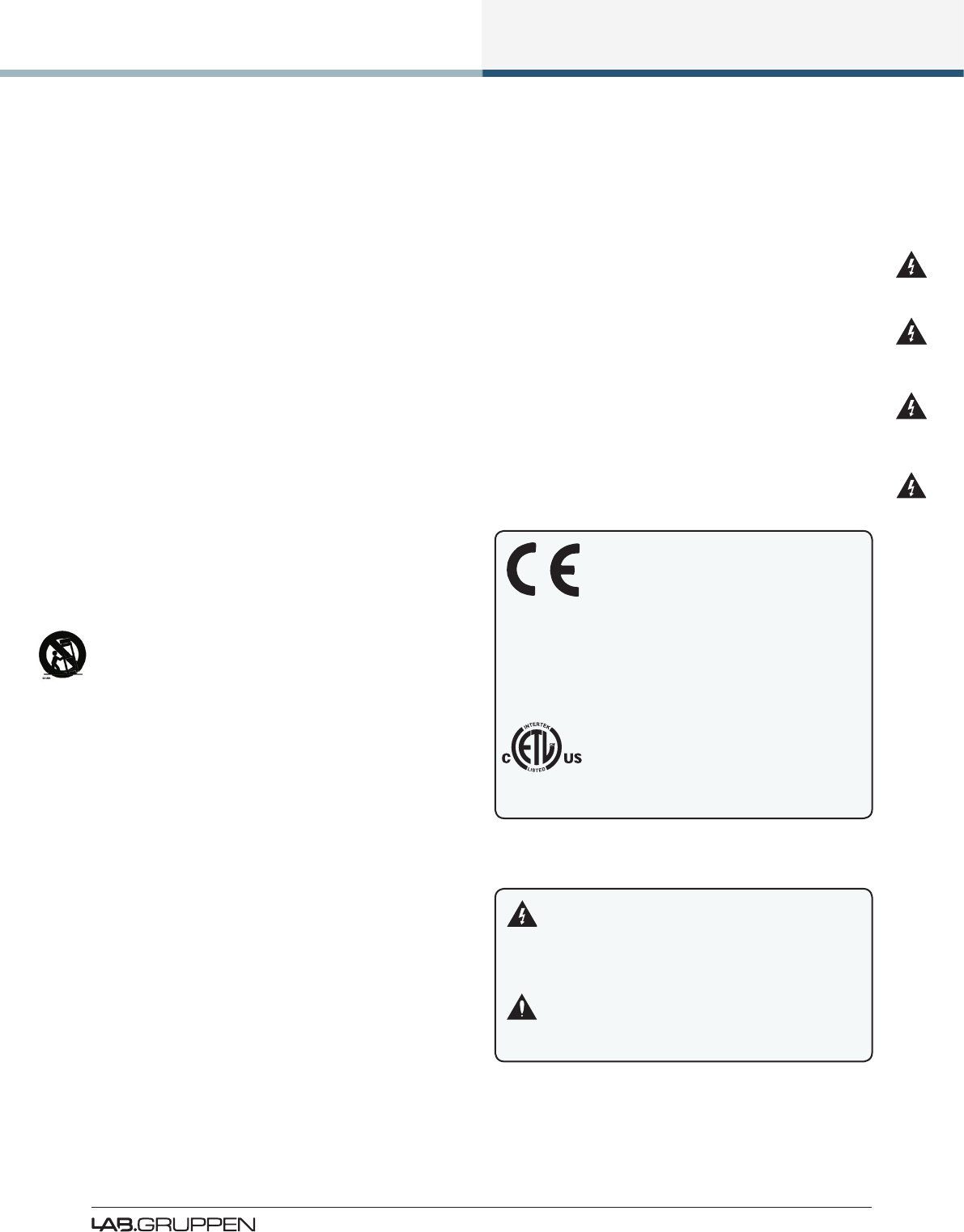
Important Safety Instructions
i
PLM Series Operation Manual Rev 1.3.0
1. Important Safety Instructions
Before using the device, be sure to carefully read the Safety Instructions. Keep this document with the device at all times.
1.1 Important Safety Instructions
1. Read these instructions.
2. Keep these instructions.
3. Heed all warnings.
4. Follow all instructions.
5. Do not use this apparatus near water.
6. Clean only with a dry cloth.
7. Do not block any ventilation openings. Install in accordance
with the manufacturer’s instructions.
8. Do not install near any heat sources such as radiators, heat
registers, stoves, or other apparatus (including ampliers)
that produce heat.
9. Do not defeat the safety purpose of the polarized or
grounding-type plug. A polarized plug has two blades with
one wider than the other. A grounding-type plug has two
blades and a third grounding prong. The wide blade or
the third prong is provided for your safety. If the provided
plug does not t into your outlet, consult an electrician for
replacement of the obsolete outlet.
10. Protect the power cord from being walked on or pinched,
particularly at plugs, convenience receptacles, and the point
where they exit from the apparatus.
11. Only use attachments/accessories specied by the
manufacturer.
12. Use only with a cart, stand, tripod, bracket, or table specied
by the manufacturer, or sold with the apparatus. When a
cart is used, use caution when moving the cart/apparatus
combination to avoid injury from tip-over.
13. Unplug this apparatus during lightning storms or when
unused for long periods of time.
14. Refer all servicing to qualied service personnel. Servicing
is required when the apparatus has been damaged in any
way, such as power-supply cord or plug is damaged, liquid
has been spilled or objects have fallen into the apparatus, the
apparatus has been exposed to rain or moisture, does not
operate normally, or has been dropped.
15. Use the mains plug to disconnect the apparatus from the
mains.
16. WARNING: To reduce the risk of re of electric shock, do not
expose this apparatus to rain or moisture.
17. Do not expose this equipment to dripping or splashing and
ensure that no objects lled with liquids, such as vases, are
placed on the equipment.
18. The mains plug of the power supply cord shall remain readily
operable.
19. Do not connect the unit’s output to any other voltage source,
such as battery, mains source, or power supply, regardless
of whether the unit is turned on or off.
20. Do not remove the top (or bottom) cover. Removal of the
cover will expose hazardous voltages. There are no user
serviceable parts inside and removal may void the warranty.
21. An experienced user shall always supervise this professional
audio equipment, especially if inexperienced adults or
minors are using the equipment.
22. The US National Differences clause 16.3 requires that
network cables must be ame rated VW-1.
To prevent electric shock do not remove top or bottom covers.
No user serviceable parts inside, refer servicing to qualied
service personnel.
À prévenir le choc électrique n’enlevez pas les couvercles. Il n’y a
pas des parties serviceable à l’intérieur, tous reparations doit etre
faire par personnel qualié seulment.
To completely disconnect this equipment from the AC mains,
disconnect the power supply cord plug from the AC receptacle.
The mains plug of the power supply cord shall remain readily
operable.
Pour démonter complètement l’équipement de l’alimentation
générale, démonter le câble d’alimentation de son réceptacle. La
prise d’alimentation restera aisément fonctionnelle.
1.2 Standards
This equipment conforms to the require-
ments of the EMC Directive 2004/108/EC
and the requirements of the Low Voltage
Directive 2006/95/EC.
Standards applied: EMC Emission
EN55103-1, E3
EMC Immunity EN55103-2, E3, with S/N
below 1% at normal operation level.
Electrical Safety EN60065, Class I
This equipment is tested and listed accord-
ing to the U.S. safety standard ANSI/ UL
60065 and Canadian safety standard CSA
C22.2 NO. 60065. Intertek made the tests
and they are a Nationally Recognized Test-
ing Laboratory (NRTL).
1.3 Explanation of Graphical Symbols
The lightning bolt triangle is used to alert the user to
the presence of un-insulated “dangerous voltages”
within the unit’s chassis that may be of sufcient
magnitude to constitute a risk of electric shock to
humans.
The exclamation point triangle is used to alert the
user to presence of important operating and service
instructions in the literature accompanying the
product.
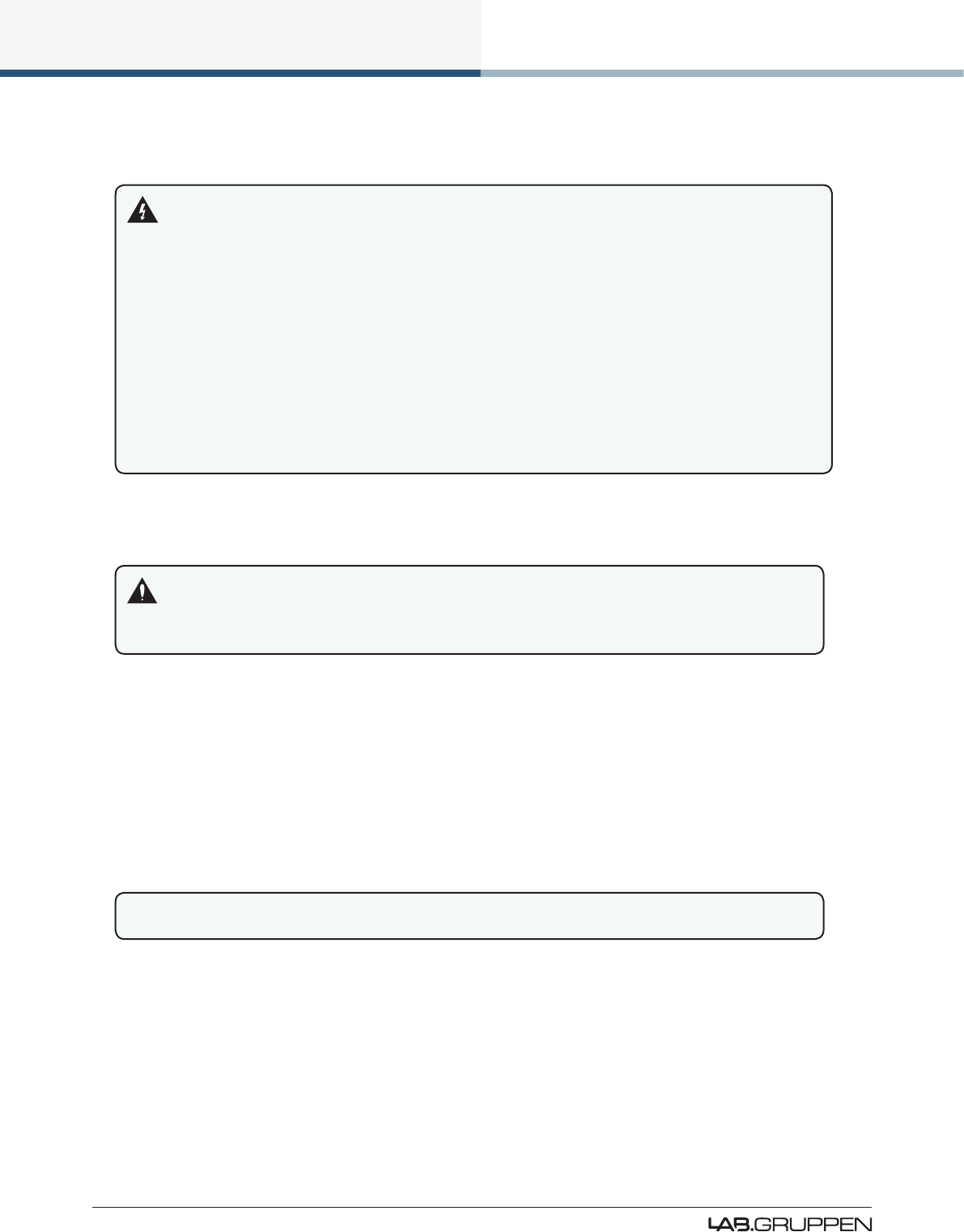
ii
Important Safety Instructions
PLM Series Operation Manual Rev 1.3.0
1.4 WARNING
To reduce risk of re or electric shock, do not expose this apparatus to rain or moisture.
Pour réduire les risques de blessure ou le choc électrique, n’exposez pas l’appareil à la pluie ou à l’humidité.
Do not expose this system/apparatus to dripping or splashing and ensure that no objects lled with liquids, such
as vases, are placed on the apparatus.
L’appareil ne doit pas être exposé à des egouttements d’eau ou des éclaboussures et de plus qu’aucun objet
rempli de liquide tel que des vases ne doit pas être placé sur l’appareil.
This apparatus must be connected to a mains socket outlet with a protective earthing connection.
Cet appareil doi t être raccordé á une prise de courant qui est branchée à la terre.
The mains plug is used as a disconnect device and shall remain readily operable.
Lorsque la prise du réseau d’alimentation est utilisés comme dispositif de déconnexion, ce dispositif doit
demeuré aisément accessible.
1.5 CAUTION
To reduce the risk of re or electric shock, do not remove screws. No user-serviceable parts inside.
Refer servicing to qualied service personnel.
Pour réduire le risque d’incendie ou de choc électrique, ne pas retirer les vis. Aucune pièce réparable par
l’utilisateur. Coner l’entretien àpersonnel qualié.
1.6 FCC Compliance Notice (Radio Interference)
A sample of this product has been tested and complies with the limits for the European Electro Magnetic
Compatibility (EMC) directive. This equipment has also been tested and found to comply with the limits for a
Class A digital device, pursuant to Part 15 of the FCC Rules. These limits are designed to provide reasonable
protection against harmful interference from electrical equipment. This product uses radio frequency energy
and if not used or installed in accordance with these operating instructions, may cause interference to other
equipment, such as radio receivers.
This Class A digital apparatus complies with Canadian ICES-003.
Cet appareil numérique de la classe A est conforme à la norme NMB-003 du Canada.
However, there is no guarantee that interference will not occur in a particular installation. If this equipment
does cause harmful interference to radio or television reception, which can be determined by turning the
equipment on and off, the user is encouraged to try to correct the interference by one or more of the
following measures:
▸Reorient or relocate the antenna.
▸Increase the separation between the equipment and receiver.
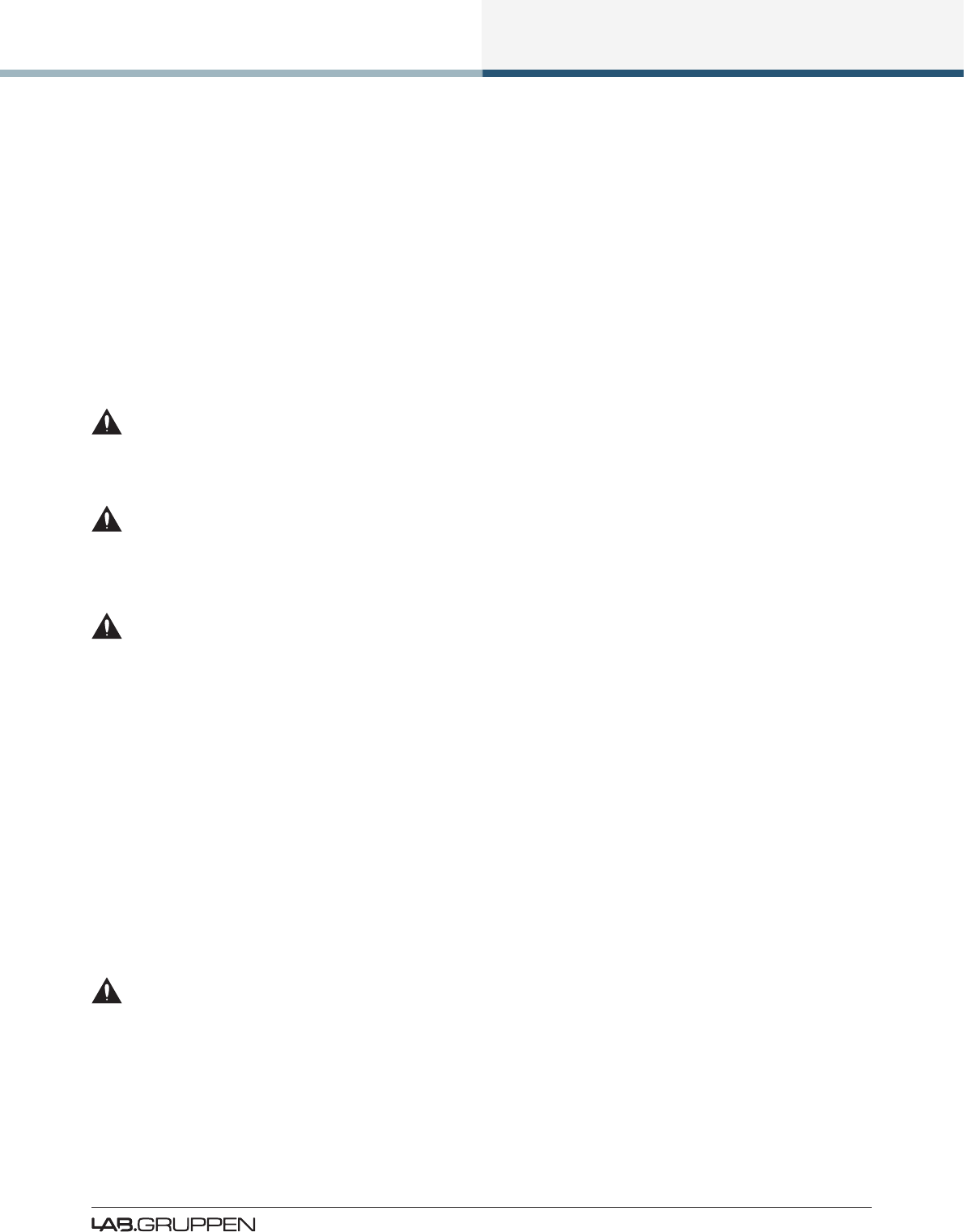
Important Safety Instructions
iii
PLM Series Operation Manual Rev 1.3.0
▸Connect the equipment to an outlet on a circuit different from that to which the receiver is connected.
▸Check if the affected unit complies with the EMC limits for immunity, (CE-labeled). If not, address the
problem with the manufacturer or supplier. All electrical products sold in the EC must be approved for
immunity against electromagnetic elds, high voltage ashes, and radio interference.
▸Consult the dealer or an experienced radio/TV technician for help.
1.7 User Responsibility
1.7.1 Mains Connection Grounding
Your apparatus must be connected to a grounded socket outlet.
1.7.2 Speaker Output Hazard on Ampliers
Ampliers are capable of producing hazardous output voltages. To avoid electrical shock, do not touch
any exposed speaker wiring while the amplier is operating. The external wiring connected to the speaker
terminals shall be installed by a qualied person, or ready-made leads or cords of appropriate capacity shall
be used.
As the power output channels on ampliers produce high voltage, do not connect or disconnect
speaker cables when the mains power is on.
1.7.3 Speaker Damage
Amplier apparatus is very powerful and can be potentially dangerous to both loudspeakers and humans
alike. Many loudspeakers can be easily damaged or destroyed by overpowering them. Always check the
speaker’s continuous and peak power capabilities. Although the ampliers attenuators can be used to
reduce the overall gain, an increase of the input signal can result in full output power, which may cause
damage to connected speakers.
1.7.4 Maintenance
For safe and reliable operation, the dust lters on both sides of the front panel, behind the grilles, should be
removed and cleaned regularly to ensure maximum airow through the device.
If the dust lters are not maintained there will be safety risks; for example, high internal temperatures
could ignite the dust and start a re. There is also a risk that the unit will malfunction since it is dependent
on constant airow from front to rear. If the dust lters are not clean and the unit malfunctions, any resulting
problems will not be covered by the warranty.

iv
PLM Series Operation Manual Rev 1.3.0
Table of Contents
1. Important Safety Instructions ................................................................................................................i
1.1 Important Safety Instructions ............................................................................................................... i
1.2 Standards .............................................................................................................................................. i
1.3 Explanation of Graphical Symbols ......................................................................................................... i
1.4 WARNING ............................................................................................................................................ ii
1.5 CAUTION ............................................................................................................................................. ii
1.6 FCC Compliance Notice (Radio Interference) ....................................................................................... ii
1.7 User Responsibility ..............................................................................................................................iii
2. Welcome ...................................................................................................................................................1
2.1 Introduction .........................................................................................................................................1
2.2 Main Features ......................................................................................................................................1
2.3 Additional Documentation ....................................................................................................................3
3. Installation ................................................................................................................................................4
3.1 Unpacking ............................................................................................................................................4
3.2 Mounting .............................................................................................................................................. 4
3.3 Cooling .................................................................................................................................................6
3.4 Operating Voltage ................................................................................................................................6
3.5 Grounding ............................................................................................................................................. 7
4. Product Overview ....................................................................................................................................8
4.1 Front Panel Overview ........................................................................................................................... 8
4.2 Back Panel Overview ......................................................................................................................... 11
5. Operation and Performance .................................................................................................................15
5.1 Operation Precautions ........................................................................................................................ 15
5.2 Power Output Performance ............................................................................................................... 15
5.3 Amplier and Load Protection Systems ............................................................................................. 17
5.4 Power Supply .....................................................................................................................................24
6. Signal Flow and Lake® Processing .......................................................................................................25
6.1 Signal Flow ........................................................................................................................................25
6.2 Level Adjustments & Mute Points ..................................................................................................... 25
6.3 Lake Processing and Control ..............................................................................................................27
6.4 Modules and Frames ........................................................................................................................27
6.5 Loudspeaker Processor Overview .....................................................................................................28
6.6 Files and Presets ................................................................................................................................29
7. Front Panel Interface .............................................................................................................................31
7.1 Overview ............................................................................................................................................31
7.2 Front Panel Key Lock ..........................................................................................................................32
7.3 Power Button ..................................................................................................................................33

v
PLM Series Operation Manual Rev 1.3.0
7.4 Mute Enable Button ..........................................................................................................................33
7.5 Meter Button .....................................................................................................................................33
7.6 Menu Button ......................................................................................................................................33
7.7 Exit Button ........................................................................................................................................34
7.8 Dynamic Buttons, Controls and LEDs ................................................................................................34
7.9 Warning and Fault Indications ............................................................................................................39
7.10 Meter Mode .......................................................................................................................................42
7.11 Menu Mode .......................................................................................................................................46
8. Back Panel Interface ..............................................................................................................................63
8.1 Speaker Outputs ................................................................................................................................63
8.2 Analog Inputs and Outputs ................................................................................................................68
8.3 AES3 Digital I/O ................................................................................................................................70
8.4 RJ45 etherCON Network Connections .............................................................................................. 71
8.5 Power Inlet .........................................................................................................................................72
9. Appendix .................................................................................................................................................73
9.1 Faults and Warnings Overview ..........................................................................................................73
9.2 Maintenance ......................................................................................................................................77
9.3 Factory Default Settings.....................................................................................................................77
9.4 Current Draw and Thermal Dissipation Specications .......................................................................78
9.5 Glossary of Terms, Acronyms and Abbreviations ..............................................................................82
10. Application Guide ..................................................................................................................................85
10.1 Rack I/O Panels ..................................................................................................................................85
10.2 Power Distribution..............................................................................................................................85
10.3 Gain Structure ....................................................................................................................................86
10.4 Gain / Level Optimization ...................................................................................................................88
10.5 Speaker Congurations ......................................................................................................................91
10.6 Digital Audio Connections ..................................................................................................................92
10.7 Digital Clock Conguration .................................................................................................................95
11. Technical Specications .......................................................................................................................97
12. Warranty and Support ..........................................................................................................................98
12.1 General ..............................................................................................................................................98
12.2 International Warranties .....................................................................................................................98
12.3 Technical Assistance and Service ......................................................................................................98
12.4 Trademarks .........................................................................................................................................99

Welcome
1
PLM Series Operation Manual Rev 1.3.0
2. Welcome
2.1 Introduction
Thank you for choosing the Lab.gruppen PLM Series of Powered Loudspeaker Management systems for
your sound reinforcement needs. We are condent that you will be pleased with the performance, unique
features, conguration exibility, reliability, and long-term durability offered by this product.
For fast installation and use of this product, your welcome package includes a printed copy of the
PLM Series Quick Start & Field Reference Guide which contains the information required to safely install the
product and place it in service. Control and editing features are accessible via the front panel interface or via
the included Lake Controller software.
It is recommend that the Quick Start & Field Reference Guide and all product documentation on the
included CD-ROM is reviewed to ensure familiarity with the various conguration and control options.
Thank you again for placing your condence in Lab.gruppen products.
2.2 Main Features
The PLM Series incorporates a number of sophisticated technologies to ensure the best possible perfor-
mance and many years of reliable operation. The following section summarizes the benets of each feature;
additional information is available in the reference manuals.
2.2.1 Amplier Platform
The PLM Series power output section has expanded upon Lab.gruppen’s robust, road-proven
FP+ Series ampliers. Features in common with the FP+ Series include extraordinary power density,
patented Class TD® output stages, Regulated Switch Mode Power Supply (R.SMPS™), the high-efciency
Intercooler® copper-nned cooling system, and a full suite of protection features. Signal inputs are analog,
AES digital, and Dante digital audio network; loop-through outputs or redundant pairs are provided for each
input type.
Please refer to section 5.3 for further information.
2.2.2 Amplier DSP (Digital Signal Processor)
Various features of PLM Series devices are controlled by the on-board DSP, some of which are summarized
in this section.

2
Welcome
PLM Series Operation Manual Rev 1.3.0
2.2.2.1 Input Gain (Sensitivity)
Input gain (sensitivity) is set in the digital domain for PLM Series devices, and may be controlled via the
Lake Controller software or front-panel interface.
2.2.2.2 ISVPL
™
The Inter-Sample Voltage Peak Limiter (ISVPL) tailors each power output to the characteristics of the
connected load. Please refer to section 5.3.1 for further information.
2.2.2.3 Load Verication & Performance Monitoring
A comprehensive set of proprietary DSP-based tools are provided for load verication and real-time perfor-
mance monitoring. These functions utilize LoadLibrary, a comprehensive database for each loudspeaker
component of the connected load (usually one or more band-limited drivers in a multi-way system).
Using this data and a brief test signal, LoadSmart compares actual response to predicted response, identify-
ing any malfunctioning components or connection errors. During the performance, SpeakerSafe™ monitors
real-time load status, including temperatures of the PLM amplier stages as well as magnets and voice
coils of connected loudspeakers. This allows operators to avoid power compression and identify potential
problems.
Please refer to the Lake Controller Operation Manual for detailed information on PLM Series load verication
and real-time performance monitoring functionality.
2.2.3 Lake Processing and Controller
PLM Series devices integrate seamlessly into the Lake Processing environment and are accessible via the
Lake Controller software. Processing modules offer precise settings for gain, delay, crossover settings,
equalization and limiting. Lake processing features incorporated in each module include Raised Cosine
Equalization™, linear phase crossovers, and LimiterMax™ loudspeaker protection. The Super Module feature
allows hardware processing modules in two or more separate devices to function as a single module in the
Lake Controller software. Please refer to the Lake Controller Operation Manual for further information.
2.2.4 Analyzer Plug-In
Lake Controller software provides integration with third-party real-time analyzers, providing simultaneous
measurement display and EQ adjustment via the Lake Controller. Approved analyzers include Rational
Acoustics Smaart 7 and WaveCapture Live‐Capture Light or Live-Capture Pro; additional third-party analyz-
ers may be approved in the future.
Please refer to the Lake Controller Operation Manual for further information regarding the Analyzer plug-in
and associated functionality.

Welcome
3
PLM Series Operation Manual Rev 1.3.0
2.2.5 Dante™ Audio Network
PLM Series devices include Dante digital audio networking as standard. Utilizing the latest advances in
Ethernet technology, Dante offers simplied system conguration and extremely low latency while deliver-
ing very high quality uncompressed digital audio across the Lake network. The Zen™ automatic conguration
feature enables plug-and-play setup without third-party DHCP or DNS servers. Dante is compatible with
high-bandwidth networks, allowing large numbers of audio channels to be distributed alongside control and
analyzer data.
2.3 Additional Documentation
This document, the PLM Operation Manual, serves as the primary reference source for detailed informa-
tion on the installation and operation of PLM Series Powered Loudspeaker Management systems. It also
provides detailed information on set-up and conguration using the front-panel interface.
If you intend to use the device as part of a networked system, or access features via the Lake Controller,
please refer to the various supporting documents which can be located via these methods:
▸Start > Programs > Lake Controller > Documentation (after installing Lake Controller software)
▸On the Installer CD-ROM or the downloaded software installer
▸Online at: http://labgruppen.com/index.php/products/documentation/

4
Installation
PLM Series Operation Manual Rev 1.3.0
3. Installation
3.1 Unpacking
Carefully open the shipping carton and check for any damage to the device or the supplied accessories.
Every Lab.gruppen product is tested and inspected before leaving the factory and should arrive in perfect
condition. If any damage is discovered, please notify the shipping company immediately. Only the consignee
may initiate a claim with the carrier or their insurers for damage incurred during shipping. Save the carton
and packing materials for the carrier’s inspection.
In addition to the PLM Series device, the shipping carton include the following items:
▸PLM Series Quick Start & Field Reference Guide
▸AC mains lead (power cable) with Neutrik® powerCON® connector
▸Rear brackets for additional rack support (pair) along with associated mounting hardware
▸Software Installer and Documentation CD-ROM
Please keep the original carton and associated packaging to facilitate shipping of the device should the need
arise.
3.2 Mounting
Airow for cooling the device is from front panel (intake) to rear panel (exit). Please ensure that no object,
such as rack doors or lids are placed at the front or rear of the rack to ensure that airow is maximized. This
device has no top or bottom vents and therefore may be stacked directly on top of each other.
Sufcient space should be available at the front of the rack to accommodate the handles, and at the rear to
accommodate connectors and cables; allowance must be made for cable or loom bends within a rack.
3.2.1 Rear Mounting
Two rear support brackets along with associated mounting hardware are included with the PLM, as shown
in Figure 3-1; it is recommended that these are used wherever possible. Fit the brackets to the vertical rails
at the rear of the rack. Figure 3-2 and Figure 3-3 show the tting options for xed and removable installation.
The support brackets are reversible and may be tted to point either to the front or rear of the rack; the
orientation used depends on the rack depth and position of the rear rack rails.
Two mounting methods are possible; note that the method shown in Figure 3-2 additionally provides extra
security against unauthorized removal. For situations where rapid removal and replacement is required, the
method shown in Figure 3-3 should be used.
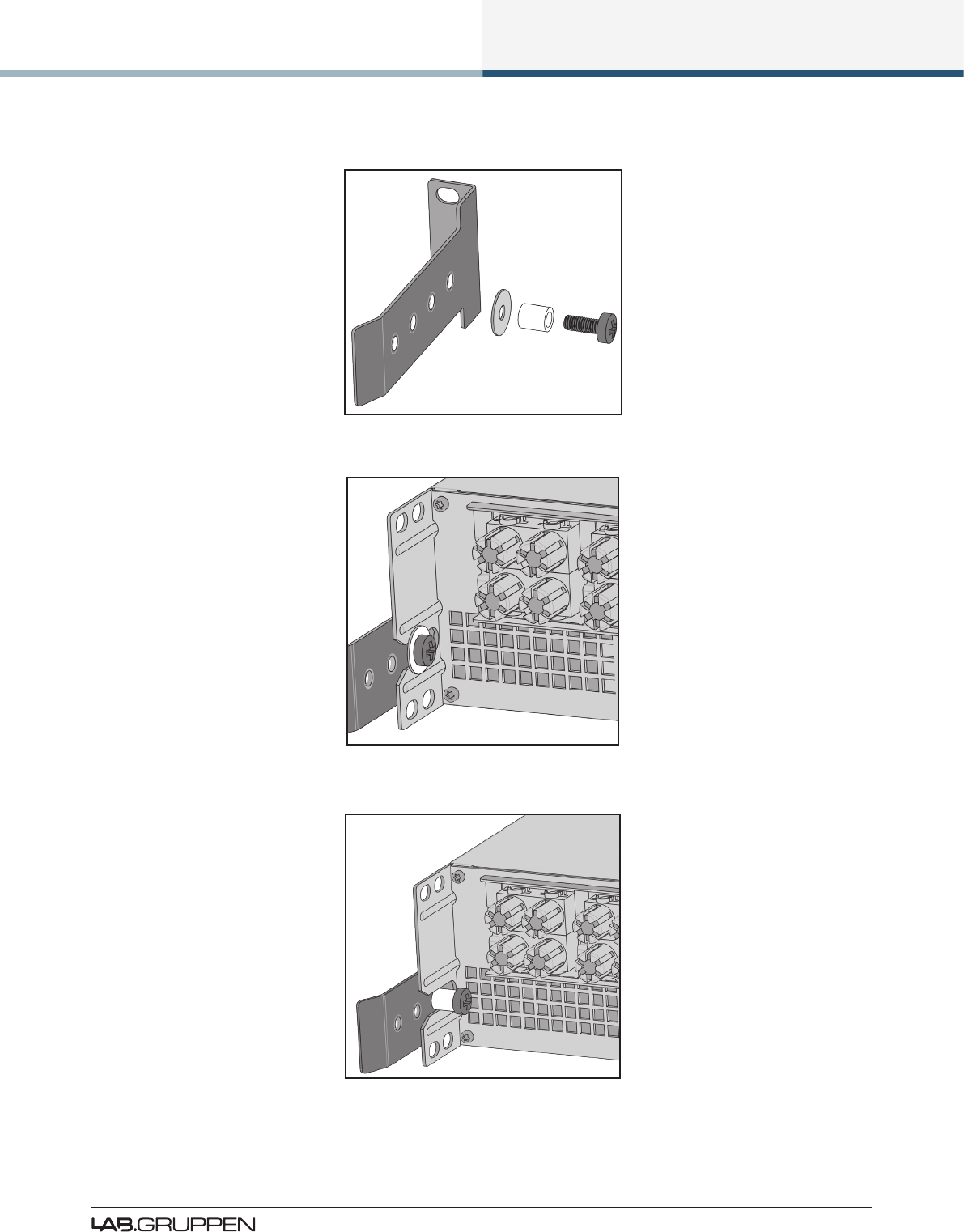
Installation
5
PLM Series Operation Manual Rev 1.3.0
Figure 3-1: Rear Support Bracket and Mounting Hardware
Figure 3-2: Use the Washer for Fixed Installations
Figure 3-3: Use Tube for Slide-On Installation
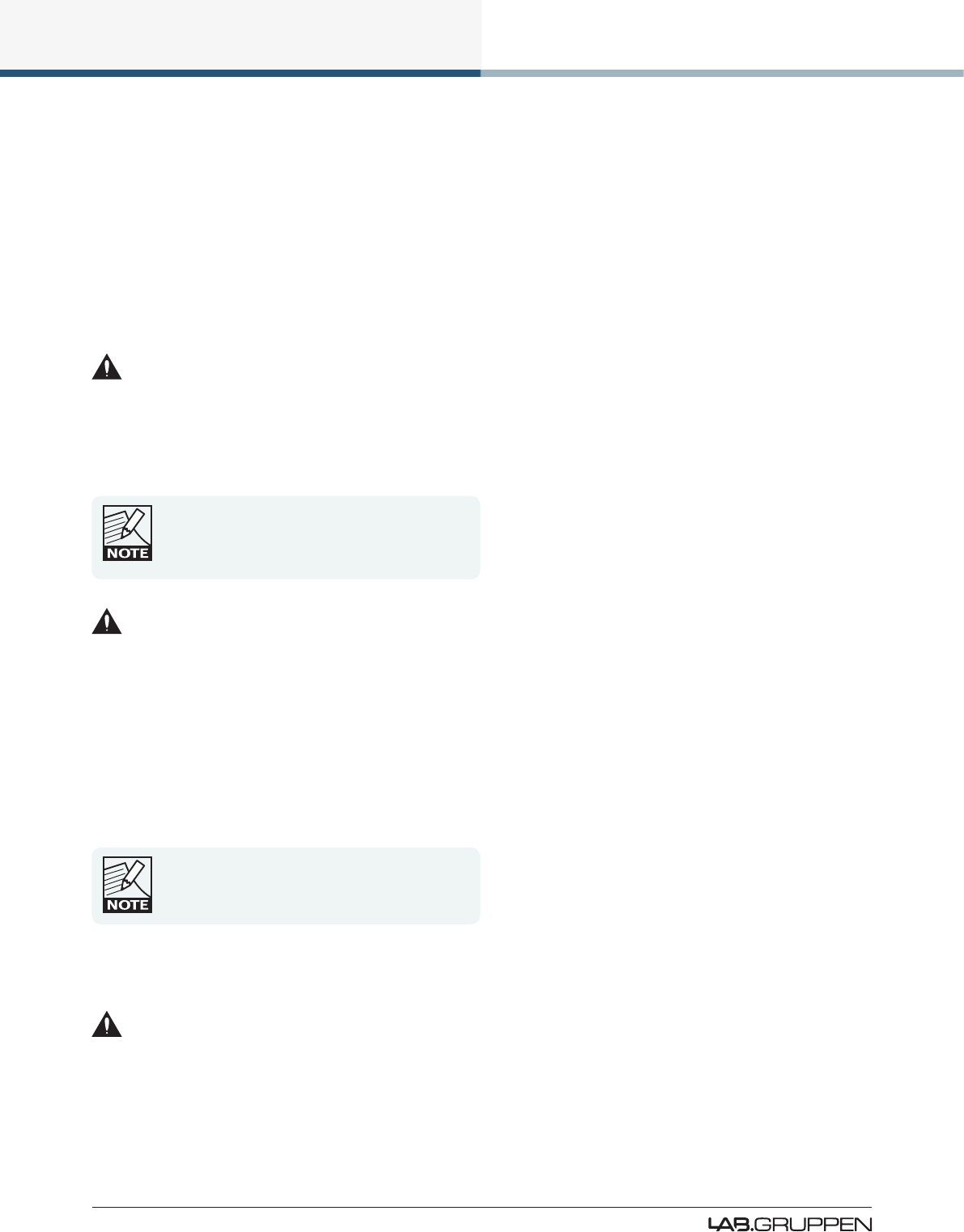
6
Installation
PLM Series Operation Manual Rev 1.3.0
3.3 Cooling
3.3.1 Overview
The PLM Series devices use a forced-air cooling system with airow from front to rear, allowing high
continuous power levels without thermal problems. Front-to-rear airow is preferable as air at the front of
a rack is cooler than that at the rear in nearly all situations; never attempt to reverse the airow. The opera-
tion of the PLM’s cooling system is dependent on front-to-rear airow; it will not function effectively with
external airow in the opposite direction.
Make sure an adequate air supply is provided in front of the PLM, and that the rear of the PLM has
sufcient space to allow air to escape. If the PLM is rack-mounted, never operate the unit with any front or
rear rack doors or covers in position. It is recommended to keep the ambient temperature around the PLM
as cool as possible. An increased temperature can have a signicant negative impact on the expected
lifetime on the components inside the PLM.
Fit solid blanks (not ventilation blanks) to unused
rack spaces to ensure effective air circulation.
Leaving gaps in between items of equipment
degrades the effectiveness of forced-air cooling.
If installing one or more PLM Series devices in a rack with other fan-cooled equipment, be sure that all
the other equipment also uses front-to-rear airow for cooling. If this precaution is not observed, there is a
risk of overheating, as units with the reverse airow will be drawing in air which has already been heated by
the PLMs.
3.3.2 Temperature Sensing and Protection
The PLM is equipped with a sophisticated temperature sensing system which protects it from any overheat-
ing which may occur as a result of inadequate ventilation.
Always ensure the dust lters behind the detach-
able front panel are clean to ensure maximum
possible airow.
3.4 Operating Voltage
The label adjacent to the mains (AC) input connector indicates the AC mains voltage for which the
device is wired and approved. The PLM 10000Q and PLM 14000 devices are available in separate 115 V and
230 V versions; the PLM 20000Q is only available with a universal power supply operating from 80 to 265 V.
Only connect the mains cable (AC cord) to an AC source of the voltage shown on the label.
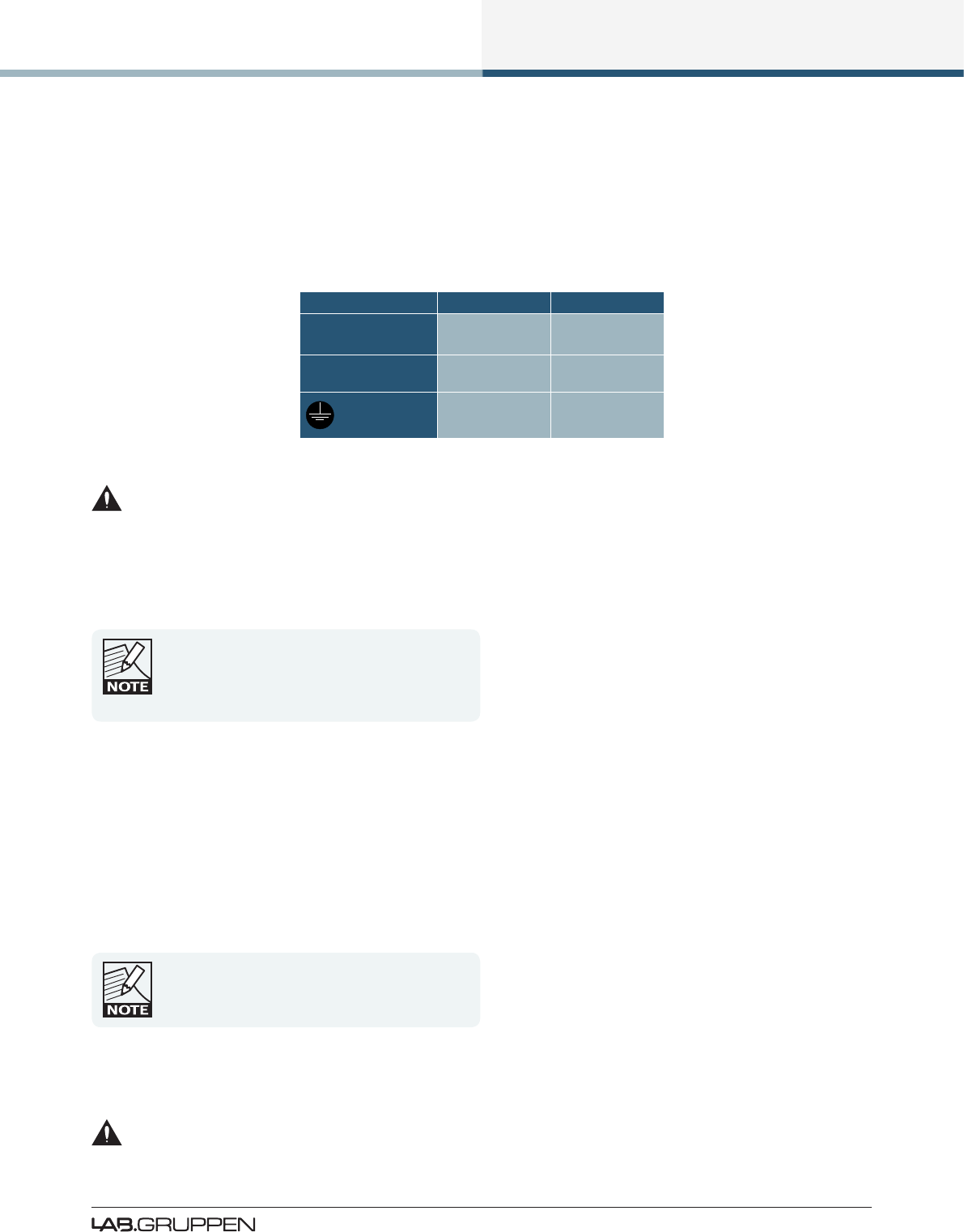
Installation
7
PLM Series Operation Manual Rev 1.3.0
The PLM uses primary switching, which means the mains power is rectied on the primary side of the
transformer. This makes the power supply insensitive to mains frequency variation, and it will operate
normally on line frequencies from 45 to 75 Hz.
If the mains plug (AC plug) tted to the mains cable (AC cord) is not appropriate for your country, it can be
removed and a locally-sourced one tted instead, observing the color coding in the table below:
powerCON Pin 230 V Version 115 V Version
L Brown Black
N Blue White
Green/Yellow Green
Table 3-1: AC Plug Conguration
If you are not 100% condent of your competence to replace the mains plug (AC plug), the task should
be carried out by qualied personnel.
Once a suitable AC power supply is connected, the device can be turned on using the front panel power
button. When the device is turned on, the power button LED changes from red (Standby) to green (Active).
In-rush current is controlled and limited during the
soft-start sequence. This enables multiple PLMs on
the same AC mains circuit to be turned on
simultaneously.
3.5 Grounding
Analog inputs feature Iso-Float™ ground isolation, a technology which combines the benets of transformer-
coupled isolation with the advantages of clean, direct-coupled inputs.
The audio converters are galvanically isolated, and not connected to the main ground. High-speed transform-
ers and opto-isolators create a barrier between the device and the outside electrical environment.
The Iso-Float feature is activated by default, but
may be disabled via the Lake Controller software,
or via the front panel menu.
Use correctly-shielded balanced audio input connections to minimise hum and interference. Please refer to
section 8.2.4 for further information.
NEVER disconnect the earth (ground) pin on the mains cable (AC power cord).
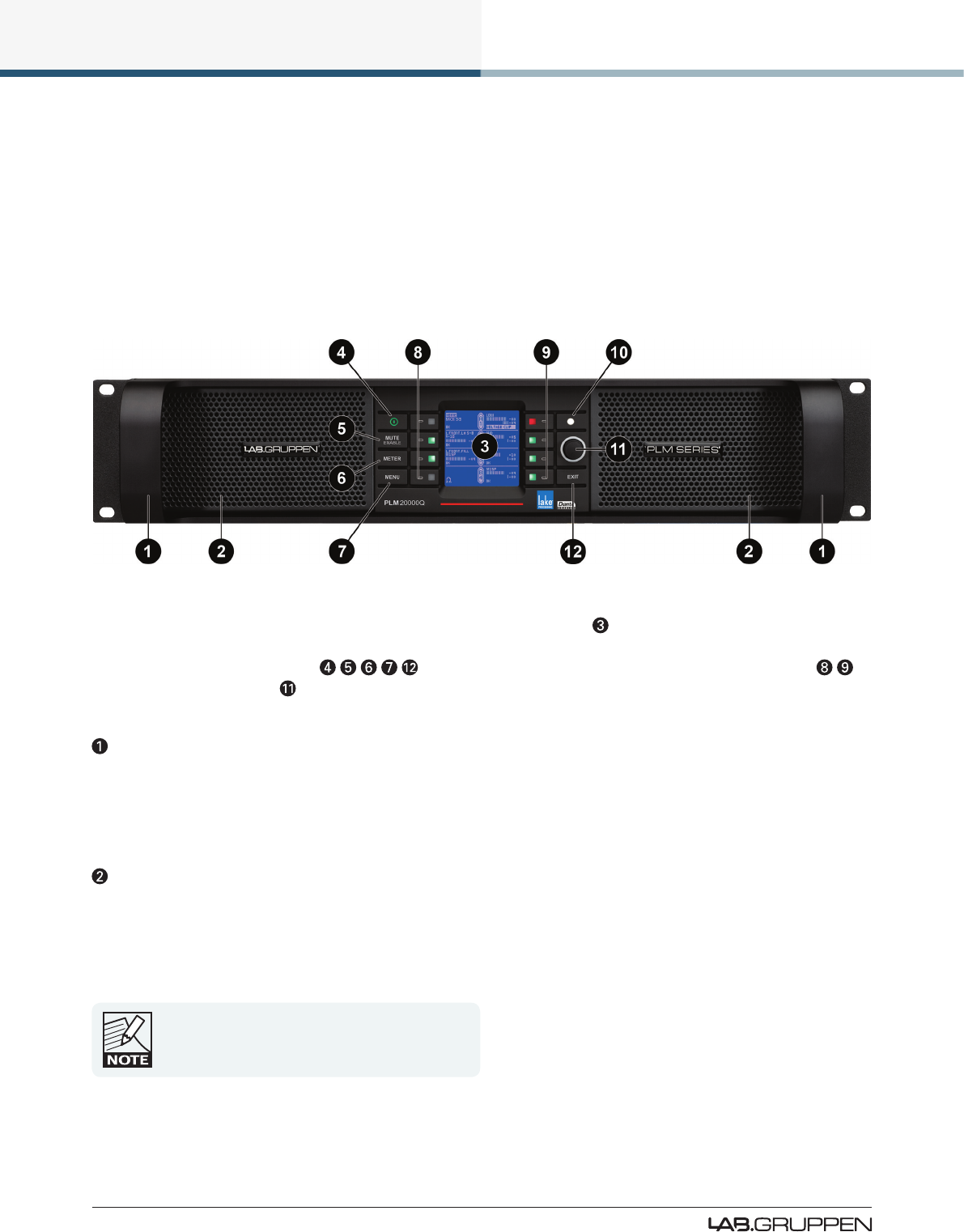
8
Product Overview
PLM Series Operation Manual Rev 1.3.0
4. Product Overview
This chapter provides an overview of key features and functionality. For further information please see
chapters 5 to 10 of this Operation Manual.
4.1 Front Panel Overview
Figure 4-1: Front Panel Overview
The front panel controls are clustered around a daylight readable LCD , allowing adjustment and monitor-
ing of the majority parameters and meters. The two clusters of controls on either side of the LCD include
ve dedicated function buttons , eight dynamic function buttons with embedded LEDs
and a rotary data encoder .
Handles
Two sturdy cast aluminium handles are integrated into the front panel. The handles should be used when
carrying the device, and when tting into or removing from a rack. Ensure that any door or removable rack
front cover has sufcient depth to clear the handles.
Dust Filters
Two dust lters are tted behind metal covers. To remove the covers, loosen the thumbscrews located
behind the handles. Once detached, the dust lter elements can be removed for cleaning; please refer to
section 9.2 for further information.
NEVER operate this device without the dust lters
in place.

Product Overview
9
PLM Series Operation Manual Rev 1.3.0
Display
The display illuminates when the device is on. The LCD, function buttons, and the rotary encoder provide
real-time control and monitoring of most parameters. The LEDs embedded in the function buttons indicate
available menu options, provide conrmation of Controller communication, and indicate various faults and
warnings.
The brightness and contrast of the display and front panel LEDs can be adjusted via the front panel menu.
Please refer to chapter 7 for further details.
Standby
PLM Series devices are powered on and to standby using the top-left button, or via the Lake Controller.
Mute Enable
Select MUTE ENABLE to allow the dynamic function buttons to operate as mute controls for the Module
inputs and power output channels. The MUTE ENABLE button ashes when the mode is selected; a
subsequent press deselects this mode. If left activated, MUTE ENABLE mode will automatically disable two
minutes after the last mute action.
Meter
The METER button scrolls through various meter views including the default Home View, Module View,
Temperature View and Input View. Pressing METER from Menu Mode returns the screen to Meter Mode
with the Home View displayed. Please refer to section 7.5 for further details.
Menu
After pressing the MENU button, the LCD will display the top level menu. In Menu Mode the dynamic
function buttons enable access to various information and functionality. Please refer to section 7.6 for further
details.
Dynamic Function Buttons with LEDs (Left of LCD)
The function of these buttons change according to the currently selected view or menu.
▸In Menu Mode they are used for menu navigation and for parameter selection
▸In Meter Mode they provide Module input mute/unmute functionality in conjunction MUTE ENABLE

10
Product Overview
PLM Series Operation Manual Rev 1.3.0
The LED in the top button provides Frame fault and warning indications. The middle two buttons provide
Module input mute functionality, mute indication and faults and warning indications relating to the PLM
inputs. The bottom button is used only in Menu Mode or to lock the front panel buttons.
Please refer to chapter 7 for further details.
Dynamic Function Buttons with LEDs (Right of LCD)
The function of these buttons change according to the currently selected view or menu.
▸In Menu Mode they are used for menu navigation and for parameter selection
▸In Meter Mode they provide PLM output mute/unmute functionality in conjunction MUTE ENABLE
All LEDs provides mute, clip, fault and warning indications for the PLM power outputs channels.
Please refer to chapter 7 for further details.
Communication LED
The high-intensity white LED illuminates white to indicate that the Module/Frame is selected in the
Lake Controller; it ashes white to indicate communication with the Lake Controller.
The brightness of the LCD and communications LED can be adjusted in the Frame page of the Main Menu
on the front panel.
Rotary Encoder
The rotary encoder is used to modify various parameters (e.g. input level) via the menu. When a menu item
is selected that permits adjustment of parameter values, the ring around the rotary encoder illuminates. In
Home View the encoder can be used to scroll through the Meter Views.
Exit
The EXIT button is used primarily while navigating the menu system in Menu Mode; pressing EXIT will
return the menu up one level. In Meter Mode, pressing EXIT returns the metering display to the default
Home View.
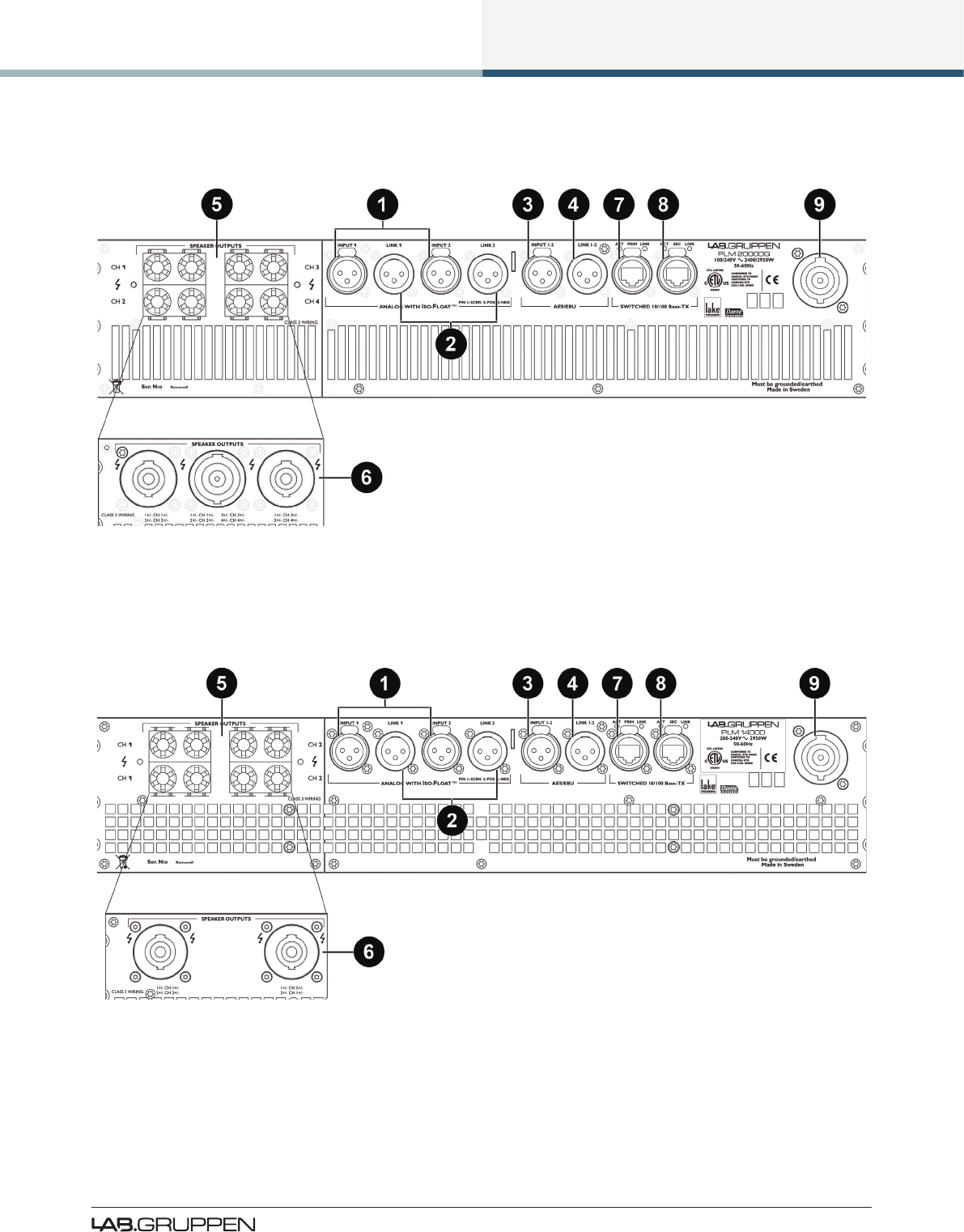
Product Overview
11
PLM Series Operation Manual Rev 1.3.0
4.2 Back Panel Overview
Figure 4-2: Back Panel Layout Options for a 4-channel PLM
Figure 4-3: Back Panel Layout Options for a 2-channel PLM
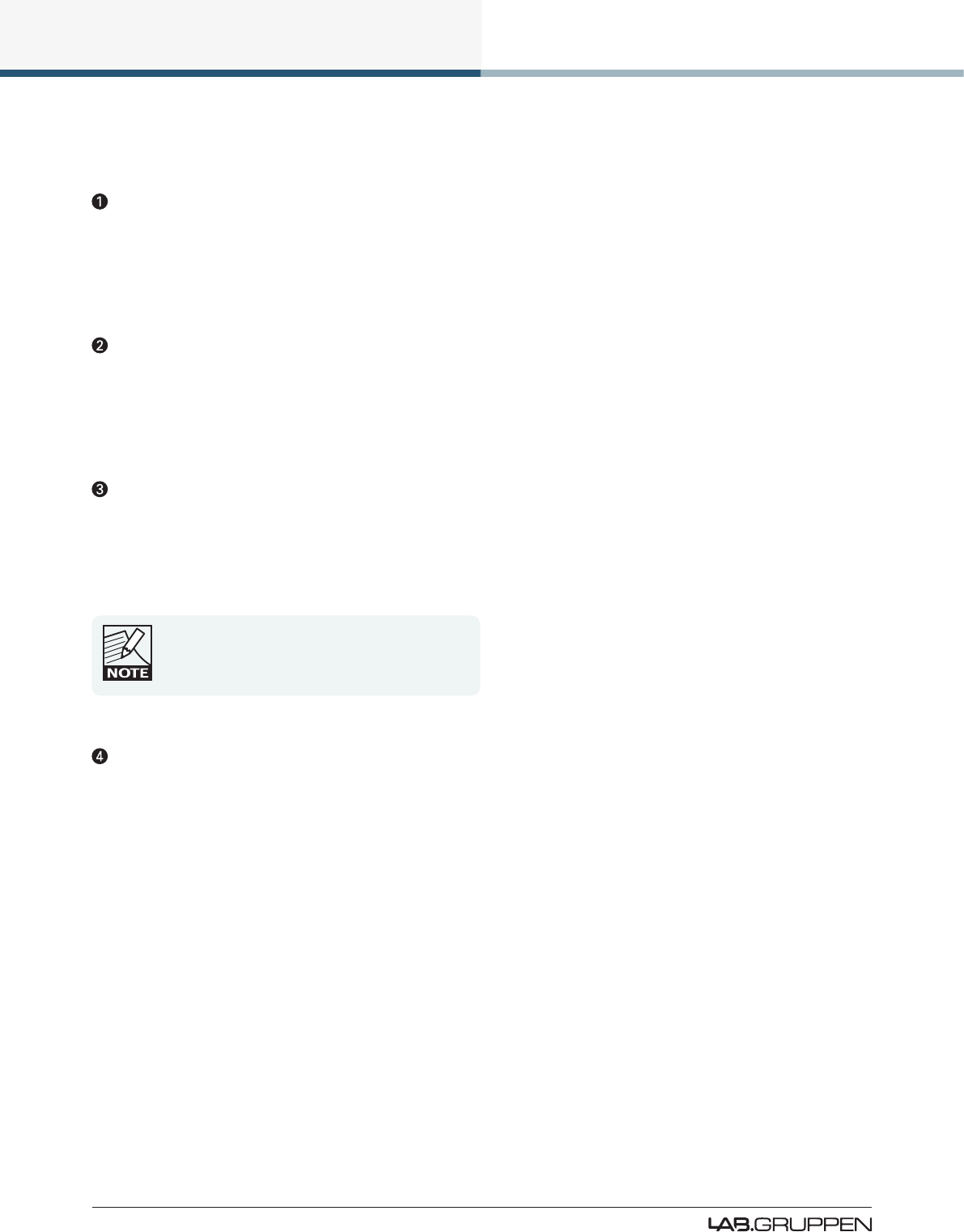
12
Product Overview
PLM Series Operation Manual Rev 1.3.0
4.2.1 Input and Link Connectors
Analog Inputs
Analog inputs are available on two standard XLR3F latching connectors. The inputs are electronically
balanced and feature Lake Iso-Float circuitry. The impedance is 20 kohms, and the inputs can accept a
maximum input level of +26 dBu.
Analog Links
Two latching XLR3M connectors are tted adjacent to the analog input connectors. These are paralleled to
the input connectors to provide an unprocessed analog loop-through to feed additional PLM Series units, or
other equipment.
AES3 Inputs
A latching XLR3F connector is provided which accepts an AES3 digital audio signal. Input impedance is 110
ohms, please ensure that 110 ohm digital audio cables are used; standard XLR microphone cables are rarely
suitable for reliable digital audio transmission.
AES3 is a stereo digital format, and therefore both
PLM inputs are fed via a single connector. Selection
of the analog or digital inputs is made via the front
panel display or control software.
AES3 Link
A latching XLR3M connector is tted adjacent to the AES3 input connector. This is paralleled to the input
connector to provide an unprocessed AES3 loop-thru to feed further PLMs, or other equipment. An AES3
110 ohm termination load is enabled by default when the PLM is the last unit connected within an AES3
daisy-chained system. The termination may be disabled, if desired, via the front panel menu and within the
Lake Controller software.
4.2.2 Output Connectors
The PLM is available with a choice of connectors for power outputs: binding posts or Neutrik speakON®.
Both connection methods allow for Bridge Mode operation, which is activated from the Lake Controller
software. Please refer to the Lake Controller Operation Manual and section 8.1.1 of this Operation Manual
for further information on Bridge Mode.

Product Overview
13
PLM Series Operation Manual Rev 1.3.0
Binding Posts
In this version, the power outputs for loudspeaker connection are available on four separate pairs of fully
enclosed binding posts. Bridge Mode can be enabled via the Lake Controller software, please refer to the
Lake Controller Operation Manual for further information.
Channel conguration for the binding posts is dependent on the PLM model, please refer to section 8.1.3 of
this Operation Manual for standard and Bridge Mode wiring.
speakON Connectors
The speakON connector conguration differs on 2-channel and 4-channel PLM models.
On 4-channel models, the power outputs are simultaneously available on a single 8-pole speakON connec-
tor, and on two 4-pole speakON connectors. The two 4-pole connectors carry the outputs of channels 1 & 2
and 3 & 4 respectively.
On 2-channel PLM models the two power output channels are available simultaneously on two 4-pole
speakON connectors. Both connectors carry both channels. The second connector offers the channels in
reverse order.
Bridge Mode can be enabled via the Lake Controller software, please refer to the Lake Controller Operation
Manual and to section 8.1.2 of this Operation Manual for further details on standard and Bridge Mode wiring
for speakON connectors.
4.2.3 Ethernet and Power Connectors
Primary Network Connector
The primary Neutrik RJ45 etherCON® connection provides integration into an Ethernet control network
which may include other Lake Processors and the Lake Controller software. Network connection permits full
control of all functions along with real-time metering from a remote position. This device supports the Dante
audio networking protocol, which allows transmission of multichannel, high-denition digital audio over the
same Ethernet connection.
Use the primary connector when using a star network topology, consisting of individual Cat-5e connections
between the devices and an Ethernet switch. Alternatively this connection can be used to daisy chain
directly to another Lake Processor. The daisy chain topology should not be used with Dante.
For a technical reference of the Ethernet Port, please refer to section 8.4 . Additional information is also
available in the Lake Network Conguration Guide.
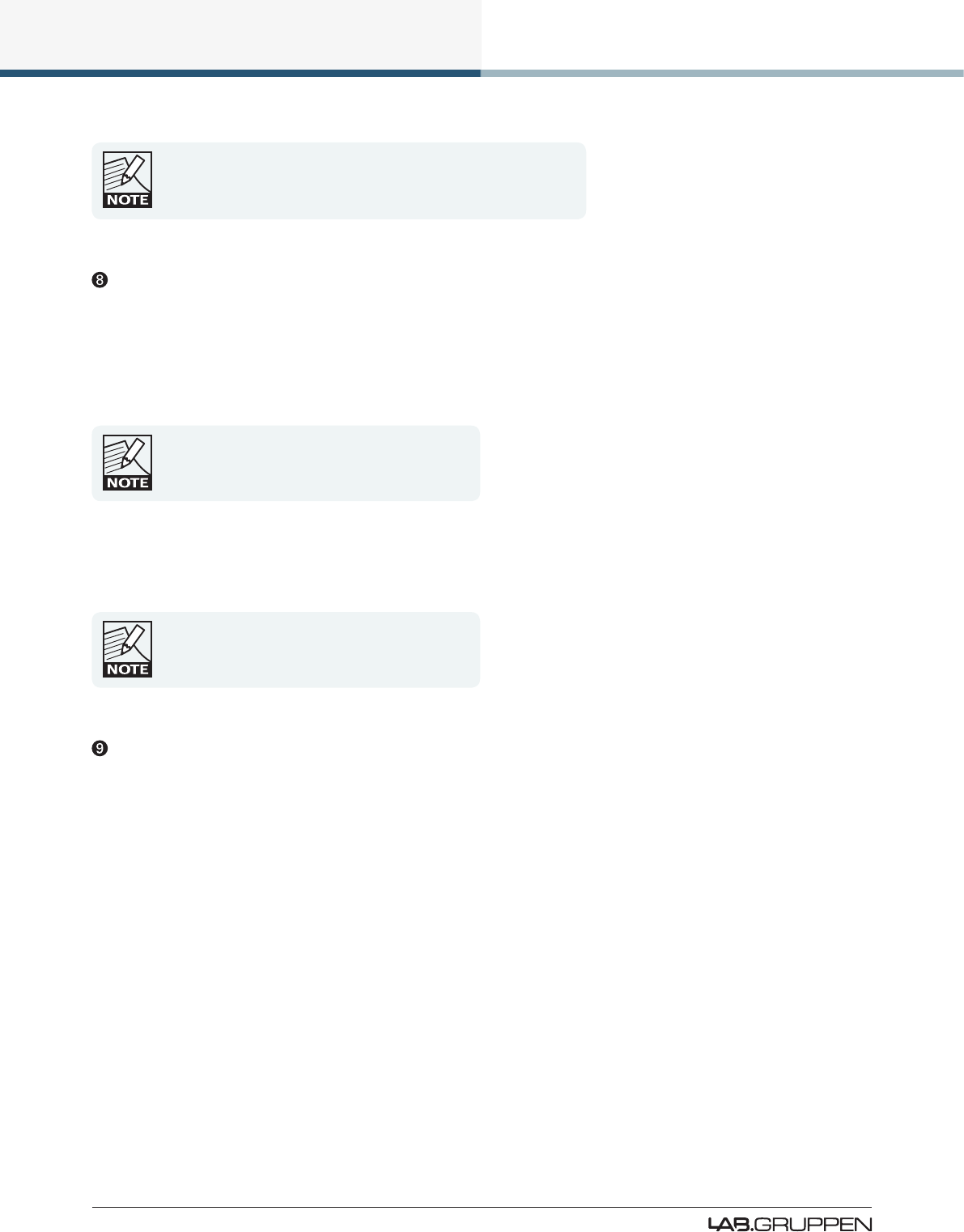
14
Product Overview
PLM Series Operation Manual Rev 1.3.0
The Ethernet ports operate at the Ethernet data rate of 100 Mbps, and
allow straight or crossed network cables. Two LEDs above each port
indicate valid network connection (LINK) and network activity (ACT).
Secondary Connector
The secondary network connector can be used to daisy-chain multiple LM & PLM Series and legacy Dolby
and Lake devices. Alternatively, a Dante dual-network topology can be created by connecting all secondary
network connectors to a separate Ethernet switch, ensuring full redundancy in the event of a network
component failure.
Additional processor conguration is required for a
dual redundant network setup. See the Lake
Controller Operation Manual for further details.
For a technical reference of the Ethernet Port, please refer to section 8.4 . Additional information is also
available in the Lake Network Conguration Guide.
When connecting multiple devices to an Ethernet
network, care must be taken NOT to create a
closed loop which causes network malfunction.
Mains Power Connector
The mains power AC input is via a Neutrik powerCON connector, rated at 32 A.
The power supply must be connected to AC mains using a power cable with a correctly wired plug for the
country of operation.
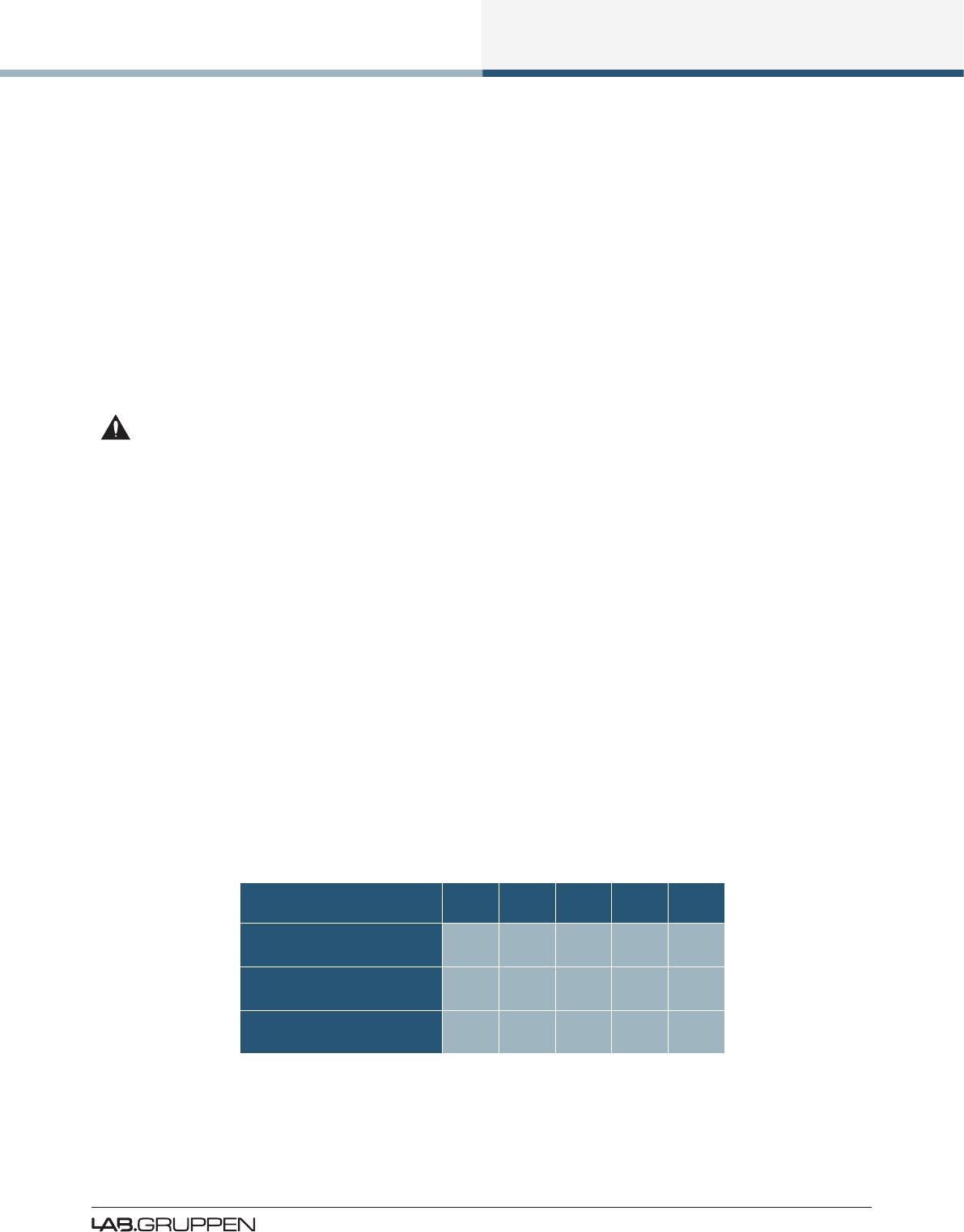
Operation and Performance
15
PLM Series Operation Manual Rev 1.3.0
5. Operation and Performance
This chapter provides comprehensive information on PLM Series connection, setup, operation and perfor-
mance. The detailed information included here is essential to realizing the full functionality of the PLM Series
devices.
5.1 Operation Precautions
Make sure that the Standby button on the PLM’s front panel is either unlit (OFF), or red (STANDBY), before
making any input or output connections.
Ensure the AC voltage matches that printed on the label adjacent to the AC mains connector.
Ensure no input signal is present when powering on the PLM to reduce the risk of any inadvertent bursts of
high level audio.
5.2 Power Output Performance
The PLM uses Lab.gruppen’s patented Class TD technology in the output stages, which couples the ef-
ciency of Class D topologies to the sonic purity of Class B designs.
The primary benet is that Lab.gruppen’s Class TD works perfectly under all load conditions. The output
maintains its at frequency response even into complex loads with very low nominal impedances. Reliability
is very high, and there is no interference with nearby RF equipment. Superior efciency allows greater
power density while minimizing cooling requirements, yet sound quality matches that of the best Class B
designs.
5.2.1 Symmetrical Power
The PLM models can deliver power as shown in Table 5-1 when all channels are driven equally.
Load Impedance (ohms) 2.0 2.7 4 8 16
PLM 10000Q
Max. Output power (Watts) 2350 2700 2300 1300 660
PLM 14000
Max. Output power (Watts) 7000 6000 4300 2300 1150
PLM 20000Q
Max. Output power (Watts) 4800 5000 4440 2300 1150
Table 5-1: Symmetrical Load Power Ratings
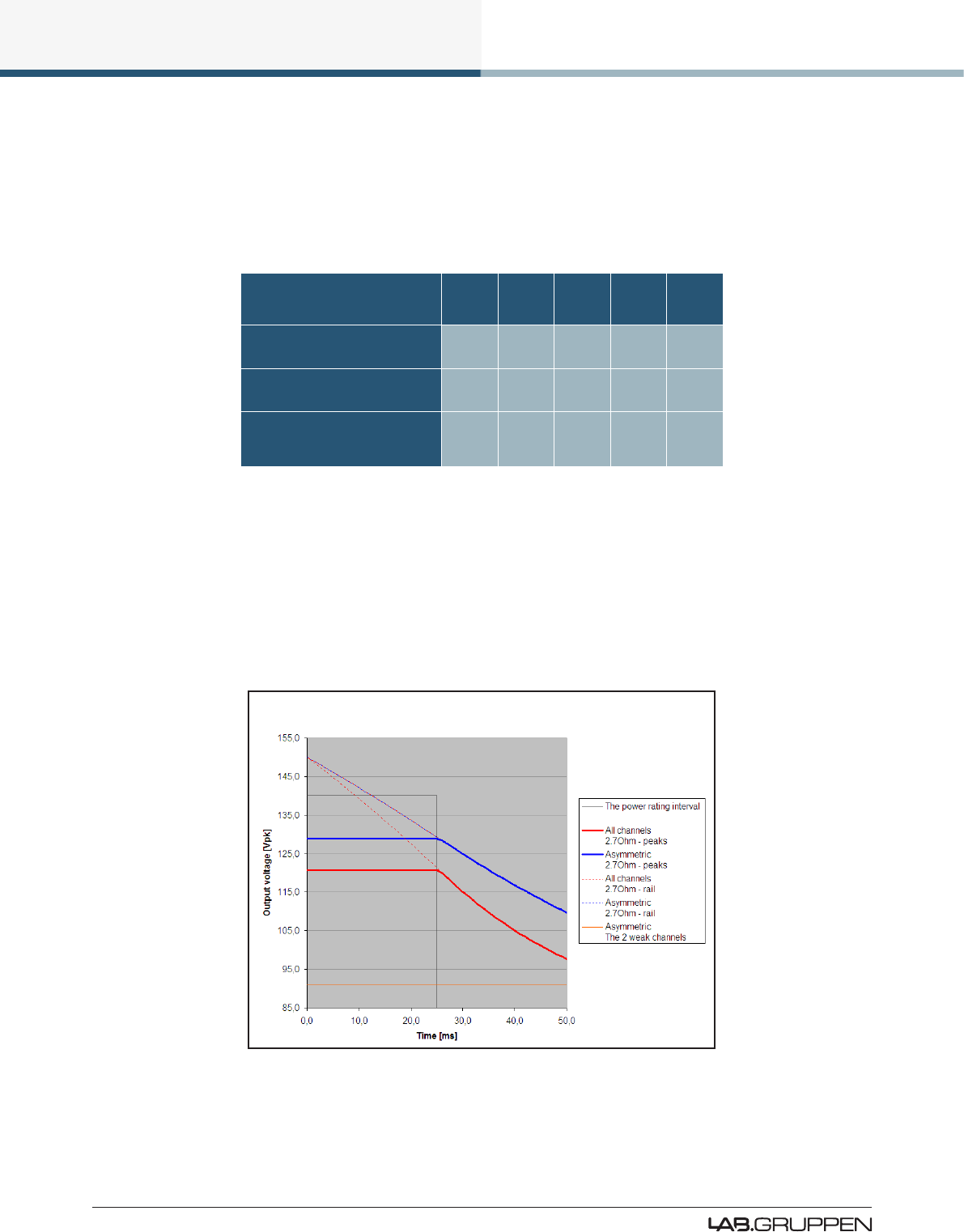
16
Operation and Performance
PLM Series Operation Manual Rev 1.3.0
5.2.2 Asymmetrical Power
The PLM models can deliver power as shown in Table 5-2 when every other channel is driven 3 dB lower
than the other. This can occur when the load on the individual power output channels within the amplier
contain different frequency ranges.
Load Impedance (ohms) 2.0 2.7 4 8 16
PLM 10000Q
Max. Output power (Watts) 2350 2900 2400 1300 660
PLM 14000
Max. Output power (Watts) 7500 6300 4400 2300 1150
PLM 20000Q
Max. Output power (Watts) 5000 5550 4500 2300 1150
Table 5-2: Asymmetrical Load Power Ratings
5.2.3 Power Over Time
Power ratings given above are applicable for PLMs running at these levels for a period of 60 minutes. Due
to thermal considerations in the power supply and elsewhere, it is possible to draw higher power levels for
a shorter period of time. The graph below illustrates, for the example PLM 10000Q, how the rated power
gures are derived and the higher short-term capability.
Peak output voltage at “max power burst”
Figure 5-1: Power Rating Levels Over Time (PLM 10000Q)
Power ratings are based on a duty cycle of 25 ms full power every 400 ms. Between bursts, a lower signal
level applies, such that the continuous average power is 1/8th of the rated power.

Operation and Performance
17
PLM Series Operation Manual Rev 1.3.0
In reality, when some channels are delivering less than maximum rated power, energy reserves in the PSU
are available to permit other channels to deliver more power. The graph shows the peak output voltage over
time for a continuous sine wave is applied.
If all four channels are driven with the same signal into the same impedance (solid red line), then the rail
voltage (dotted red line) will drop faster than when two channels are delivering maximum power (solid blue
line) and two channels are delivering half-power (solid orange line). This is termed asymmetric loading; the
rail voltage for this is indicated by the dotted blue line.
It can be seen that higher power output is available for 25 ms bursts with asymmetric loading.
5.3 Amplier and Load Protection Systems
The PLM is equipped with a comprehensive set of protection circuits. If operating conditions become suf-
ciently extreme that any of these circuits become active, indication is provided by LEDs in one or more soft
function buttons 5-8, together with adjacent warning text. In addition to this, notication is also presented
within the Lake Controller software and within system log les.
5.3.1 Inter-Sample Voltage Peak Limiter (ISVPL)
The ISVPL is a high quality voltage limiter that can deliver seamless limitation to any desired level. Its
ensures that the voltage at the output terminals never exceeds the dened threshold.
It operates on these principles:
▸The signal is delayed slightly to allow the ISVPL to look-ahead and reduce the gain before voltage in
excess of the threshold can appear at the output. This results in zero voltage overshoot at the output
with a rounded limitation up to the threshold.
▸The amplitude of the output signal between digital samples is predicted which permits the ISVPL to
respond to analog peaks that may occur at the digital to analog converter.
▸The release time of gain reduction is adaptive depending on the dynamics of the signal.
It is possible to select different ISVPL proles for limiting optimization for a specic frequency band and
personal preference. The proles are divided into two categories, with one category optimized for low
distortion and the other focusing on producing high sound pressure level (SPL). Within each category there
are proles optimized for the different frequency bands.
5.3.1.1 Low Distortion Proles
▸Universal – The universal prole is a soft limiter that can be used for all frequencies and is conservative
in its action upon VCL and CPL.
▸Sub/LF – The Sub/LF prole is tuned for frequency bands below 600Hz. It has longer attack and release
times and is less conservative when it comes to acting upon VCL and CPL.
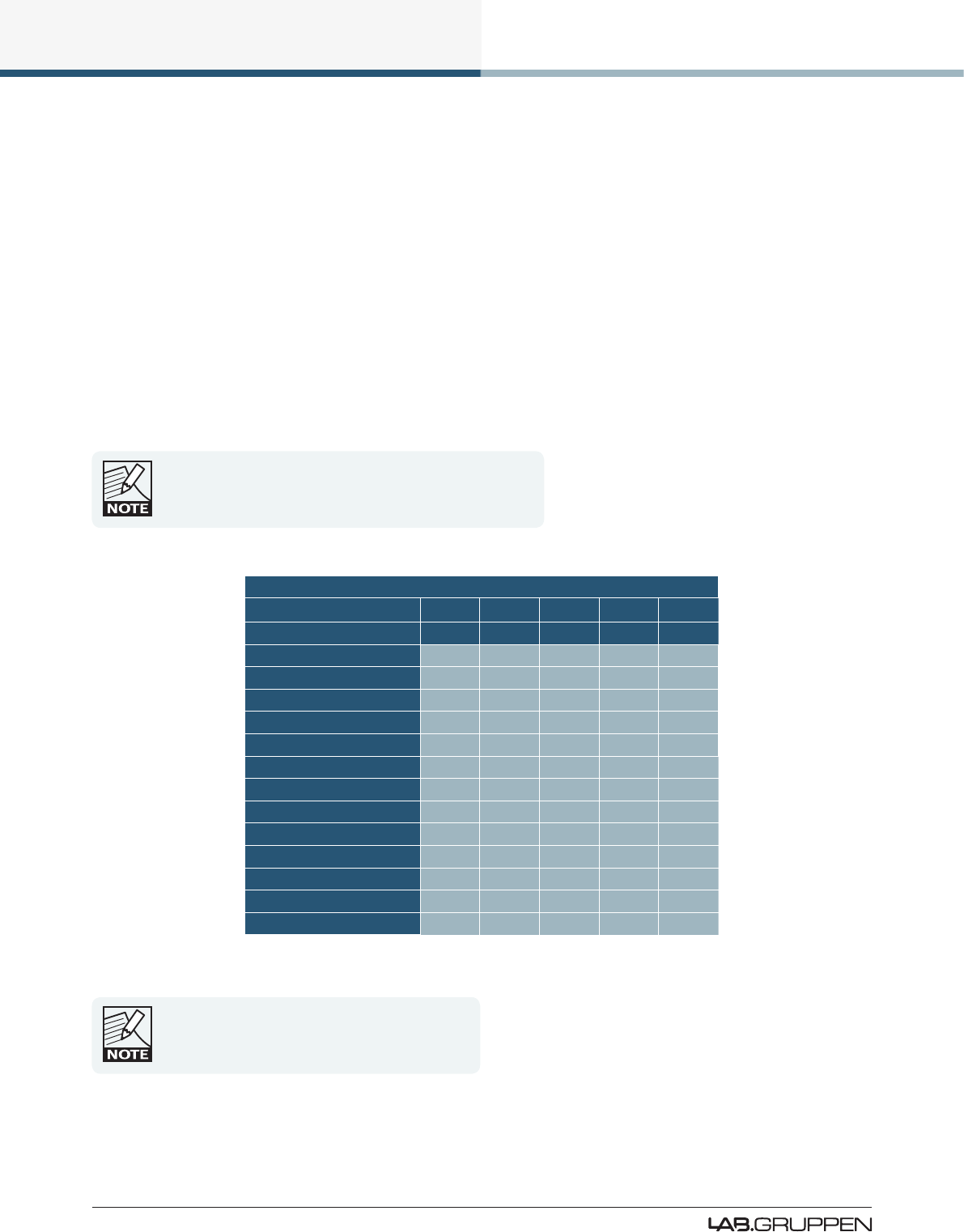
18
Operation and Performance
PLM Series Operation Manual Rev 1.3.0
5.3.1.2 High SPL Proles
High SPL proles do not use the adaptive release time feature. High SPL proles optimized for high frequen-
cies use less of the look-ahead delay peak-rounding feature; this feature is used most in the Sub prole and
least the HF prole.
▸Sub - The Sub prole is optimized for frequencies between 20 - 200 Hz
▸LF - The LF prole is optimized for frequencies between 20 - 1200 Hz
▸MF - The MF prole is optimized for frequencies between 300 - 6000 Hz
▸HF - The HF prole is optimized for frequencies above 1 kHz
Table 5-3 shows the theoretical maximum output power for a given load impedance and ISVPL setting.
An ISVPL-to-load calculator that will assist in generating the
appropriate ISVPL setting for a desired power load is available
at www.labgruppen.com/plm
MAX. SINEWAVE BURST POWER (Watts)
Load Impedance (ohms) 2 2.67 4 8 16
ISVPL SETTING (V peak)
194 9409 7048 4705 2352 1176
193 9312 6984 4656 2328 1164
181 8190 6143 4095 2048 1024
167 6972 5229 3486 1743 872
153 5852 4389 2926 1463 732
121 3660 2745 1830 915 458
101 2550 1913 1275 638 319
83 1722 1292 861 431 215
70 1225 919 613 306 153
56 784 588 392 196 98
47 552 414 276 138 69
38 361 271 181 90 45
17.8 79 59 40 20 10
Table 5-3: ISVPL-to-output examples
These ratings shown in Table 5-3 are limited by the
CPL (Current Peak Limiter) functions, not by ISVPL
settings, due to power output channel current
capacity.
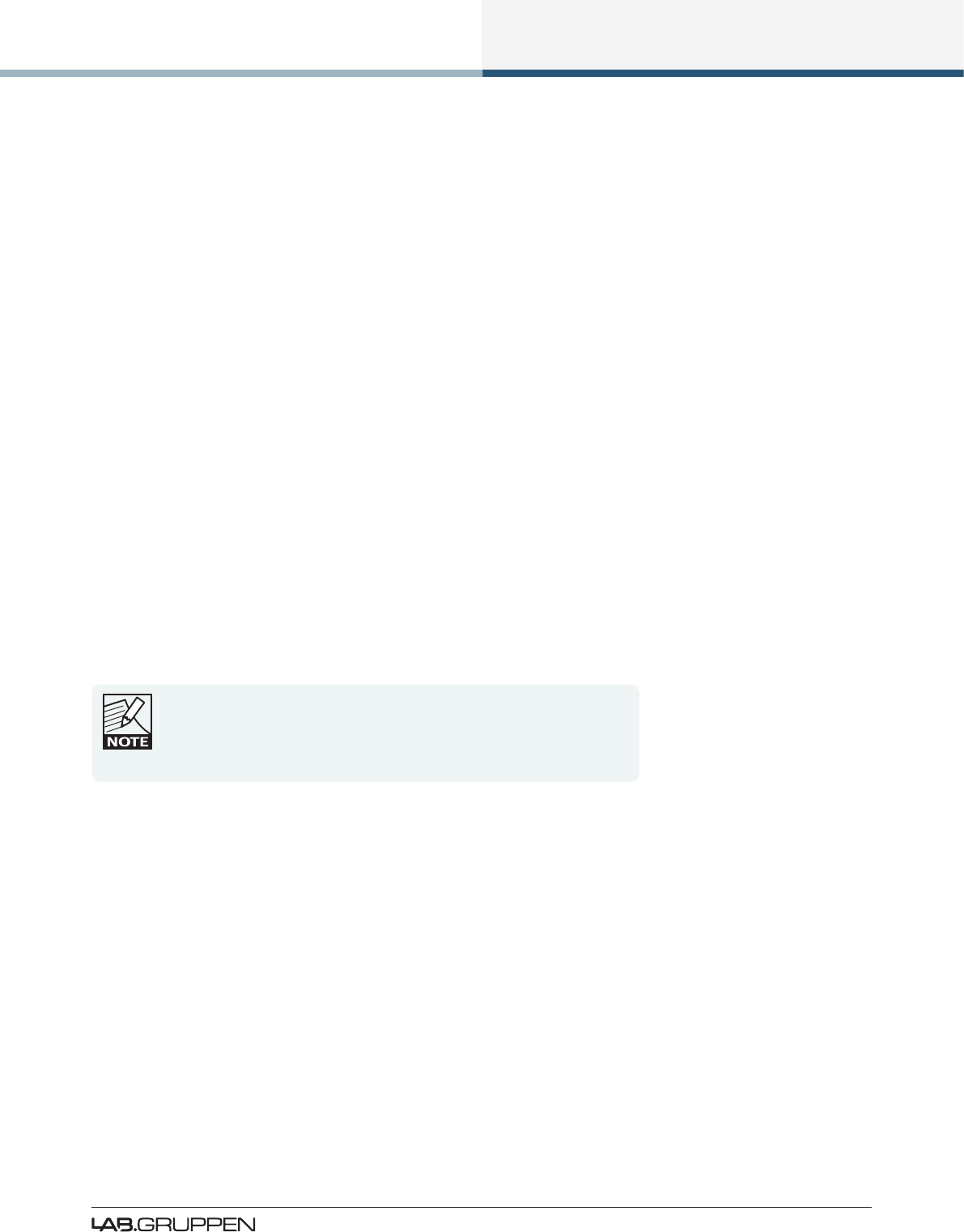
Operation and Performance
19
PLM Series Operation Manual Rev 1.3.0
The ISVPL threshold may be set at any level between 17.8 V and 600 V via the PLM’s menu system. For
further details, please refer to section 7.11.2.5 of this manual, and also to the PLM Series chapter in the
Lake Controller User Manual.
PLM devices that have a smaller peak output voltage can still set the ISVPL threshold up to 600 V. When
a threshold is set above the maximum capability of a power output channel, the maximum ISVPL for that
product will be automatically set. Therefore, the ISVPL threshold can be in at the Module for the speaker’s
maximum capability, and the Module le remains cross-compatible with all PLM Series devices.
5.3.2 Current Peak Limiter (CPL)
The output Current Peak Limiter (CPL) ensures that the power output section will not be damaged by forcing
it to deliver current levels at the outputs that exceed the maximum current ratings of the output transistors.
The CPL keeps the output transistors within their Safe Operating Area (SOA). The CPL is non-adjustable.
CPL activity is indicated on the power output channel LED (embedded in the associated output channel’s
function button to the right of the LCD). Activity on an affected channel results in a ashing red indication
together with a CURRENT CLIP warning message displayed on the screen adjacent to the LED. A warning is
also displayed on the controlling PC via the network.
This condition indicates an attempt to draw excessive current at the output. The output is attenuated until
the output current falls below the maximum current rating. Limiting is performed by the ISVPL limiter in
conjunction with the selected ISVPL prole. Please refer to the Technical Specications in chapter 11 for
further details regarding ratings.
If excessive current is indicated, check the output cables and examine the
loudspeaker. If impedance appears normal, you may rectify the condition by
altering the ISVPL settings or lowering input levels. CPL indication can be
triggered by excessively low output impedance, possibly the result of too
many loudspeaker cabinets connected in parallel.
5.3.3 Power Average Limiter (PAL)
5.3.3.1 PLM 10000Q and PLM 14000
The Power Average Limiter (PAL) controls the AC current into the power supply. Power consumption is
limited to the rated design parameters of the power supply, ensuring that the PSU will never be overloaded.
Also, high-power products such as those in the PLM Series can potentially draw more current (with output
devices still within safe operating areas) than is allowed by the external mains breaker.
The PAL protection feature can help prevent the supply’s external breaker from tripping within time intervals
of less than three minutes. For longer time intervals, it is the responsibility of the user to ensure that the
average level of the audio is within limits that ensure that the breaker doesn’t trip.

20
Operation and Performance
PLM Series Operation Manual Rev 1.3.0
PAL activity is indicated by the LED within the rst soft button adjacent to the display ashing red,
together with a PAL ACTIVE warning message displayed on the screen. A warning is also displayed on the
Lake Controller software.
5.3.3.2 PLM 20000Q
The Power Average Limiter Active warning (PAL Active) will be displayed when the power supply’s maxi-
mum rated design parameters are reached. When this warning is displayed, gain limiting is being applied to
the signal and the ISVPL threshold is lowered accordingly.
5.3.4 Breaker Emulation Limiter (BEL
™)
The Breaker Emulation Limiter feature is present only in the PLM 20000Q. The PLM 20000Q is a power-
ful device that can draw a considerable amount of current from the mains supply. The BEL models the
temperature in the external breaker and limits the mains current to prevent it from tripping. The BEL can be
congured with both a breaker prole and a current value. The current value can be set from 5 to 32 Arms.
There are three different proles available for selection:
▸Conservative - The conservative prole allows no momentary current above the congured threshold.
▸Fast - The fast prole models the time constant of the trip-curve corresponding to a fast breaker. It
momentarily allows current above the threshold to pass for a short time, leading to an increased mod-
eled temperature. For the limiter to disengage, the current must reduce below the threshold to enable
the breaker to cool down.
▸Universal - The universal prole models the time constant of the tripp-curve corresponding to a slow
breaker. It momentarily allows current above the threshold for a longer time, leading to an increased
modeled temperature. For the limiter to disengage the current has to reduce below the congured
current for the breaker to cool down.
The BEL can be congured via the PLM front panel and via the Lake Controller.
5.3.5 Under Voltage Limiter (UVL
™)
The PLM 20000Q is equipped with an under voltage limiter. With mulitple powerful devices on a mains
distribution line, heavy current loads risk the reduction of voltage below that required for devices to function.
The PLM 20000Q’s UVL reduces the mains current draw when voltage drop below 80 V. The amount of
reduction applied increases as mains voltage drops towards 65 V, then at 65 V the power supply is shut
down. The mains supply is continually monitored and when sufcient voltage returns the power supply
automatically restarts.

Operation and Performance
21
PLM Series Operation Manual Rev 1.3.0
5.3.6 Current Average Limiter (CAL
™)
The Current Average Limiter (CAL) monitors the RMS current drawn from each power output channel
to ensure that the power output stages are not overloaded. When activated, it regulates the current to a
safe level to protect the channel. The CAL should not be activated in normal usage, but if it is, its opera-
tion is indicated by an active LED and the message CAL ACTIVE. Further indication is given within the
Lake Controller software.
5.3.7 Voltage Clip Limiter (VCL)
If current draw from the PLM’s power supply is too high, the PSU’s regulation capability may be exceeded
and the internal voltage rails may drop and cause clipping. If this occurs the VCL acts rapidly to prevent clip-
ping on the subsequent peaks. Limiting is performed by the ISVPL limiter in conjunction with the selected
ISVPL prole. Indication of this condition is shown on the output LEDs.
5.3.8 Temperature Protection
5.3.8.1 Overview
PLM Series devices are equipped with a sophisticated temperature sensing system that provides protection
from overheating which may occur as a result of inadequate ventilation or excessive power output.
Thermal measurements are made at several points within each power output channel along with measure-
ments in the power supply and DSP areas. If temperature in any area reaches a critical level then a warning
is displayed and gain reduction is applied. If the temperature continues to increase and reaches a dangerous
level then a fault is displayed and audio is muted. Each power output channel, the power supply and DSP
area have separate indications.
For all temperature faults, temperature monitoring will continue at 0.5 second intervals, with the output
remaining muted. When the area has cooled below the dangerous threshold, the fault condition is cleared
and audio is restored.
5.3.8.2 Power Output Channels
A power output channel temperature warning or fault is indicated in one of the front panels LEDs (in the
right-hand soft function buttons).
▸A warning is indicated by a static yellow LED and adjacent warning message: TEMP WARN:CH
▸A fault is indicated with a static red LED and adjacent warning message: TEMP FLT:CH
An event report is sent to the Lake Controller software for both the warning and the fault. If a temperature
fault condition arises on a power channel, the output of that channel will be muted.
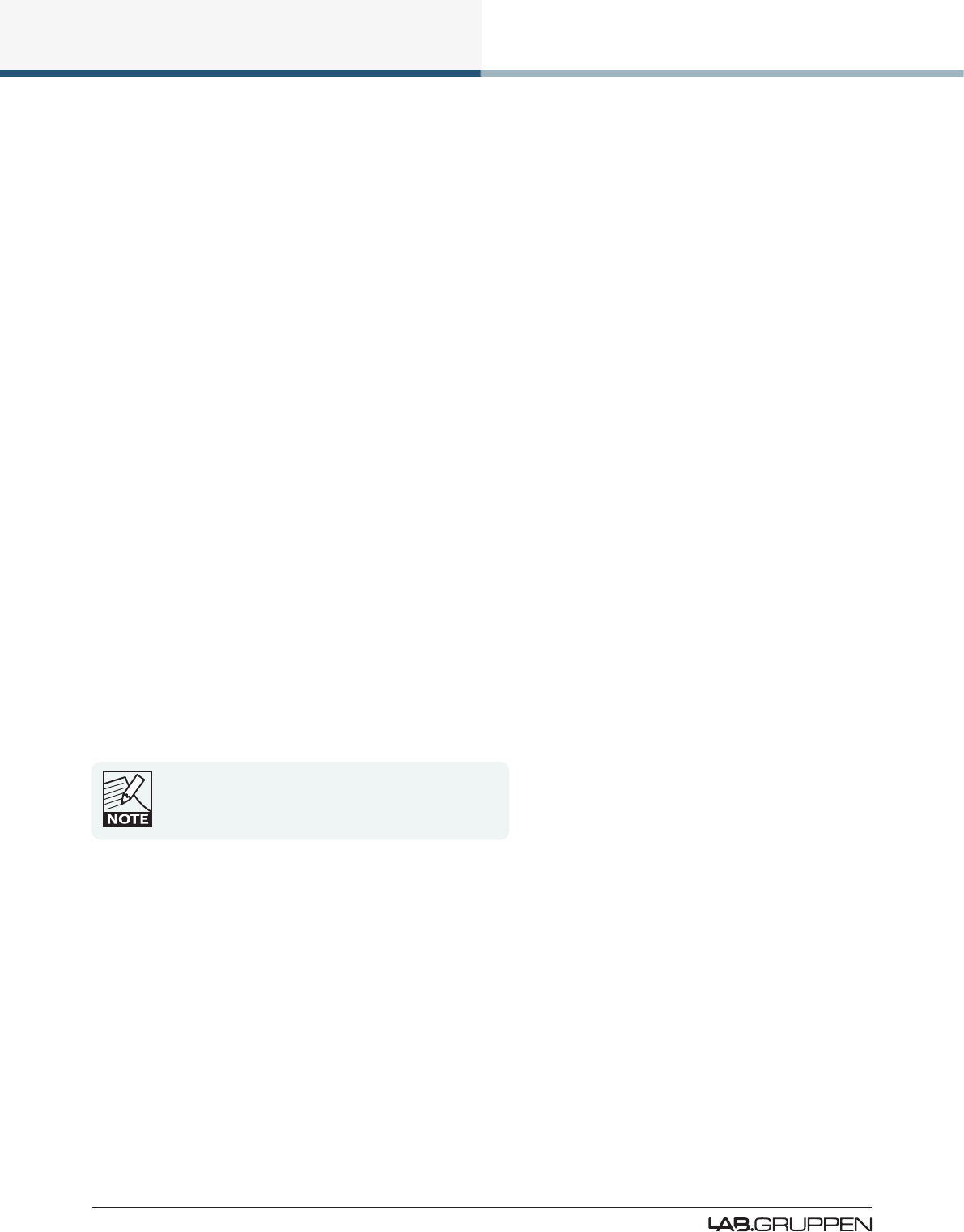
22
Operation and Performance
PLM Series Operation Manual Rev 1.3.0
5.3.8.3 Power Supply / DSP
A power supply (PSU) or DSP temperature warning or fault is indicated by the LED in the top-left function
button.
▸A warning is indicated by a static yellow LED and adjacent warning message: TEMP WARN:PSU
(or TEMP WARN:DSP)
▸A fault is indicated with a static red LED and adjacent warning message: TEMP FLT:PSU
(or TEMP FLT:DSP)
An event report is sent to the Lake Controller software for both the warning and the fault. If a temperature
fault condition arises in the power supply the output of all channels will be muted. If a temperature fault
condition arises in DSP area, audio will not be muted but continued operation is not recommended.
5.3.8.4 PLM 20000Q
For the PLM 20000Q a temperature dependant limiting feature is also present. At temperatures above the
critical warning level and below the dangerous fault level, the ISVPL threshold is slowly reduced to decrease
the output power and cool down the device. This enables the device to continue to pass audio, although
with a reduced amplitude, in extreme conditions. If reducing the ISVPL threshold does not cool down the
device a temp fault will still be issued when the dangerous temperature level is reached.
5.3.9 DC Protection
DC protection is implemented on each power output to prevent damage to connected loudspeakers or any
PLM components. DC present at the output will cause the PLM’s power output module breaker to blow. In
this instance a red LED will illuminate and NEEDS SERVICE will display on the LCD.
The power output channel modules are independent of
the input voltage. Both 115 and 230 V models have amp
channel fuses. This is not a user-servicable fault
condition and the unit should be returned for repair.
5.3.10 VHF Protection
The PLM includes protection circuits that detect Very High Frequency (VHF) content in the input signal. The
detection is frequency-dependent, initiated from 10 kHz upwards. If VHF signals are detected above the
threshold, the output will mute for approximately 6 seconds before a further measurement is taken. When
continuous VHF signal stops, the output unmutes and the amplier returns to normal operation.
This protection system recognizes that continuous VHF signals at high levels do not appear in speech or
music. Any such content can therefore be considered as a fault condition. VHF protection is essential to
avoid damage to HF drivers.
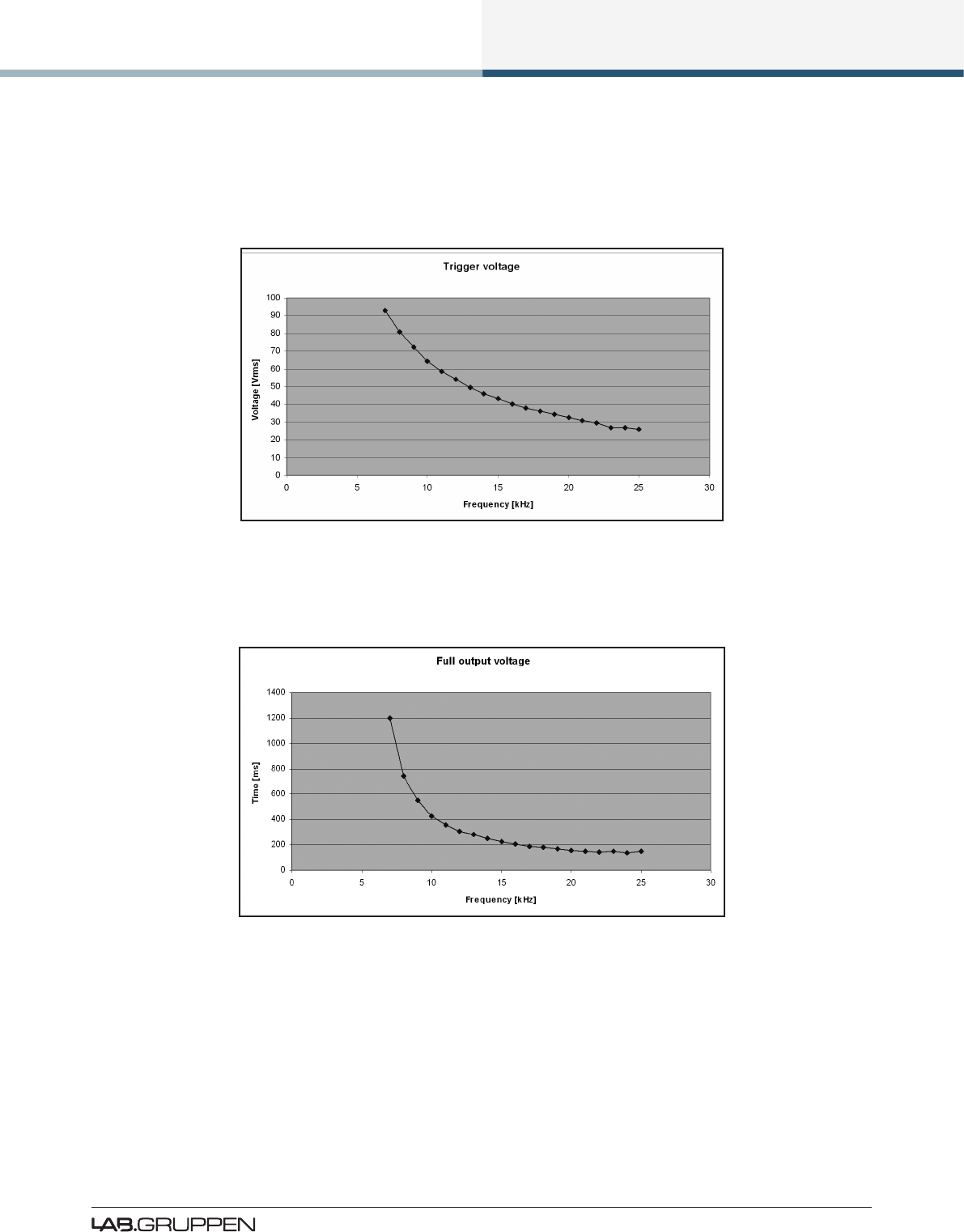
Operation and Performance
23
PLM Series Operation Manual Rev 1.3.0
VHF protection is dependent on a combination of output power level and frequency. Figure 5-2 shows a
decreasing power threshold, from approximately 10 kHz upwards, which illustrates increasing sensitivity of
the protection system with frequency. When continuous output power above the threshold line is detected,
VHF protection becomes active.
Figure 5-2: VHF Protection Frequency Sensitivity
The attack time of the VHF protection circuitry also changes with frequency, becoming shorter at higher
frequencies. This is shown in Figure 5-3.
Figure 5-3: VHF Protection Attack Time Variations
The VHF protection circuit is NOT a limiter and does not alter the PLM’s frequency response. It is imple-
mented solely to detect continuous VHF content. HF content of normal music or speech signals at peak
levels will be passed in full.
Operation of the VHF protection circuits is indicated by one (or more) of the output channel LEDs (in the
right-hand soft function buttons) showing steady red. The adjacent fault message will show VHF FAULT. It is
also reported as a fault via the control network.
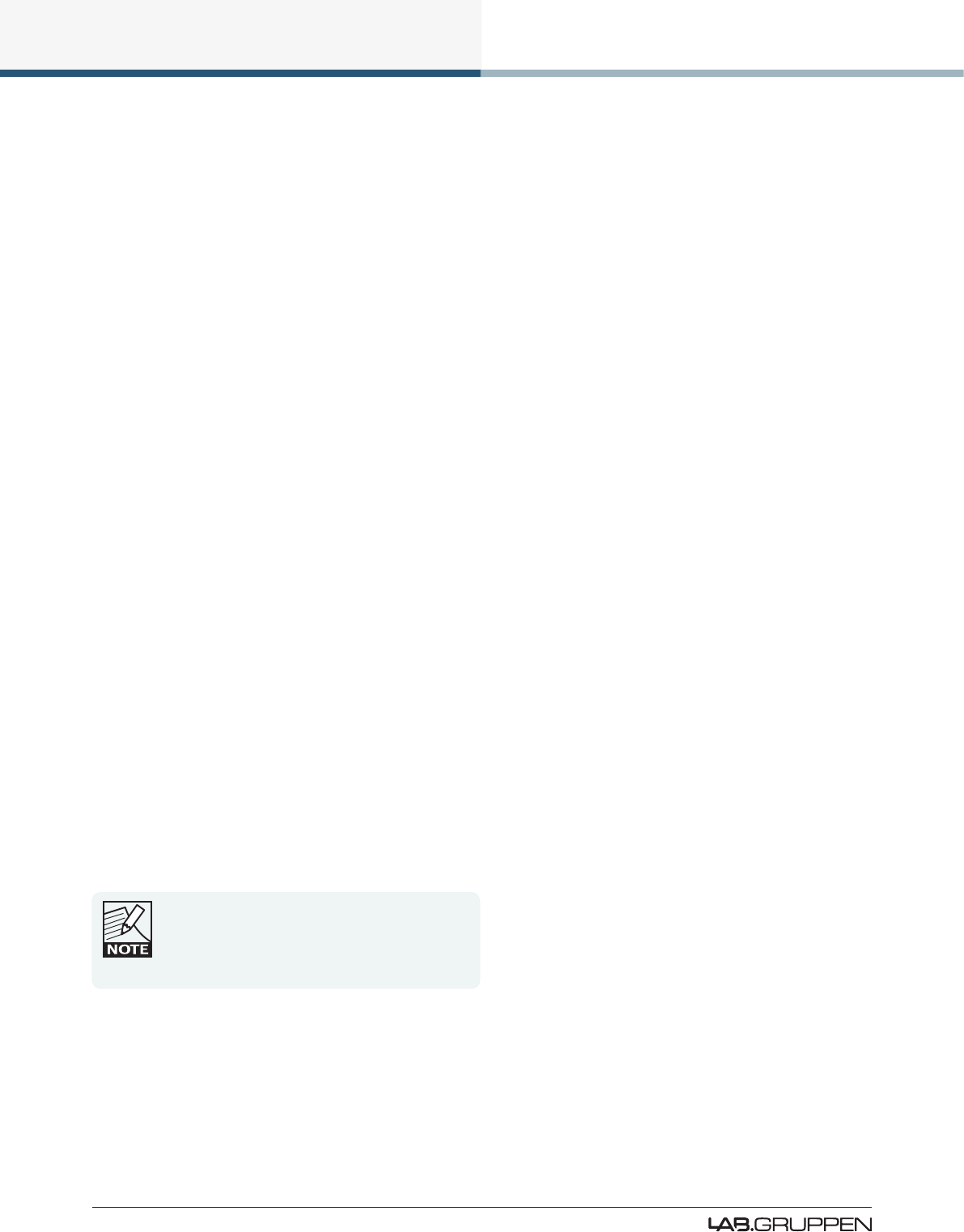
24
Operation and Performance
PLM Series Operation Manual Rev 1.3.0
5.3.11 Short Circuit Protection
A low impedance or short circuit at the power output terminals is detected when the output current is high
(Current Peak Limiter is active) and, simultaneously, the peak output voltage is below a predetermined
threshold (42 V with the PLM 10000Q, for example). When this situation occurs, the output stage is muted
to protect it from damage. Operation of the short circuit protection system is indicated by an output channel
LED (in the right-hand soft function buttons) showing steady red. The adjacent fault message will show
SHORT CIRCUIT. It is also reported as a fault via the control network to the Lake Controller software. The
presence of a short circuit (or low impedance) is re-tested every six seconds, and the output remains muted
until the fault clears.
5.4 Power Supply
The R.SMPS (Regulated Switch Mode Power Supply) is designed to keep supply voltage rails at optimum
levels even when the mains voltage drops. Mains voltages can drop as much as 20% below nominal before
there is any effect on rail voltages. Thus the R.SMPS can deliver full rail voltage to the output stage at all
times, allowing the PLM to exhibit consistent transient response and a clean LF response.
The PLM 20000Q is also equipped with a universal power supply with power factor correction (PFC). The
device can take any mains voltage, from 65 V to 265 V, allowing it to function worldwide in many different
congurations. The PFC reduces current peaks on the lines and reduces the requirements placed on the
mains distribution system. The PLM 20000Q has an unparalleled power factor extremely close to one.
5.4.1 Low Inrush Current
High power ampliers with inadequate inrush current limiting can draw considerable current from the mains
at turn-on, sometimes tripping a fast-acting mains breaker. The PLM, however, has very low inrush current
(the capacitors charge slowly and in a controlled manner) to prevent tripping of breakers.
Several PLMs can, under normal conditions, be powered up simultaneously. If you do experience problems
powering up multiple PLMs simultaneously, they must either be turned on manually in an ordered manner,
or sequenced remotely using the Lake Controller software’s Global Control feature. Alternatively, the capac-
ity of the mains supply should be increased.
If insufcient power is available to allow simultane-
ous power-up, then there is probably insufcient
capacity for full power output during operation. It is
recommended that additional capacity is added to
the mains power distribution system.
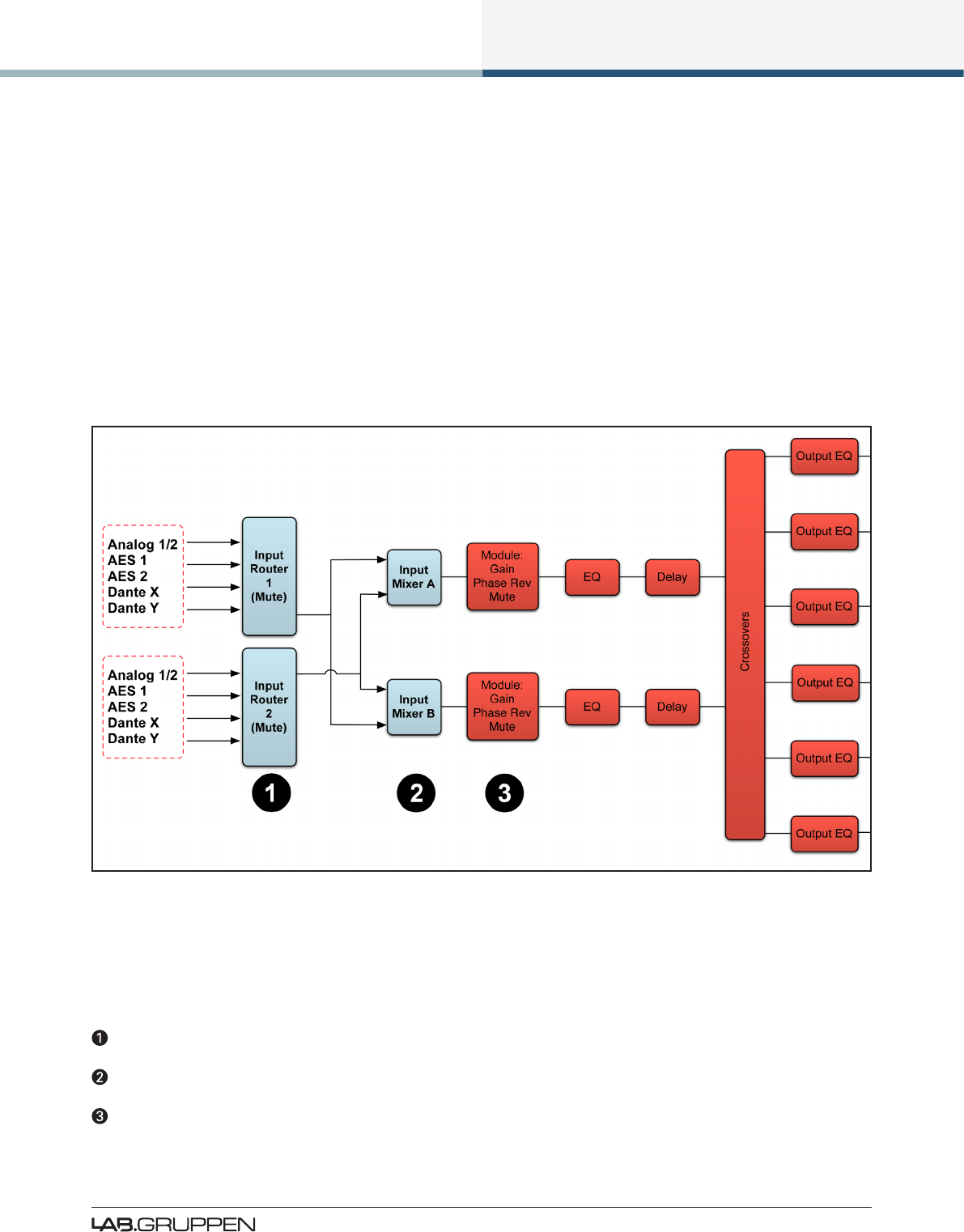
Signal Flow and Lake® Processing
25
PLM Series Operation Manual Rev 1.3.0
6. Signal Flow and Lake® Processing
6.1 Signal Flow
The gures below depict the audio signal ow for a PLM Series device. It is worth noting that this sophis-
ticated device provides seven points in the signal chain where the signal level can be adjusted, muted or
disconnected. The blue sections represent Frame data, and the red sections represent Module data - please
refer to the Lake Controller Operation Manual for further information.
Important information regarding correct setting of the gain structure can be found in section 10.3.
Figure 6-1: Signal Flow Diagram (PLM Series Part 1)
6.2 Level Adjustments & Mute Points
The numbers below correspond the points identied in Figure 6-1 and Figure 6-2.
Input Router Stage - Input selection and MUTE
Input Mixer Stage - Router ON/OFF connection to mixer and gain settings
Module Input Stage - Mute (N/A for LM Series Mesa Mode) and gain settings
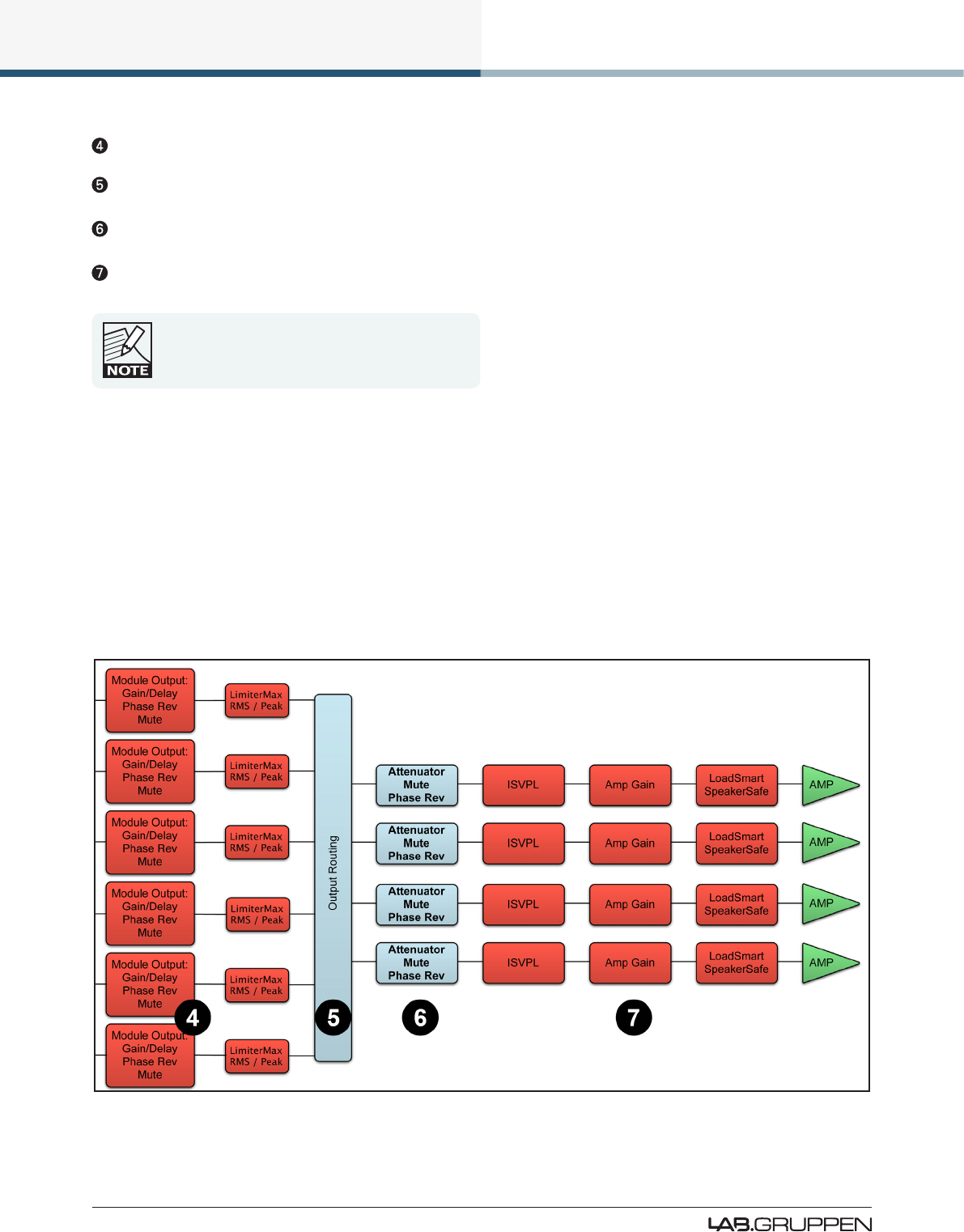
26
Signal Flow and Lake® Processing
PLM Series Operation Manual Rev 1.3.0
Module Output Stage - Mute and gain settings
Output Router Stage - Output ON/OFF routing connections
Attenuation Stage - Power output channel mute and attenuation settings
Amp Gain Stage - Amplier gain control
If the required audio signal is not passing correctly,
verify the connection, mute and gain settings at all
seven stages.
6.2.1 Power Output Section: Limiting and Sensitivity
The Current Peak Limiter (CPL) dynamically limits the drive to the power stage based on three parameters:
sensed output current level, feedback from the output stage, and sensed voltage clip from the ISVPL. This
ensures that power output is maintained within the design limits of the PLM.
The adjustable Inter-Sample Voltage Peak Limiter (ISVPL) sets the PLM’s maximum output voltage and
therefore also the maximum output power. The ISVPL setting is made via MENU > MODULE > LIMITERS
> ISVPL, and can also be set from the Lake Controller software.
Figure 6-2: Signal Flow Diagram (4-channel PLM Part 2)
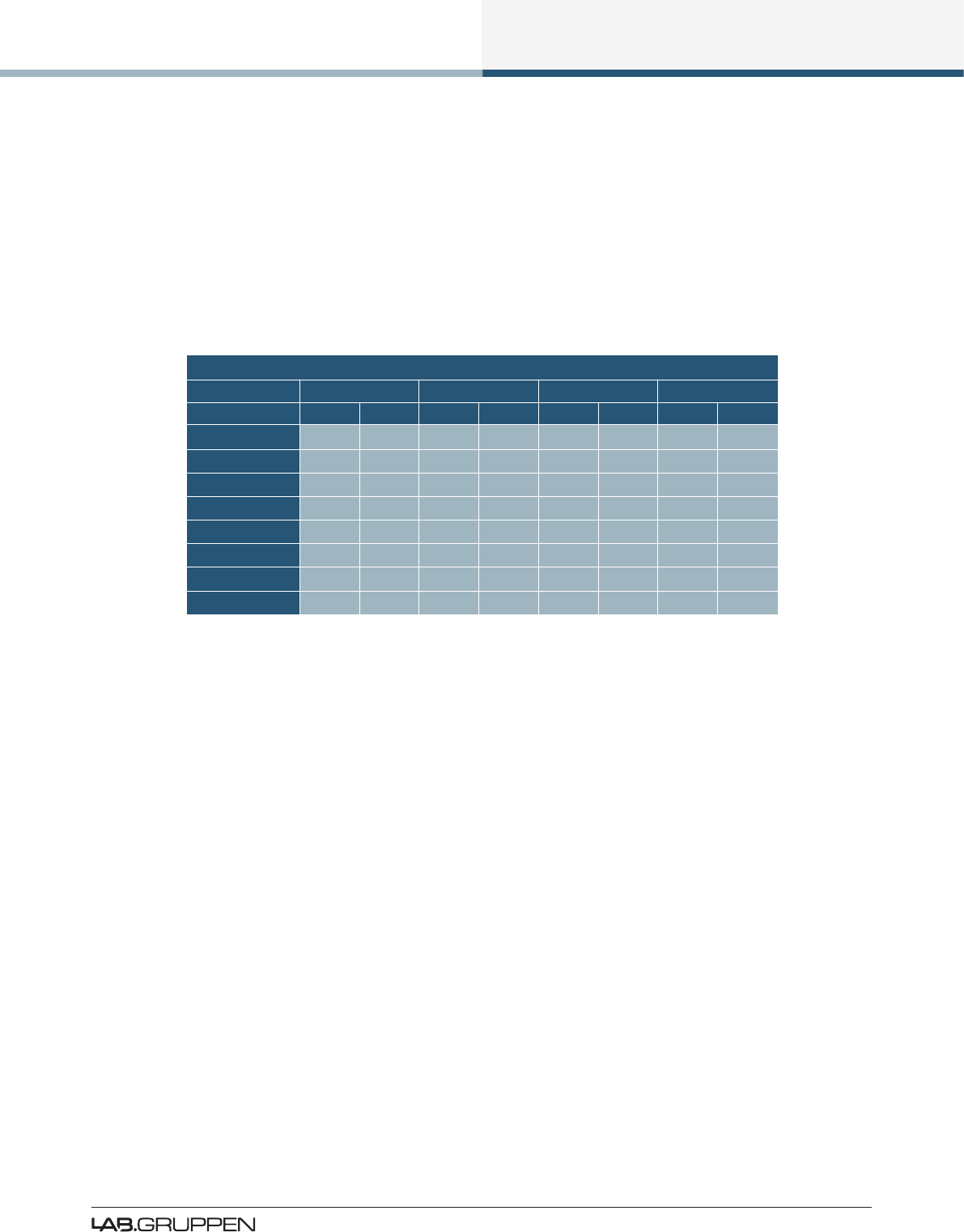
Signal Flow and Lake® Processing
27
PLM Series Operation Manual Rev 1.3.0
The sophisticated output section monitors faults and generates warnings when appropriate; warnings are
displayed on the front panel of the PLM and also sent as messages over the control network. In the rare
event that maximum ratings are signicantly exceeded, the PLM will shut down until the condition has
been rectied or the incorrect setting has been readjusted. Sensing circuits also transmit local output power
stage temperature, processor card temperature, and PSU temperature to the appropriate protection circuits.
Please refer to section 5.3 on page 17 further details.
Table 6-1 lists PLM Series analog input sensitivity in dBu and Vrms for various Amp Gain settings and
maximum/minimum ISVPL settings, assuming an analog input headroom of 26 dBu.
INPUT SENSITIVITY
ISVPL SETTING 194 V 193 V 153 V 17.8 V
GAIN (dB) dBu Vrms dBu Vrms dBu Vrms dBu Vrms
+44 +1.0 0.87 +0.9 0.86 -1.1 0.68 -19.8 0,08
+41 +4.0 1.22 +3.9 1.22 +1.9 0.96 -16.8 0.11
+38 +7.0 1.73 +6.9 1.72 +4.9 1.36 -13.8 0.16
+35 +10.0 2.44 +9.9 2.43 +7.9 1.92 -10.8 0.22
+32 +13.0 3.45 +12.9 3.43 +10.9 2.71 -7.8 0.32
+29 +16.0 4.87 +15.9 4.84 +13.9 3.84 -4.8 0.45
+26 +19.0 6.88 +18.9 6.84 +16.9 5.42 -1.8 0.63
+22 +23.0 10.90 +22.9 10.84 +20.9 8.59 +2.2 1.00
Table 6-1: Analog Input Sensitivity in dBu and Vrms
6.3 Lake Processing and Control
As outlined in section 2.2.3, this device integrates seamlessly into the Lake Processing environment,
providing all features, functionality and connectivity associated with all Lake Processors. The internal Lake
Processing includes programmable crossovers, EQ, dynamics and other functions, and can be fully con-
trolled via the supplied Lake Controller software. Additionally, many functions can be controlled or accessed
directly via the front panel.
The Lake Controller Operation Manual and Lake Network Conguration Guide are supplied on the accompa-
nying CD-ROM and additional documentation is available from the Start Menu after software installation.
Visit http://labgruppen.com to download the latest software, rmware and documentation for your devices.
6.4 Modules and Frames
6.4.1 Overview
A Frame represents one physical Lake Processor (e.g. PLM 10000Q). A maximum of two Modules are
contained within each Frame; these are referred to as Module A and Module B. The number of Modules
shown in a given Frame is dependent upon the signal processing conguration of that Frame.

28
Signal Flow and Lake® Processing
PLM Series Operation Manual Rev 1.3.0
Each Module can be congured as a Classic Crossover (Bessel, Butterworth, Linkwitz-Riley), as a Linear
Phase Crossover, or as multiple full bandwidth Auxiliary Outputs. The default conguration for the PLM is
2 x 2-Auxiliary Output Modules, providing a total of four Module outputs.
Please refer to the Lake Controller Operation Manual for further information.
6.4.2 LoadLibrary™ and Fingerprints
In addition to the standard loudspeaker presets (Module les), the Lake Controller also includes a set of
enhanced Module les specically for use with the PLM Series.
These supplementary PLM Module les, known as the LoadLibrary incorporate both Lake DSP parameters
along with PLM specic data; LoadLibrary Module les include parameter settings for the PLM’s Amplier
Gain and ISVPL limiter. Additionally, LoadLibrary loudspeaker types may also include data relating to the
electrical characteristics of a particular loudspeaker.
Electrical characteristic data is used to enable load verication (LoadSmart) and monitoring facilities
(SpeakerSafe) to be performed on the PLM. This data set is termed a Fingerprint. When a PLM-specic
loudspeaker type is loaded, its Fingerprint load characteristics are included. These load characteristics are
stored in a le with a “.mdl” sufx and are loaded simultaneously with the module le.
LoadLibrary Modules and standard Module les are cross-compatible, although when a LoadLibrary Module
is loaded into a legacy Lake product the extra data within it is ignored.
6.4.3 Super Modules
Super Modules allow control of multiple Modules of the same type, distributed across multiple Frames, as
a single entity within the Lake Controller software. A change made in the Super Module is replicated across
all assigned Modules, resulting in improved efciency in system conguration and a reduction of on-screen
icons within the Lake Controller software.
The key benet of this feature is the ability to connect and control crossovers, levels and EQ across multiple
hardware devices simultaneously from the Lake Controller. For example, one device may be driving sub and
low-frequency speakers, while another device controls mid-range and hi-frequency drivers. Using a single
adjustment the crossover points between the two devices can be changed simultaneously.
Please refer to the Lake Controller Operation Manual for further information regarding Super Modules.
6.5 Loudspeaker Processor Overview
The Lake Processing system within PLM Series devices may be congured with up to two processing
Modules containing a total of up to six processing Module outputs, although the number of power outputs
will be either two or four depending on the PLM model being used. To make use of the extra processing
channels, multiple hardware devices may be connected together using the Super Module feature as sum-
marized in section 6.4.3.

Signal Flow and Lake® Processing
29
PLM Series Operation Manual Rev 1.3.0
Each set of processing elements is referred to as a Module and can be congured as crossovers, full-
bandwidth auxiliary outputs, or a combination of the two. The relationship between inputs and outputs is
dened via the Lake Controller or via the front panel Input Cong Menu.
The Lake Processing system provides two distinct categories of crossovers:
▸Innite Impulse Response lters (IIR) such as the classic Bessel, Butterworth or Linkwitz-Riley types;
these are available with slopes ranging from 6 dB/octave to 48 dB/octave.
▸Finite Impulse Response lters (FIR) providing zero phase shift with steep transition slopes at the
crossover frequencies. These are also referred to as Linear Phase Crossovers.
Further details on these types of crossovers and information on conguring various module types can be
found in the Lake Controller Operation Manual.
6.6 Files and Presets
The Lake system provides various methods for storing and recalling Module, Frame, or system-wide data.
An overview is provided below; for further information please refer to the Lake Controller Operation Manual.
6.6.1 Module, System and Sub-System Conguration Files
Module, System and Sub-System Conguration les are stored on the Lake Controller PC, and data is
passed across the network when recalling or storing these type of les.
▸A Module le is the smallest set of data that can be stored and recalled; it contains crossover, gain,
delay, and limiter information for an individual loudspeaker (i.e. the data shown in red in the signal ow
diagrams in section 6.1). A Module le may be recalled into other Lake devices. It is not possible to
store a Module File directly on the hardware device.
▸A System or Sub-System Conguration File contains a set of Module le information in addition to
Frame related information such Group data and I/O conguration (i.e. the data shown in blue in the
signal ow diagrams in section 6.1).
6.6.2 Frame and System Presets
This device allows the complete processor conguration to be stored as a Frame Preset on the hardware
unit itself. Presets can be recalled via the front panel (please refer to section 7.11.7) or via the Lake Controller
software (please refer to the Lake Controller Operation Manual). Presets can be stored into the device using
the Lake Controller or the LM Series Preset Manager utility.
A maximum of 100 Frame Presets can be stored on this device. The data within a Frame Preset includes the
congurations of both Modules in the Frame, including all levels, crossover, EQ, input mixer, output routing,
and all other Module, Frame and Group parameters. As Frame Presets are stored in the device, complete
processor congurations may be recalled without the need to connect the device to a PC.

30
Signal Flow and Lake® Processing
PLM Series Operation Manual Rev 1.3.0
Using the System Presets function in the Lake Controller, entire system congurations can be stored and
recalled across a network of LM & PLM Series devices, Dolby Lake Processors, Mesa Quad EQ and the
Contour Pro 26. This enables fast retrieval and switching of entire system congurations as minimal data is
being sent between the Controller and Processors.
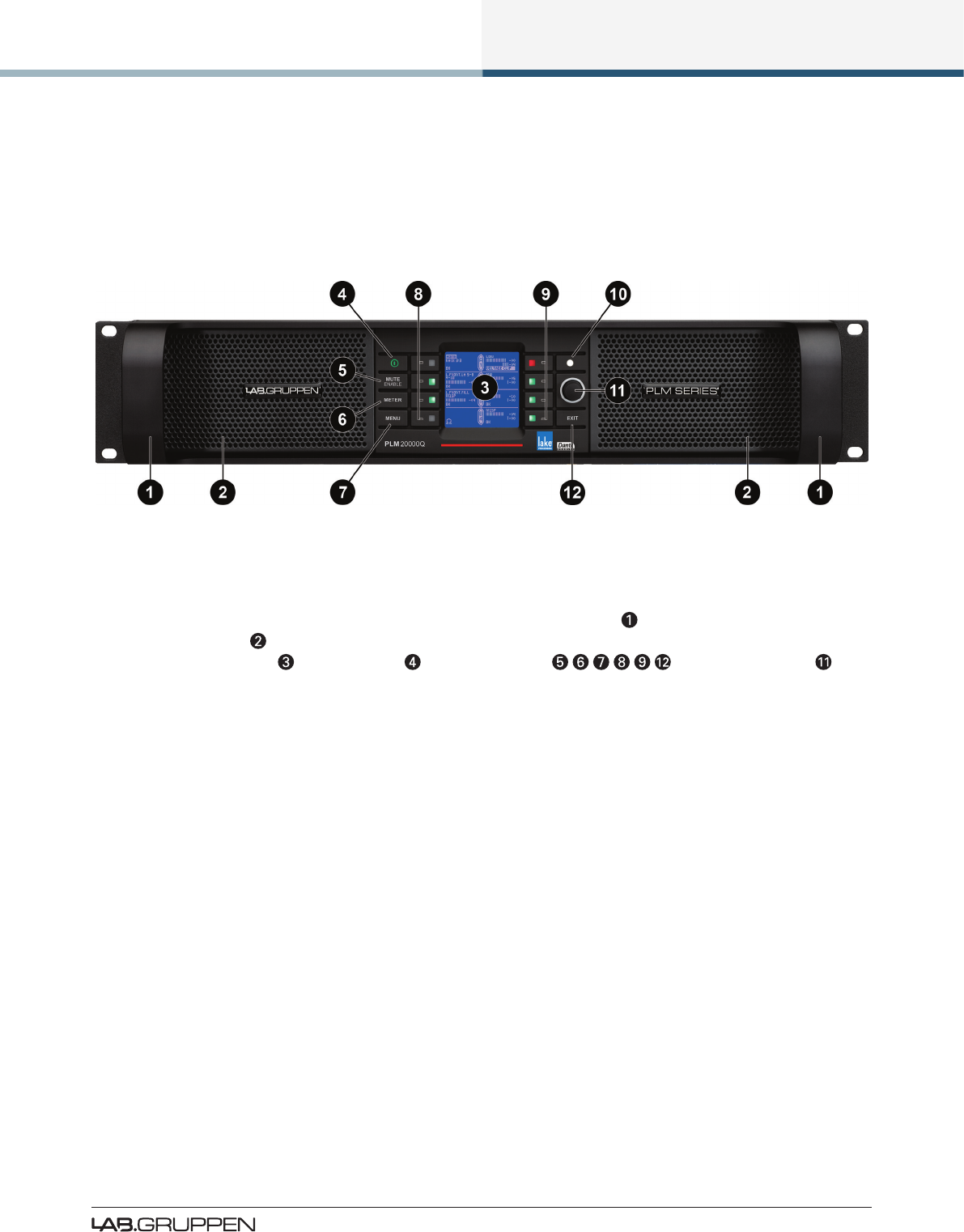
Front Panel Interface
31
PLM Series Operation Manual Rev 1.3.0
7. Front Panel Interface
An overview of the front panel interface is provided in section 4.1. This chapter describes each cluster of
controls as shown in Figure 7-1.
Figure 7-1: Front Panel Interface
7.1 Overview
The front panel interface is framed by two sturdy cast aluminium handles and metal grill protecting the air
intake and dust lters . The majority of PLM functions can be controlled and/or monitored via the front-
panel LCD display screen , power button , function buttons and rotary encoder .
7.1.1 Operating Modes
The front panel has two basic modes: Meter Mode and Menu Mode.
▸Meter Mode provides the following views: Home View (default), Module View, Temperature View and
Input View. To navigate through these views, press the METER button. Please refer to section for
further information on Meter Mode.
▸Menu Mode provides various menus for viewing and editing parameters and is selected by pressing the
MENU button. Select the required submenu by pressing the associated button. Please refer to section
7.11 for further information on Menu Mode.
7.1.2 Warning, Fault and Mute Indications
Fault or warning conditions are indicated via the LEDs embedded in the dynamic function buttons; a simul-
taneous description is shown adjacent to the button, on the LCD. The LEDs to the left of the LCD indicate
problems with the PLM or its inputs, while those to the right indicate problems with the power output
channels.
Please note that the same LEDs also indicate the mute status of inputs (left) and outputs (right). Further
information on faults and warnings is provided in section 7.8.5 and section 9.1.
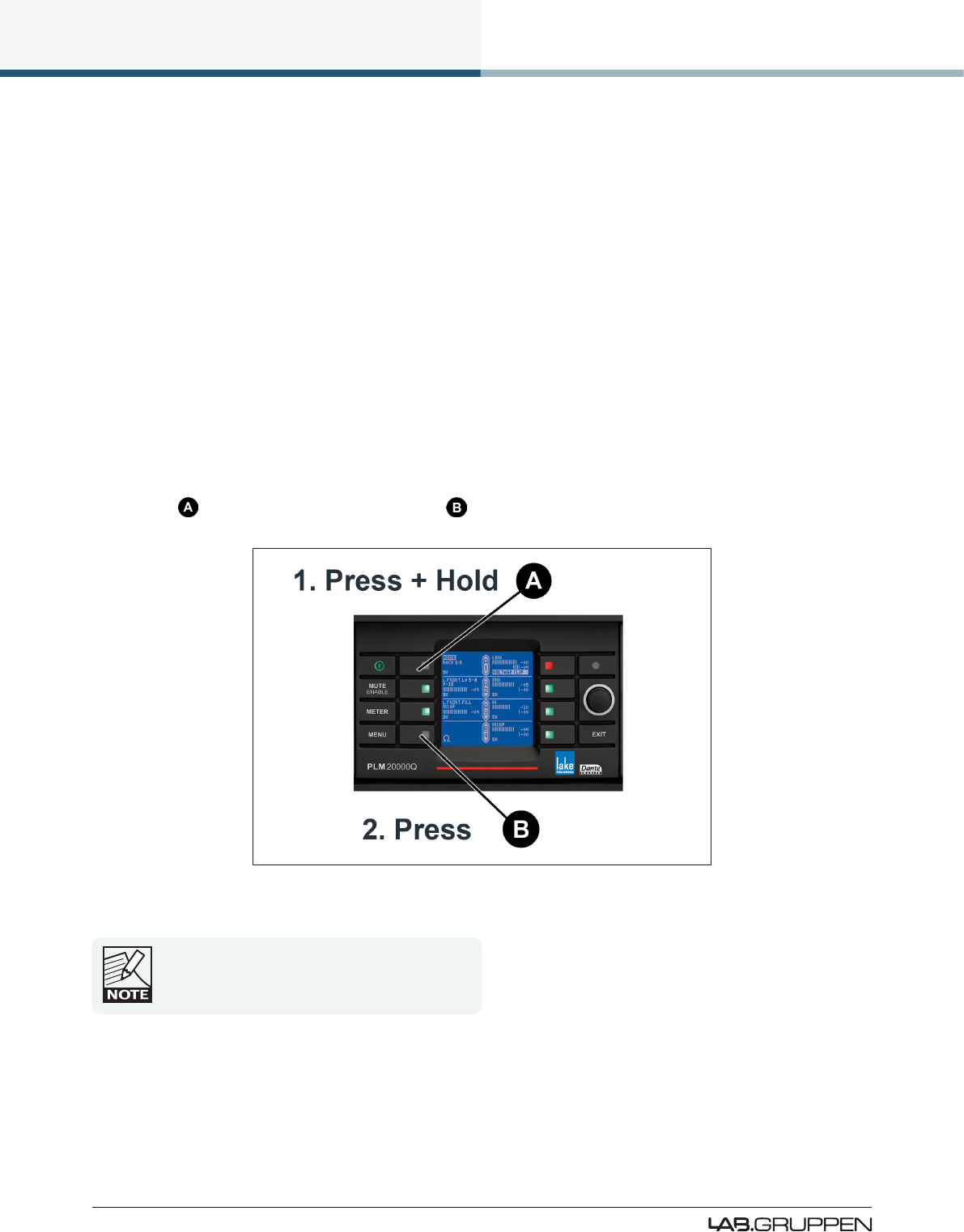
32
Front Panel Interface
PLM Series Operation Manual Rev 1.3.0
7.1.3 Selecting a Module in the Lake Controller software via the
It is sometimes useful to identify which Module icon/s in the Lake Controller software are associated with a
particular hardware Frame. To highlight the module in the Lake Controller software:
1. Ensure Meter Mode is selected
2. Press the button adjacent to the Module description on the LCD
If the Frame is online, but the Module is not in the work area, the selected Module will be centred on the
Module scroll bar (assuming the Modules Menu is selected in the Lake Controller).
7.2 Front Panel Key Lock
It is possible to lock the front panel buttons for security purposes. When this function is active, all front
panel controls are disabled and all adjustment must be made via the network. To lock controls, press and
hold button then simultaneously press button as shown in Figure 7-2; repeat this process to unlock.
Figure 7-2: Locking / Unlocking Front Panel Controls
A key icon will appear at the top of the display
when the Front Panel is locked.
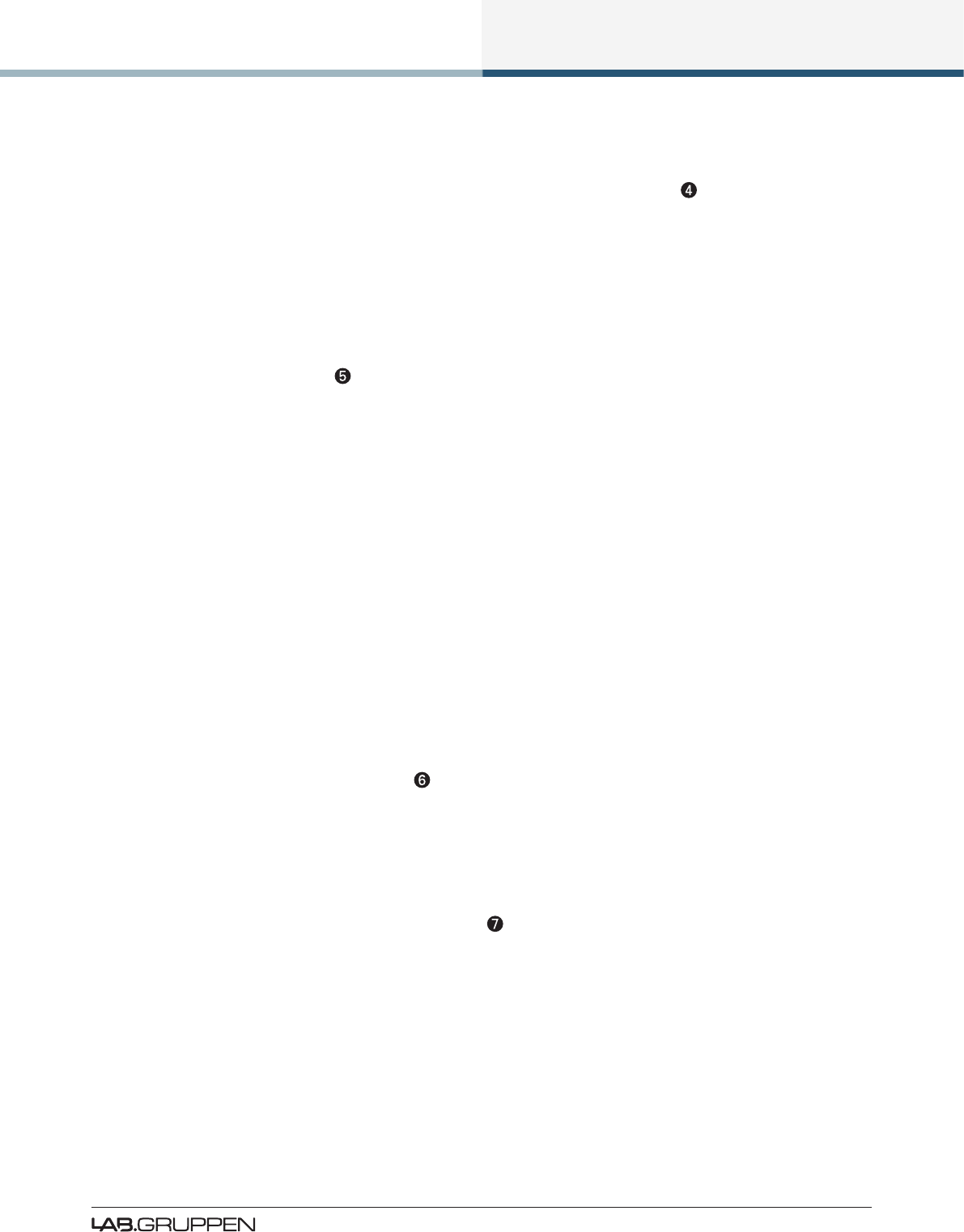
Front Panel Interface
33
PLM Series Operation Manual Rev 1.3.0
7.3 Power Button
The unit is powered on by pressing the top-left button on the front panel, labelled in Figure 7-1. It has a
bi-color power symbol which illuminates red when connected to the AC mains and the unit is in standby
mode. It turns green when the button is pressed to turn the processor on. A subsequent press of this
button returns the unit to standby mode.
7.4 Mute Enable Button
The dynamic function buttons to the immediate left and right of the LCD are used as MUTE buttons only
when the MUTE ENABLE button is activated (ashing).
When MUTE ENABLE is activated, the two central buttons on the left act as Module mute controls, and the
four buttons on the right enable muting/unmuting of the power output channels.
In Meter Mode > Home View with MUTE ENABLE activated, text on the LCD adjacent to each button
indicates when a Module input or power output has been muted. Meter Mode must be selected for
MUTE ENABLE to be activated; MUTE ENABLE is not available in Menu Mode.
To exit MUTE ENABLE mode, press the ashing MUTE ENABLE button. If no mute activity occurs for two
minutes, MUTE ENABLE mode will automatically be disabled.
7.5 Meter Button
The front panel display has two main operating modes, Meter Mode (default) and Menu Mode. In normal
operation, the display will be in Meter Mode.
The following views are available in Meter Mode: Home View (default), Module View, Temperature View
and Input View. Pressing the METER button scrolls through these views. Pressing the METER button
when in Menu Mode will return the system to Meter Mode, with the Home View displayed. Please refer to
section for further information.
7.6 Menu Button
Menu Mode is selected by pressing the MENU button . The screen displays the top level menu with
various submenu options. Press the button adjacent to the required submenu to select it.
Pressing the MENU button while in Menu Mode will display the previous menu level.
Menu Mode is used for processor conguration, or for editing a parameter. Please refer to section 7.11 for
further details.
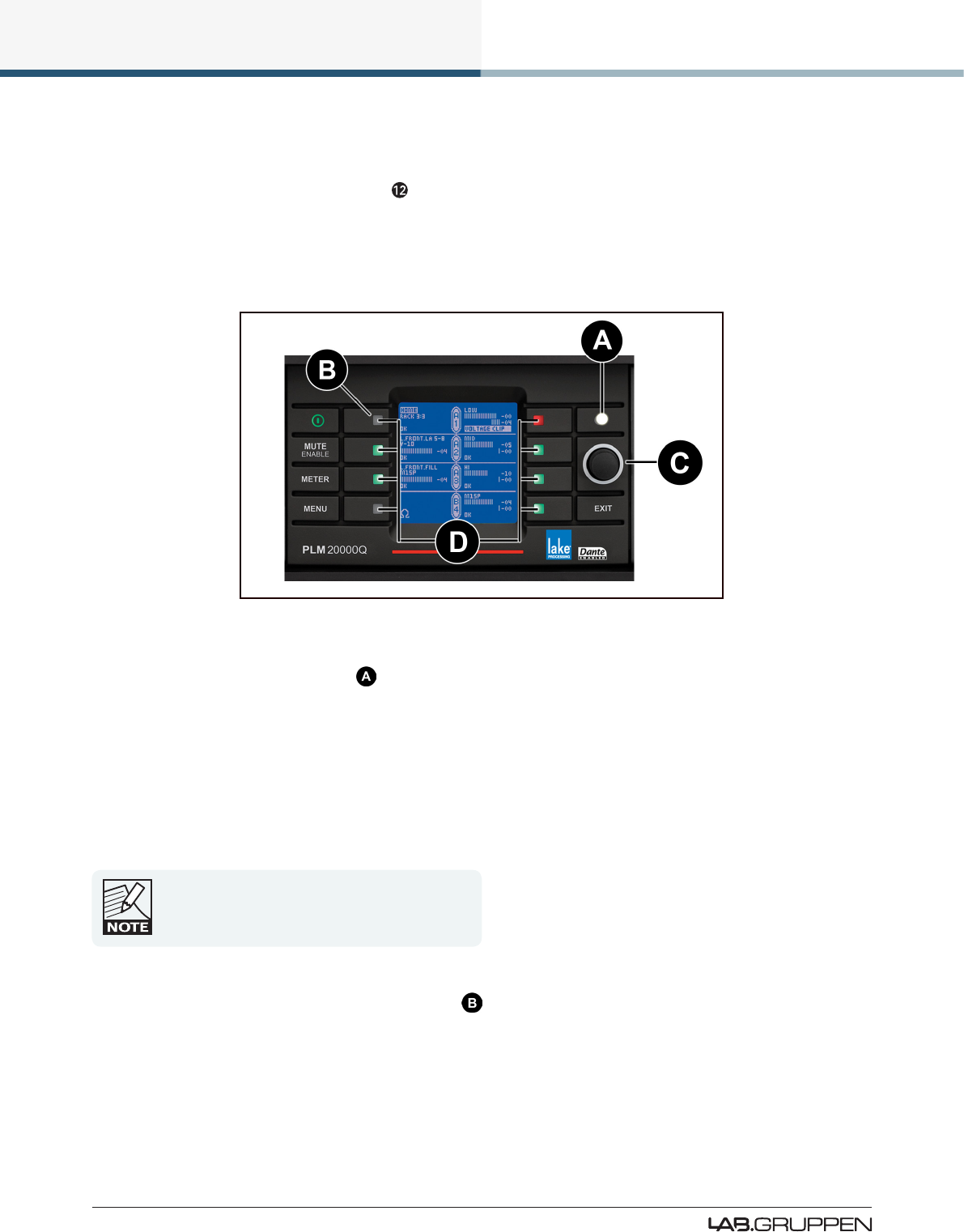
34
Front Panel Interface
PLM Series Operation Manual Rev 1.3.0
7.7 Exit Button
In Menu Mode, pressing the EXIT button returns back one menu level. In Meter Mode, pressing EXIT
returns the display to the Home View.
7.8 Dynamic Buttons, Controls and LEDs
Figure 7-3: LCD with Dynamic Buttons, Controls and LEDs
7.8.1 Communication LED
This bright white LED signies selection in the Lake Controller, or Controller communication providing visual
conrmation of:
1. Network communication between the Lake Controller and the Lake Processor (Flashing LED).
2. Selection of the Lake Processor in the Lake Controller software (Steady LED).
The Communication LED can be dimmed via the
front panel by selecting Frame menu, and then
Front - Dimming.
7.8.2 Frame Faults and Warnings LED
This LED turns red to indicate a Frame fault and turns yellow to indicate a Frame warning. Additional clari-
cation of the fault or warning is displayed in the LCD. All mute, fault and warning states displayed on the
front panel are summarized in section 9.1.
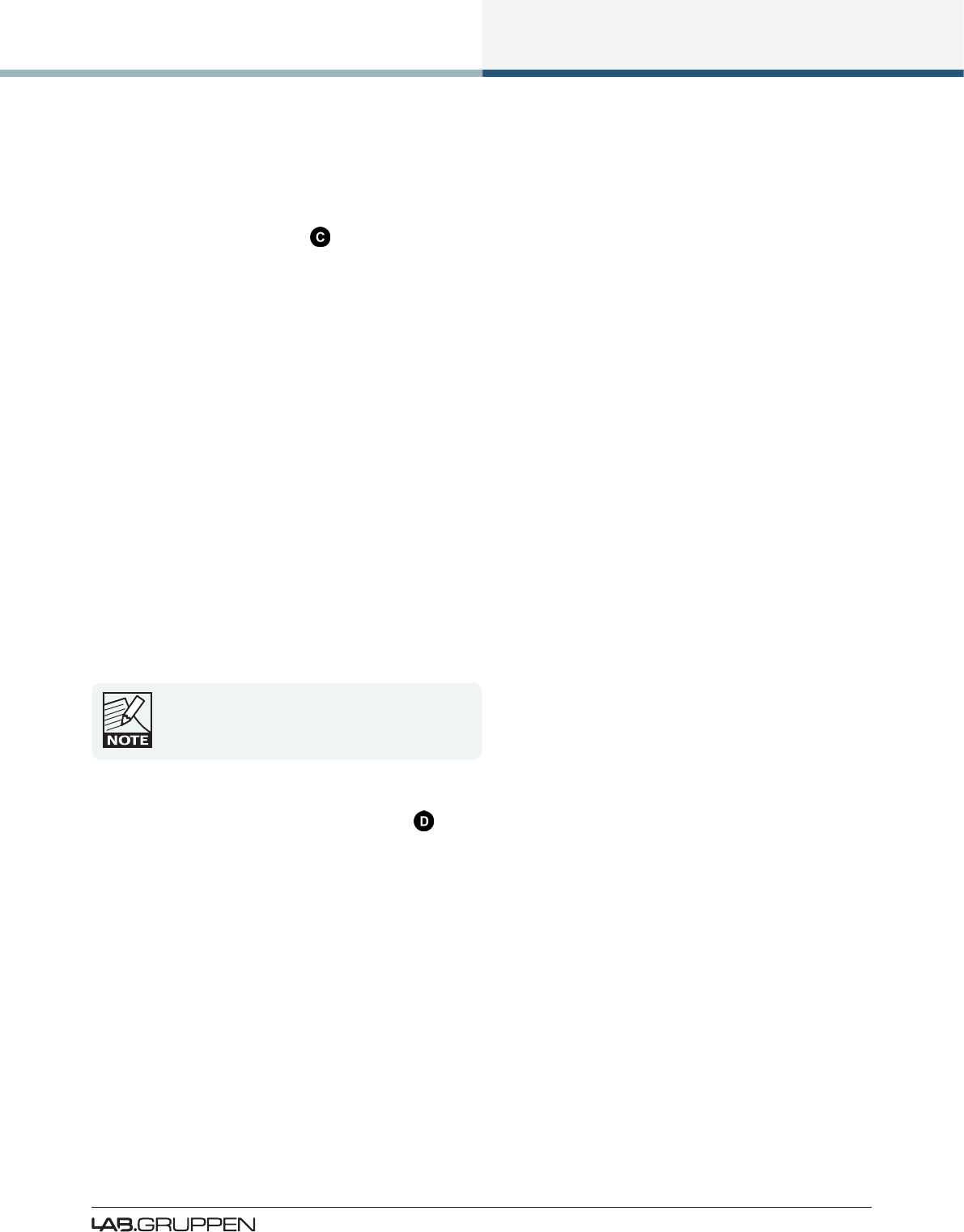
Front Panel Interface
35
PLM Series Operation Manual Rev 1.3.0
Additional faults and warnings are reported in the Event Log of the Lake Controller only. All faults and
warnings recorded in the Event Log are listed in section 9.1 along with scenarios that may have arisen to
cause them.
7.8.3 Rotary Encoder
The rotary encoder is used to adjust parameters in conjunction with the selection made via the dynamic
function buttons and LCD menus. The ring around the rotary encoder illuminates when a selected parameter
is available for adjustment.
Turn the encoder clockwise to increase the selected parameter, or counter-clockwise to decrease the value.
Parameters with only two states (e.g. ON, OFF) are toggled by turning clockwise or counter-clockwise.
Some parameters enable simultaneous adjustment of a combination of input and output channels.
To select which channels are adjusted:
1. Press the associated soft button/s to select the parameter/s for editing.
A selected parameter is indicated by inverse text and background color.
2. Use the rotary encoder to change the value.
It is possible to select multiple parameters for simultaneous editing even if the values are different on each
channel. Turning the rotary encoder will adjust each parameter by the same increment. When in Meter
Mode, the rotary encoder allows the user to change between the available meter views.
Some menus permit parameters to be adjusted
across multiple channels simultaneously by default.
7.8.4 Dynamic Function Buttons
The buttons surrounding the display are unlabeled because their functions change according to the currently
selected menu or display.
In Meter Mode with MUTE ENABLE activated, these dynamic function buttons are used to mute or unmute
the Module Inputs and power output channels.
In Menu Mode these buttons are used to navigate the menu structure.During menu navigation, the color
of the embedded LEDs continue to indicate the mute status, or clips, faults and warnings relevant to the
associated input or output channel on the PLM.
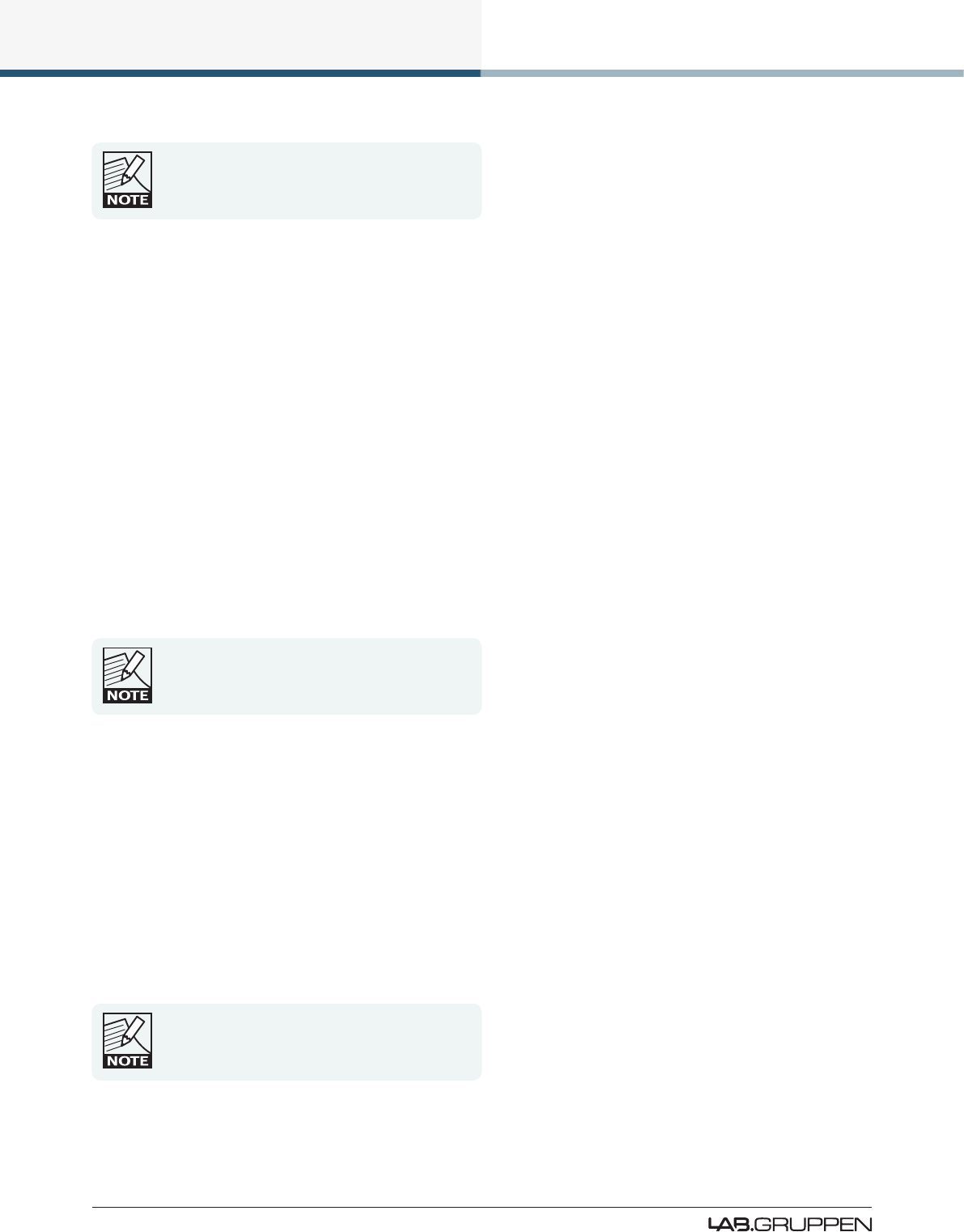
36
Front Panel Interface
PLM Series Operation Manual Rev 1.3.0
Each button contains a tricolor LED which conveys
fault and warning indications in addition to the mute
status. The LED color does not necessarily
correspond to the currently selected function.
7.8.4.1 Mute Functions
The PLM provides mute functions at several different points in its audio chain. Please refer to section 6.1 for
further information. The four types of mute are:
1. PLM Input Mute
2. Module Input Mute
3. Module Output Mute
4. Power Output Mute
With the exception of Module output mutes, all types may be controlled from the PLM front panel in Meter
Mode by activating MUTE ENABLE and selecting the associated input or output Meter View using the
METER button.
Module input and output mutes can be controlled in
Menu Mode via the MENU button. All mutes can
also be controlled from the Lake Controller.
7.8.4.2 PLM Input Mute
The PLM input mute provides the ability to simultaneously mute/unmute all modules or outputs that are
sourced from the PLM input. To mute or unmute the PLM inputs:
1. Press METER until the Input Meter View is displayed
2. Press MUTE ENABLE
3. Use the associated dynamic function buttons to mute / unmute the PLM inputs
The PLM Input Mute is within the Lake Processing
system, post input type selection, and pre input
mixing and routing.
Please refer to the Lake Controller User Manual for details of mute selection via the software.
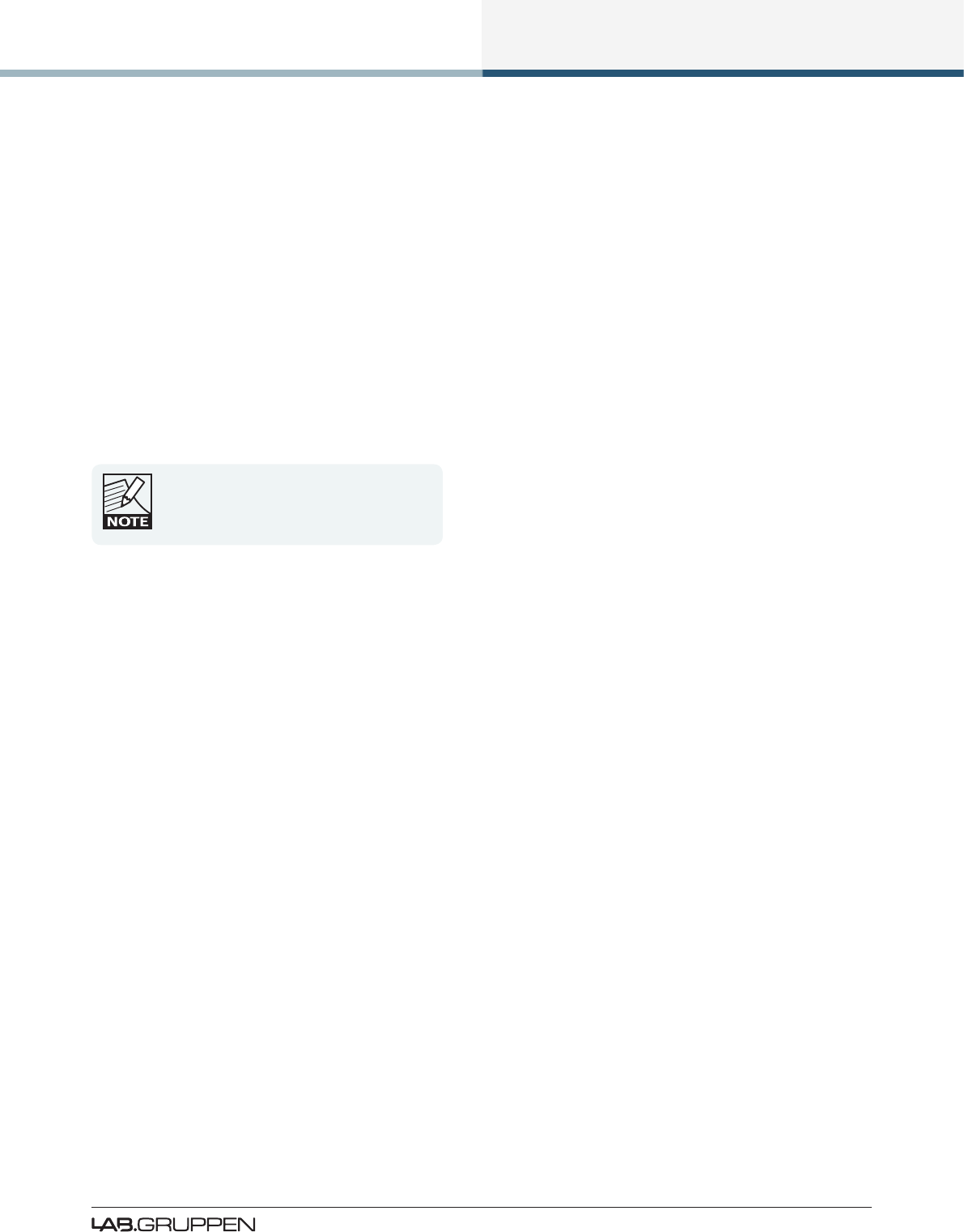
Front Panel Interface
37
PLM Series Operation Manual Rev 1.3.0
7.8.4.3 Module Input Mute
The Module input mute provides the ability to mute/unmute the audio signal at the module level. Therefore,
the PLM input (described in 7.8.4.2) remains unmuted and can be used by another module, or directly
routed to an output. To mute or unmute a Module input:
1. Press METER until Home View is displayed
2. Press MUTE ENABLE
3. Use the associated dynamic function buttons to mute / unmute the Module inputs
Once the Module input is muted, the LED turns red and MOD. IN MUTE is displayed on the LCD. When
unmuted, the LED turns green (unless any other output warning conditions are active)..
Fault condition LED indications take priority
over mute status indications. If a fault
condition occurs, the LED will indicate the
fault and not the mute status.
Module Input Mutes may also be controlled in Menu Mode. See section 7.11.2.6 for further details.
Please refer to the Lake Controller User Manual for details of mute selection via the software.
7.8.4.4 Module Output Mute
Module Output Mute is part of the Lake Processing system, at the crossover outputs. It is post Module
output EQ and level adjustment, pre PLM’s protection circuitry.
Muting of the Module outputs is unavailable via MUTE ENABLE in Meter Mode, as the PLM power output
mutes are assigned in this mode (see section 7.8.4.5). However, Module output mute status and control is
available in Menu Mode and may also be viewed and controlled from the Lake Controller software.
Please refer to section 7.11.2.6 for details of selecting Module Output Mute in Menu Mode.
Refer to the Lake Controller User Manual for details of mute selection via the software.
7.8.4.5 Power Output Mute
The four dynamic function buttons to the right of the LCD control the Power Output Mutes of output
channels 1-4. These mutes are located within the PLM’s power output stage.
When a PLM power output is muted, the LED turns red and the text AMP CH. MUTE is displayed on the
LCD. When unmuted, the LED turns green (unless any other output warning conditions are active).
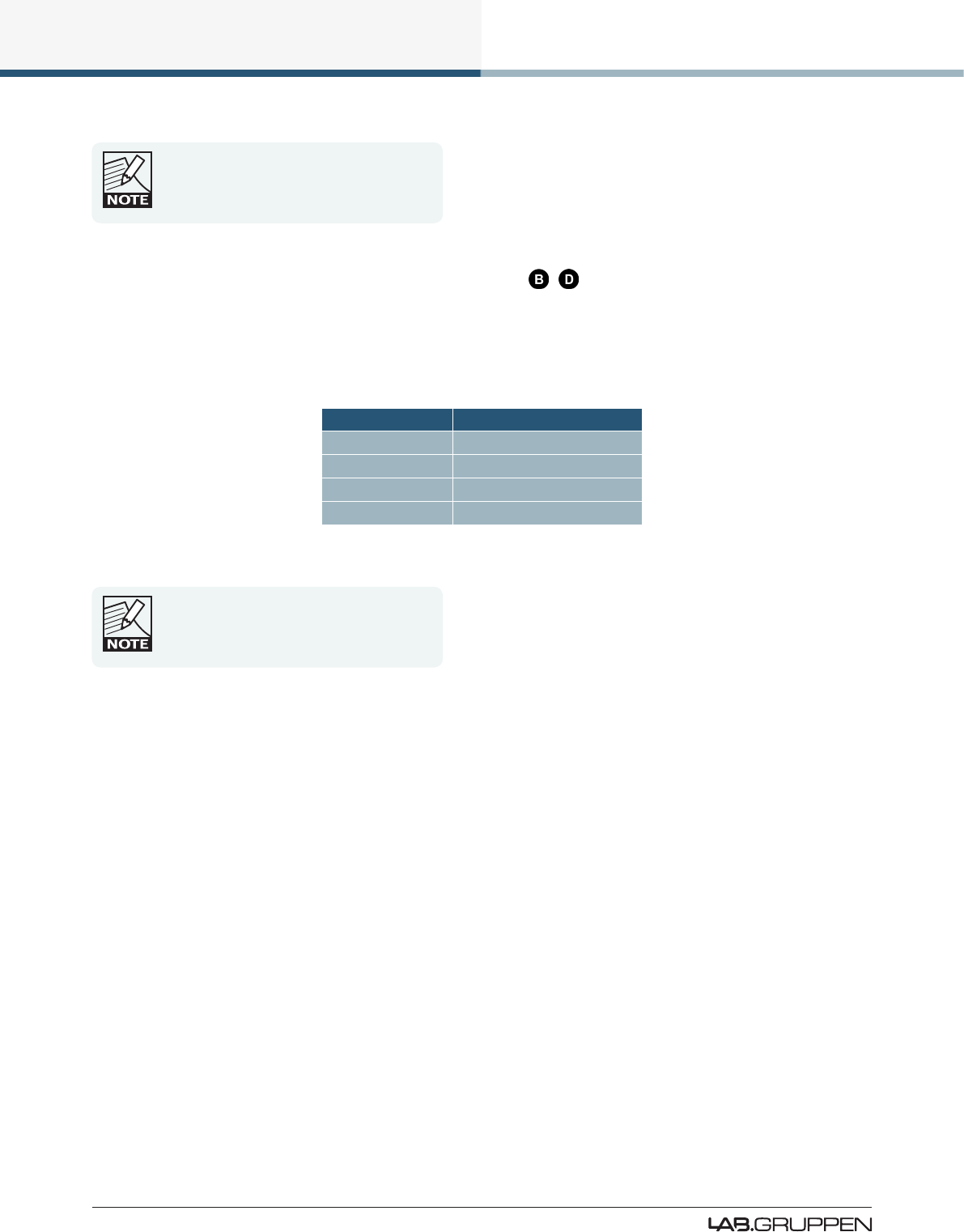
38
Front Panel Interface
PLM Series Operation Manual Rev 1.3.0
Fault condition LED indications take priority
over mute status indications. If a fault
condition occurs, the LED will indicate the
fault and not the mute status.
7.8.5 LED Fault, Warning and Clip Indication
A tricolor LED is embedded inside each of the eight dynamic function buttons. These convey a variety of
status indications including faults and warnings, signal clip indications, Module input mute, Module output
mute and Power Output mute. Table 7-1 summarizes the meaning of the LED indications.
LED Color Indication
Green Status Good / Unmuted
Yellow Warning
Red Fault / Muted
Flashing Red Clip
Table 7-1: LED Fault and Warning Indications
An unlit output LED indicates either the
channel is not available for the model in use,
or that the power output channel is not
routed to a Module output channel.
7.8.5.1 Clip Indication
The front panel LEDs also indicate input and output clip or pre-clip conditions that can occur within the PLM.
Input Clip
Input clipping is monitored at two stages in the signal path:
▸Analog Input Stage: If the input signal exceeds either +12 dBu or +26 dBu (according to analog sensitiv-
ity setting), a clip indication is displayed. Not applicable for AES or Dante inputs.
▸Module Input Stage: If the signal level at this point exceeds +25 dBu, a clip indication is displayed.
Input clipping is indicated the affected Module LED ashing red and INPUT CLIP displayed on the LCD.
If a subsequent input clip within 400 ms is detected, the LED remain lit for a longer period.
Output Clip
All output channels are monitored by a suite of protection circuits that include a Current Peak Limiter (CPL)
and an Inter-Sample Voltage Peak Limiter (ISVPL). Please refer to section 5.3 for further information.

Front Panel Interface
39
PLM Series Operation Manual Rev 1.3.0
If CPL protection is active, or a voltage clip occurs, then the associated Power Output Channel LED will ash
red and a text warning will also be displayed on the screen.
7.8.5.2 Warning or Fault Indications
If certain parameters within the PLM approach or exceed preset limits, a warning condition or fault condition
may arise. One or more LEDs provide a visual indication of the problem, along with an on-screen description
of the condition displayed adjacent to the LED/s.
▸A green LED conrms inputs or outputs are unmuted and operating normally
▸A yellow LED signies a warning are reserved for PLM warnings
▸A red LED indicates a fault, clip or mute
An Event Log le lists all warnings with date and time stamps, please refer to the Lake Controller Operation
Manual for further information the Event Log.
Please refer to Table 7-2 and Table 7-3 below, and to Table 9-1 on page 76, for a detailed description of faults
and warnings.
7.9 Warning and Fault Indications
Table 7-2 lists the warning conditions signied by a yellow LED; Table 7-3 lists the fault conditions signied
by a red LED.
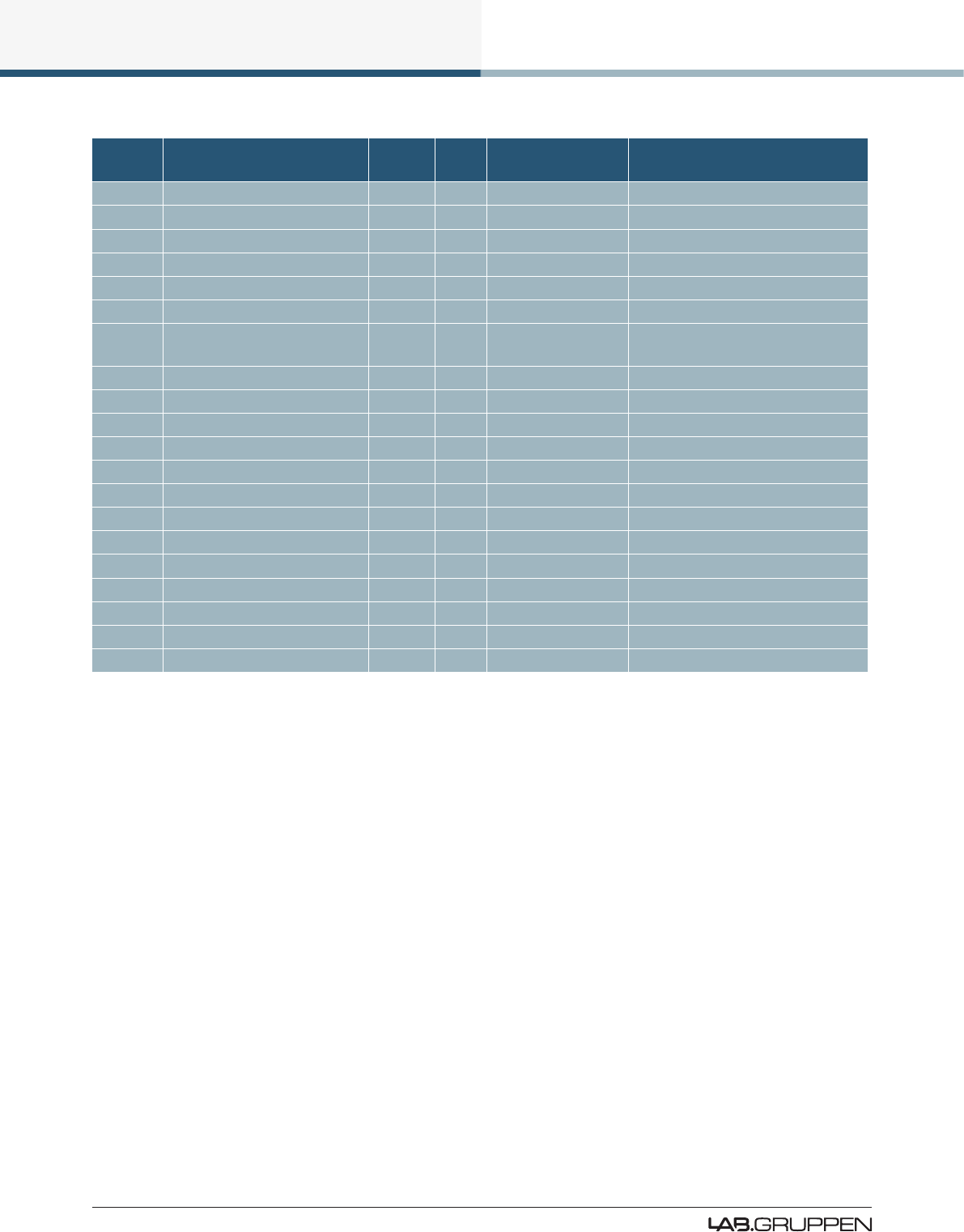
40
Front Panel Interface
PLM Series Operation Manual Rev 1.3.0
PLM
Model
Warning Type LED
No.
On Screen
Warning Text
Event Log Text
20000Q Amp Temp Limit Frame 1 ATL ACTIVE N/A
ALL AES Clock Slipping Module 1 CLOCK SLIPPING AES Clock Slipping
ALL Amp Temp Warning Channel 5-8 TEMP WARN:CH Temp warning: Amp Channel
20000Q BEL Active Frame 1 BEL ACTIVE N/A
ALL Controller Ofine Frame 1 CTRL OFFLINE N/A
ALL Frame Ofine - 1 OFFLINE Frame Ofine
ALL Load Not Veried Module
Channel
2+3
5-8
LOAD NOT VER LoadSmart: Load Not Veried
ALL Load Uncertain Channel 5-8 UNCERTAIN LOAD Uncertain About Load Type
20000Q PSU Mains Glitch Frame 1 MAINS GLITCH Glitch on Mains Voltage Detected
20000Q PSU Power Limit Frame 1 PAL ACTIVE N/A
20000Q PSU Temp Limit Frame 1 PTL ACTIVE N/A
ALL PSU Temp Warning Frame 1 TEMP WARN: PSU Temp Warning: Power Supply Unit
ALL Sense Fault Frame 1 SENSE FAULT Frame warning: Sense Fault
ALL Speaker Mag Temp Warning Channel 5-8 TEMP WARN:MAG Temp Warning: Speaker Magnet
ALL Speaker Over Count Channel 5-8 OVER SPKR CNT Over Speaker Count
ALL Speaker Under Count Channel 5-8 UNDER SPKR CNT Under Speaker Count
ALL Speaker VC Temp Warning Channel 5-8 TEMP WARN:VC Temp Warning: Speaker Voice-Coil
ALL SpeakerSafe Not Started Ch 5-8 SPKSAFE INACT SpeakerSafe Not Started
ALL SpeakerSafe Precision Low Ch 5-8 LM PREC. LOW SpeakerSafe Precision Low
20000Q Under Voltage Limit Frame 1 UVL ACTIVE N/A
Table 7-2: Warning Conditions (Yellow LED)
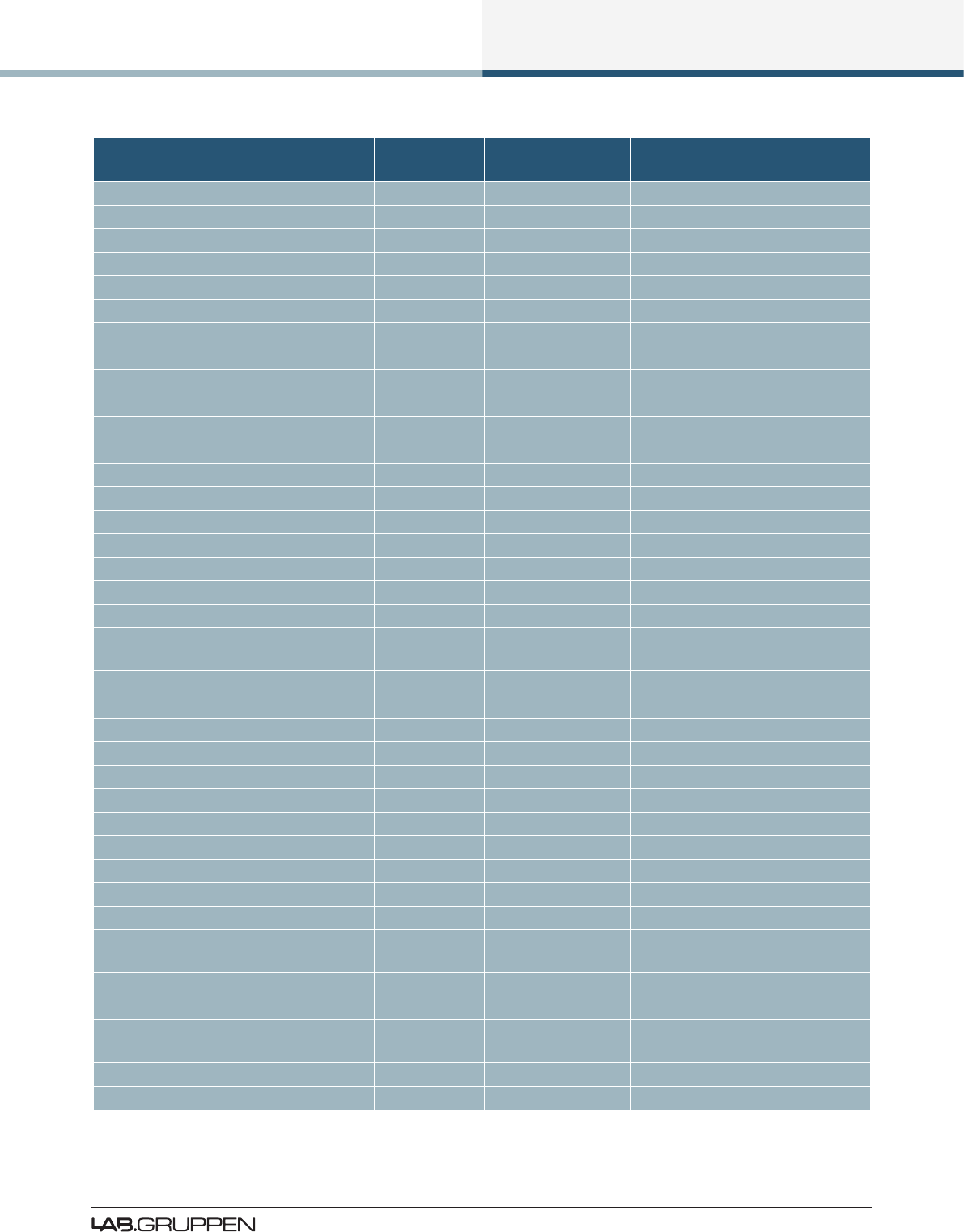
Front Panel Interface
41
PLM Series Operation Manual Rev 1.3.0
PLM
Model
Fault/Clip/Mute Type LED
No.
On Screen Warning
Text
Event Log Text
ALL Amp Ch Mute Channel 5-8 AMP CH. MUTE Amp Channel Mute
ALL Amp Temp Fault Channel 5-8 TEMP FLT:CH Temp Fault: Amp Channel
ALL Analog Input Fault Frame 1 ANALOG IN FAULT Frame Fault: Analog Input
20000Q Check AC Mains Frame 1 CHECK AC MAINS Frame Fault: Check AC Mains
ALL Current Average Limiter Channel 5-8 CAL ACTIVE n/a
ALL Current Protection Limiter Channel 5-8 CURRENT CLIP N/A
ALL DSP Area Temp Fault Frame 1 TEMP FLT:DSP Temp Fault: DSP Area
ALL Input Channel Mute Inp.Mix 2+3 INPUT MUTE Input Mute
ALL Internal Audio Interface Fault Frame 1 AUDIO FAULT Frame Fault: Audio Interface
ALL Module Input Mute Module 2+3 MOD. IN MUTE Module Input Mute
ALL Module Output Clip Module 2+3 MOD. CLIP n/a
ALL Module Output Mute Channel 5-8 MOD. OUT MUTE Module Output Mute
ALL No input source available Module 2+3 NO INPUT No Input Source
ALL No Load Detected at Output Channel 5-8 NO LOAD Channel Fault: No Load Detected
ALL Physical Input Clip Module 2+3 INPUT CLIP n/a
ALL Power Average Limiter Frame 1 PAL ACTIVE n/a
ALL Power Channel Failure Channel 5-8 SERVICE CH. Channel Fault: Unit Needs Service
ALL PSU Area Temp Fault Frame 1 TEMP FLT:PSU Temp Fault: Power Supply Unit
ALL PSU Fault / Undervoltage Frame 1 PSU FAULT Frame Fault: PSU Undervoltage
20000Q PSU Mains Over Voltage Peak Frame 1 MAINS >400 VPK Frame Fault: PSU Mains >400
VPK
20000Q PSU Mains Over Voltage RMS Frame 1 MAINS >270 V Frame Fault: PSU Mains >270 V
20000Q PSU Mains Under Voltage Frame 1 MAINS <65 V Frame Fault: PSU Mains <65 V
20000Q PSU Needs Service 1 Frame 1 NEED SERVICE:1 Frame Fault: Need Service: 1
20000Q PSU Needs Service 2 Frame 1 NEED SERVICE:2 Frame Fault: Need Service: 2
20000Q PSU Needs Service 3 Frame 1 NEED SERVICE:3 Frame Fault: Need Service: 3
20000Q PSU Needs Service 4 Frame 1 NEED SERVICE:4 Frame Fault: Need Service: 4
20000Q PSU Needs Service 5 Frame 1 NEED SERVICE:5 Frame Fault: Need Service: 5
20000Q PSU Needs Service 6 Frame 1 NEED SERVICE:6 Frame Fault: Need Service: 6
20000Q PSU Needs Service 7 Frame 1 NEED SERVICE:7 Frame Fault: Need Service: 7
20000Q PSU Needs Service 8 Frame 1 NEED SERVICE:8 Frame Fault: Need Service: 8
20000Q PSU Rail Protect Frame 1 PSU POWER PROT Frame Fault: PSU Power Protect
ALL Short Circuit Protection Channel 5-8 SHORT CIRCUIT Channel Fault: Short Circuit
Protection
ALL Speaker Magnet Temp Fault Channel 5-8 TEMP FLT:MAG Temp Fault: Speaker Magnet
ALL Speaker VC Temp Fault Channel 5-8 TEMP FLT:VC Temp Fault: Speaker Voice Coil
ALL VHF Protection Channel 5-8 VHF FAULT Channel Fault: Very High
Frequency
ALL Voltage Protection Limiter Channel 5-8 VOLTAGE CLIP n/a
ALL Wrong Type of Speaker Channel 5-8 WRONG LOAD Load Type / Routing Mismatch
Table 7-3: Fault Conditions (Red LED)
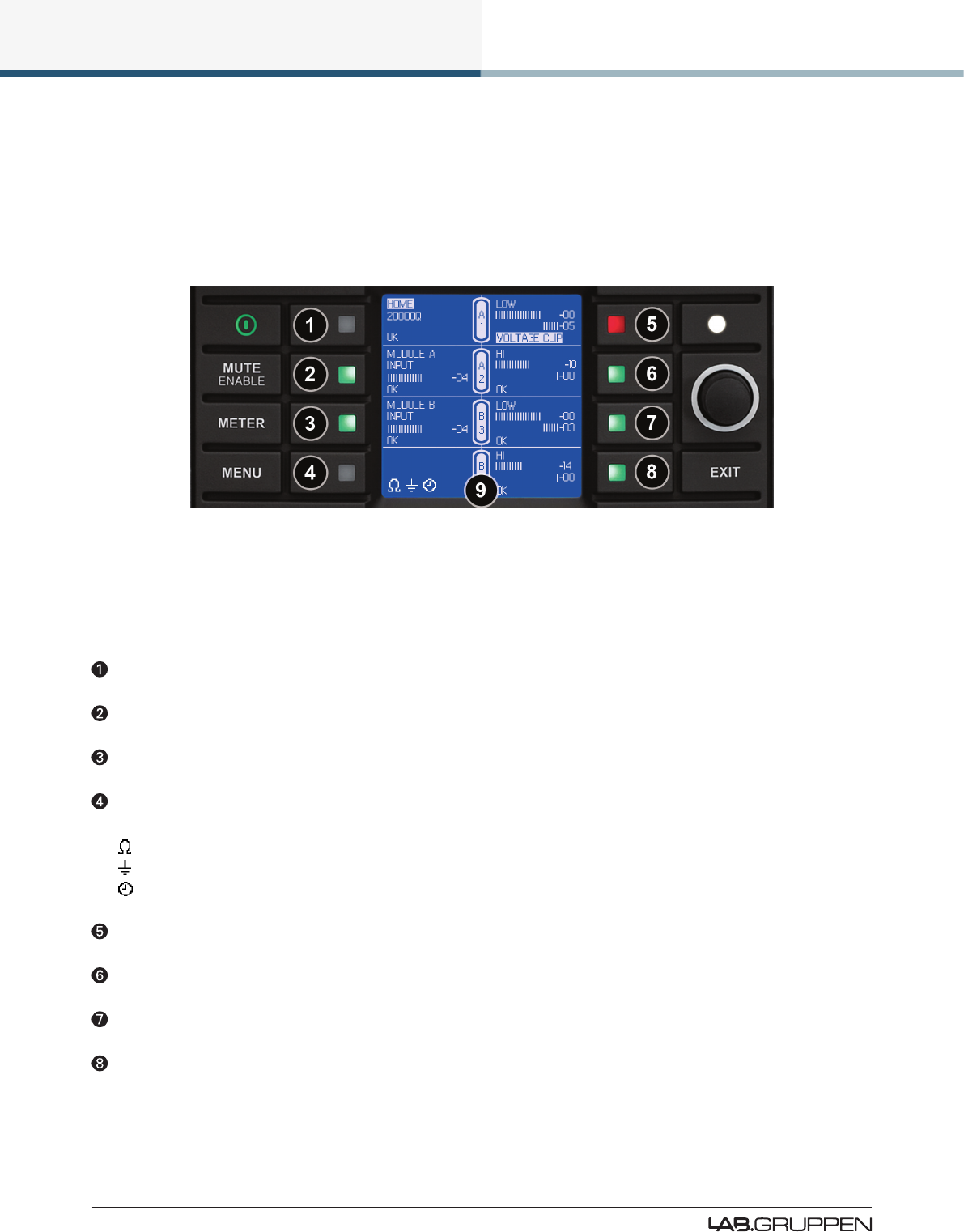
42
Front Panel Interface
PLM Series Operation Manual Rev 1.3.0
7.10 Meter Mode
7.10.1 Home View
The default view when powering on the device is Meter Mode > Home View as shown in Figure 7-4.
Figure 7-4: Meter Mode > Home View
Home View provides a summary of Module I/O gain level and limiter gain reduction, along with frame,
module and channel labeling information. The example in Figure 7-4 shows a stereo 2-Way, with Module A
(Input 1) feeding power output channels 1&2, and Module B (Input 2) feeding power output channels 3&4.
Current View title & Frame label, Frame faults and warnings.
Module A label, input gain meter, faults, warnings, clips & mutes.
Module B label, input gain meter, faults, warnings, clips & mutes.
This section displays conrmation of the following settings:
AES3 Input Terminated (no icon = Unterminated)
Analog Inputs Iso-Float Grounded (no icon = Floating)
Dante Clock Master (no icon = Dante Slave or Dante Disabled)
Power output 1 label, gain & limiter meters, faults, warnings, clips & mutes.
Power output 2 label, gain & limiter meters, faults, warnings, clips & mutes.
Power output 3 label, gain & limiter meters, faults, warnings, clips & mutes.
Power output 4 label, gain & limiter meters, faults, warnings, clips & mutes.
Please refer to Table 7-2 and Table 7-3 on page 41 for full details on the faults and warnings that could be
displayed in any of the above locations.
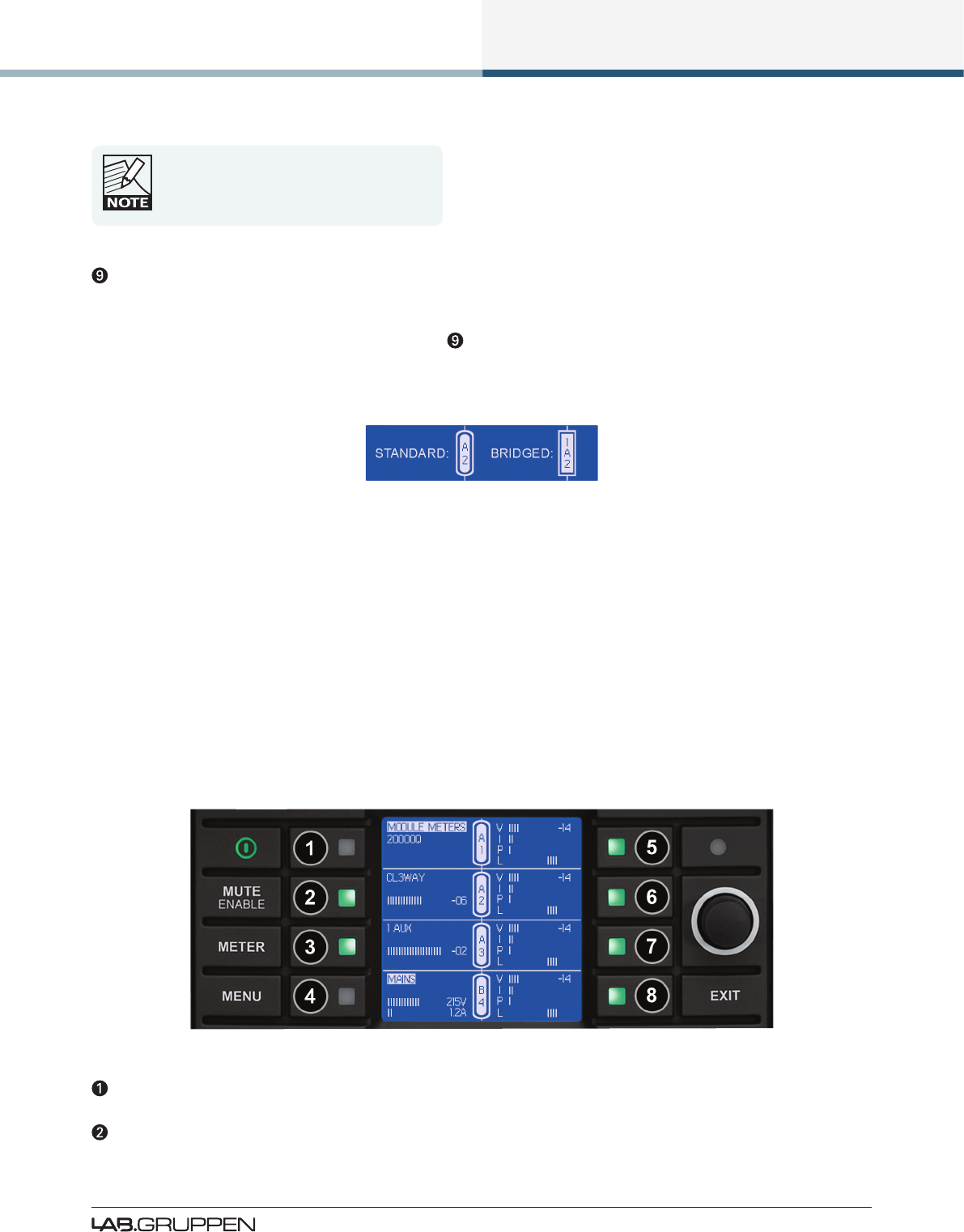
Front Panel Interface
43
PLM Series Operation Manual Rev 1.3.0
Output limiter (gain reduction) meters take
into account the sum of PLM ISVPL and Lake
LimiterMax.
The icons in the center of the LCD indicate the amplier channel to which each module output is routed.
When two amplier channels are Bridged, both channels will be displayed.
The type of icon used in the center of the screen conrms whether the PLM outputs are congured in
Standard mode or Bridge Mode, as shown in Figure 7-5. For further information on Bridge Mode, please
refer to section 8.1.1.
Figure 7-5: Standard and Bridge Mode Front Panel Icons
Bridge Mode is visible via this icon notation on the PLM Front Panel in Home View, however, the
Lake Controller must be used to congure Bridge Mode; please refer to the Lake Controller Operation
Manual for further information.
Home View looks similar for most congurations, with slight variations dependant on the PLM model and
processor conguration.
7.10.2 Module View
Module View provides further signal level information in the form of additional power output meters as
shown in Figure 7-6.
Figure 7-6: Meter Mode > Module View
Current View title & Frame label, Frame faults and warnings
Module A label and input gain meter
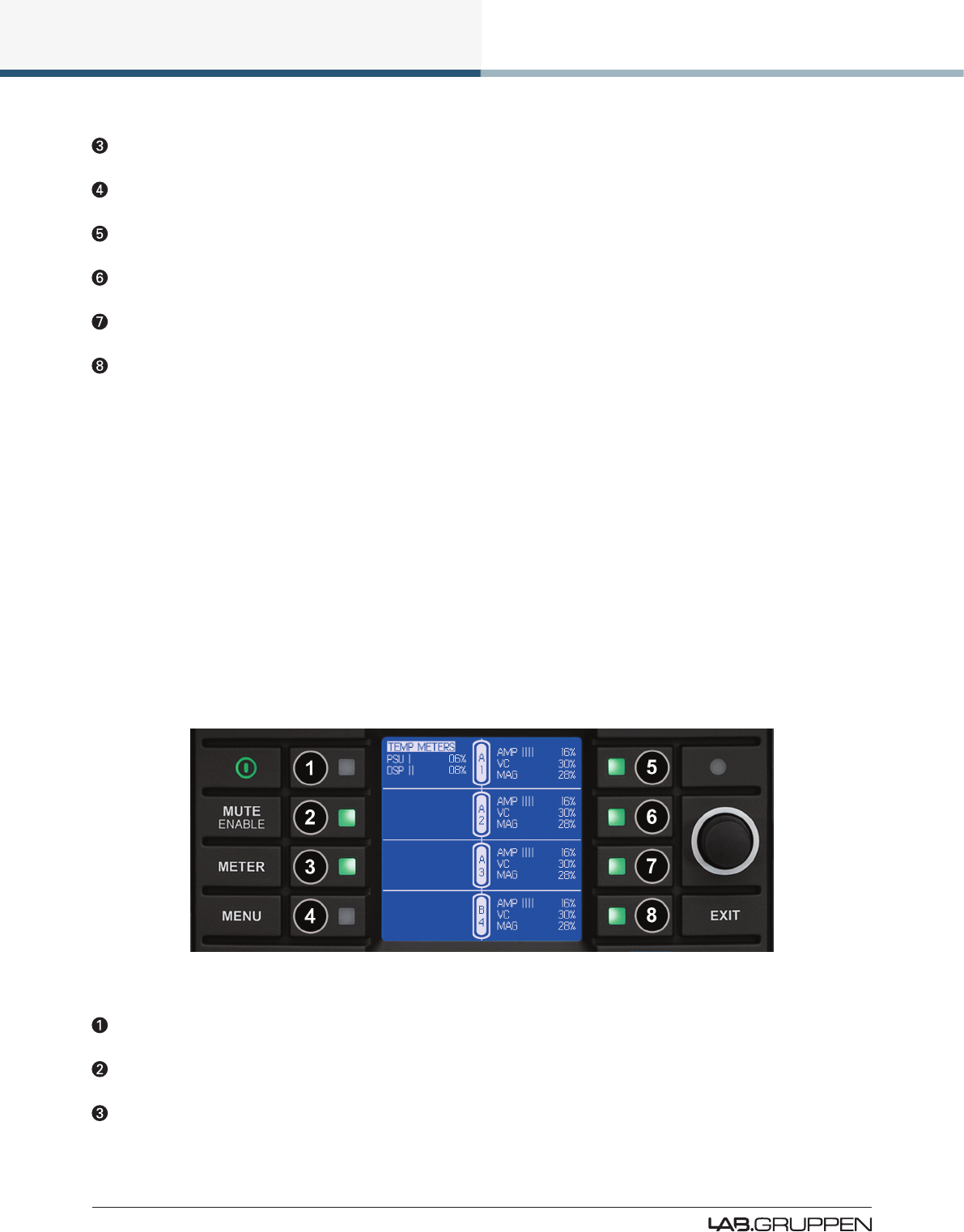
44
Front Panel Interface
PLM Series Operation Manual Rev 1.3.0
Module B label and input gain meter
Main Voltage and Ampere Meter (PLM 20000Q ONLY)
Output 1: V - Voltage Meter I - Current Meter P - Power Meter L - Gain Reduction Meter
Output 2: V - Voltage Meter I - Current Meter P - Power Meter L - Gain Reduction Meter
Output 3: V - Voltage Meter I - Current Meter P - Power Meter L - Gain Reduction Meter
Output 4: V - Voltage Meter I - Current Meter P - Power Meter L - Gain Reduction Meter
▸The Voltage Meter (V) indicates the PLM’s power output stage voltage relative to its clip level
▸The Current Meter (I) indicates the current the power output stage is driving into its load, relative to the
maximum permissible current the xed CPL allows
▸The Power Meter (P) indicates the instantaneous output power being developed in the load relative to
the PLMs maximum output power capability.
▸The Gain Reduction Meter (L) indicates the degree of limiting being applied by the PLM ISVPL and/or
the Lake LimiterMax.
7.10.3 Temperature View
Temperature View provides information about the current operating temperatures within the PLM and the
connected loudspeakers.
Figure 7-7: Meter Mode > Temperature View
Current View title. Power supply temp (PSU) & Lake processor temp (DSP) as percentage of maximum
Unused in Temperature View
Unused in Temperature View
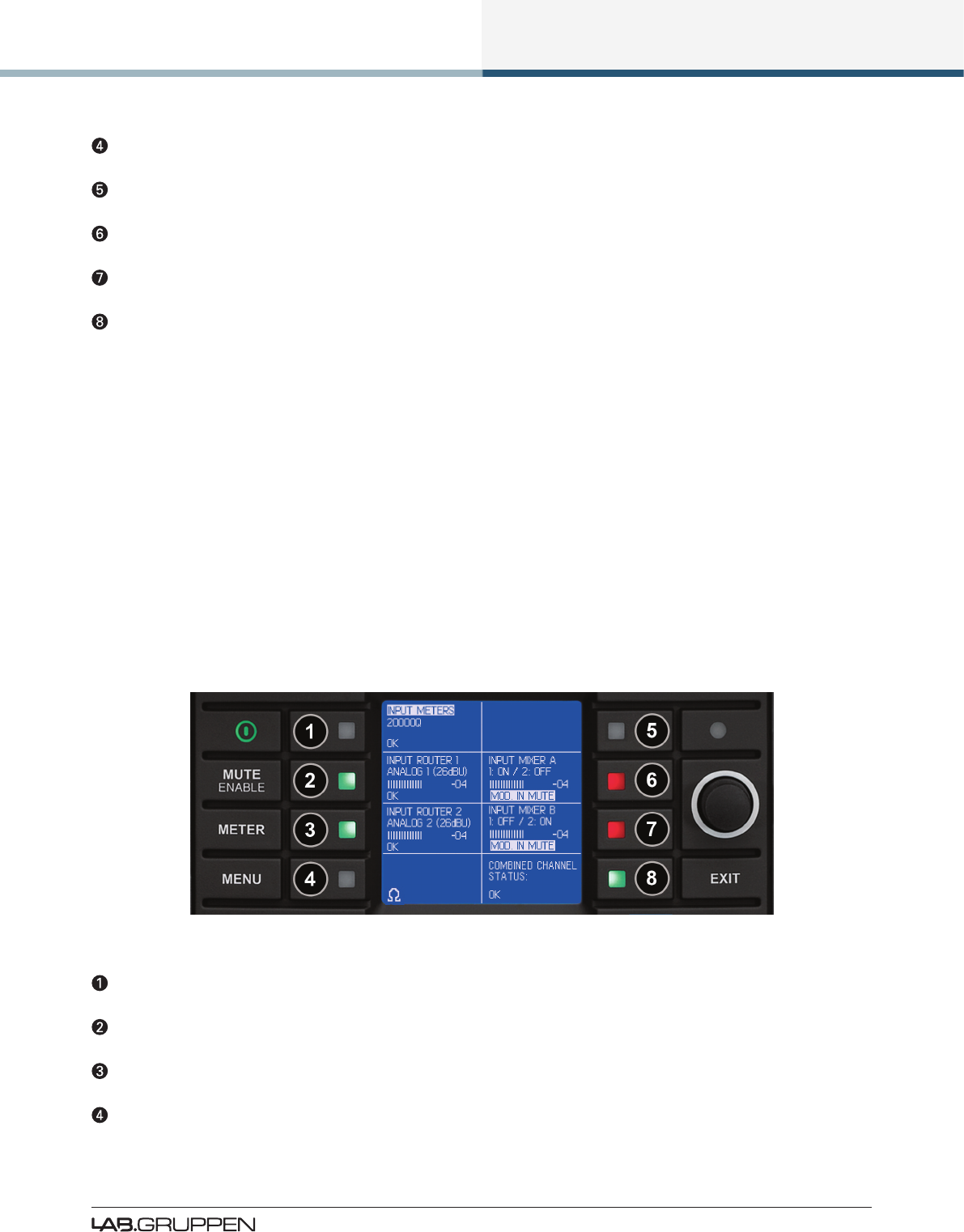
Front Panel Interface
45
PLM Series Operation Manual Rev 1.3.0
Unused in Temperature View
Output 1: AMP - Temp of power output VC - Temp of voicecoil MAG - Temp of magnet
Output 2: AMP - Temp of power output VC - Temp of voicecoil MAG - Temp of magnet
Output 3: AMP - Temp of power output VC - Temp of voicecoil MAG - Temp of magnet
Output 4: AMP - Temp of power output VC - Temp of voicecoil MAG - Temp of magnet
▸AMP indicates the current actual temperature of that channel’s power output stage as a percentage of
its maximum permitted value. The numerical value is in dB relative to signal clip.
▸The computed temperature of voice coil (VC) of the loudspeaker connected to that output channel. This
parameter is calculated using the power currently being dissipated in the load, and by using the loud-
speaker data from the LoadLibrary Fingerprint as presented by the SpeakerSafe output. The numerical
value is displayed in degrees Celsius.
▸The computed temperature of the magnet (MAG) of the loudspeaker connected to the output channel.
This parameter is calculated and displayed in a similar way to the voice coil (VC) temperature.
7.10.4 Input View
Input View enables inspection of the input signal before the input mixer (i.e. prior to the Home View Module
input meters).
Figure 7-8: Meter Mode > Input View
Current View title & Frame label, Frame faults and warnings
Input Router 1: Selected input type, input gain level (relative to clip), router fault/warning/clip
Input Router 2: Selected input type, input gain level (relative to clip), router fault/warning/clip
This section displays conrmation of the following settings:
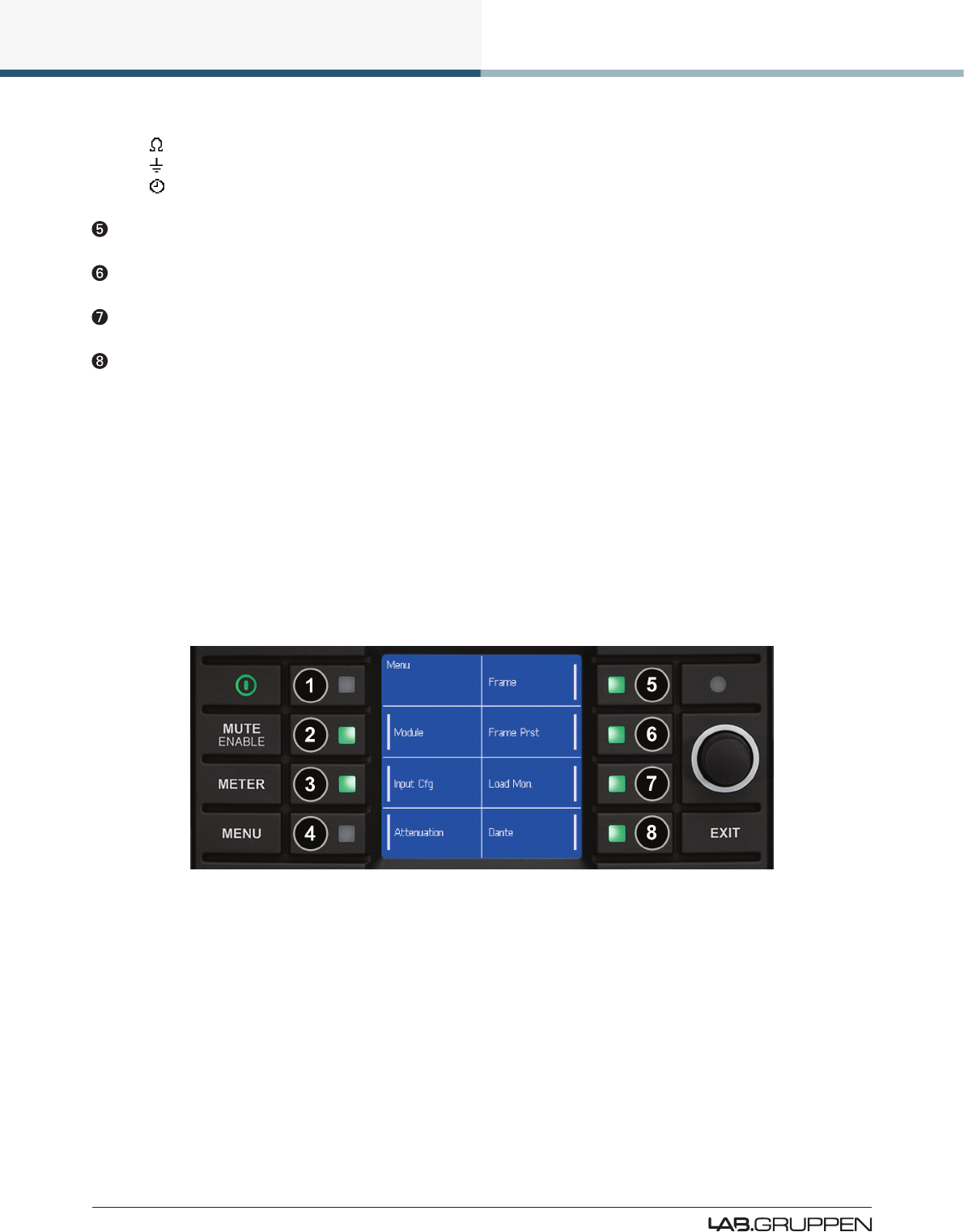
46
Front Panel Interface
PLM Series Operation Manual Rev 1.3.0
AES3 Terminated Icon (no icon = AES Unterminated)
Iso-Float Grounded Icon (no icon = Iso-Float Floating)
Dante Clock Master Icon (no icon = Dante Slave or Dante Disabled)
Unused in Input View
Module A Input Mixer: Input 1/2 Connection Status, Module A input level meter
Module B Input Mixer: Input 1/2 Connection Status, Module A input level meter
Combined channel status summarizing faults and warnings for all power outputs
7.11 Menu Mode
7.11.1 Overview
The majority of functions can be accessed via Menu Mode on the front panel. These functions include
the adjustment of gain, delay, limiters, input and output routing, and the ability to recall Frame Presets.
Menu Mode can be accessed at any time by pressing the MENU button.
After pressing the MENU button, various submenu options are displayed as shown in Figure 7-9.
Figure 7-9: Menu Mode > Main Menu
Press the illuminated button adjacent to the required option to display an associated submenu. When
parameter level is reached, individual parameters may be selected for adjustment by pressing the adjacent
button. The selected parameter value/s are highlighted, and are adjustable using the rotary encoder.
A parameter may be adjusted simultaneously across multiple channels by selecting all values to be adjusted;
any current value offsets are retained. Some parameters default to multiple selection, with all inputs or
outputs adjusted simultaneously. Changes are effected in real-time and a stored without further conrma-
tion. Pressing EXIT returns to the previous menu level, automatically retaining any parameter changes.
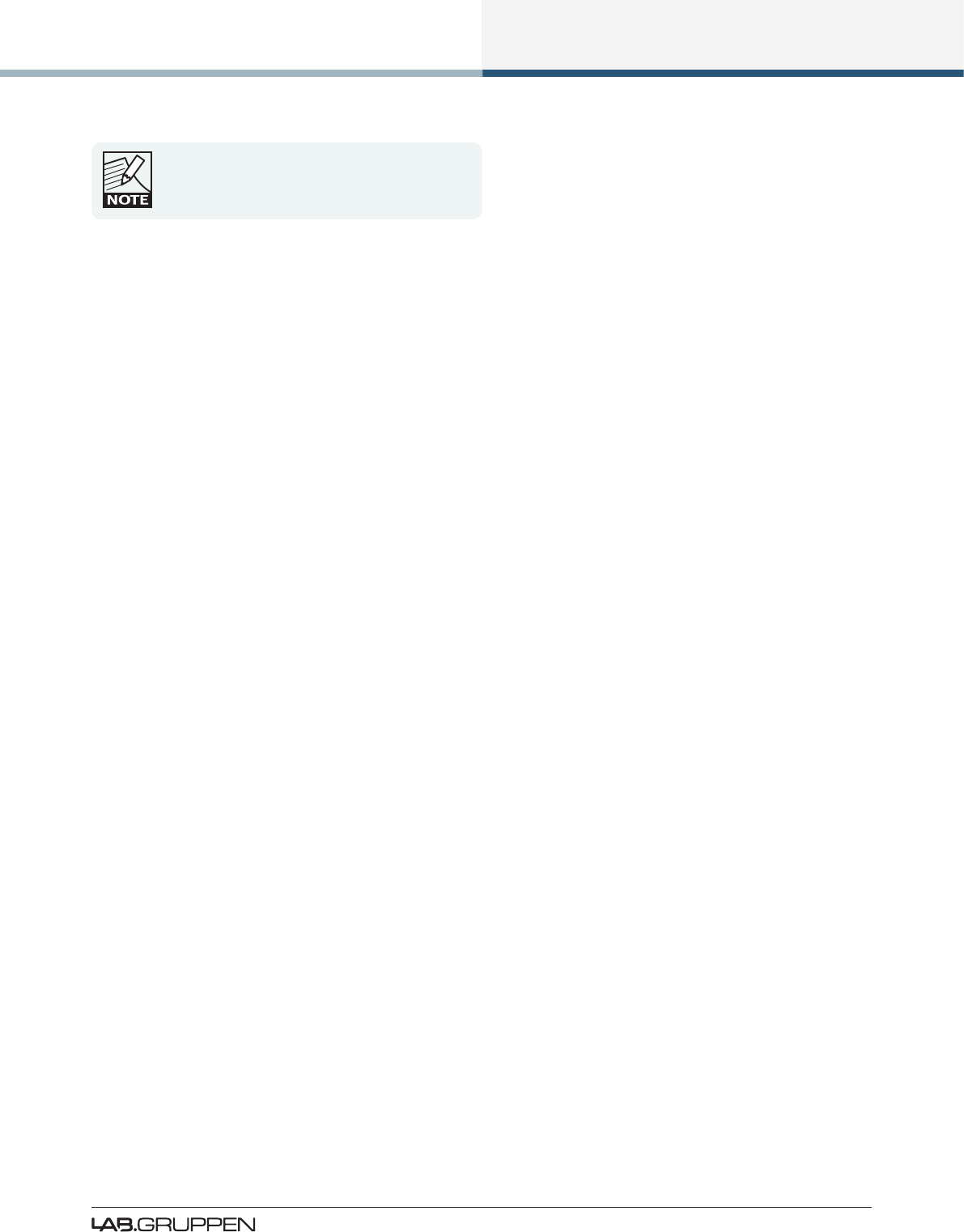
Front Panel Interface
47
PLM Series Operation Manual Rev 1.3.0
All parameters are also editable via the Lake
Controller unless specied otherwise.
7.11.1.1 Parameters with Individual Values and Group Totals
The following parameters display two values:
▸MODULE > GAIN
▸MODULE > DELAY
▸MODULE > LIMITERS > MAXRMS LEVEL
▸MODULE > LIMITERS > MAXPEAK LEVEL
The Module parameter can be adjusted using the rotary encoder. The Group total (shown in brackets) is only
adjustable using the Groups function in the Lake Controller.
The Group total is the sum of the individual Module value plus any values for this parameter on all Groups to
which the Module is assigned. Please refer to the Lake Controller Operation Manual for further information
on Groups.
7.11.1.2 Menu Structure Overview
From the Main Menu, the following submenus are available, as shown in Figure 7-9 and described in the
following sections.
▸MODULE (See section 7.11.2)
▸Gain
▸Delay
▸Polarity
▸Amp Gain
▸Limiters
▸Mute
▸INPUT CONFIGURATION (See section 7.11.3)
▸Router 1
▸Router 2
▸AES Termination
▸Iso-Float
▸ATTENUATION (See section 7.11.4)
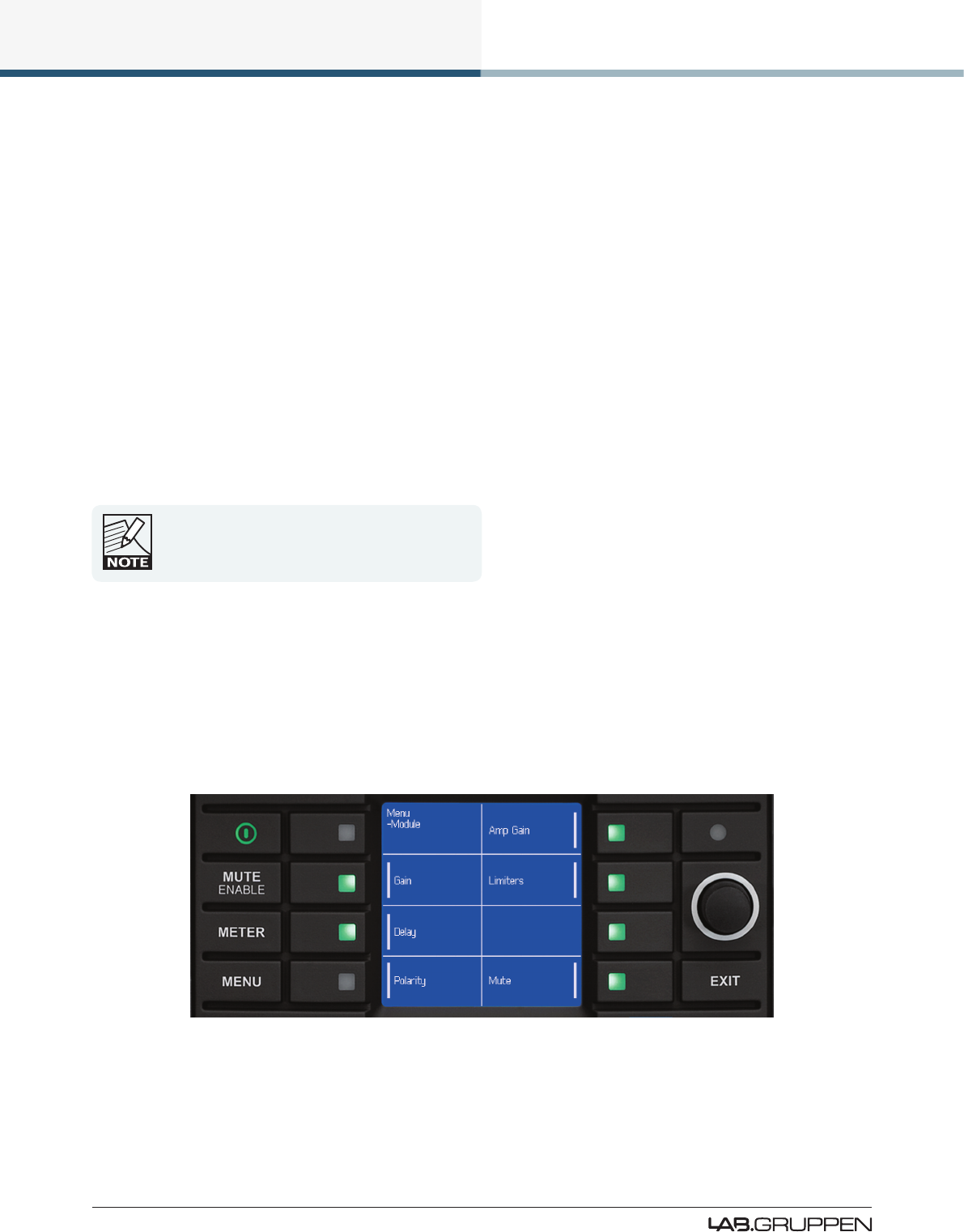
48
Front Panel Interface
PLM Series Operation Manual Rev 1.3.0
▸FRAME (See section 7.11.5)
▸Frame Information
▸Frame Reset
▸Network
▸Latency Match
▸Front Panel
▸FRAME PRESETS (See section 7.11.7)
▸Preset Recall
▸LOAD MONITOR (See section 7.11.8)
▸Congure No. of Cabinets in Parallel
▸LoadSmart Verication
▸Estimated No. of Cabinets
▸DANTE (See section 7.11.9)
For simplicity, the following sections refer to the
buttons by their associated name on the LCD
screen. E.g. ‘Press GAIN’ equates to ‘Press the
button adjacent to the Gain label on the LCD’.
7.11.2 Module Submenu
MENU > MODULE
After selecting the Module Menu, the screen shown in Figure 7-10 is displayed. Press the illuminated button
adjacent to the required option to view or edit the associated parameters.
Figure 7-10: Module Submenu
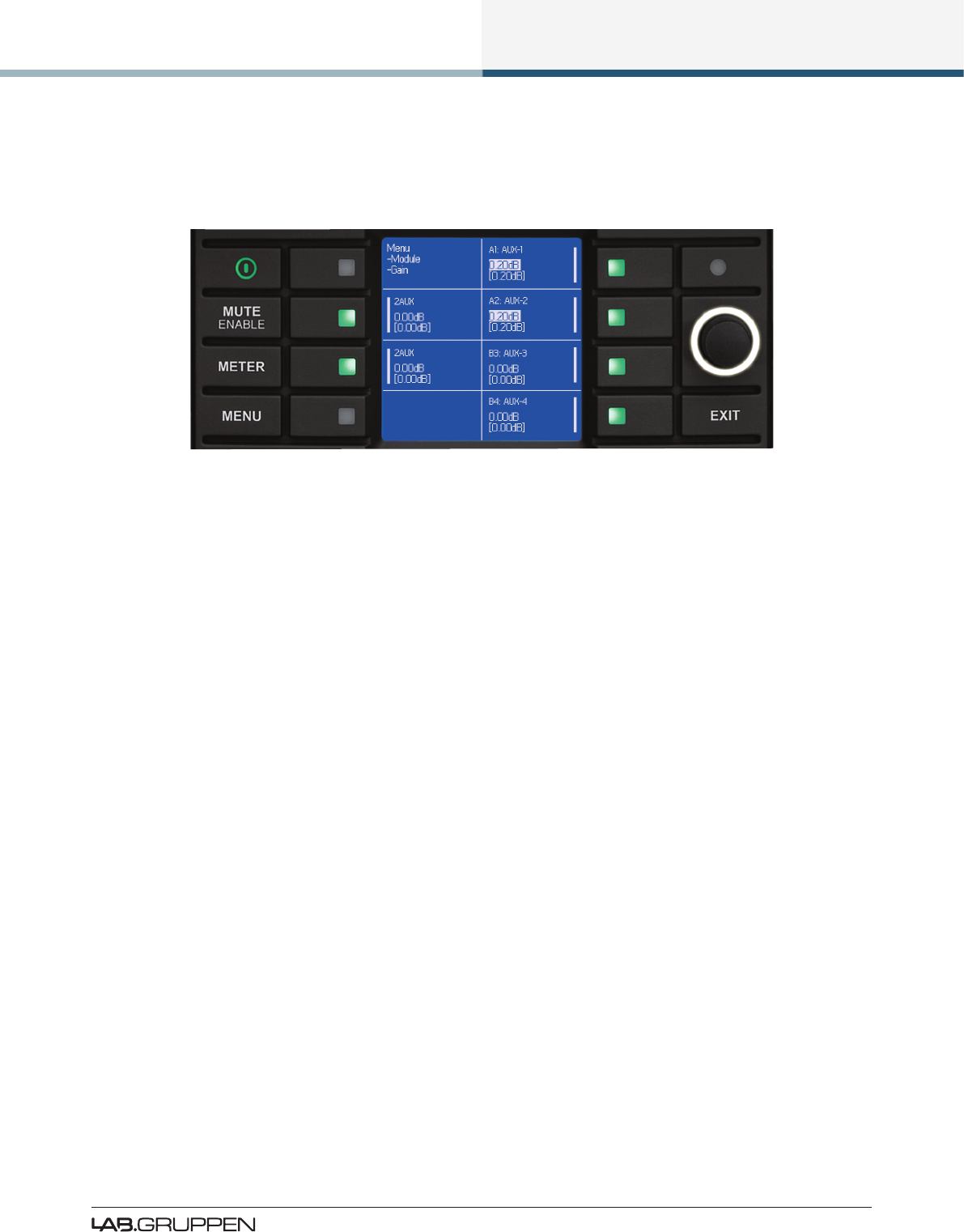
Front Panel Interface
49
PLM Series Operation Manual Rev 1.3.0
7.11.2.1 Gain
MENU > MODULE > GAIN
Figure 7-11: Module Gain Edit Screen
Press the illuminated button next to the input/s and/or output/s for adjustment, and use the rotary encoder
to change the value/s. Multiple gain values may be adjusted simultaneously in 0.1 dB increments, subject to
dened level limits.
7.11.2.2 Delay
MENU > MODULE > DELAY
Press the illuminated button next to the input/s and/or output/s for adjustment, and use the rotary encoder
to change the value/s. Multiple delay values may be adjusted simultaneously in 0.1 ms increments, subject
to dened level limits.
The audio signal may be delayed (typically for reasons of driver or delay subsystem alignment) at either
the Module inputs or on individual outputs. Delay added at the inputs affects all outputs equally, and will
be generally be introduced to time-align arrays of loudspeakers at different locations. Delaying individual
outputs may be desirable to time-align drivers in the same cabinet or array.
7.11.2.3 Phase (Polarity)
MENU > MODULE > PHASE
Press the illuminated button next to the input/s and/or output/s to be adjusted, and use the rotary encoder
to change the value/s. Phase may be changed on one input or output at a time.
Audio phase reversal is available at the inputs to Module A and Module B, and also individually on the
six output channels. The LCD displays ‘Positive’ for normal operation, and ‘Negative’ when the phase is
inverted.

50
Front Panel Interface
PLM Series Operation Manual Rev 1.3.0
7.11.2.4 Amp Gain
MENU > MODULE > AMP GAIN
By default, all outputs are selected; use the rotary encoder to change the gain of all power outputs or press
the associated output button to deselect one or more outputs.
Amp Gain adjusts the gain of the PLM’s power output stage for each output channel. The default setting is
35 dB, variable in 0.1 dB increments from 22 dB to 44 dB. Care should be taken in altering Amp Gain, which
should be adjusted in conjunction with the Gain controls and limiter thresholds.
7.11.2.5 Limiters
MENU > MODULE > LIMITERS
Various parameters of the PLM’s Inter-Sample Voltage Peak Limiter (ISVPL) and the Lake LimiterMax pa-
rameters can be adjusted via this submenu. By default, simultaneous adjustment of most limiter parameters
across all output channels is selected, although channels may be adjusted individually if required. Attack and
Release times must be adjusted individually per channel.
Inter-Sample Voltage Peak Limiter Threshold (ISVPL Threshold)
The ISVPL prevents the voltage of the PLM outputs from exceeding a pre-determined value. The ISVPL
Threshold can be adjusted between 17.8 V to 600 V, which represents the instantaneous peak voltage,
not the RMS value of the output signal. The actual value is displayed in brackets and can be limited by the
maximum voltage a particular PLM Series model can produce.
Inter-Sample Voltage Peak Limiter Prole (ISVPL Prole)
Selecting the ISVPL Prole will optimize the ISVPL limiting for the specic frequency band. ISVPL Prole
permits individual adjustments per channel between six proles, providing appropriate attack and release
times for the ISVPL Limiter and Voltage Clip feedback to either minimize distortion or maximize SPL as
described below.
1. Universal – Optimized for low distortion, usable for all frequencies
2. Sub/LF – Optimized for higher SPL below 600 Hz, usable for all frequencies
3. Sub – Optimized for high SPL, 20-200 Hz
4. LF – Optimized for high SPL, 20-1200 Hz
5. MF – Optimized for high SPL, 300-6000 Hz
6. HF – Optimized for high SPL, > 1 kHz
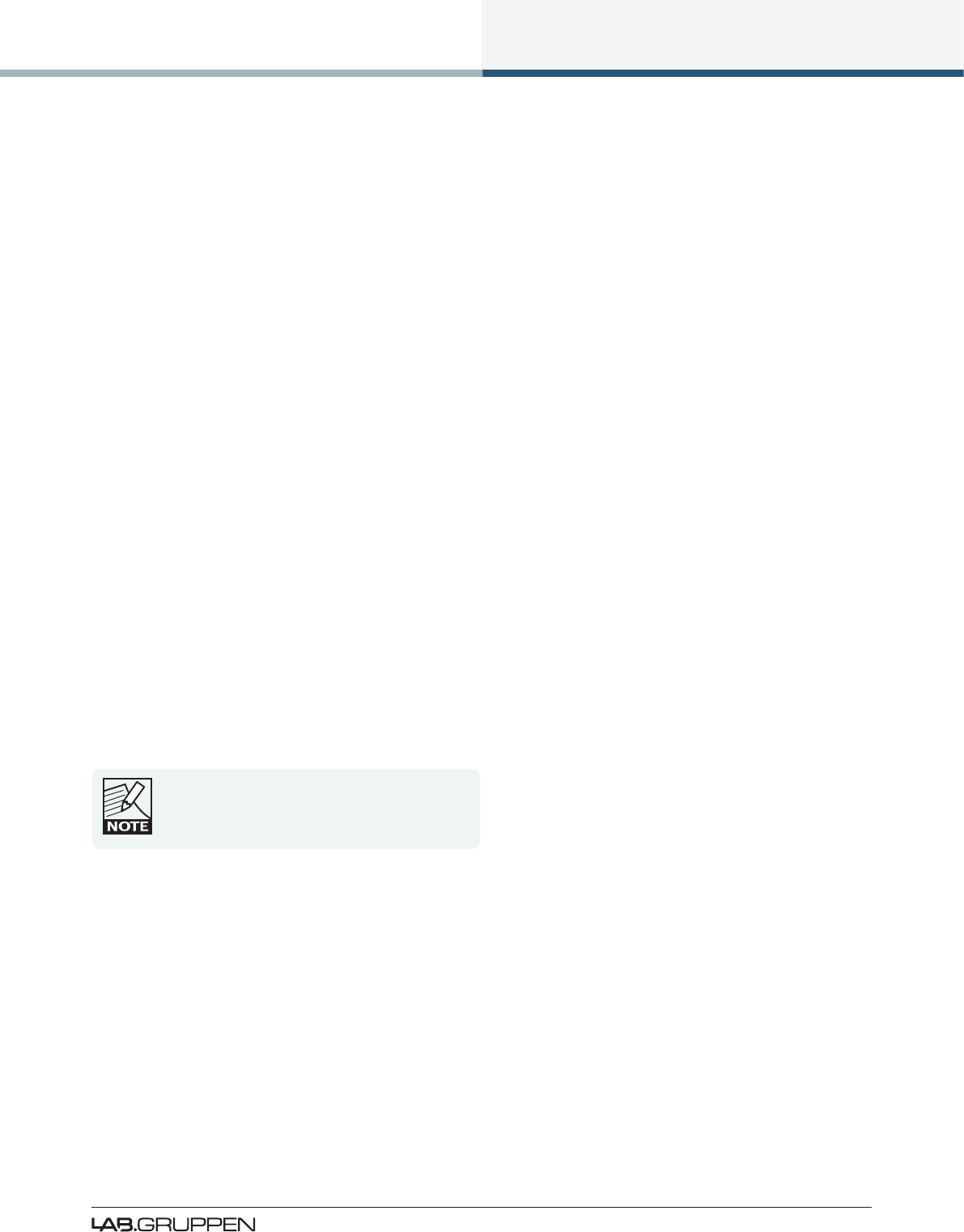
Front Panel Interface
51
PLM Series Operation Manual Rev 1.3.0
The default ISVPL Proles differ depending on the PLM Series model:
▸PLM 10000Q / 20000Q: UNIVERSAL
▸PLM 14000: SUB/LF
MaxPeak Level (MaxPeakLvl)
This sets the maximum peak signal level at the Module outputs. It is adjustable from -30 dBu to +30 dBu
in 0.1 dB increments, subject to user-dened level limits. The Group total is displayed (in brackets) for each
channel.
MaxRMS Level (MaxRMSLvl)
This sets the maximum RMS signal level at the Module outputs. It is adjustable from -30 dBu to +30 dBu
in 0.1 dB increments, subject to user-dened level limits. The Group total is displayed (in brackets) for each
channel.
MaxRMS Corner (MaxRMSCor)
A soft-knee or hard-knee corner may be applied to the RMS Limiter. A soft-knee corner gently increases
limiting as the signal approaches the threshold; a hard-knee corner applies full limiting to any signal exceed-
ing the threshold by any amount, but none to signals below the threshold.
The Corner parameter is adjustable in 0.1 dB increments, subject to dened level limits. This gure repre-
sents the level below the limiter threshold at which compression commences; the larger this negative value,
the softer the knee. A setting of 0 dB implies a hard-knee characteristic.
LimiterMax provides peak and RMS limiting
features, referred to as MaxPeak and MaxRMS
respectively. Full details regarding LimiterMax can
be found in the Lake Controller Operation Manual.
7.11.2.6 Mutes
MENU > MODULE > MUTES
In Meter Mode, Module inputs and PLM power output channels can be muted using the MUTE ENABLE
function. The MUTE menu also provides mute status and control of the Module input mutes, but instead of
the PLM power output channel mutes, it provides the ability to mute the Lake Module outputs.
Press the associated dynamic function button/s to select the Module input/s and/or Module output/s to be
adjusted. Use the rotary encoder to toggle between the MUTED and UNMUTED states.
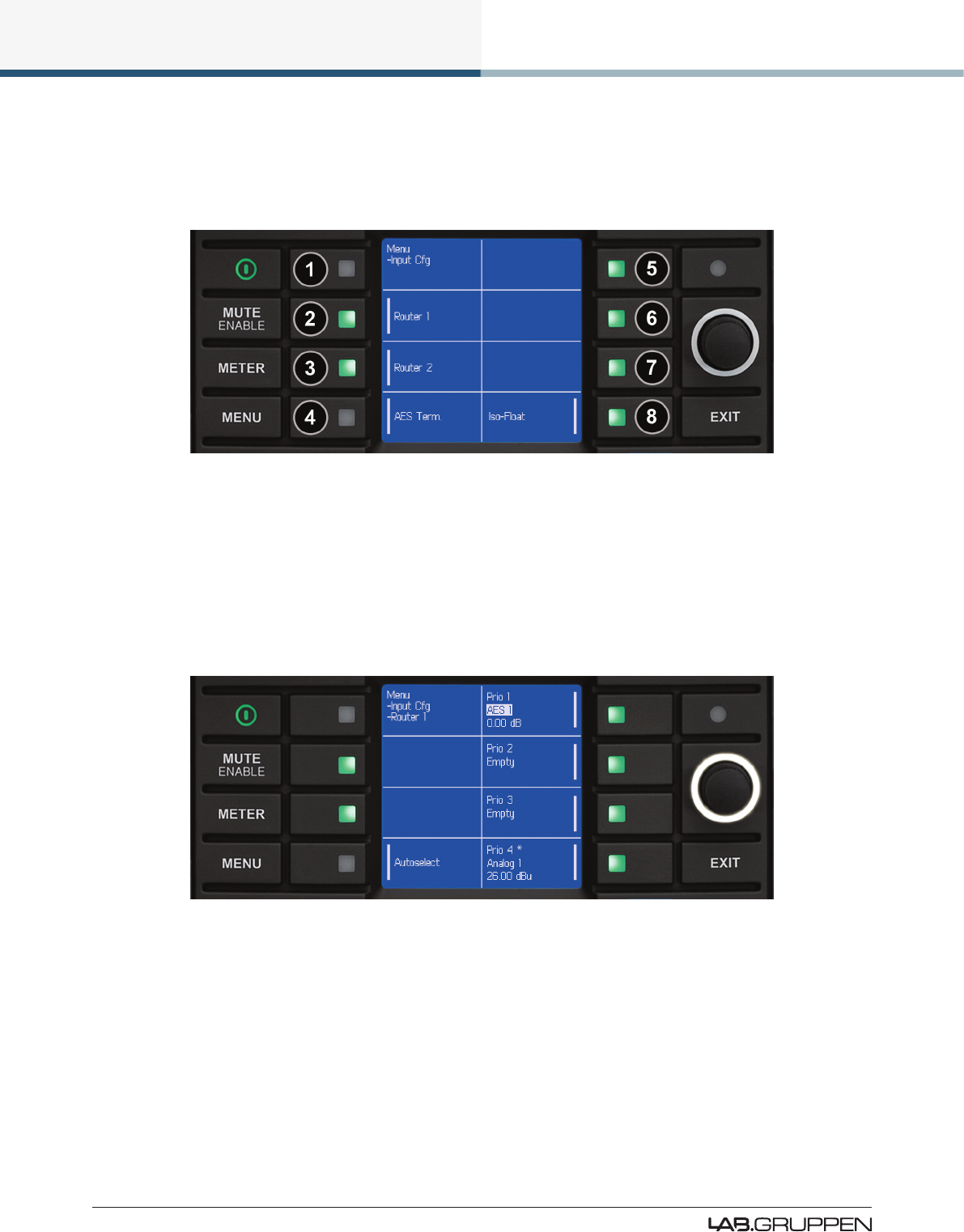
52
Front Panel Interface
PLM Series Operation Manual Rev 1.3.0
7.11.3 Input Cong Submenu
MENU > INPUT CONFIG
Figure 7-12: Input Cong Submenu
This menu provides conguration options for input routing, along with settings for AES Termination and
Iso-Float as described in the following sections.
7.11.3.1 Router 1 / 2
MENU > I/O CONFIG > ROUTER 1 / 2
Figure 7-13: Input Router 1
The signal ow diagrams in chapter 6 highlight that there are two Input Routers available on PLM Series
devices. The input that is selected within the router can be used by the Input Mixer for either Module A or
Module B.
Each router has four priority levels allowing any input to be placed in a sequence providing automatic input
signal fail over. AES3 and Dante inputs have priority over analog inputs.
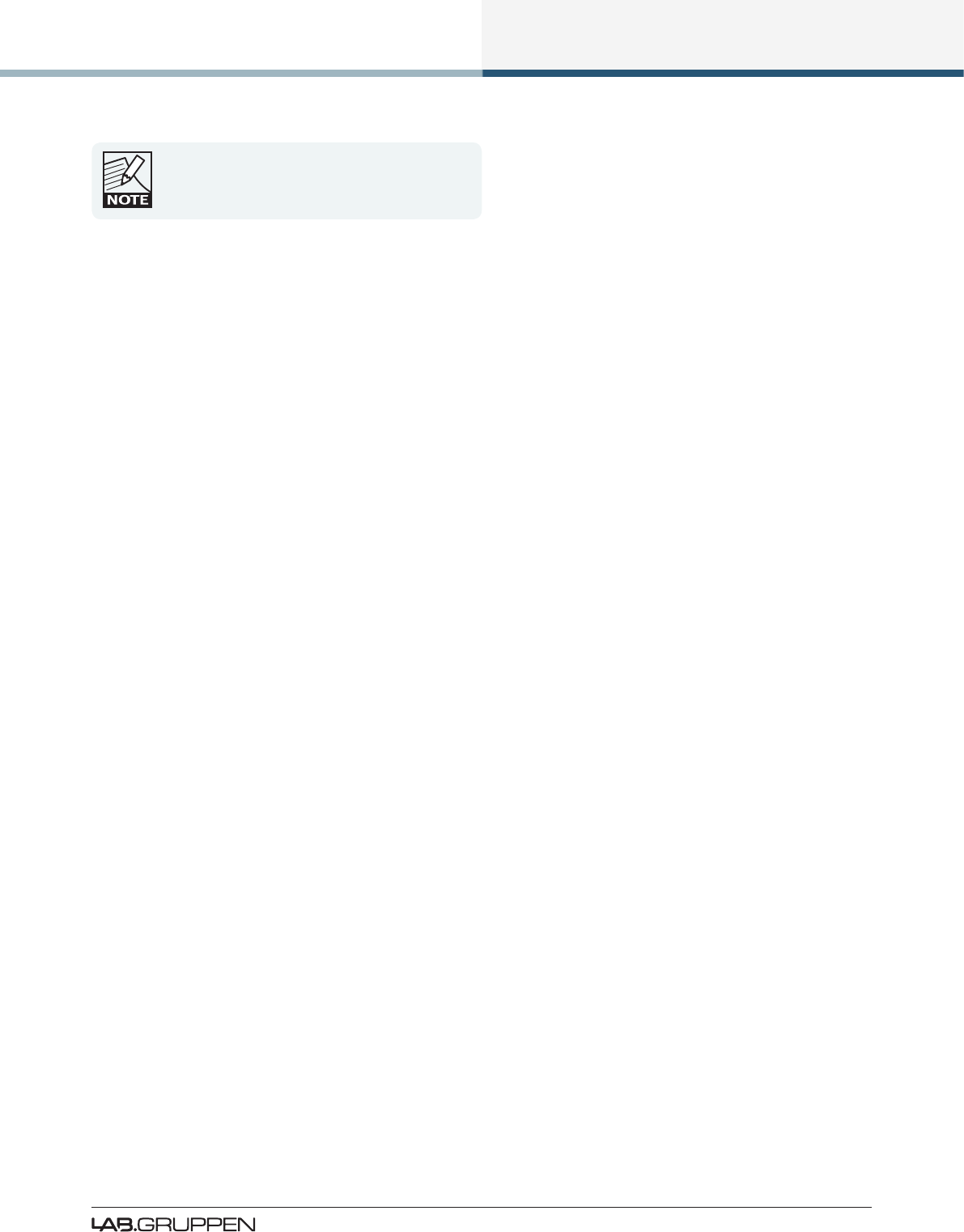
Front Panel Interface
53
PLM Series Operation Manual Rev 1.3.0
Only one analog input is allowed in each router, and
the analog input must be at the lowest priority level
in relation to any other inputs.
Two modes of input selection are available, Auto Select and Forced Selection. The selected setting is also
visible from the I/O STATUS screen on the front panel, and via the Lake Controller.
In Auto Select mode, Priority 1 is checked for a valid input signal; if no signal is found, Priority 2 is checked,
and so on until a valid signal is located; this process occurs if the currently selected input fails. In Forced
Selection mode, one of the four priorities is xed regardless of whether a valid signal is present.
With a router selected on the front panel, press the middle button on the left of the LCD to activate this
parameter for editing; the text will be highlighted as shown in Figure 7-13. Use the illuminated rotary
encoder to scroll through the following options:
▸Auto Select (default)
▸Force Priority 1
▸Force Priority 2
▸Force Priority 3
▸Force Priority 4
Assignment of Input Priority
Factory default settings assign AES3 to Priority 1 and Analog to Priority 4, with Priority 2 and 3 empty.
To change these settings via the front panel, select Priority slot number to be changed and use the rotary
encoder to scroll through the available options. Due to the signal hierarchy it is not possible to assign an
analog source to a higher priority than a digital source.
Analog Input Sensitivity and Digital Gain Offset
Press a dynamic function to the right of the LCD to toggle the selection of input source and input sensitivity/
digital gain offset then use the rotary encoder to change the parameter.
The maximum input level accepted by the analog input pre-ampliers without clipping may be set to 12 dBu
or 26 dBu. Digital gain offset may be applied to AES3 digital input signals in 0.1 dB increments from -100 dB
to +15 dB.
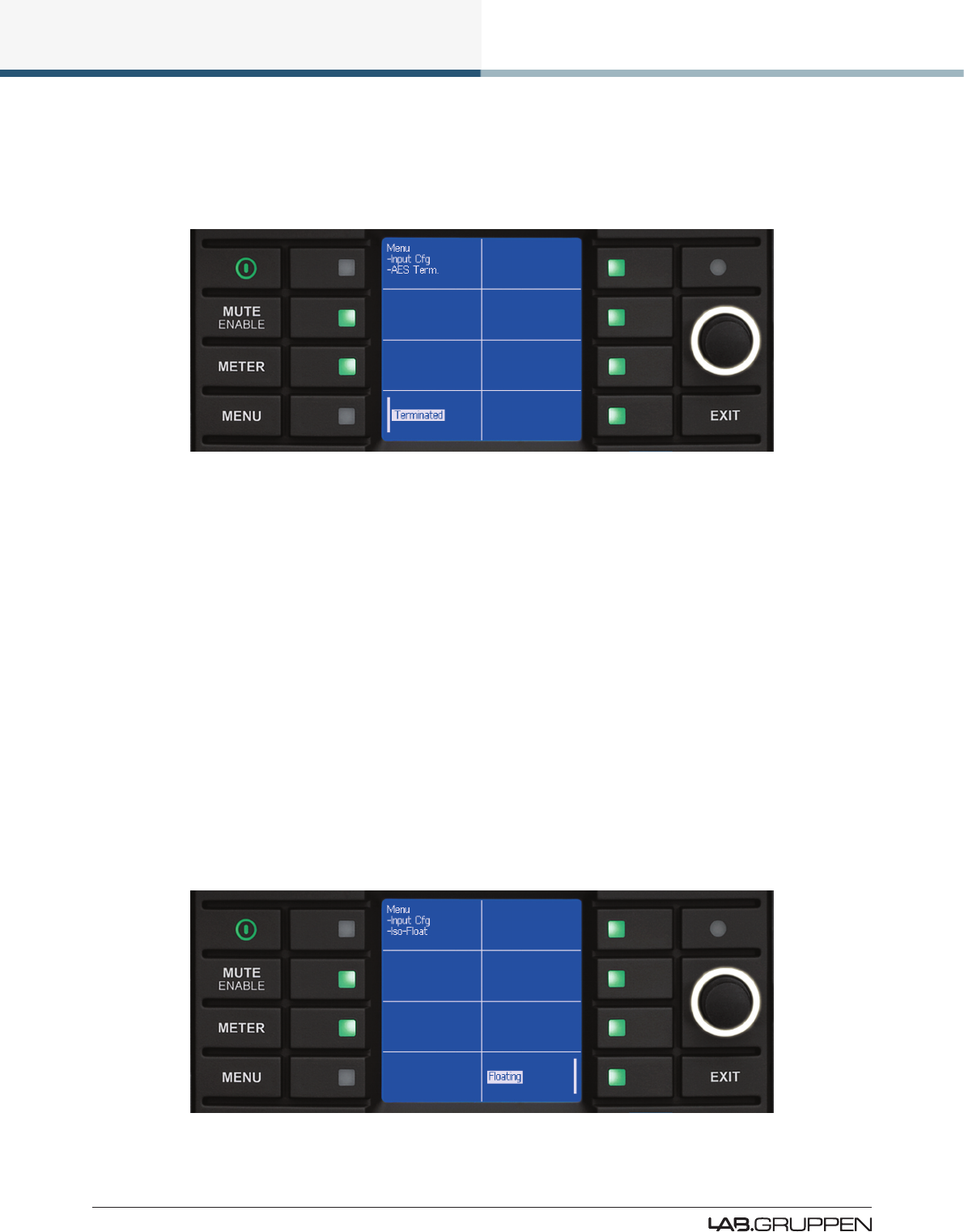
54
Front Panel Interface
PLM Series Operation Manual Rev 1.3.0
7.11.3.2 AES3 Input Termination
MENU > I/O CONFIG > AES TERM
Figure 7-14: AES Termination Edit Screen
To adjust the AES3 Input Termination, select AES TERM from the Input Cong menu then use the rotary
encoder to toggle the value. An icon is displayed in the bottom left of the display in Meter Mode when AES
is set to ‘Terminated’.
For fault-free operation when using AES3 digital audio as an input source, inputs must be correctly termi-
nated with the characteristic impedance of 110 ohm. The Input Termination setting is determined by the
method used to distribute the AES3 signals.
The processor at the end of a distribution line should be set to TERMINATED; all other processors should
be set to UNTERMINATED. If an AES3 distribution amplier (DA) is being used to distribute the digital audio
signals, with one DA output per processor, then all terminations should be on. However, if the AES3 is
daisy-chained, only terminate the last processor in the chain.
7.11.3.3 Iso-Float
MENU > I/O CONFIG > ISO-FLOAT
Figure 7-15: Iso-Float Menu
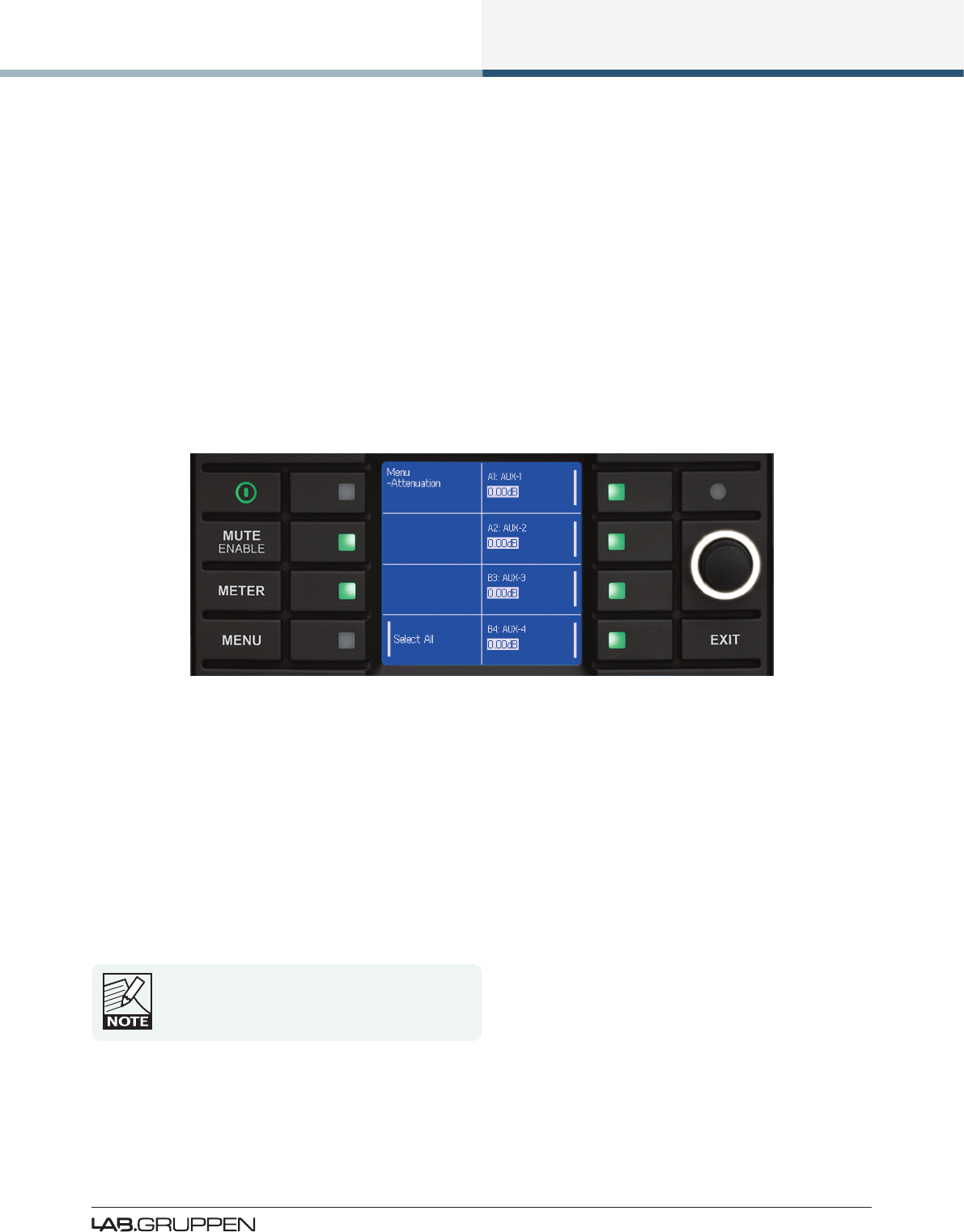
Front Panel Interface
55
PLM Series Operation Manual Rev 1.3.0
To change the Iso-Float setting, adjust the value using the rotary encoder. The current settings are also
displayed on the front panel I/O STATUS screen.
The analog inputs utilize Iso-Float transformerless electronic balancing circuitry. This provides electrical isola-
tion from an analog source comparable to that achieved with transformer-based designs. However, pin 1 of
the XLR input connector may be connected to ground within the device if desired. This option is selected by
using the rotary encoder to toggle between FLOATING and GROUNDED.
It may be necessary to change this setting to resolve ground loop problems when using analog inputs.
7.11.4 Attenuation Submenu
MENU > ATTENUATION
Figure 7-16: Attenuation Menu
The default setting of 0.00 dB (i.e. no attenuation) is adjustable in 0.25 dB increments down to -100 dB.
Adjustment of attenuation at the input to the PLM power stage is available on a per-channel basis. This
adjustment is the PLM equivalent of a conventional amplier level control. The power output channels may
be turned down using these parameters before powering on or off. Please refer to the signal ow diagram
in on page 26.
By default, all channels are deselected. Press the SEL ALL button to select/deselect all channels (as shown
in Figure 7-16) or, press a single button on the right to adjust a channel individually.
For 4-channel PLMs, only ONE channel or ALL
channels may be adjusted. It is not possible to
adjust only two or three channels.
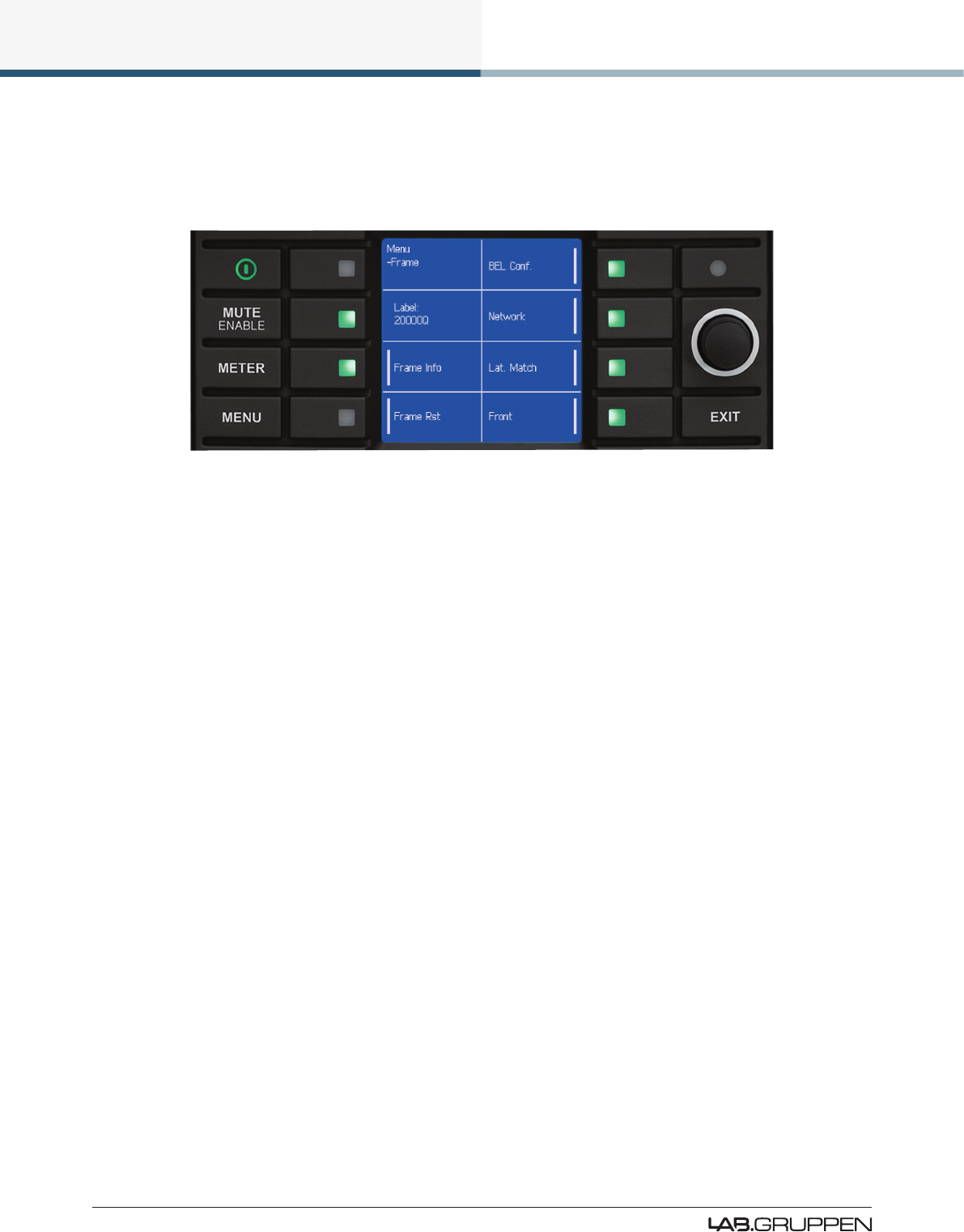
56
Front Panel Interface
PLM Series Operation Manual Rev 1.3.0
7.11.5 Frame Submenu
MENU > FRAME
Figure 7-17: Frame Menu
The Frame Menu provides information and options relating to the device PLM as a physical unit. It is
referred to as a Frame for consistency with Lake Controller terminology.
The Frame Label as dened in the Lake Controller is displayed in this menu. It is also displayed at the
top-left of the screen in Meter Mode, Home View.
7.11.5.1 Frame Info
MENU > FRAME > FRAME INFO
Frame Info provides information about the device settings and conguration. All data in this front panel
menu is read-only; some parameters are xed, some can be changed only via the Lake Controller software.
Firmware Version (FW Version)
This option displays the version numbers for various rmware elements. This information can be used to
verify that the latest rmware is installed and is useful if a technical issue arises.
Inherent Latency (Inh. Latency)
This option displays a screen showing latency currently incurred through the PLM, measured from input to
output.
Processing of digital audio necessitates a small but nite processing delay referred to as system latency. It
may be desirable to know the latency, so the value can be subtracted from any deliberate delay introduced
for loudspeaker time-alignment. In many cases, the system latency is so small compared to time-alignment
delay that it can be ignored.
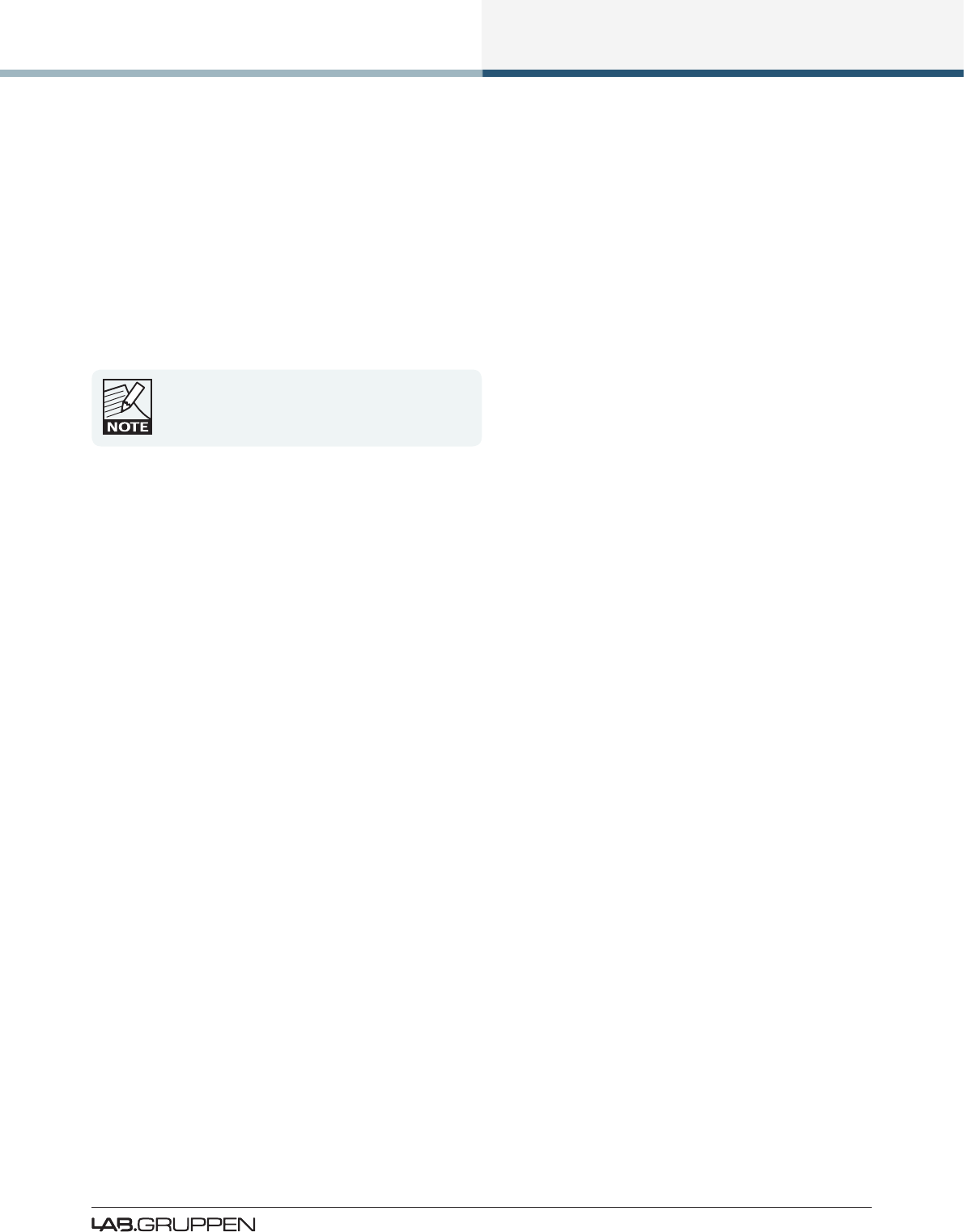
Front Panel Interface
57
PLM Series Operation Manual Rev 1.3.0
Serial Number (Serial No.)
The printed serial number on the back panel of the PLM is also electronically embedded in the hardware,
and therefore cannot be removed or altered if stolen.
Max Output Voltage (MaxOutVolt)
Displays the maximum output voltage per channel that can exist across the PLM’s output terminals. This is
the absolute maximum, not the voltage dened by the ISVPL setting.
When Bridge Mode is activated, double the channel
output voltage is available.
Max Output Current (MaxOutCurr)
Displays the maximum output current that can be delivered by the PLM, summed across all output chan-
nels.
7.11.5.2 Frame Reset and Conguration
MENU > FRAME > RESET
Use this option to display a further menu with options to reset all parameters back to their original factory
default values. See section 9.3 for a full list of the default factory reset parameter values.
Two types of reset are provided: Factory Reset Soft Reset.
Factory Reset
A Factory Reset will reset all settings and parameters to the original factory-dened default values. This
includes the deletion of any Frame Presets stored within the device. It also resets the IP Address and all
network related settings; a hard power cycle is required to complete this reset.
Soft Reset
A Soft Reset will reset all settings and parameters to the original factory-dened default values, but retains
Frame Preset information and IP / Network conguration. A power cycle is not required to complete this
type of reset.

58
Front Panel Interface
PLM Series Operation Manual Rev 1.3.0
7.11.5.3 Breaker Emulation Limiter (PLM 20000Q ONLY)
MENU > FRAME > BEL CONF
The Breaker Emulation Limiter (BEL) provides Ampere selection (5-32 A) and breaker type selection (CON-
SERVATIVE, FAST and UNIVERSAL). Select by pressing the adjacent button then use the rotary encoder to
change the parameter.
This option is only available on the PLM 20000Q.
7.11.5.4 Network
MENU > FRAME > NETWORK
Pressing the NETWORK button displays a further screen containing network conguration information.
All parameters are view-only on the front panel and are either not editable, or can only be adjusted via the
Lake Controller.
A summary at the top right of the screen conrms whether a valid connection is present for both Ethernet
ports, and whether the Lake Controller is online.
▸IP Addr: Displays the Internet Protocol address for the selected unit and can only be changed via the
Lake Controller software. Please refer to the Lake Controller Operation Manual for further details.
▸IP Mask: Displays the IP address subnet mask for the selected unit and can only be changed via the
Lake Controller software. Please refer to the Lake Controller Operation Manual for further details.
▸MAC: Displays the unique Media Access Control Ethernet address for the processor. This value cannot
be changed.
▸F.ID: Displays the Frame ID, a unique Lake product identier that cannot be changed.
7.11.5.5 Latency Match
To turn Latency Match on or off, select the parameter using the adjacent button then change the status
using the rotary encoder.
When Latency Match is ON the LM Series device adds delay to match the overall processing delay of legacy
Lake Contour Pro 26 and Mesa Quad EQ products. Please refer to the Lake Controller Operation Manual for
further information.
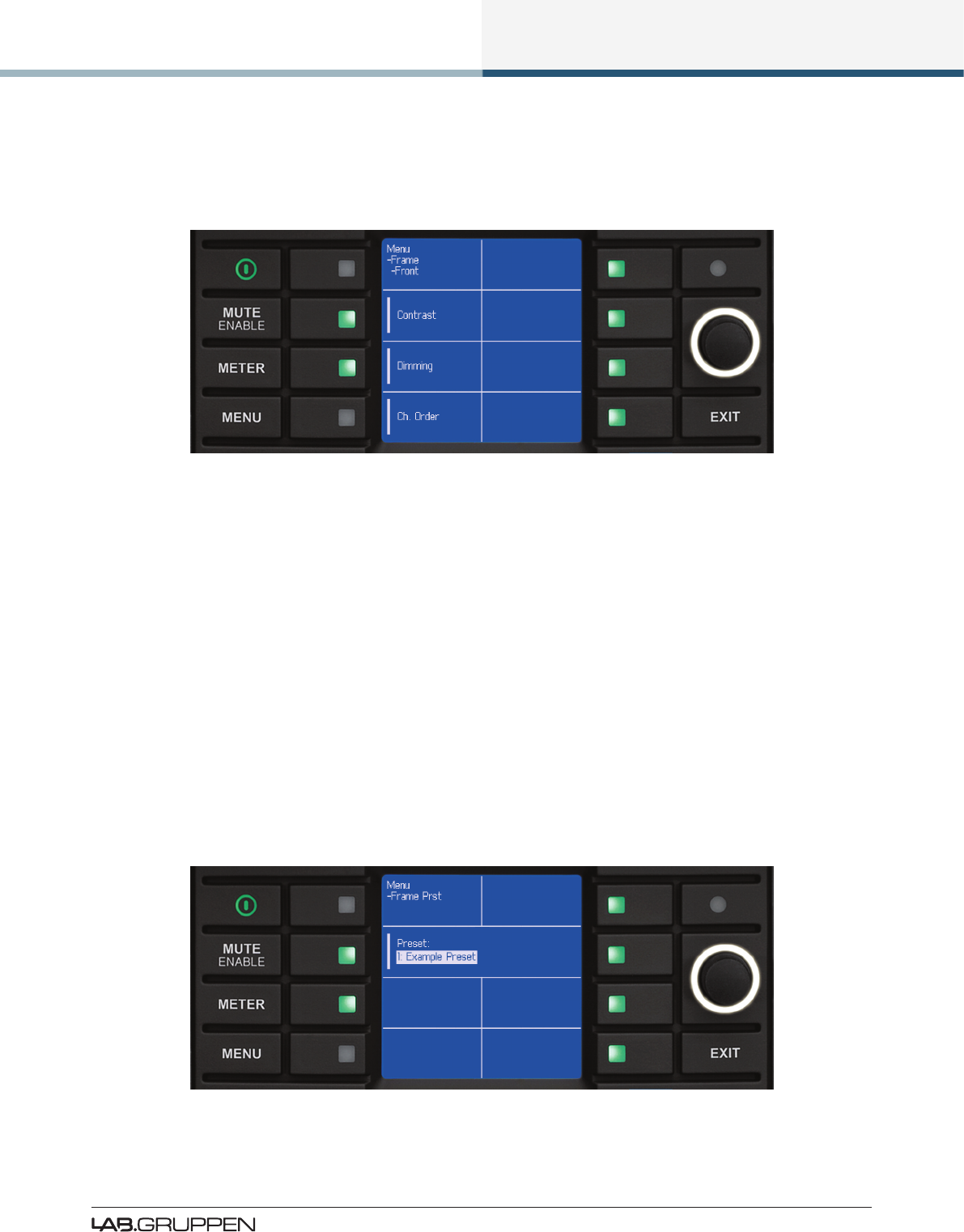
Front Panel Interface
59
PLM Series Operation Manual Rev 1.3.0
7.11.6 Front Panel Display Controls
MENU > FRAME > FRONT
Figure 7-18: Front Panel Display Controls Menu
Contrast
To adjust the front panel LCD contrast, select this option then use the rotary encoder to change the value.
Dimming
To adjust the front panel LCD & LED brightness, select this option then use the rotary encoder to change
the value.
Channel Order
To adjust the order in which both inputs and outputs are displayed on the front panel in all views, select this
option then use the rotary encoder to change the value between TOP-DOWN (default) and BOTTOM-UP.
7.11.7 Frame Preset Menu
MENU > FRAME PRST
Figure 7-19: Frame Preset Menu
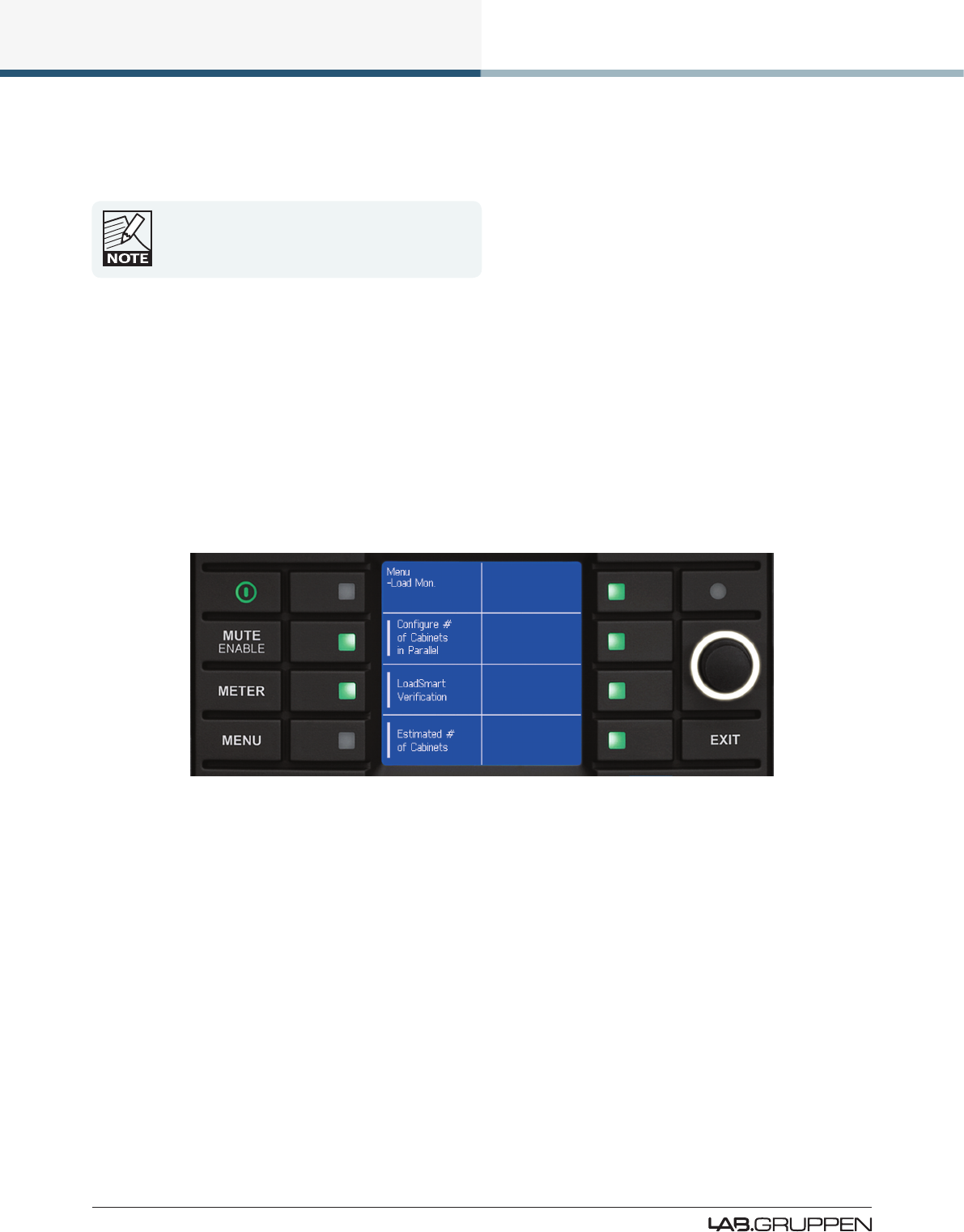
60
Front Panel Interface
PLM Series Operation Manual Rev 1.3.0
To recall an existing Frame Preset, use the rotary encoder to select the required Preset then press the
RECALL button to overwrite the current conguration.
Frame Presets must initially be created in the Lake
Controller, and stored as a Preset using the Lake
Controller or the PLM Series Preset Manager.
Up to 100 Frame Presets can be stored in the device. The data within a Frame Preset includes the congura-
tion of all Modules in the Frame including levels, crossovers, EQ, input mixer, and output routing.
As Frame Presets are stored within the device, complete processor congurations can be recalled without
connecting the device to a PC.
7.11.8 Load Monitor Menu (LoadSmart)
MENU > LOAD MON
Figure 7-20: Load Monitor Menu
7.11.8.1 Congure # of Cabinets in Parallel
This option allows selection of the number of speaker cabinets connected to each PLM output channel.
Select individual or multiple outputs and use the rotary encoder to set the value from 1 to 4. This value is
used by LoadSmart and SpeakerSafe to conrm the correct connection and status of the speakers con-
nected to each PLM channel.
7.11.8.2 LoadSmart Verication
Select this option to initiate LoadSmart verication, then select YES to continue. LoadSmart performs a
rapid test of all output channels, and displays the results on the LCD a few seconds later.
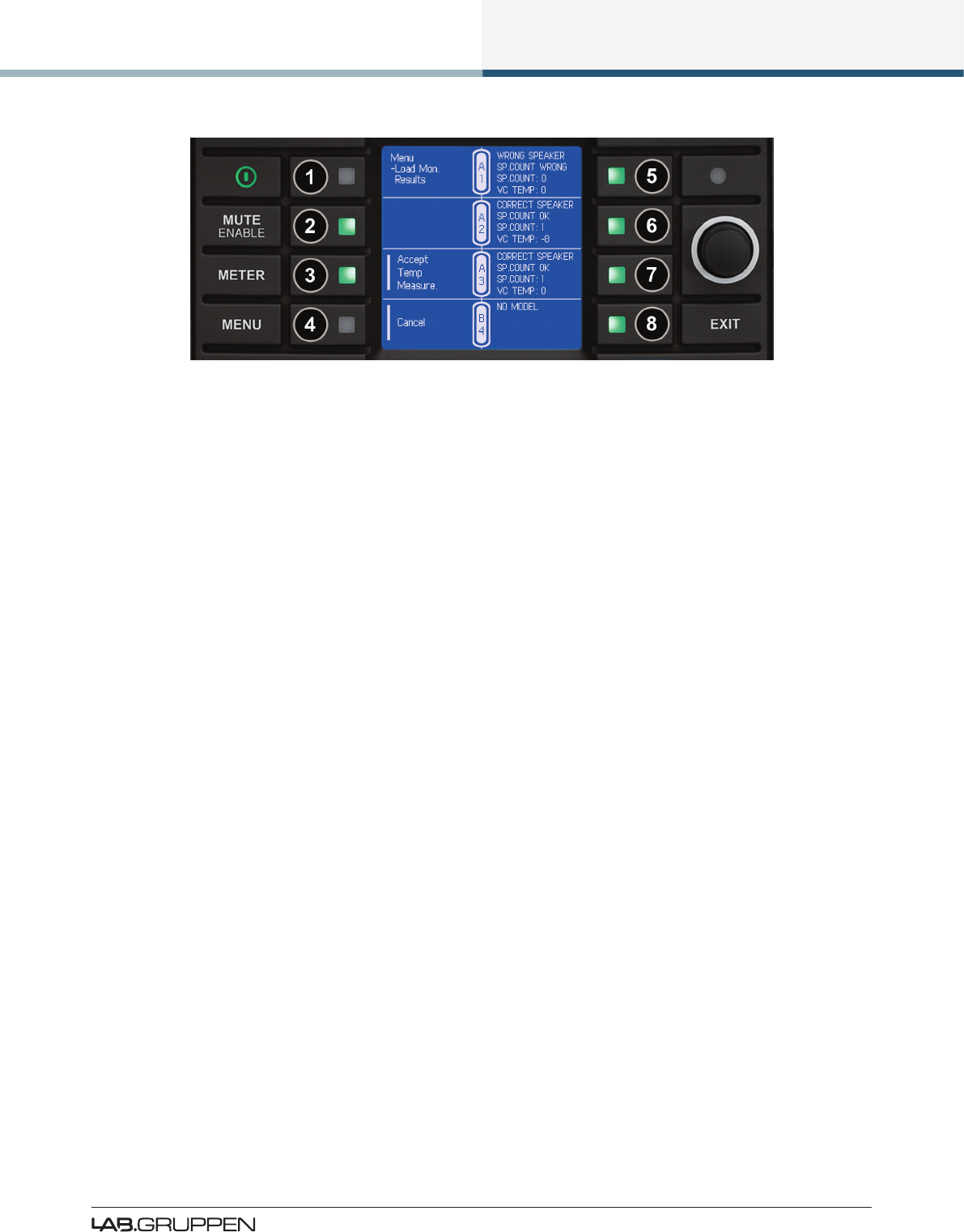
Front Panel Interface
61
PLM Series Operation Manual Rev 1.3.0
Figure 7-21: LoadSmart Verication Results Screen
The Load Results page provides four items of information per output channel:
▸Conrmation of the speaker Fingerprint assigned to the channel.
If no Fingerprint is assigned, NO MODEL will be displayed.
▸Result of speaker cabinet count; this will either be OK or WRONG.
▸Estimated number of speakers connected to the channel.
▸Computed voice coil temperature, calculated from manufacturer’s data contained within the loud-
speaker Fingerprint.
If the displayed range of voice coil temperatures is acceptable, press ACCEPT TEMP MEASURE button to
start SpeakerSafe monitoring using these temperatures as starting values.
If the range of displayed voicecoil temperatures contains one or more anomalous results, the Lake Controller
should be used to manually enter the starting temperature for SpeakerSafe. Please refer to the PLM Series
chapter in the Lake Controller Operation Manual for further information.
Once started, SpeakerSafe monitors the load on each power output channel, and displays associated results
in Meter Mode > Temperature View, and also on the Status and History tabs in the Lake Controller.
7.11.8.3 Estimated # of Cabinets
When SpeakerSafe is active, this submenu displays the estimated number of cabinets from SpeakerSafe’s
continuous load monitoring.
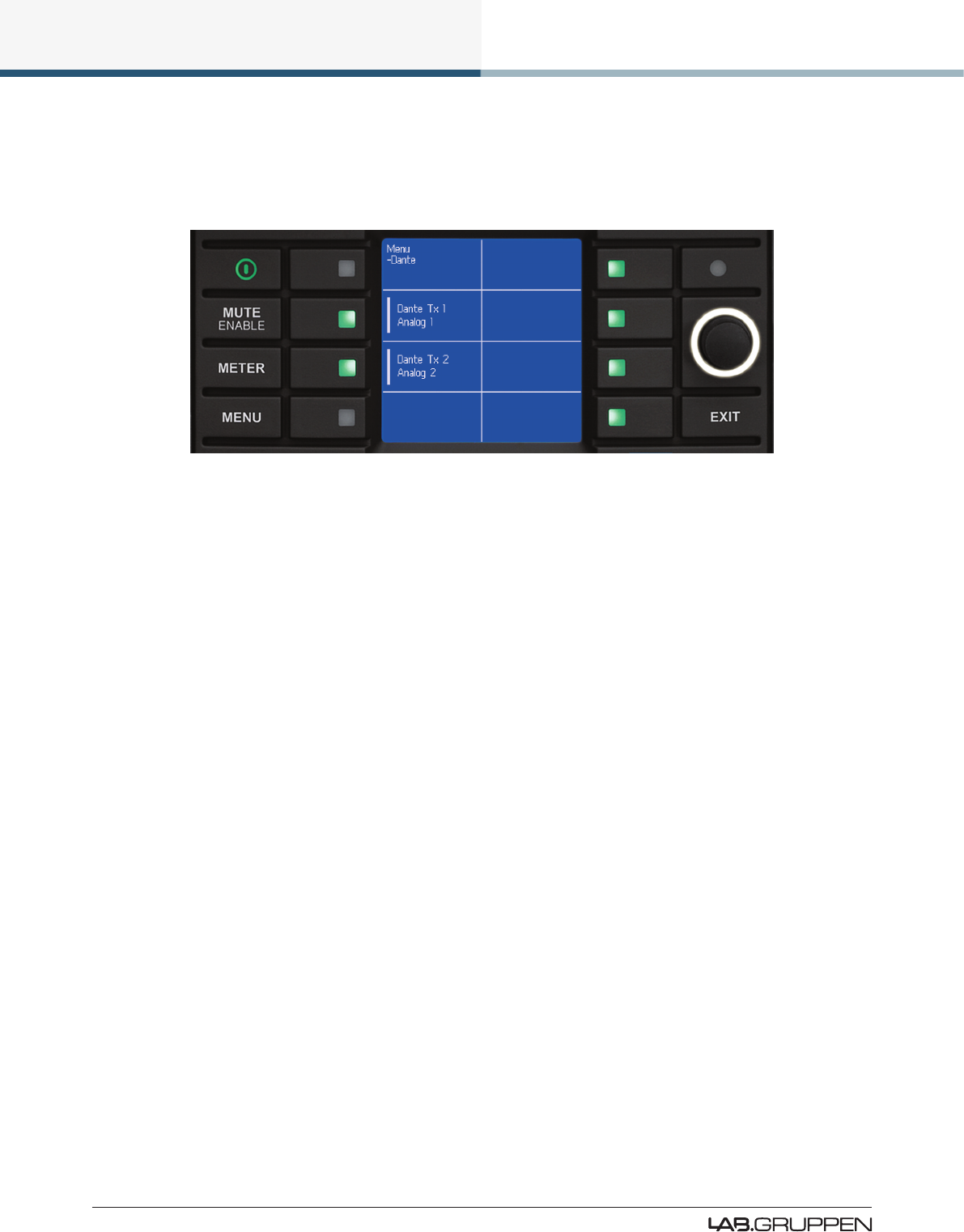
62
Front Panel Interface
PLM Series Operation Manual Rev 1.3.0
7.11.9 Dante
MENU > DANTE
Figure 7-22: Dante Menu
Pressing the DANTE button from the main menu will display this screen only if Dante has previously been
enabled via the Lake Controller software.
Please refer to the Lake Controller Operation Manual for further details regarding Dante implementation.
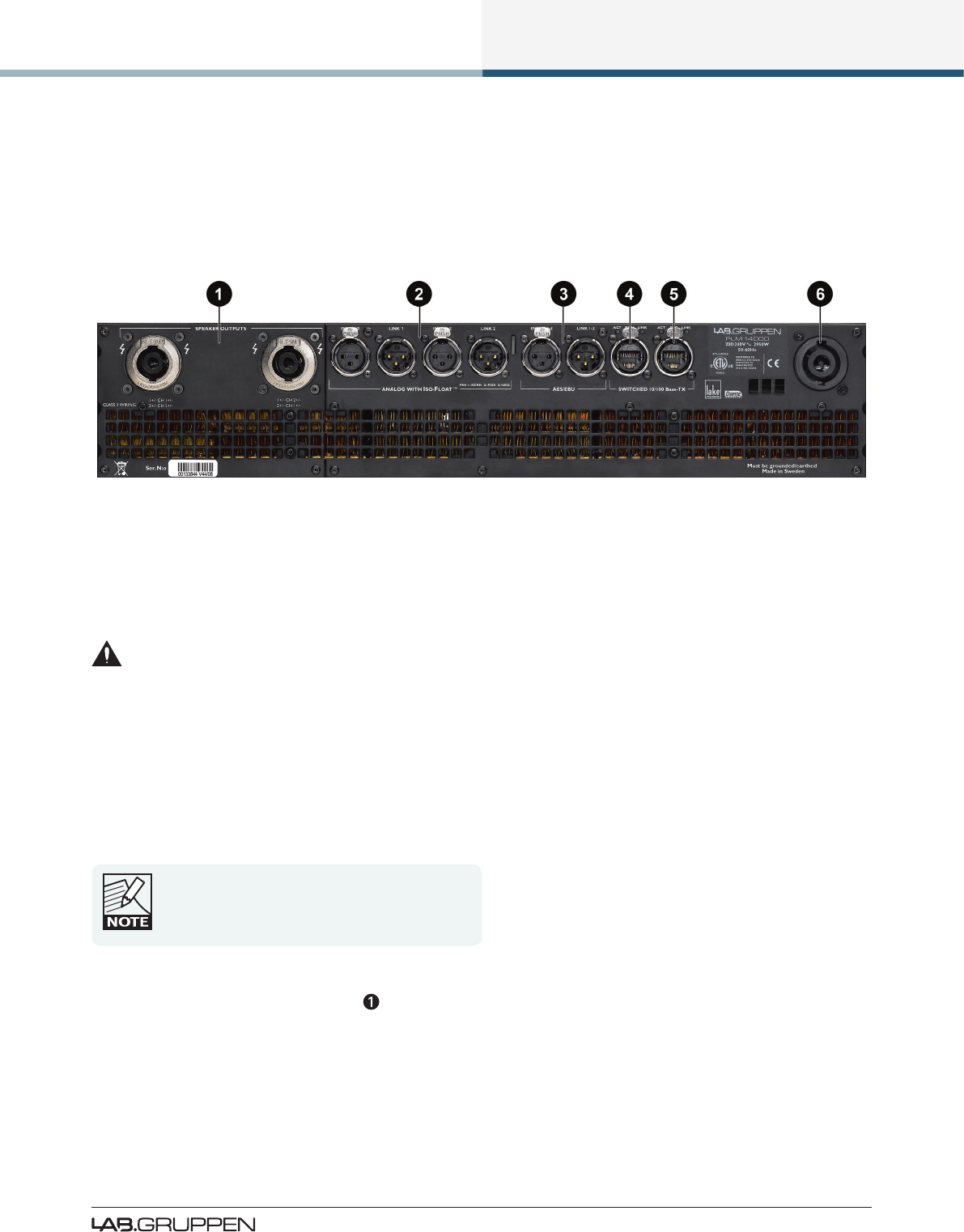
Back Panel Interface
63
PLM Series Operation Manual Rev 1.3.0
8. Back Panel Interface
An overview of the back panel interface is provided in section 4.2. This chapter describes each cluster of
connections as shown in Figure 8-1.
Figure 8-1: Back Panel Interface (2-channel PLM)
8.1 Speaker Outputs
The PLM is available with either 4 mm binding posts or Neutrik speakON connectors for the outputs.
The outputs of the PLM can produce a high voltage. Do not connect or disconnect loudspeaker/s while
the PLM is powered on. Never operate the PLM with any portion of bare loudspeaker wire exposed.
For speakON connector versions, do not use mating plugs without the rear covers in place.
8.1.1 Bridge Mode
Power outputs may be bridged on all PLM models by following the conguration instructions in the
Lake Controller Operation Manual (I/O CONFIG > OUTPUT CONFIGURATION) and the wiring instructions in
this chapter. Bridge Mode can only be activated/deactivated using the Lake Controller software.
When Bridge Mode is activated, CLASS 3 wiring is
required.
8.1.2 speakON Connectors
Figure 8-1 shows a 2-channel PLM 14000 with speakON connections. speakON connections are also
available on the 4-channel PLM 10000Q and PLM 20000Q. Sections 8.1.2.1 and 8.1.2.2 describe the wiring,
pin-out and output conguration for the 2- and 4-channel models respectively.
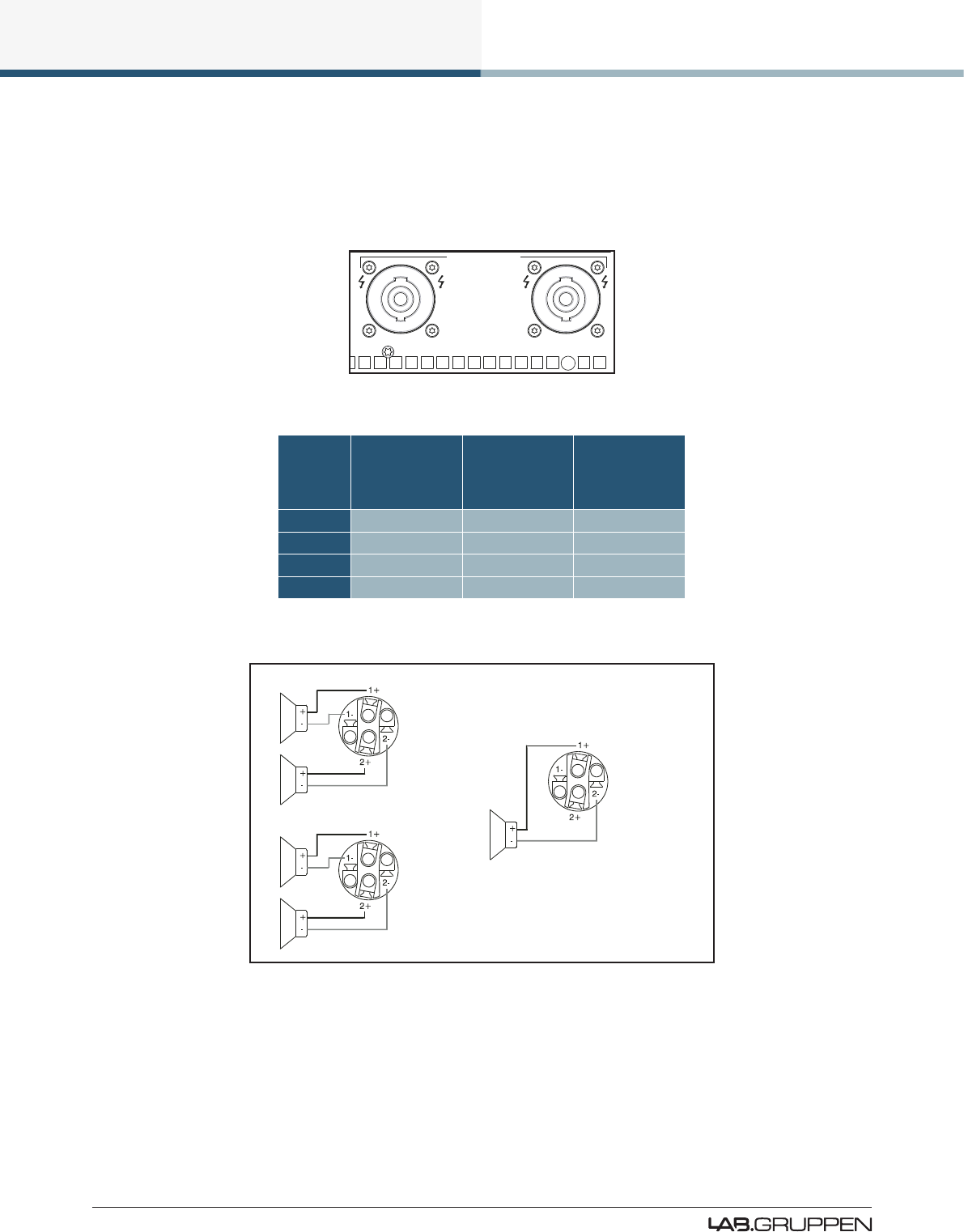
64
Back Panel Interface
PLM Series Operation Manual Rev 1.3.0
8.1.2.1 2-Channel PLM speakON Connections
2-channel models provide both power output channels simultaneously on two 4-pole speakON connectors.
Both connectors carry both channels; the second connector offers the channels in reverse order.
CLASS 3 WIRING
SPEAKER OUTPUTS
1+/- CH 1+/-
2+/- CH 2+/-
1+/- CH 2+/-
2+/- CH 1+/-
Figure 8-2: speakON Connections for 2-channel PLMs
Pin No. NL4 #1 Ch.
1 & 2
NL4 #2 Ch.
2 & 1
NL4 #1 Ch.
1 & 2
(Bridge Mode)
1+ Ch. 1 o/p + Ch. 2 o/p + Ch. 1 o/p +
1- Ch. 1 o/p - Ch. 2 o/p -
2+ Ch. 2 o/p + Ch. 1 o/p +
2- Ch. 2 o/p - Ch. 1 o/p - Ch. 2 o/p -
Table 8-1: speakON Wiring and Pinouts for 2-channel PLMs (incl. Bridge Mode)
NL4
PLM Output
Channels 1 & 2
NL4
PLM Output
Channels 2 & 1
BRIDGE MODE
NL4
PLM Output
Channels 1 & 2
1
1
1
2
2
Figure 8-3: speakON NL4 Congurations for 2-channel PLMs (incl. Bridge Mode)
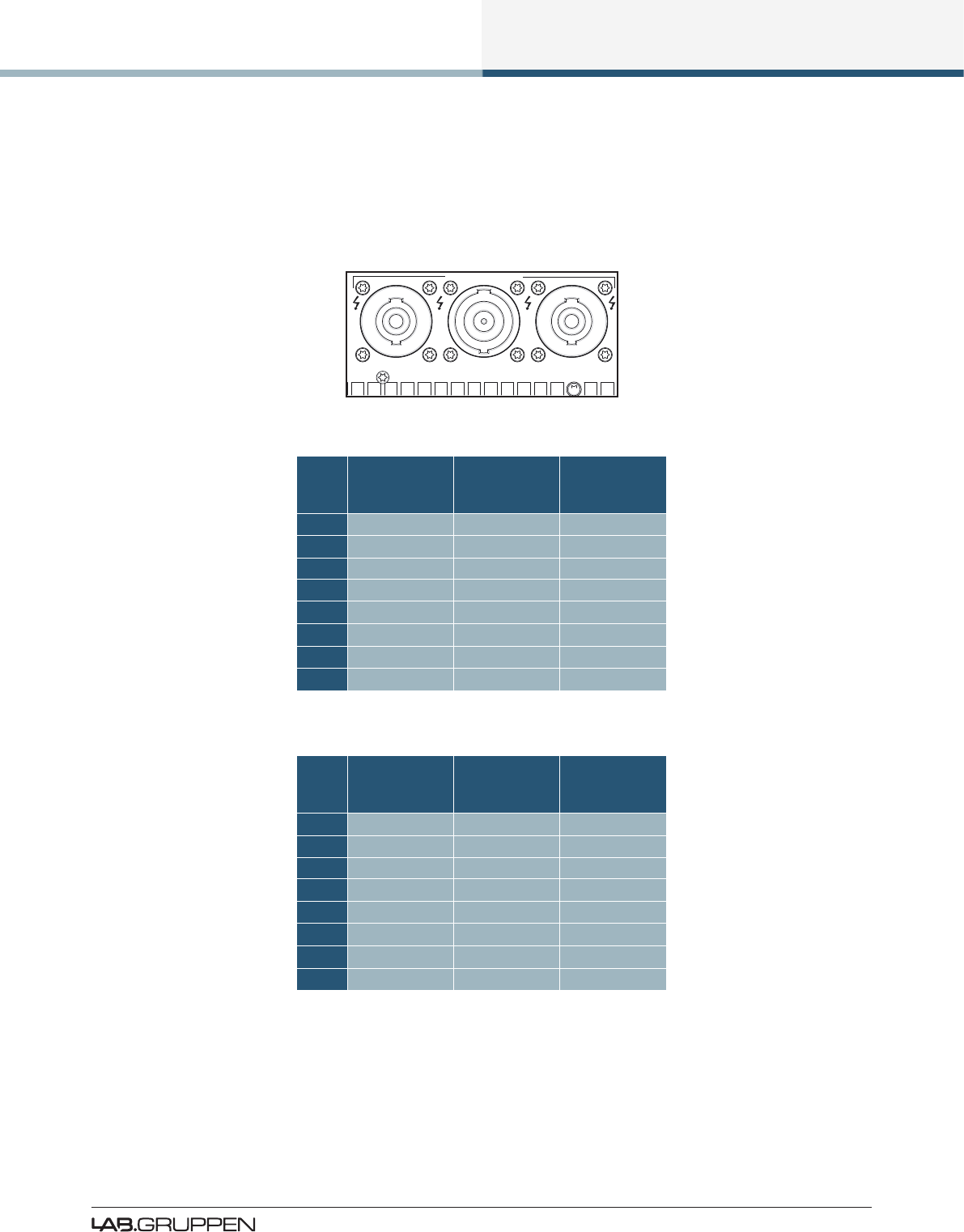
Back Panel Interface
65
PLM Series Operation Manual Rev 1.3.0
8.1.2.2 4-Channel PLM speakON Connections
On 4-channel models, the power outputs are simultaneously available on a single 8-pole speakON connec-
tor, and on two 4-pole speakON connectors. The two 4-pole connectors carry the outputs of channels 1 & 2
and 3 & 4 respectively.
CLASS 2 WIRING
SPEAKER OUTPUTS
1+/- CH 1+/-
2+/- CH 2+/-
1+/- CH 1+/-
2+/- CH 2+/-
3+/- CH 3+/-
4+/- CH 4+/-
1+/- CH 3+/-
2+/- CH 4+/-
Figure 8-4: speakON Connections for 4-channel PLMs
Pin
No.
NL4 #1 Ch.
1 & 2
NL8 Ch.
1 - 4
NL4 #2 Ch.
3 & 4
1+ Ch. 1 o/p + Ch. 1 o/p + Ch. 3 o/p +
1- Ch. 1 o/p - Ch. 1 o/p - Ch. 3 o/p -
2+ Ch. 2 o/p + Ch. 2 o/p + Ch. 4 o/p +
2- Ch. 2 o/p - Ch. 2 o/p - Ch. 4 o/p -
3+ Ch. 3 o/p +
3- Ch. 3 o/p -
4+ Ch. 4 o/p +
4- Ch. 4 o/p -
Table 8-2: speakON wiring and pinouts for 4-channel PLMs
Pin
No.
NL4 #1 Ch.
1 & 2
NL8 Ch.
1 - 4
NL4 #2 Ch.
3 & 4
1+ Ch. 1 o/p + Ch. 1 o/p + Ch. 3 o/p +
1-
2+
2- Ch. 2 o/p - Ch. 2 o/p - Ch. 4 o/p -
3+ Ch. 3 o/p +
3-
4+
4- Ch. 4 o/p -
Table 8-3: speakON wiring and pinouts for 4-channel PLMs (Bridge Mode)
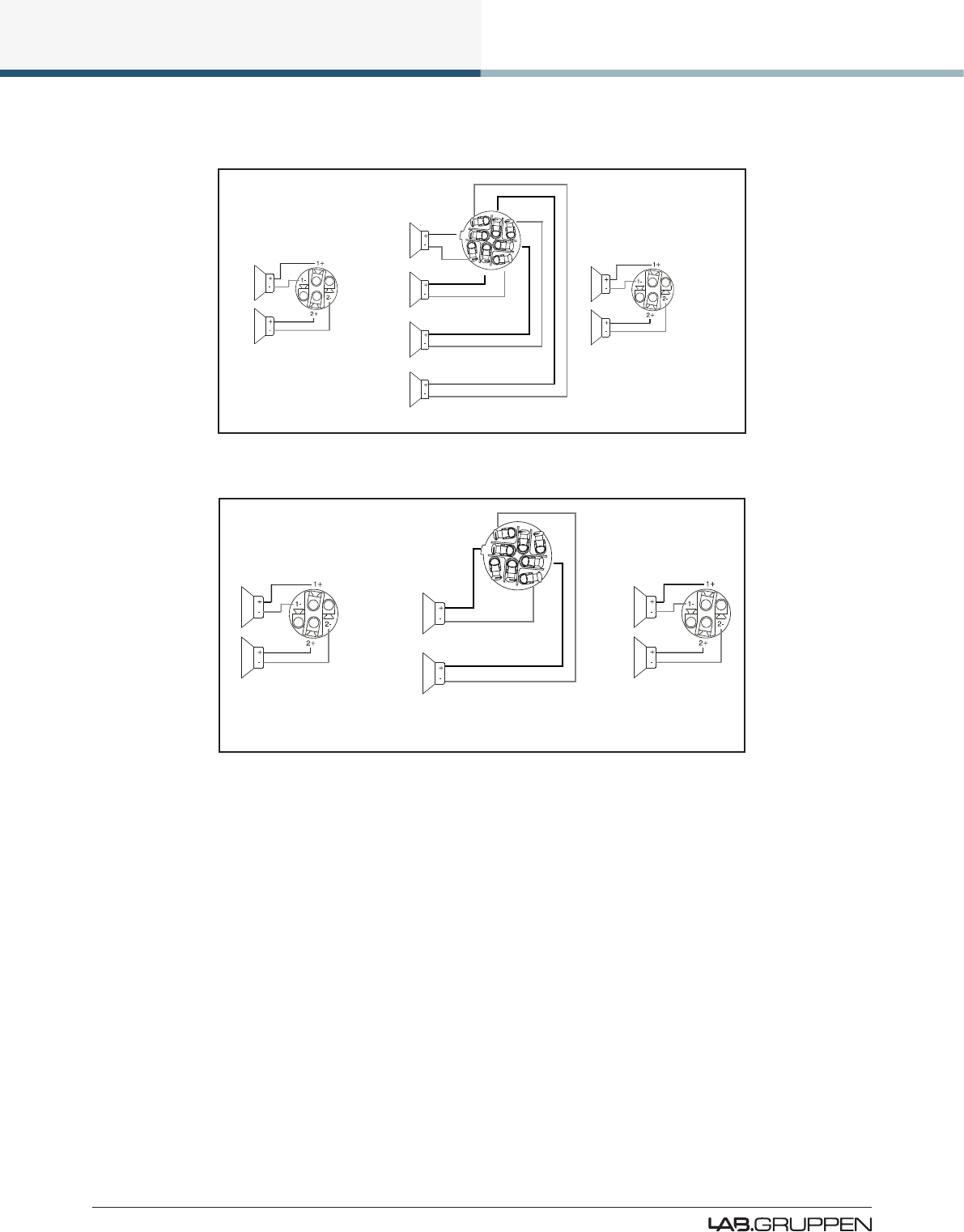
66
Back Panel Interface
PLM Series Operation Manual Rev 1.3.0
3+
2-
4+
2+
1-
1+
4-
3-
1+
1-
2+
2-
3+
3-
4+
4-
NL4
PLM Output
Channels 1 & 2
NL4
PLM Output
Channels 3 & 4
NL8
PLM Output
Channels 1 - 4
Figure 8-5: speakON NL4/NL8 Conguration for 4-channel PLMs
3+
2-
4+
2+
1-
1+
4-
3-
1+
2 -
3+
4 -
NL4
PLM Output
Channels 1 & 2
NL4
PLM Output
Channels 3 & 4
NL8
PLM Output
Channels 1 - 4
Figure 8-6: speakON NL4/NL8 Conguration for 4-channel PLMs (Bridge Mode)
8.1.3 Binding Post Connectors
Binding post versions of the PLM are tted with four pairs of black and red 4 mm binding posts.
4-channel PLMs provide the output for one power output channel on each pair of binding posts as shown in
Figure 8-7.
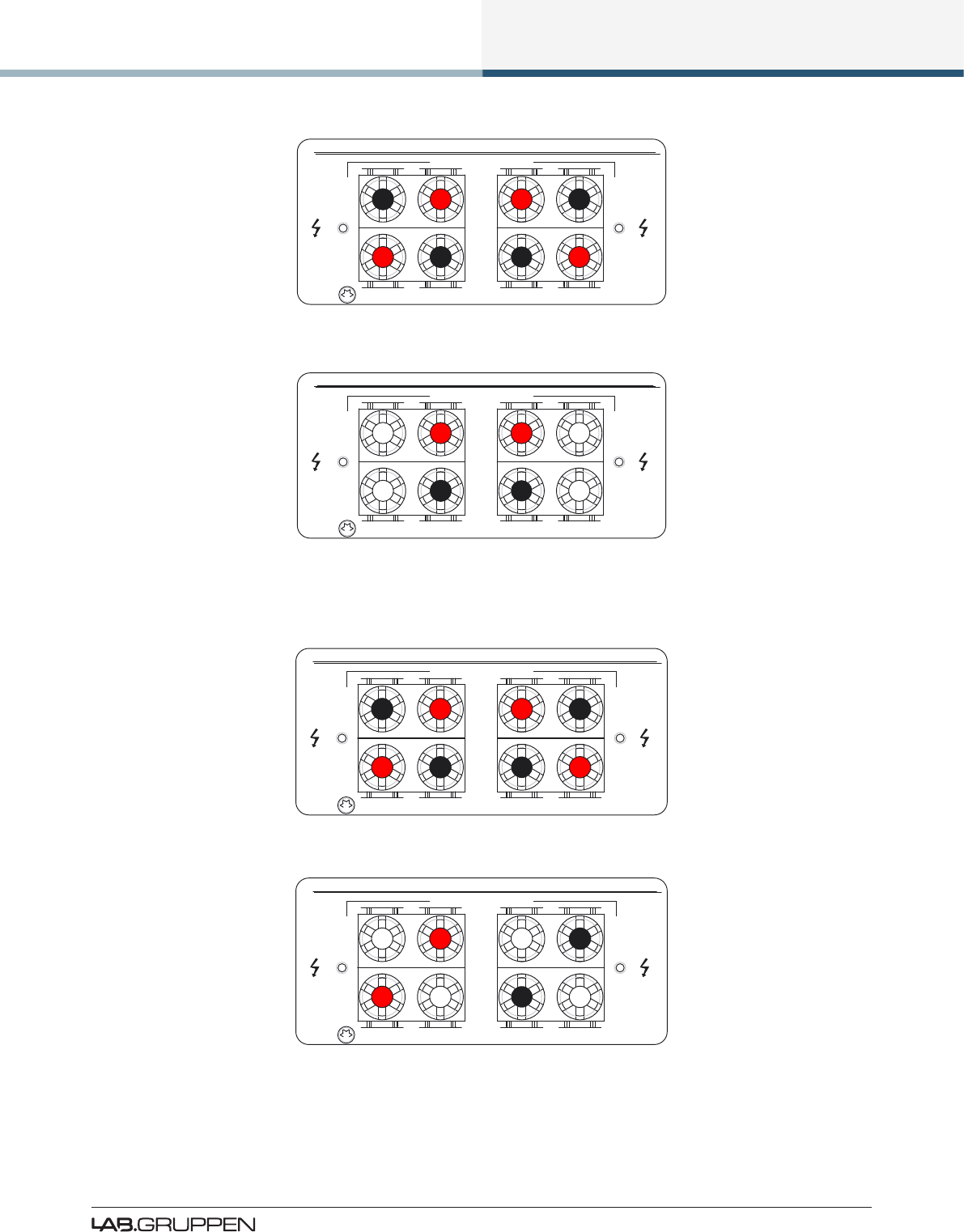
Back Panel Interface
67
PLM Series Operation Manual Rev 1.3.0
CH 2
CH 1
CH 4
CH 3
CLASS 3 WIRING
SPEAKER OUTPUTS
_++
+
+__
_
Figure 8-7: Binding Post Conguration for 4-channel PLM
CH 2
CH 1
CH 4
CH 3
CLASS 3 WIRING
SPEAKER OUTPUTS
++
__
Figure 8-8: Binding Post Conguration for 4-channel PLM (Bridge Mode)
2-channel PLMs provide each power output channel from two pairs of binding posts as shown in Figure 8-9.
CH 1
CH 1
CH 2
CH 2
CLASS 3 WIRING
SPEAKER OUTPUTS
_++
+
+__
_
Figure 8-9: 2-channel PLM Binding Post Conguration
CH 1
CH 1
CH 2
CH 2
CLASS 3 WIRING
SPEAKER OUTPUTS
+
+_
_
Figure 8-10: 2-channel PLM Binding Post Conguration (Bridge Mode)
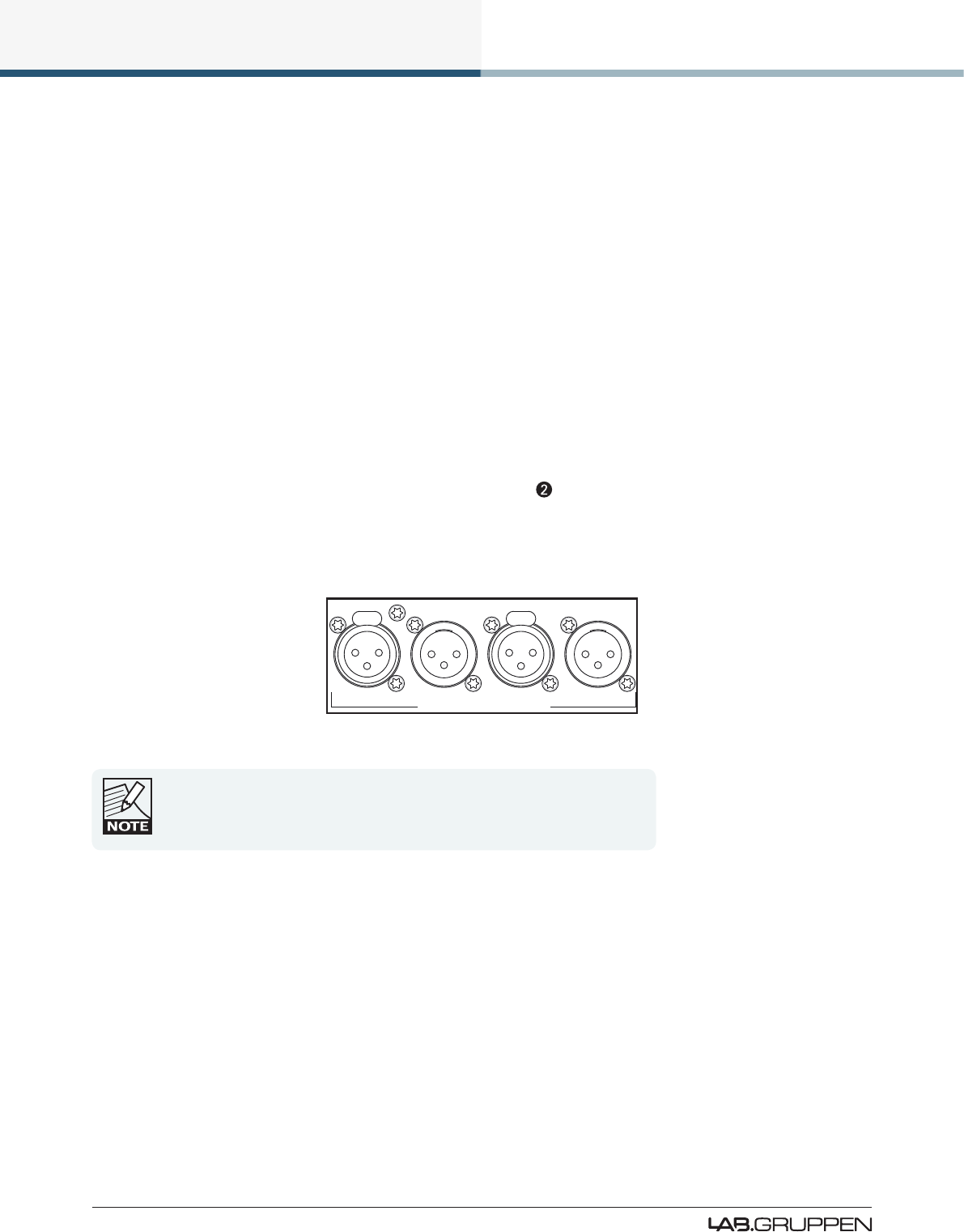
68
Back Panel Interface
PLM Series Operation Manual Rev 1.3.0
Connect the ‘+’ loudspeaker terminals to the red binding posts and the ‘ – ‘ terminals to the black binding
posts. There are three methods of connecting speaker cables to the binding posts.
1. Solder 4 mm banana-plugs to the ends of the speaker wires and plug into the center of the turrets.
2. Thread the stripped ends of the wires through the holes in the posts. Enter the wires for output
channels 1 and 3 from above and for channels 2 and 4 from below. Tighten the plastic turrets by
nger only, being careful not to overtighten.
3. Crimp 4 mm insulated spade terminals onto the ends of the wires and push into the binding post
assembly from above (Ch. 1 & 3) or below (Ch. 2 & 4). The hole in the post is ignored. Hand tighten
plastic turrets, being careful not to overtighten.
8.2 Analog Inputs and Outputs
8.2.1 Analog Input and Link XLR Connections
Two electronically-balanced analog inputs are provided via latching XLR3F connections. The Link outputs on
XLR3M connectors are directly paralleled to the inputs.
INPUT 1INPUT 2LINK 1LINK 2
PIN 1: SCRN 2: POS 3: NEG
ANALOG WITH
I
SO-
F
LOAT TM
Figure 8-11: Analog Input and Link XLR Connections
When linking analog inputs of several PLMs, consider that the drive capability of
the source’s output stage (e.g. mixing console) may be limited. Generally it is
inadvisable not to parallel link more than four inputs. If more links are required,
use a good quality balanced audio line driver or distribution amplier.
8.2.2 Analog & AES3 XLR Wiring and Pin Out
All XLR connections are wired to IEC268 as shown in Figure 8-12.
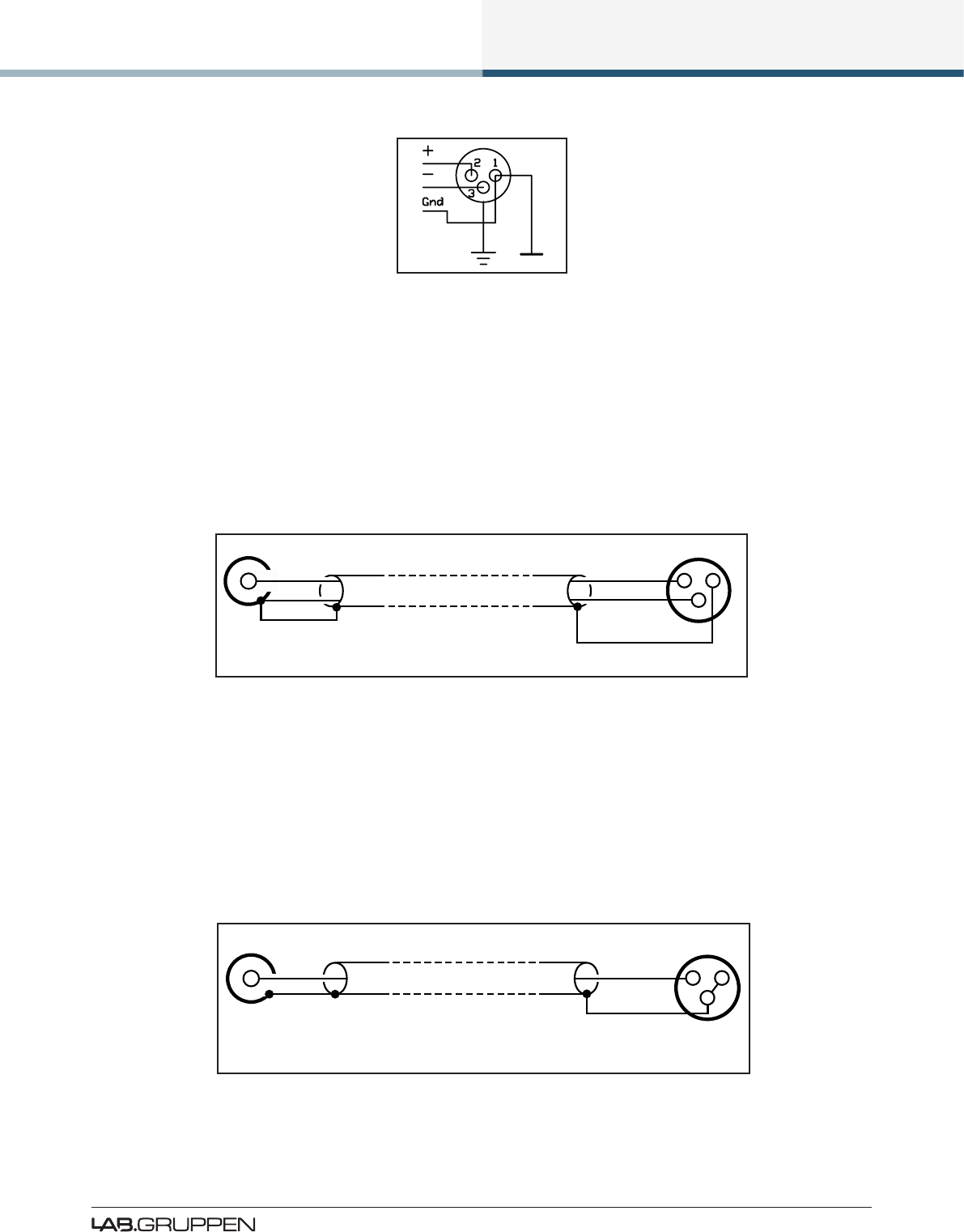
Back Panel Interface
69
PLM Series Operation Manual Rev 1.3.0
Figure 8-12: IEC268 XLR Wiring and Pin Out
Pin 1: Ground / Shield
Pin 2: Hot (+)
Pin 3: Cold (-)
8.2.3 Unbalanced Operation
Balanced connections are recommended where possible. However, if it is necessary to drive the device
from equipment with an unbalanced output, wire the inputs as shown in Figure 8-13.
12
3
COLD
HOT
SCRN
COLD
HOT
SCRN
Unbalanced Output
(Typically phono)
Balanced Input
(XLR)
Figure 8-13: Balanced to Unbalanced Analog Wiring and Pin Out
The method shown in Figure 8-13 uses twin-and-screen (balanced) cable and standard XLR pin connections
at the PLM Series device end, with the cold wire and the cable screen connected to the signal ground of the
equipment at the source end.
This usually provides better noise and hum rejection than the more common method of joining pins 1 and
3 together in the XLR. However, if only a single-core (unbalanced) cable is available, the method shown in
Figure 8-14 may be used.
12
3
HOT
SCRN
HOT
SCRN
Unbalanced Output
(Typically phono)
Balanced Input
(XLR)
Figure 8-14: Unbalanced Analog Wiring and Pin Out
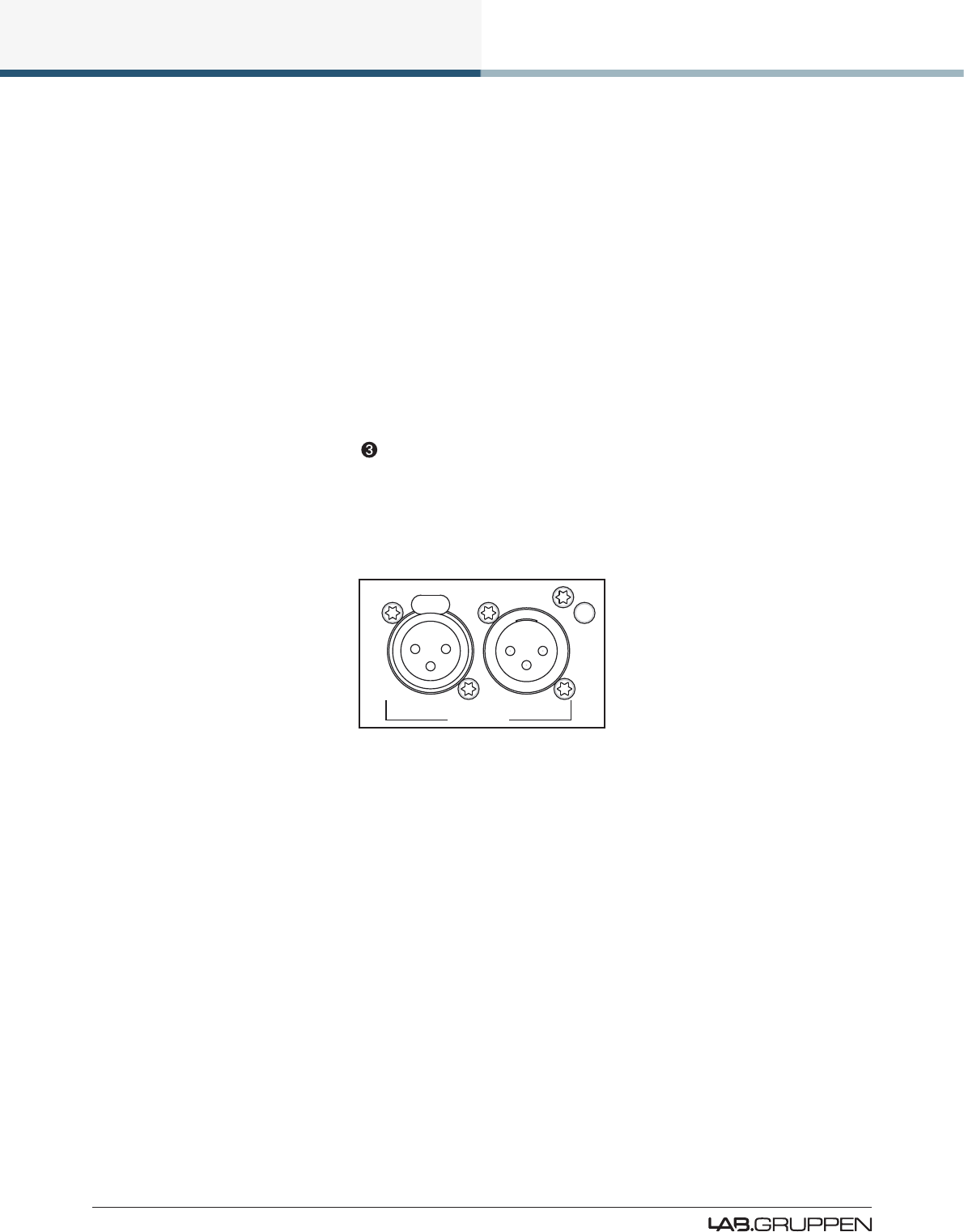
70
Back Panel Interface
PLM Series Operation Manual Rev 1.3.0
8.2.4 Iso-Float Electronic Balancing
The analog input electronic balancing circuits use the Lake Iso-Float system.
The Iso-Float technology combines the benets of transformer-coupled isolation with the advantages of
clean, direct-coupled inputs. The audio converters are galvanically isolated, and not connected to the main
ground. High-quality transformers and opto-isolators create a barrier between the device and possible
grounding aberrations from the outside electrical environment.
Iso-Float settings are adjustable via the front panel menu or the Lake Controller software.
8.3 AES3 Digital I/O
8.3.1 AES3 XLR Connector
AES3 digital audio input is via an XLR3F connector, which is directly paralleled to the adjacent XLR3M AES3
Link connector. Wiring of this connector follows the same standard as for analog XLR connections as shown
section 8.2.2.
AES/EBU
INPUT 1-2 LINK 1-2
Figure 8-15: AES3 XLR Input and Link Connectors
Figure 8-12 on page 69 shows the only possible method of wiring; there is no equivalent of an unbalanced
connection in the digital domain.
The AES3 signal format carries two channels of audio and associated data on a single cable/connector.
Selection of Ch 1 or Ch 2 is performed within the digital processing section of the PLM and is controlled
from the menu system. Please refer to section 7.11.3.1 for further details.
The AES3 Link connector may be used to daisy-chain the inputs of multiple PLMs together. Unlike daisy-
chaining of analog inputs, attention must be paid to line termination. When daisy-chaining PLMs together,
only the last PLM in the chain should be set to TERMINATED. All other PLMs should be set to UNTERMI-
NATED. Please refer to section 7.11.3.2 for further details.
As with balanced analog audio, there is a nite limit to how many PLMs may have their AES3 inputs daisy-
chained together. The practical limit will be determined by cable type and length as well as the output circuit
of the driving source. It may be necessary to employ an AES3 line driver or distribution amplier to achieve
reliable results in some situations.
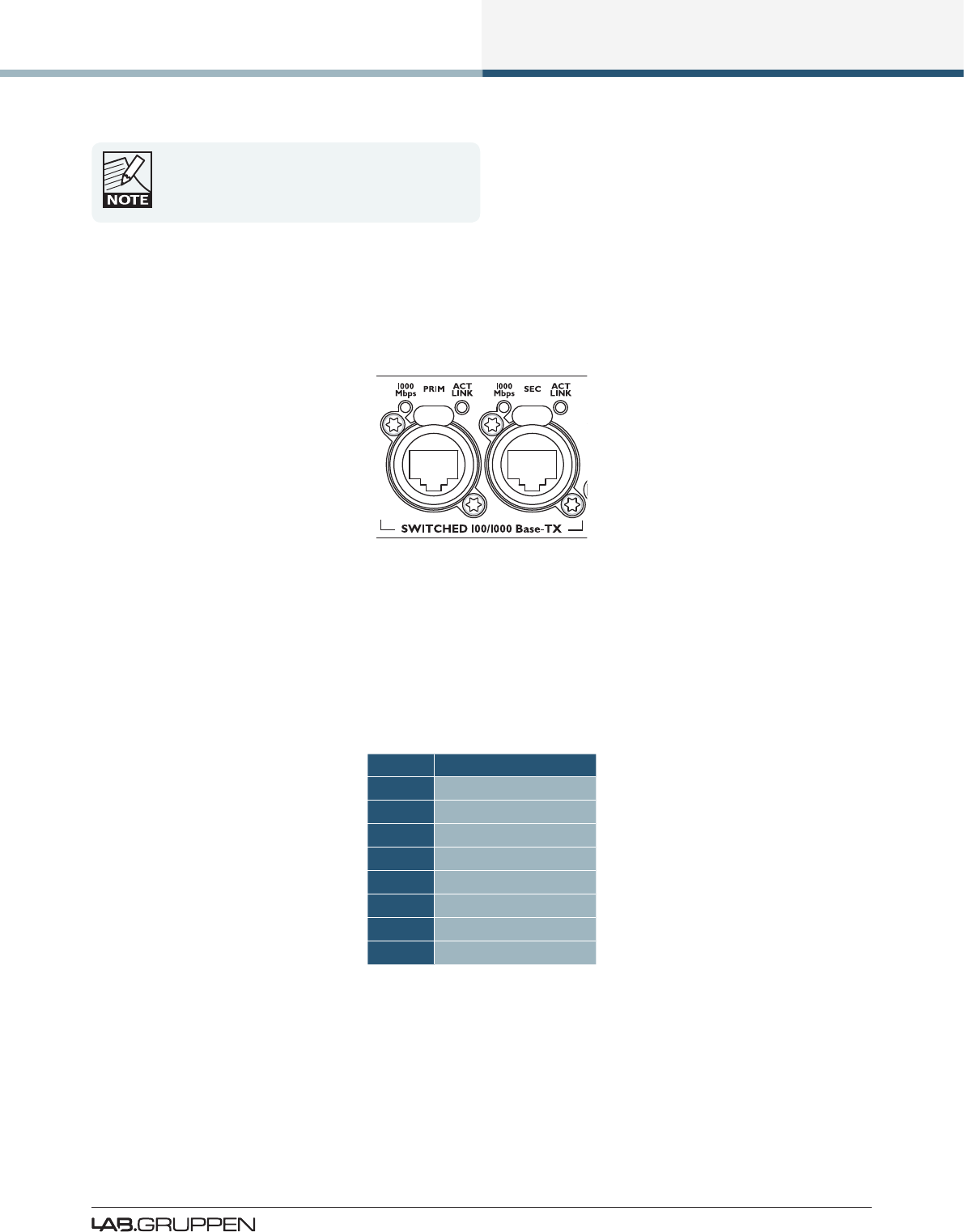
Back Panel Interface
71
PLM Series Operation Manual Rev 1.3.0
Tests indicate that up to 20 PLMs may be have
their AES3 inputs daisy-chained together, however
circumstances and cabling used may reduce this
gure. Please refer to section 10.6.
8.4 RJ45 etherCON Network Connections
Two RJ45 etherCON style network connections are provided as shown in Figure 8-16.
Figure 8-16: etherCON Network Connectors
The switched 100/100 Base-T network connections auto-sense whether standard or crossover Cat-5e
cables are in use. The green ACT LED illuminates (ashes) to show network activity, and when a 100 Mbps
connection is present; the orange LED illuminates (static) to indicate a 1000 Mbps connection.
Pre-made cables with moulded RJ45 plugs are recommended. If it is necessary to make up custom Cat-5e
network cables, use pinout described in Table 8-4.
Pin No. Color
1 Brown
2 Brown + White
3 Green
4 Blue + White
5 Blue
6 Green + White
7 Orange
8 Orange + White
Table 8-4: RJ45 Wiring & Pin Out Description
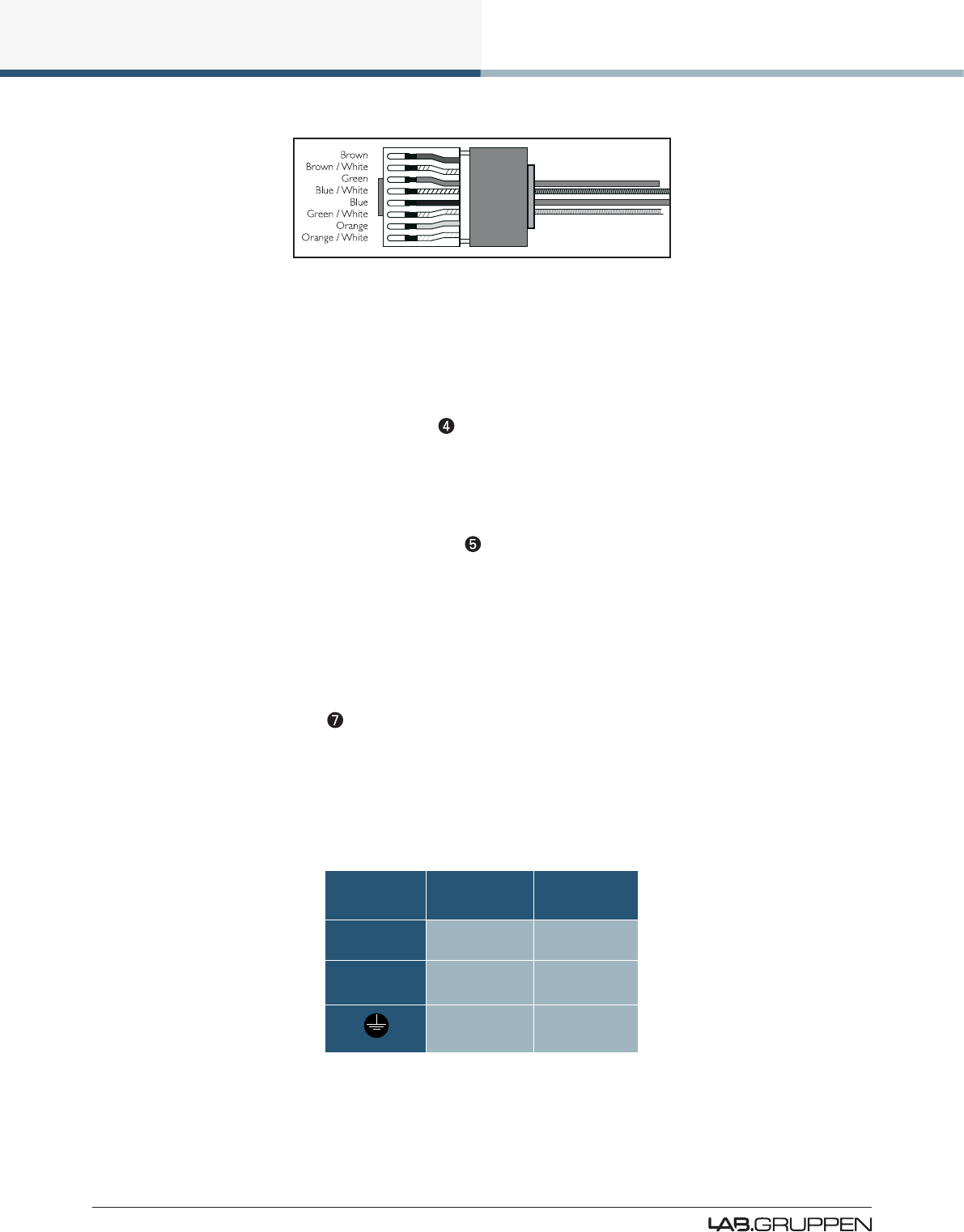
72
Back Panel Interface
PLM Series Operation Manual Rev 1.3.0
Figure 8-17: RJ45 Wiring and Pin Out Diagram
When the device is connected to an active network, the yellow LINK LED illuminates above the connector in
use. Data activity on the network is indicated by illumination of the green ACT LED. It is normal for the ACT
LED to icker either sporadically or continuously.
8.4.1 Primary Network Connection
The Primary Network connection is used for Lake Controller connectivity and Dante digital audio. Please
refer to section 4.2 for additional information.
8.4.2 Secondary Network Connection
The Secondary Network connection may be used for a redundant Dante digital audio network. Please refer
to section 4.2 for additional information.
8.5 Power Inlet
8.5.1 Power Connector
A Neutrik NAC3 Series powerCON connector rated at 32 A is tted to the rear of the PLM for AC mains
input. The power cable (AC cord) supplied with the PLM has the mating connector ready-tted, but may
require a mains (AC) plug specic to your country to be tted to the other end. The wiring an pinout details
are shown in Table 8-5.
powerCON
Pin
230 V
Version
115 V
Version
LBrown Black
NBlue White
Green/Yellow Green
Table 8-5: powerCON Connector Wiring and Pinout
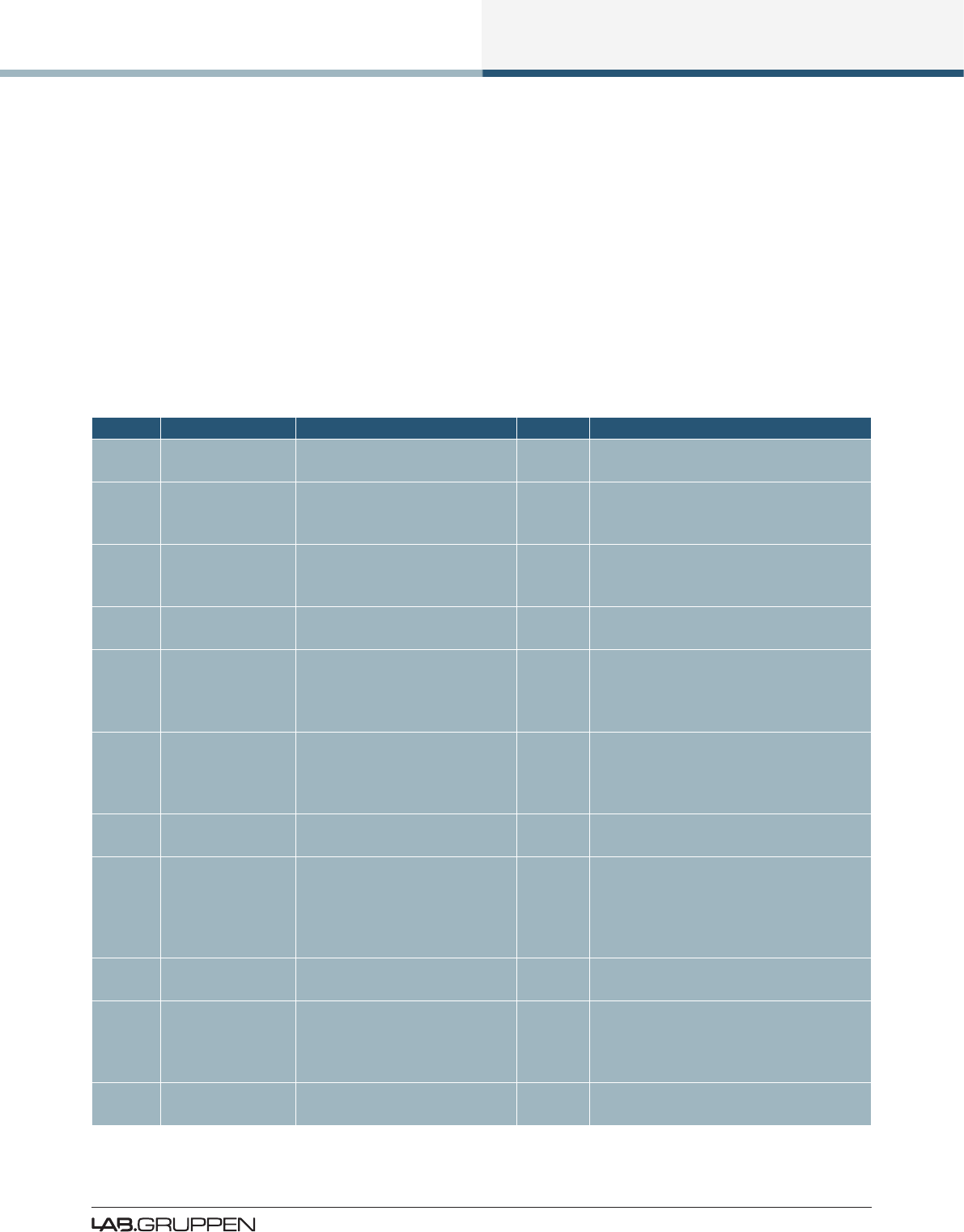
Appendix
73
PLM Series Operation Manual Rev 1.3.0
9. Appendix
9.1 Faults and Warnings Overview
Fault or warning conditions are indicated by the LED shown in Figure 7-3 on page 34, and also by LEDs associ-
ated with the inputs and outputs on the PLM. As the LEDs indicate several types of faults or warnings, a
brief textual description of the fault or warning is provided on the LCD display. Section 7.8.2 on page 34 details
the fault and warning indications that appear on the front panel. Table 9-1 lists the events that may have
triggered each fault or warning condition.
Model Displayed Text Event Log Text Category Description
ALL AMP CH. MUTE Amp Channel Mute Mute The audio signal has been muted in the
power output stage.
ALL ANALOG IN
FAULT
Frame Fault: Analog Input Fault The analog input signal is corrupt due
to DC on the analog input, or there is an
issue with the internal A/D converter.
20000Q ATL ACTIVE N/A Warning The output power is limited due to high
amplier channel temperature - the amp
channel temperature limiter is active.
ALL AUDIO FAULT Frame Fault: Audio Interface Fault An internal audio fault has arisen and the
unit needs servicing.
20000Q BEL ACTIVE N/A Warning Breaker Emulation Limiter present as the
nominal current reached. Improve the
power distribution and adjust the BEL
settings.
ALL CAL ACTIVE n/a Fault Ensures that the PLM’s power output
stages are not overloaded. This should
never happen during normal program
material.
20000Q CHECK AC
MAINS
Frame fault: Check AC Mains Fault The PSU received unstable mains, check
the mains conguration.
ALL CLOCK SLIPPING AES Clock slipping Warning The AES or Dante clock is slipping; verify
clock selection / generator. This will
cause high THD on signal, and if Dante
is running will result in an unstable signal
distribution.
ALL CTRL OFFLINE N/A Warning The PLM is no longer able to communi-
cate with the Lake Controller.
ALL CURRENT CLIP n/a Clip PLM’s power output stage current has
exceeded the xed safe maximum and
the Current Peak Limiter has become
active to limit it.
ALL INPUT CLIP n/a Clip The input signal level is too high and is
causing clipping at the input stage
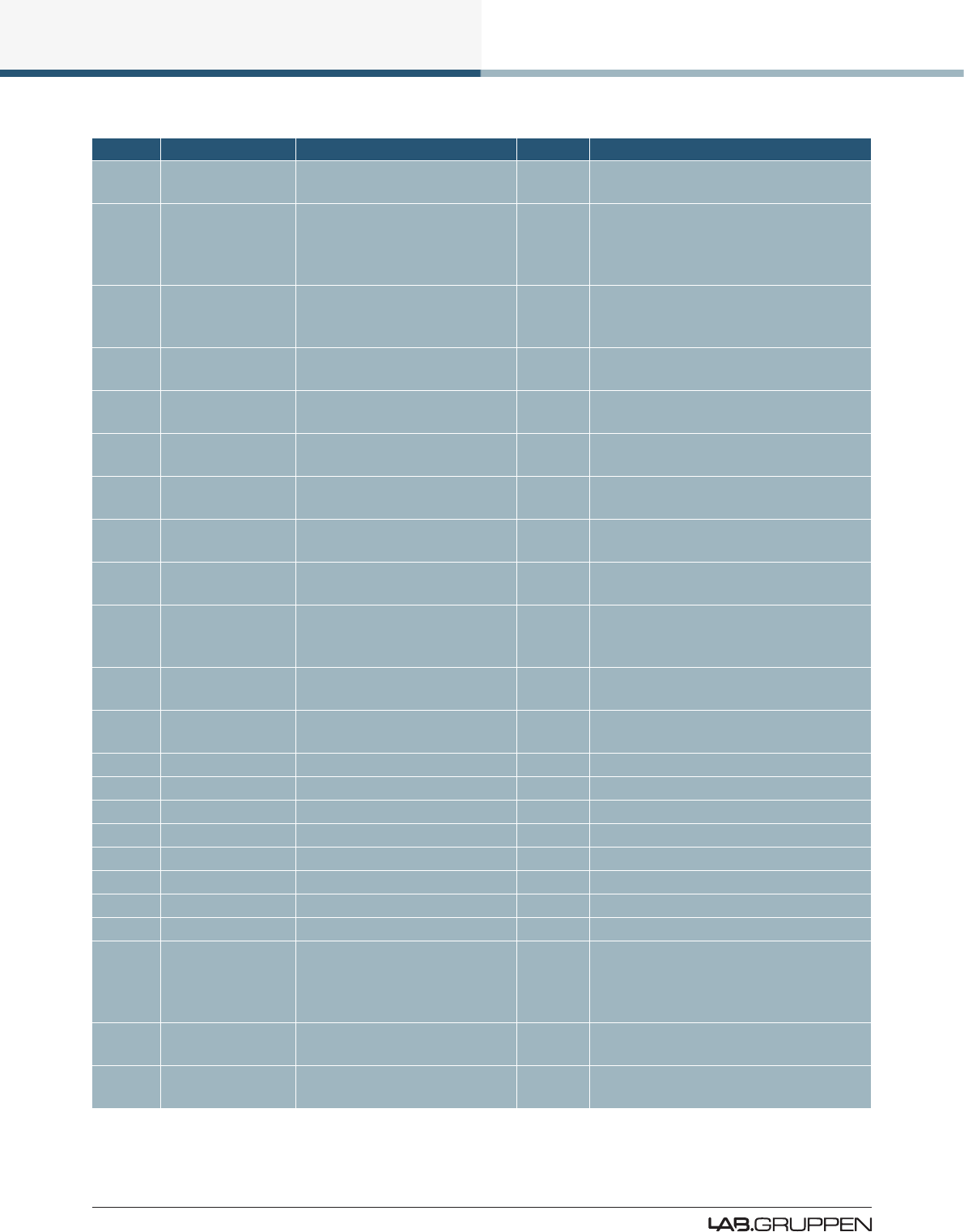
74
Appendix
PLM Series Operation Manual Rev 1.3.0
Model Displayed Text Event Log Text Category Description
ALL INPUT MUTE Input Mute Mute The audio signal has been muted at the
input router of the Lake Processor.
ALL LM PREC. LOW Speakersafe precision low Warning A SpeakerSafe warning indicating insuf-
cient data to produce reliable results.
This may occur, for example, if a channel
is being driven at a very low level.
ALL LOAD NOT VER LoadSmart: Load Not Veried Warning A Module containing a Fingerprint has
been loaded, but the load is yet to be
veried with LoadSmart.
20000Q MAINS <65 V Frame fault: PSU mains <65 V Fault Mains input voltage is below 65 Volts
RMS.
20000Q MAINS >270 V Frame fault: PSU mains >270 V Fault Mains input voltage is above 270 Volts
RMS.
20000Q MAINS >400 VPK Frame fault: PSU mains >400
VPK
Fault Mains input voltage is above 400 Volts
Peak.
20000Q MAINS GLITCH Glitch on mains voltage
detected
Warning A glitch (missing cycles) on mains input
was detected.
ALL MOD. IN MUTE Module Input Mute Mute The audio signal has been muted at the
Module input of the Lake processor.
ALL MOD. OUT MUTE Module Output Mute Mute The audio signal has been muted in the
output stage of the Lake processor.
ALL MODULE CLIP n/a Clip The signal level on the outputs of the
Lake processing module is too high and
is clipping.
ALL n/a LoadSmart Verication Event LoadSmart load verication is in
progress.
ALL n/a Sound Source Changed Event The input router has changed sound
source.
20000Q NEED SERVICE:1 Frame fault: Need Service: 1 Fault Service required, contact your dealer.
20000Q NEED SERVICE:2 Frame fault: Need Service: 2 Fault Service required, contact your dealer.
20000Q NEED SERVICE:3 Frame fault: Need Service: 3 Fault Service required, contact your dealer.
20000Q NEED SERVICE:4 Frame fault: Need Service: 4 Fault Service required, contact your dealer.
20000Q NEED SERVICE:5 Frame fault: Need Service: 5 Fault Service required, contact your dealer.
20000Q NEED SERVICE:6 Frame fault: Need Service: 6 Fault Service required, contact your dealer.
20000Q NEED SERVICE:7 Frame fault: Need Service: 7 Fault Service required, contact your dealer.
20000Q NEED SERVICE:8 Frame fault: Need Service: 8 Fault Service required, contact your dealer.
ALL NO INPUT No Input Source Fault The chosen input type has been
deselected or lost and the input type
selector has no alternative input sources
in the priority list.
ALL NO LOAD Channel Fault: No Load
Detected
Fault No load detected at the power output
channel.
ALL OFFLINE Frame Ofine Warning The Lake Controller cannot communicate
with this Lake device.
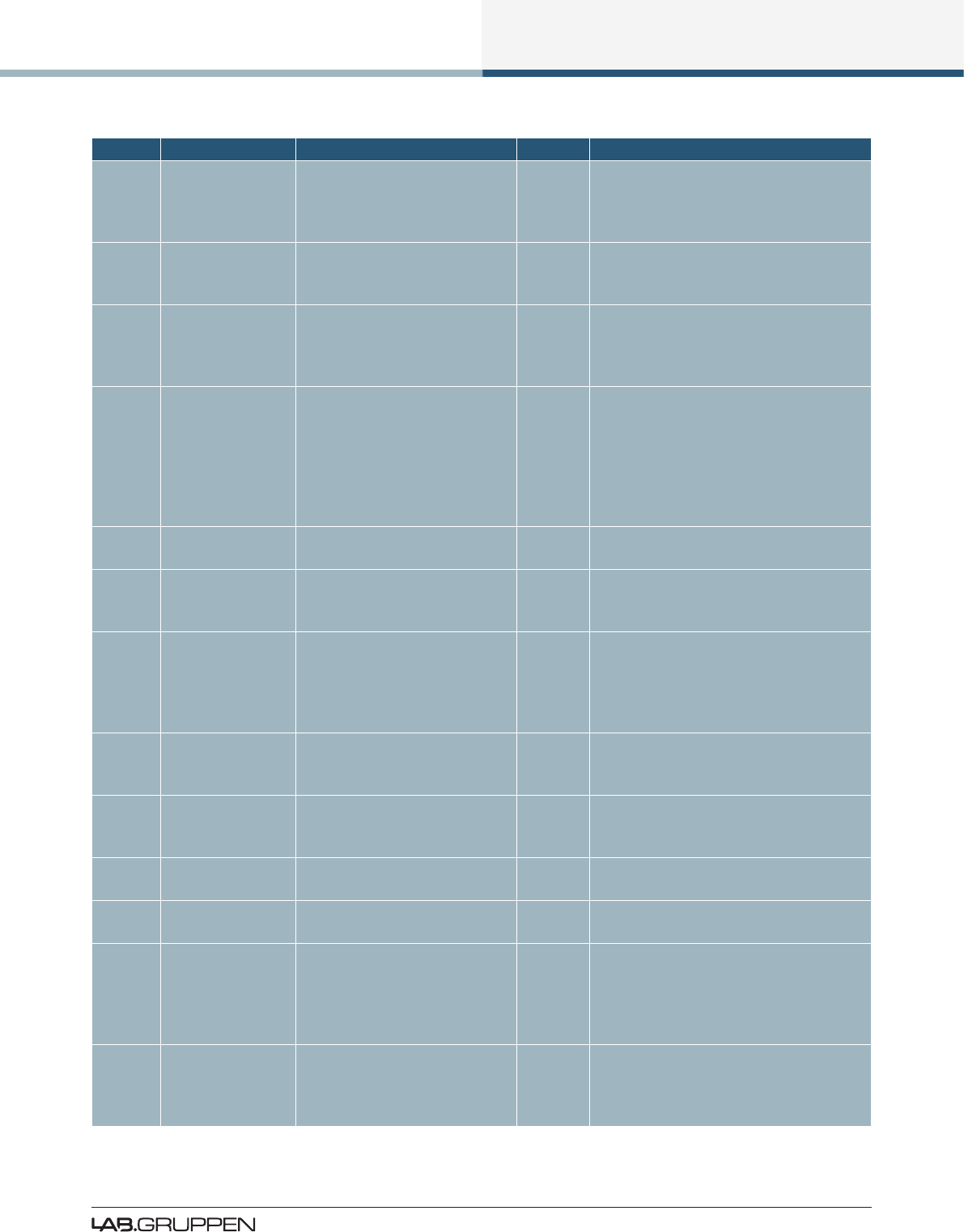
Appendix
75
PLM Series Operation Manual Rev 1.3.0
Model Displayed Text Event Log Text Category Description
ALL OVER SPKR CNT Over Speaker Count Warning A lower load impedance has been
measured than was predicted by the
Load Library for the assigned speaker
type.
10000Q
14000
PAL ACTIVE n/a Fault Total amplier power being delivered has
exceeded the safe maximum value and
the PAL has become active.
20000Q PAL ACTIVE n/a Warning Output power is limited due to the PSU
maximum current or power level has
been reached and PAL has become
active.
ALL PSU FAULT Frame Fault: PSU Undervoltage Fault The Power supply did not start up
properly. It could be due to undervoltage
on the mains or due to an internal non
user-serviceable fault. If the mains are
checked to be OK and the fault persists
the unit should be returned to your
dealer.
20000Q PSU POWER
PROT
Frame Fault: PSU Power
Protect
Fault Low input voltage, high power demand.
20000Q PTL ACTIVE N/A Warning The output power is limited due high
temperature in the Power supply and the
PSU Temperature Limiter is active
ALL SENSE FAULT Frame warning: Sense Fault Warning The output Voltage and Current sensors
are lost. The PLM is OK for continued
operation but is at risk of entering
protective mutes states. Return device
to dealer.
ALL SERVICE CH. Channel Fault: Unit Needs
Service
Fault One or more breakers in the power stage
have blown. This is not a user-servicable
fault; return device to dealer.
ALL SHORT CIRCUIT Channel Fault: Short Circuit
Protection
Fault The PLM is measuring both very high
load current and very low output voltage.
Short circuit protection is active.
ALL SPKSAFE INACT SpeakerSafe Not Started Warning Warns that after LoadSmart verication,
SpeakerSafe monitoring was not started.
ALL TEMP FLT:CH Temp Fault: Amp Channel Fault Temperature in the power output stage
exceeds safety limit.
ALL TEMP FLT:DSP Temp Fault: DSP Area Fault The temperature of the PLM’s process-
ing circuitry has exceeded its safety
limit. Audio is not muted, but continued
operation at this temperature is not
recommended.
ALL TEMP FLT:MAG Temp Fault: Speaker Magnet Fault The temperature of the speaker magnet
estimated by SpeakerSafe, has exceeded
the manufacturers’ recommended
maximum.
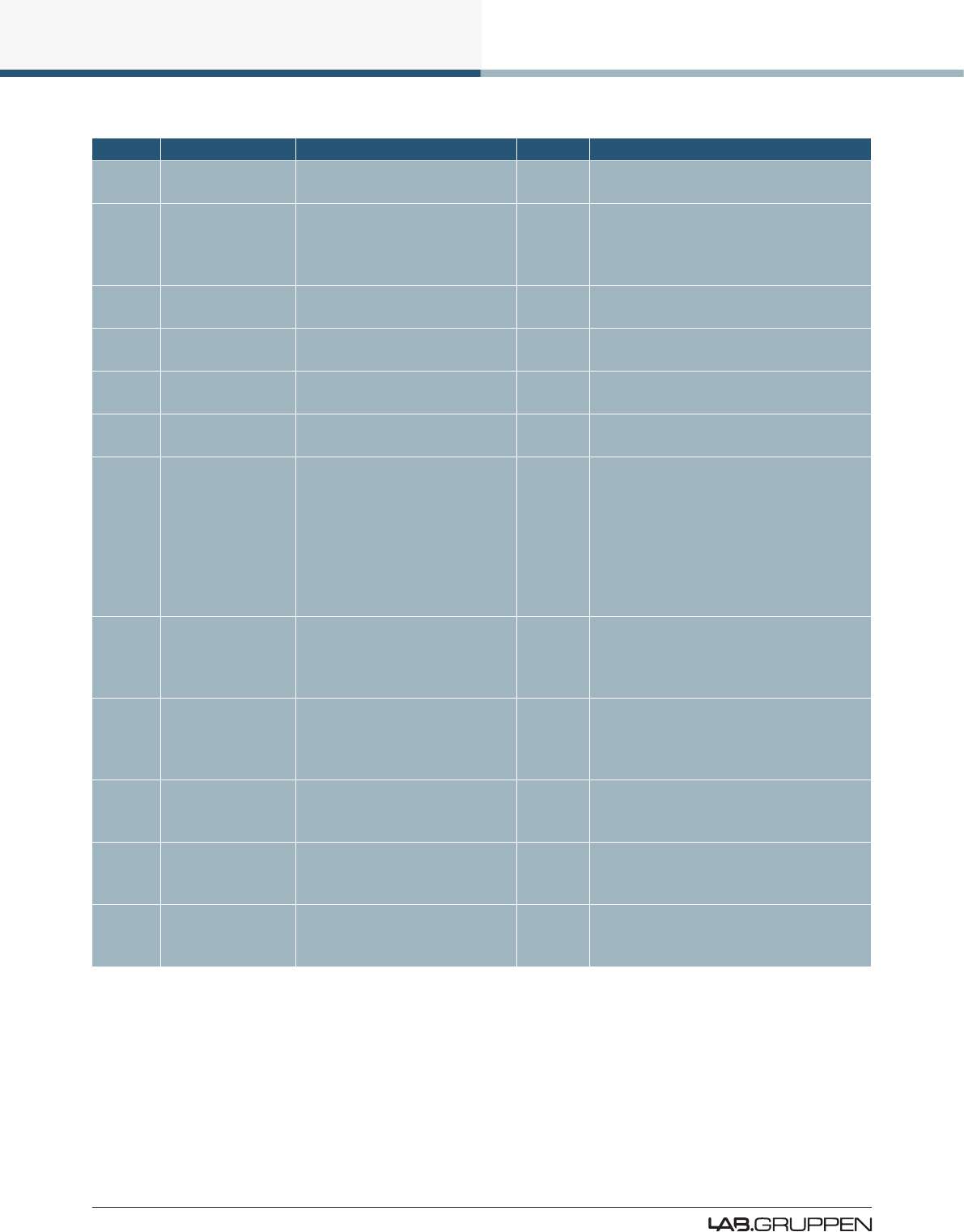
76
Appendix
PLM Series Operation Manual Rev 1.3.0
Model Displayed Text Event Log Text Category Description
ALL TEMP FLT:PSU Temp Fault: Power Supply Unit Fault The temperature of the PLM’s PSU has
exceeded its safety limit.
ALL TEMP FLT:VC Temp Fault: Speaker Voice Coil Fault The temperature of the speaker voice
coil (estimated by SpeakerSafe) has
exceeded the manufacturers’ recom-
mended maximum.
ALL TEMP WARN:
PSU
Temp warning: Power Supply
Unit
Warning High temperature in the Power Supply
Unit.
ALL TEMP WARN:CH Temp Warning: Amp Channel Warning High temperature in the power output
stage.
ALL TEMP
WARN:MAG
Temp Warning: Speaker
Magnet
Warning The temperature of the speaker magnet
is high (estimated by SpeakerSafe).
ALL TEMP WARN:VC Temp Warning: Speaker
Voice-Coil
Warning The temperature of the speaker voice
coil is high (estimated by SpeakerSafe).
ALL UNCERTAIN
LOAD
Uncertain About Load Type Warning When speaker Fingerprints are taken a
tolerance band is also dened to take
into account production variations. If
LoadSmart results lie in this band a
Load uncertainty warning results. The
user should re-check the load and if
all appears to be correct it is likely that
normal operation will result.
ALL UNDER SPKR
CNT
Under Speaker Count Warning A higher load impedance has been
measured than was predicted by the
Load Library for the assigned speaker
type.
20000Q UVL ACTIVE N/A Warning The Under Voltage limiter is active as the
mains supply has fallen between 65 and
80 Volts. Output power is descreased to
ensure mains distribution does not sag.
ALL VHF FAULT Channel Fault: Very High
Frequency
Fault An exceptionally high level of continuous
HF has been detected at the PLM’s
power output stage.
ALL VOLTAGE CLIP n/a Fault The peak voltage at the output terminals
has exceeded the user-dened safe
maximum.
ALL WRONG LOAD Load Type / Routing Mismatch Fault LoadSmart is measuring load charac-
teristics which differ from those of the
assigned speaker type.
Table 9-1: Warning, Fault and Mute Indications (alphabetical by LCD Text / Event Log Text)
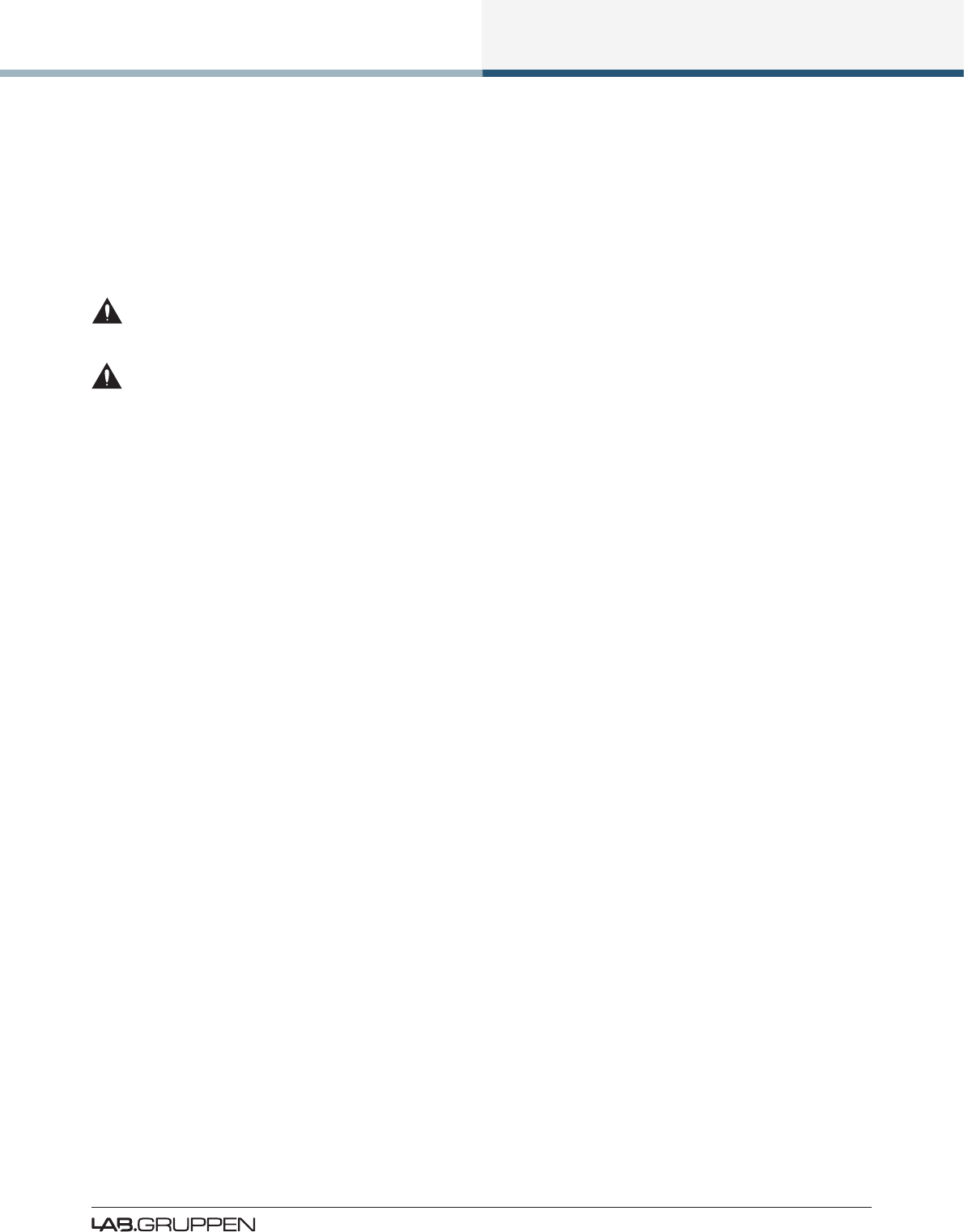
Appendix
77
PLM Series Operation Manual Rev 1.3.0
9.2 Maintenance
During normal operation this devices provides trouble-free service. If the LCD or front panel display requires
cleaning, use a soft cloth only; do not use solvent cleaners. The dust lters on both sides of the front panel,
behind the grilles, should occasionally be removed and cleaned to ensure maximum airow through the
device.
Disconnect the unit from mains power prior to removing dust the lter, and ensure the dust lter is
replace prior to turning the unit back on.
Do not use sharp or metal objects to remove the dust lter, and be careful that the implement used to
remove the lter does not enter the device.
In extreme cases it may be necessary to clean the inside of the device. This procedure should only be
carried out by qualied service personnel. This may be necessary if the device has had prolonged operation
in an extreme environment such as one where cracked oil smoke machines are in use. If the device is used
in extreme conditions, it is recommended to have it serviced every three years as a preventative measure.
9.3 Factory Default Settings
9.3.1 Module Defaults
Module Type: 2 x 2 Aux
Mod Input Mute: On
Mod Output Mutes: Off
Gain: 0 dB (unity)
Delay: 0 ms
Polarity: Positive (In phase)
MaxRMS: 20 dB
MaxPeak: 21 dB
Amp Gain: 35 dB
ISVPL: 153 V [PLM 10000Q]
193 V [PLM 14000]
194 V [PLM 20000Q]
Input & Output EQ: Flat

78
Appendix
PLM Series Operation Manual Rev 1.3.0
9.3.2 Input and Router Defaults
Autoselect: On
Input sensitivity: +26 dBu
Dante: Disabled
AES3: Terminated
Iso-Float: Enabled
Router 1: AES1 (Ch.1) as Priority 1, Analog 1 as Priority 4
Router 2: AES1 (Ch.2) as Priority 1, Analog 2 as Priority 4
Router 3: AES2 (Ch.3) as Priority 1, Analog 1 as Priority 4
Router 4: AES2 (Ch.4) as Priority 1, Analog 2 as Priority 4
Router 5: AES1 (Ch.1) as Priority 1, Analog 1 as Priority 4
Router 6: AES2 (Ch.1) as Priority 1, Analog 2 as Priority 4
Router 7: AES2 (Ch.1) as Priority 1, Analog 3 as Priority 4
Router 8: AES2 (Ch.1) as Priority 1, Analog 4 as Priority 4
9.3.3 Amplier Defaults
Attenuation: 0 dB
Polarity: Positive (In phase)
Mutes: Unmuted
Load Model: No Load Model
Breaker Emulation Limiter: 32 A - Breaker Fast (PLM 20000Q only)
9.4 Current Draw and Thermal Dissipation Specications
The tables in this section provide measured current consumption and calculated heat dissipation for ve
different operating conditions for each PLM Series device.
1. Standby Mode
2. Power On (Idle - No Signal)
3. Power On (Normal Operation - Pink Noise 1/8 of Rated Power)
4. Power On (Heavy Duty Operation - Pink Noise Max Power) - Not available for PLM 20000Q
5. Power On (Pilot Tone Operation - 20 kHz Sine Wave)
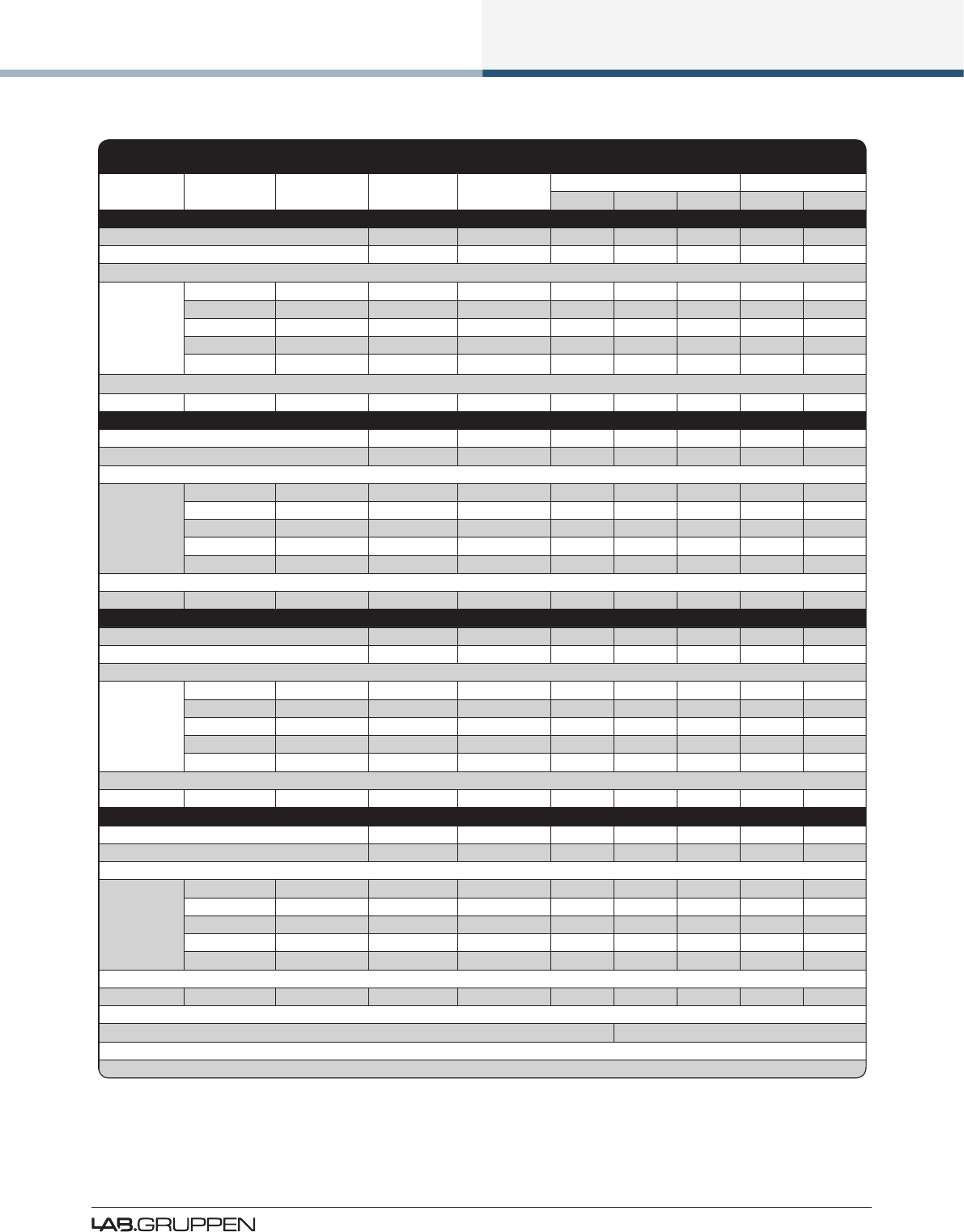
Appendix
79
PLM Series Operation Manual Rev 1.3.0
L A B . G R U P P E N A B ▸ S W E D E N
I N T E R N A T I O N A L C O N T A C T ▸ I N F O @ L A B G R U P P E N . C O M | U S & C A N A D A C O N T A C T ▸ I N F O @ T C G - A M E R I C A S . C O M
W W W . L A B G R U P P E N . C O M
Current Draw and Thermal Dissipation
PLM™ Series: Powered Loudspeaker Management™
PLM 20000Q
Item no. CDTD-PLM20000Q
PLM 20000Q
Level Load Rated power Line current [A] Power factor [%] Measured Power [W] Thermal Dissipation
In Out Dissipated BTU/hr kCal/hr
Mains voltage 100 VAC 30A
Standby 0,4 50,6 18 0 18 61 15
Power On, Idling 2,3 95,4 223 0 223 763 192
Pink pseudo
noise*1)
16 Ω / Ch. 1150 x 4 12,5 98,9 1237 575 662 2260 569
8 Ω / Ch. 2350 x 4 22,6 99,0 2237 1175 1062 3623 913
4 Ω / Ch. 4400 x 4 30,0 99,0 2970 1487 1483 5060 1275
2,67 Ω / Ch. 5000 x 4 30,0 99,0 2970 1431 1539 5252 1323
2 Ω / Ch. 4800 x 4 30,0 99,0 2970 1335 1635 5579 1406
Sine 20 kHz 16 Ω / Ch. 1 x 4 2,5 96,1 239 4 235 801 202
Mains voltage 120 VAC 30A
Standby 0,3 47,1 18 0 18 61 15
Power On, Idling 2,0 94,9 223 0 223 763 192
Pink pseudo
noise*1)
16 Ω / Ch. 1150 x 4 10,1 98,7 1193 575 618 2109 531
8 Ω / Ch. 2350 x 4 18,1 99,0 2156 1175 981 3349 844
4 Ω / Ch. 4400 x 4 30,0 99,0 3564 1926 1638 5591 1408
2,67 Ω / Ch. 5000 x 4 30,0 99,0 3564 1816 1748 5967 1503
2 Ω / Ch. 4800 x 4 30,0 99,0 3564 1687 1877 6406 1614
Sine 20 kHz 16 Ω / Ch. 1 x 4 2,1 95,3 239 4 235 801 202
Mains voltage 208 VAC 17,3 A
Standby 0,3 28,7 18 0 18 61 15
Power On, Idling 1,2 88,1 223 0 223 763 192
Pink pseudo
noise*1)
16 Ω / Ch. 1150 x 4 6,7 98,5 1372 575 797 2720 685
8 Ω / Ch. 2350 x 4 10,6 99,0 2192 1175 1017 3472 875
4 Ω / Ch. 4400 x 4 17,3 99,0 3562 1895 1668 5692 1434
2,67 Ω / Ch. 5000 x 4 17,3 99,0 3562 1764 1798 6138 1546
2 Ω / Ch. 4800 x 4 17,3 99,0 3562 1691 1871 6386 1609
Sine 20 kHz 16 Ω / Ch. 1 x 4 1,3 90,2 239 4 235 801 202
Mains voltage 230 VAC 16 A
Standby 0,3 25,1 18 0 18 61 15
Power On, Idling 1,1 87,9 223 0 223 763 192
Pink pseudo
noise*1)
16 Ω / Ch. 1150 x 4 5,2 98,2 1183 575 608 2076 523
8 Ω / Ch. 2350 x 4 9,1 99,0 2078 1175 903 3083 777
4 Ω / Ch. 4400 x 4 16,0 99,0 3643 2093 1550 5291 1333
2,67 Ω / Ch. 5000 x 4 16,0 99,0 3643 2073 1570 5359 1350
2 Ω / Ch. 4800 x 4 16,0 99,0 3643 1904 1739 5934 1495
Sine 20kHz 16 Ω / Ch. 1 x 4 1,2 88,2 239 4 235 801 202
Mains connector - 230 V CE version / 230 V ETL version / 115 V ETL version 32 A, Neutrik® powerCON® Twist lock
*1) Pink pseudo noise at 1/8th of rated power or at maximum available line current for the given mains distribution
Table 9-2: PLM 20000Q Current Draw and Thermal Dissipation
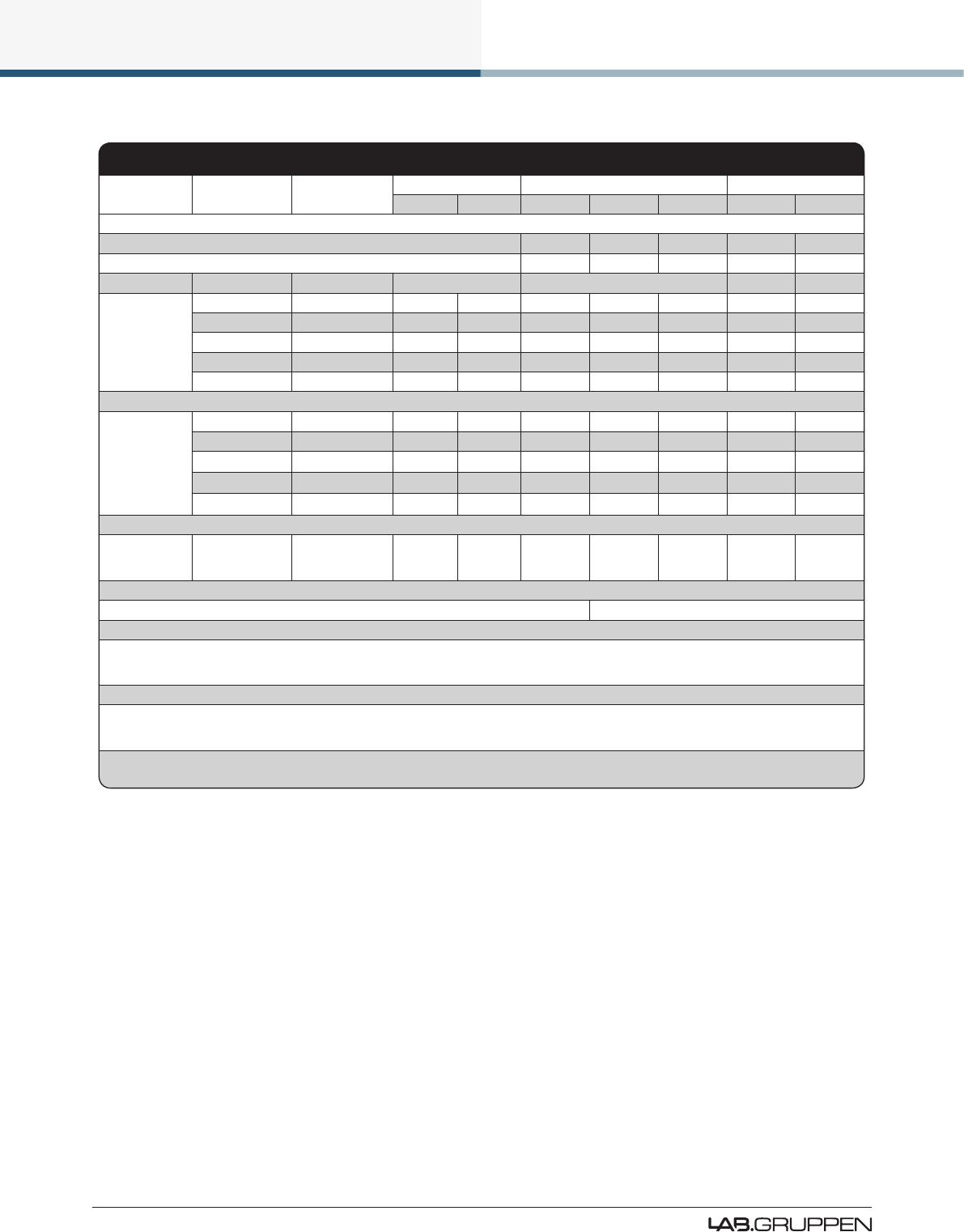
80
Appendix
PLM Series Operation Manual Rev 1.3.0
PLM 14000
Level Load Rated power Line Current *2) Watt *1) Thermal Dissipation
120 VAC 230 VAC In Out Dissipated BTU/hr kCal/hr
Standby 12 0 12 42 11
Powered on, idling. 116 0 116 395 100
Amp (I) Watt
Pink noise (1/8
rated power)
16 Ω / Ch. 1150 x 2 8.5 4.4 603 288 315 1077 271
8 Ω / Ch. 2300 x 2 13.7 7.2 1023 575 448 1529 385
4 Ω / Ch. 4400 x 2 23.4 12.2 1838 1100 738 2518 634
2.67 Ω / Ch. 6200 x 2 30.0 15.7 2410 1550 860 2935 739
2 Ω / Ch.*4) 7000 x 2 34.0 17.8 2767 1750 1017 3471 874
Pink noise
(max power)
*3)
16 Ω / Ch. 1150 x 2 14.1 7.4 1040 575 465 1588 400
8 Ω / Ch. 2300 x 2 23.7 12.4 1834 1150 684 2334 588
4 Ω / Ch. 4400 x 2 30.0 16.0 2448/2502 1569/1606 879/897 2999/3060 756/771
2.67 Ω / Ch. 6200 x 2 30.0 16.0 2544/2601 1593/1630 951/971 3247/3313 818/835
2 Ω / Ch. 7000 x 2 30.0 16.0 2623/2682 1626/1664 997/1017 3403/3473 857/875
20 kHz
Surveillance
tone
16 Ω / Ch. 1 x 2 2.3 1.2 119 2 117 400 101
Mains connector - 230 V CE version / 230 V ETL version / 115 V ETL version 32 A, Neutrik@ PowerCon@ Twist lock
*1) The ampli er section’s PSU operates as a non-resistive load, so the calculation “Volts x Amps = Watts” would not be correct. Instead, measured
and speci ed here is what is known as the “Active Power” of the ampli er section providing useful, real-world values of power consumption and heat
dissipation.
*2) Current draw gures measured at 230 V. 115 V gures are converted from 230 V gures.
*3) Figures measured at maximum sustainable power without tripping the mains breaker. Listed separately for 30 A/115 V and 16 A/230 V operation.
Note that the max. power condition is very extreme and will not occur during normal operation. Also note that the mains breaker will not be tripped even
if operation is momentarily in excess of max. ratings.
*4) Italics used for conditions that, if sustained over long time periods, may trigger the mains breaker. Therefore these measurements should not be
used when calculating cooling requirements as they cannot be sustained by the mains breaker over time.
Table 9-3: PLM 14000 Current Draw and Thermal Dissipation
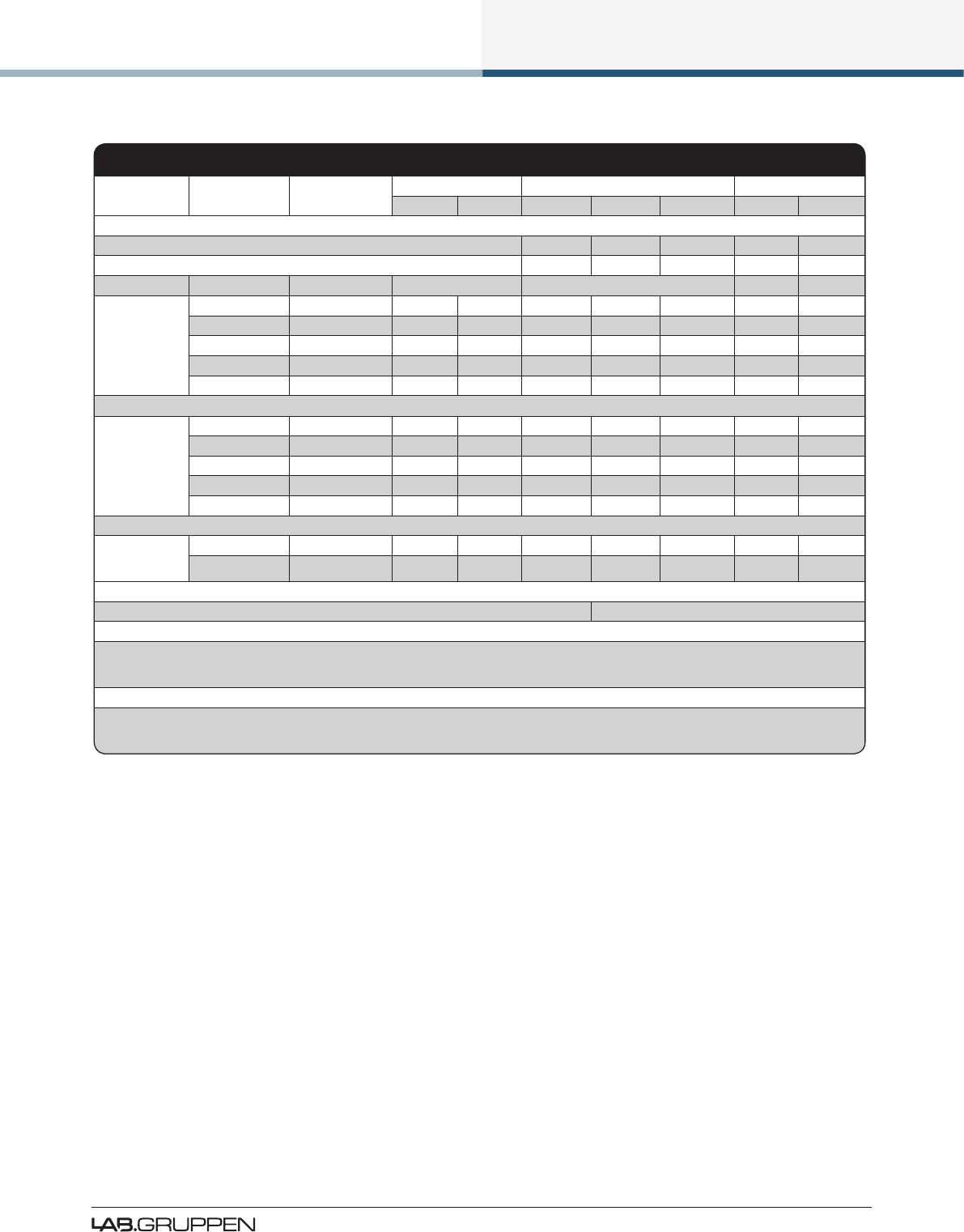
Appendix
81
PLM Series Operation Manual Rev 1.3.0
PLM 10000Q
Level Load Rated power Line Current *2) Watt *1) Thermal Dissipation
120 VAC 230 VAC In Out Dissipated BTU/hr kCal/hr
Standby 4.8 0 4.8 16 4
Powered on, idling. 145 0 145 496 125
Amp (I) Watt
Pink noise (1/8
rated power)
16 Ω / Ch. 660 x 4 9.3 4.8 687 330 357 1218 307
8 Ω / Ch. 1300 x 4 16.3 8.5 1250 650 600 2048 516
4 Ω / Ch. 2300 x 4 25.2 13.2 2014 1150 864 2949 743
2.67 Ω / Ch. 2700 x 4 31.3 16.4 2553 1350 1203 4106 1034
2 Ω / Ch. 2350 x 4 29.2 15.2 2341 1175 1166 3980 1003
Pink noise
(max power)
*3)
16 Ω / Ch. 660 x 4 14.7 7.7 1098 660 438 1495 377
8 Ω / Ch. 1300 x 4 26.0 13.6 2049 1300 749 2556 644
4 Ω / Ch. 2300 x 4 45.8 23.9 3746 2300 1446 4935 1243
2.67 Ω / Ch. 2700 x 4 52.5 27.4 4420 2700 1720 5870 1479
2 Ω / Ch. 2350 x 4 51,0 26.6 4179 2350 1829 6242 1573
20 kHz
Surveillance
tone
16 Ω / Ch. 1 x 4 2.7 1.4 160 4 156 532 134
16 Ω / Ch. 0.25 x 4 2.5 1.3 149 1 148 505 127
Mains connector - 230 V CE version / 230 V ETL version / 115 V ETL version 32 A, Neutrik@ PowerCon@ Twist lock
*1) The power output section’s PSU operates as a non-resistive load, so the calculation “Volts x Amps = Watts” would not be correct. Instead,
measured and speci ed here is what is known as the “Active Power” of the power output section providing useful, real-world values of power
consumption and heat dissipation.
*2) Current draw gures measured at 230 V. 115 V gures are converted from 230 V gures.
*3) Figures measured at maximum sustainable power without tripping the mains breaker. Listed separately for 30 A/115 V and 16 A/230 V operation.
Note that the max. power condition is very extreme and will not occur during normal operation. Also note that the mains breaker will not be tripped
even if operation is momentarily in excess of max. ratings.
Table 9-4: PLM 10000Q Current Draw & Thermal Dissipation

82
Appendix
PLM Series Operation Manual Rev 1.3.0
9.5 Glossary of Terms, Acronyms and Abbreviations
The explanations given in Table 9-5 below are based on the specic use of each term in this manual. The
denitions are not intended to be exhaustive and many of these terms have wider meanings.
Term Description
100/1000 Base-T 100/1000 Base-T is IT industry-speak for different standards of Ethernet network. This term incorporates 100 Base-TX, which operates
at 100 Mbps, and 1000 Base-T which operates at 1000 Mbps (1 Gbps).
Access Point See Wireless Access Point.
Auto-Sensing The Ethernet ports automatically determine the base speed of the network they are connected to (10 Base-T or 100 Base-T) and
congure themselves appropriately. This is termed auto-sensing.
Auto-Uplink The Ethernet ports can operate with either straight or crossed network cables; the ability to connect correctly with either type is termed
auto-uplinking.
Auxiliary Output Some of the congurations possible in the Lake processing system Modules result in a single audio processing channel being created in
addition to a crossover. This is termed an Auxiliary output.
Backbone Large Ethernet networks are often implemented with a very high speed “trunk” part of the network topology feeding main switches,
which in turn support smaller, lower-speed local networks. The term backbone is used to describe such a trunk.
Bandwidth The bandwidth of a signal channel or interconnection is the range of frequencies it is able to handle. The term can be applied to both
audio channels and Ethernet networks.
BEL Available on PLM 20000Q devices only, the Breaker Emulation Limiter (BEL) provides functionality to emulate a breaker, with user
adjustable characteristics.
Breaker A breaker (in relation to BEL conguration) is a virtual fuse providing three breaker emulation settings (Conservative, Fast & Universal).
Cat-5e/Cat-6, etc.
Designations of industry-standard cables suitable for Ethernet networks using four twisted pairs of conductors. Often referred to as UTP
cable (Unscreened Twisted Pair). Cat-5 has generally been replaced by Cat-5e (e = ‘enhanced’). Either Cat-5e or Cat- 6 cable are suitable
for networking Lake and Lab.gruppen devices.
Chain An Ethernet network comprising several devices interconnected using the Secondary connectors to daisy-chain the units together is an
example of a network with a chain topology.
Clock
Digital audio is produced by sampling analog audio at a known, xed rate, controlled by some form of master clock. Problems can occur
when interconnecting two pieces of digital audio equipment if their internal master clocks are not synchronized. Various techniques may
be employed to ensure that this is the case.
CPL An abbreviation for Current Peak Limiter, a Lab.gruppen protection technique which ensures that the amplier’s output transistors can
never attempt to deliver more than their rated current.
Crossed Network Cable
An Ethernet cable in which four of the eight conductors (pins 1, 2, 5 & 6) are not wired pin-to-pin. Such a cable is required in conventional
IT networks to connect two PCs together without using a hub or switch. The auto-uplink feature of the Ethernet ports allows crossed
cables to be used if wished. See also Straight network cable.
Dante
A new-generation audio data protocol developed by Audinate® Pty Ltd, allowing multichannel high-resolution digital audio plus control
data to be transmitted via standard IT-industry networks using TCP/IP data packets. The Lake processing system integrated within the
PLM includes a dual-redundant Dante network interface, providing digital audio inputs and outputs via Ethernet.
dBu dBu’s are usually used instead of voltages to describe signal levels in audio systems. A signal level of 0 dBu may be taken as 0,775 Vrms.
Delay Up to two seconds of delay may be added to the input and/or output channels to time-align loudspeaker arrays.
Digital Gain Offset Digital gain offset is effectively a ‘ne’ gain adjustment performed in the digital domain, which can be applied to digital input signals to
optimize the signal to the gain structure.
Distribution Amplier
A distribution amplier (usually abbreviated to DA) is an audio buffer stage – usually with zero gain – with one input and several outputs.
Mono, stereo and AES3 digital versions can be obtained. Use of a DA to feed a signal to several destinations ensures correct impedance
matching and isolation between source and destinations.
Dual-Network Topology
A network topology consisting of two (usually) identical networks, one connecting to the Primary Ethernet ports and the other to the
Secondary ports. Although more complex to implement, the advantage of using a dual-network system is one of greatly improved
reliability as one complete network remains operational if the other should fail.
Dynamic Function
Buttons
The eight buttons around the front panel display are termed dynamic function buttons because their function varies depending upon
which display page is currently on-screen.
Electronic Balancing In the analog domain, balanced inputs and outputs may be provided on audio equipment either by the use of transformers or via
electronic balancing circuits.
Event Log The details of any fault or warning conditions which arise in the device during operation are recorded in a data le created by the Lake
Controller software called the Event Log.
Fault A Fault in the device occurs when one of the operating parameters exceeds pre-determined safety levels, or when a condition is
detected that otherwise seriously affects the performance. Some fault conditions may result in one or all of the channels being muted.
Fingerprint The Lake Controller comes includes a LoadLibrary consisting of data describing the electrical characteristics of commonly-used
loudspeakers. The le for each speaker type is termed its Fingerprint.
FIR Filter Finite Impuse Response Filter. An alternative design of crossover lter realisable in the digital domain, providing linear phase
characteristics. FIR ltering is provided in all Lake devices.

Appendix
83
PLM Series Operation Manual Rev 1.3.0
Term Description
Floating
An analog balanced input or output is said to be oating when full electrical isolation exists between that input or output and the
equipment connected to it. Transformer-coupled inputs and outputs are inherently oating. Electronically balanced inputs and outputs
can never be truly oating, though better designs – such as that found in the PLM - do mimic the characteristics of transformer-coupled
designs to a high degree.
Frame Lake terminology for a physical unit containing a Lake processing system, i.e. a single LM 26, PLM or legacy Lake Processor.
Frame ID An electronic identication ‘label’ which can be given to each Frame in an amplication system. Naming Frames in a large system is
desirable as it simplies identication in the Lake Controller.
Frame Preset Frame Presets are a class of Presets within the Lake processing system. Up to 100 can be stored in the hardware device, and each holds
the complete conguration of all Modules and the Modules’ internal settings.
Gigabit Ethernet Describes the speed of Ethernet data transfer for devices that transmit Ethernet frames at a rate of a gigabit per second, as dened by
the IEEE 802.3-2008 standard.
Hub A type of network interface device with multiple Ethernet ports. Data arriving at any port is sent to all others. Hubs have been largely
replaced by Switches.
In-Rush Current
When power is applied to a piece of electronic equipment, the initial current taken by the PSU can be very high as the various capacitors
in the circuitry charge up; this is called the in-rush current. In the case of power ampliers, which contain numerous very large
capacitors, the in-rush current can be enough to blow mains breakers. The PLM’s PSU contains circuitry to control the in-rush current to
prevent this.
Input Level
The amplitude of an audio signal at the point where it is applied to the input of the device, or at the input of an intermediate stage within
it. An analog input signal level will be expressed in dBu’s, while a digital input signal level in dBfS (dBs below digital clip level; fS =
full-scale)
IP Address
Every item of equipment connected to an Ethernet network has a unique address called the IP address, so that data gets to the correct
place. IP addresses are written as four groups of three decimal numbers between 0 and 255. In a system consisting of Lake Processors
and a Lake Controller they are assigned and detected automatically.
IP Subnet Mask IP subnet masks are required in all IP networks. The subnet is determined by the size and type of network being used. For small
networks (less than 254 addresses) a subnet mask of 255.255.255.0 can be used. (A Class C network).
Iso-Float Iso-Float is Lake’s proprietary method of electronic balancing, which provides a particularly high level of isolation and immunity from
ground loops.
ISVPL
ISVPL is an abbreviation for Inter-Sample Voltage Peak Limiter, a proprietary Lab.gruppen technique for ensuring that voltage at the
output terminals of a PLM does not exceed a pre-determined level. Eight ISVPL proles provide the ability to congure for low distortion
or high SPL specic to certain frequency ranges, or for universal use.
Lake Controller
The Lake Controller is the software application used to control LM 26 Processors, PLM Series and other Lake devices. This software
application provides additional functionality and allows various grouping functions for simultaneous control of multiple Lake Processing-
enabled devices.
Latency The small but nite delay incurred by audio signals when they are transformed into the digital domain, processed digitally and then
converted back into analog signals. In the Lake system, latency is assured to be constant.
Legacy Lake Device This term refers to older Lake audio equipment which may form part of an audio system (i.e. Lake Contour Pro 26, Lake Mesa Quad EQ
and the Dolby Lake Processor). The Lake Controller has the capability to control all Lake legacy products.
LimiterMax LimiterMax is the name given to Lake’s proprietary package of dynamics control which forms part of the Lake Processing system.
Line Driver An analog audio amplier, usually with zero gain, having very low output impedance and high drive capability. They are used for
transmitting balanced analog audio over very long cables.
Linear Phase Crossover See FIR Filters.
Load Library
The Lake Controller includes LoadLibrary, a set of Module les specic to the PLM Series. These Modules include a database of the
electrical characteristics of various popular loudspeakers in addition to the standard Module data. The PLM uses the load data when
verifying and monitoring amplier loads. See Fingerprint, LoadSmart and SpeakerSafe.
Load, equal/unequal The PLM draws different current levels from the AC supply, and thus has different power ratings according to whether all channels of the
amplier are driving into the same load impedance, or if there are different impedances on different channels.
LoadSmart LoadSmart is a load verication procedure within the PLM which allows the operator to conrm that each PLM output has the correct
quantity and type of speaker connected to it. It is intended to be used pre-performance prior to running SpeakerSafe.
Loop-Thru This term refers to the Link connectors provided on the PLM for daisy-chaining further ampliers or other equipment. The use of these
to connect further devices is termed a loop-thru.
MAC Address In addition to an IP address, every device on an Ethernet network has a MAC address. This address is xed at the time of manufacture,
and is effectively the permanent identier of the physical unit. MAC stands for Media Access Control
MaxPeak Lake’s LimiterMax provides independent dynamics control over signal peaks (MaxPeak) and the average signal level (MaxRMS).
MaxRMS See MaxPeak.
Module
The term used in the Lake Controller to describe the virtual set of signal processing that routes an audio input to the various frequency-
weighted outputs of a crossover. The processing system within the device allows for two Modules, each of which may be assigned a
range of crossover congurations, input sources, etc.
Module Preset A class of Preset within the Lake processing system. A Module Preset (Module le) contains all the conguration data and settings for
one Module, and is saved in the Lake Controller software, not in the hardware device.
Ofine A device on an Ethernet network which is not communicating with the rest of the network either due to a fault or intentionally is said to
be ofine.
Online A device on an Ethernet network which is fully operational and communicating with the rest of the network is said to be online.

84
Appendix
PLM Series Operation Manual Rev 1.3.0
Term Description
PAL An abbreviation for Power Average Limiter, PAL is proprietary Lab.gruppen circuit which provides additional amplier protection. The
PAL ensures that the power drawn by the PSU from the AC mains does not exceed the mains breaker ratings.
Parallel Two or more e.g. inputs which are wired together so that all inputs are connected to the same source are said to be paralleled. Signal
levels will be reduced if too many inputs are paralleled; in the case of AES3, this may result in a complete loss of audio.
Parameter Any control function which can be adjusted by the user to one of several different values is termed a parameter. For example, input level,
gain, delay, and limiter threshold are all parameters.
Pass-Through Cable See Straight network cable.
PFC Power Factor Correction. PFC reduces current peaks on the lines and reduces the requirements placed on the mains distribution system.
Ping
Ping is a term coined by the IT industry to the procedure of sending a command over a network to a particular Ethernet device asking it
to conrm its identity and possibly reply with additional information. Thus an Lake device on the network can be pinged from the Lake
Controller; on receipt of the ‘ping’, the hi-intensity white LED on the front panel illuminates. Reverse pinging is also possible, whereby
the ping is instigated from Lake hardware device and a visual identication of the processor registers in the Lake Controller software.
Preset A complete frame conguration that is stored in the device hardware.
Primary Ethernet Port The Primary Ethernet port on the is the means of connecting the device to a network. See also Secondary Ethernet Port.
PSU Abbreviation of Power Supply Unit. The PSU in any item of electronic equipment converts the AC mains into a set of internal DC voltages
which run the electronic assemblies themselves.
RJ45 RJ45 connections are the industry-standard connectors for Ethernet ports.
Router As far as networks of the type discussed in this manual are concerned, see Switch.
Secondary Ethernet Port The Secondary Ethernet port can be used either as a daisy-chain output, repeating the network connection at the Primary port, or for the
connection of a separate second network for full redundancy.
Short Circuit Protection A Lab.gruppen proprietary protective circuit designed to mute a channel when a short circuit is detected at its output terminals to
prevent damage to the device.
SpeakerSafe
Once activated, SpeakerSafe constantly monitors the voltage and current at the PLM’s outputs. Using Fingerprint data, the software
then calculates parameters such as voice coil and magnet temperatures, providing the operator with real-time performance monitoring.
See LoadLibrary.
speakON An industrial-quality loudspeaker connector manufactured by Neutrik. 4-pole (2 speakers) and 8-pole (4 speakers) versions are tted to
various versions of the PLM.
Star Topology A network topology which uses a network switch to connect to individual Lake devices. Each device connects to one port on the switch
with its own cable, thus the network looks like a star when drawn as a diagram with the switch at the centre.
Straight Network Cable A Cat-5/6 network cable with full pin-to-pin connections is called a straight network cable. Lake devices can connect to a network using
either straight or crossed network cables.
Subsystem
It is possible when working with large networked systems to store selected components of the system into a Subsystem. This is useful
if working on a tour that encompasses both large and mid-sized venues. The same core Lake Controller data can then be used for a
reduced number of Lake devices.
Super Module A Super Module is a virtual construct that can be realized within the Lake Controller, allowing a set of Modules in different Frames to be
treated as a single Module.
Switch (Ethernet)
An Ethernet switch allows several Ethernet devices to be connected to a network using a star topology. More intelligent than the earlier
hubs which they now largely replace, they route packets of data only to the units for which they are intended, and also perform other
system housekeeping and control functions.
System Preset A class of Preset within the Lake Processing system, System Presets allow Module or Frame congurations and settings to be stored for
the entire network of LM 26 Processors, PLM Series and other legacy Lake devices.
Tablet PC A compact PC which uses a touchscreen instead of keyboard and mouse. The Lake Controller has been optimized for use on Tablet PCs.
Termination AES3 digital audio interconnections must be correctly terminated for reliable operation. The 110 ohm terminations must be set ‘on’ at the
beginning and end of a set of daisy-chained digital audio equipment, and ‘off’ at any intermediate ones.
Topology A mathematical word for “arrangement” or “conguration”. The topology of a network is a means of visualizing the overall conguration
of the network.
Universal Power Supply A power supply that operates in all countries, without the need for manual adjustment, as long as the voltage falls within the specied
range for the device.
VHF Protection VHF protection is another amplier safety circuit developed by Lab.gruppen. The presence of continuous HF audio can easily damage
loudspeakers, so the protection circuit monitors the output this, muting the power output channel if necessary
V peak Indicates the peak voltage of an audio signal. For a sinusoidal signal, the peak voltage = 1.414 x the RMS voltage, Vrms. Not to be
confused with peak-to-peak voltage (written V pk-pk), which = V peak x 2.
Vrms The RMS voltage of a signal. See RMS.
Wireless Access Point A device used to connect a computer to an Ethernet network without cables; a radio transmitter/receiver for data.
Wireless Network An Ethernet network where some or all cabled connections are replaced by wireless links.
Table 9-5: Glossary of Terms, Acronyms and Abbreviations
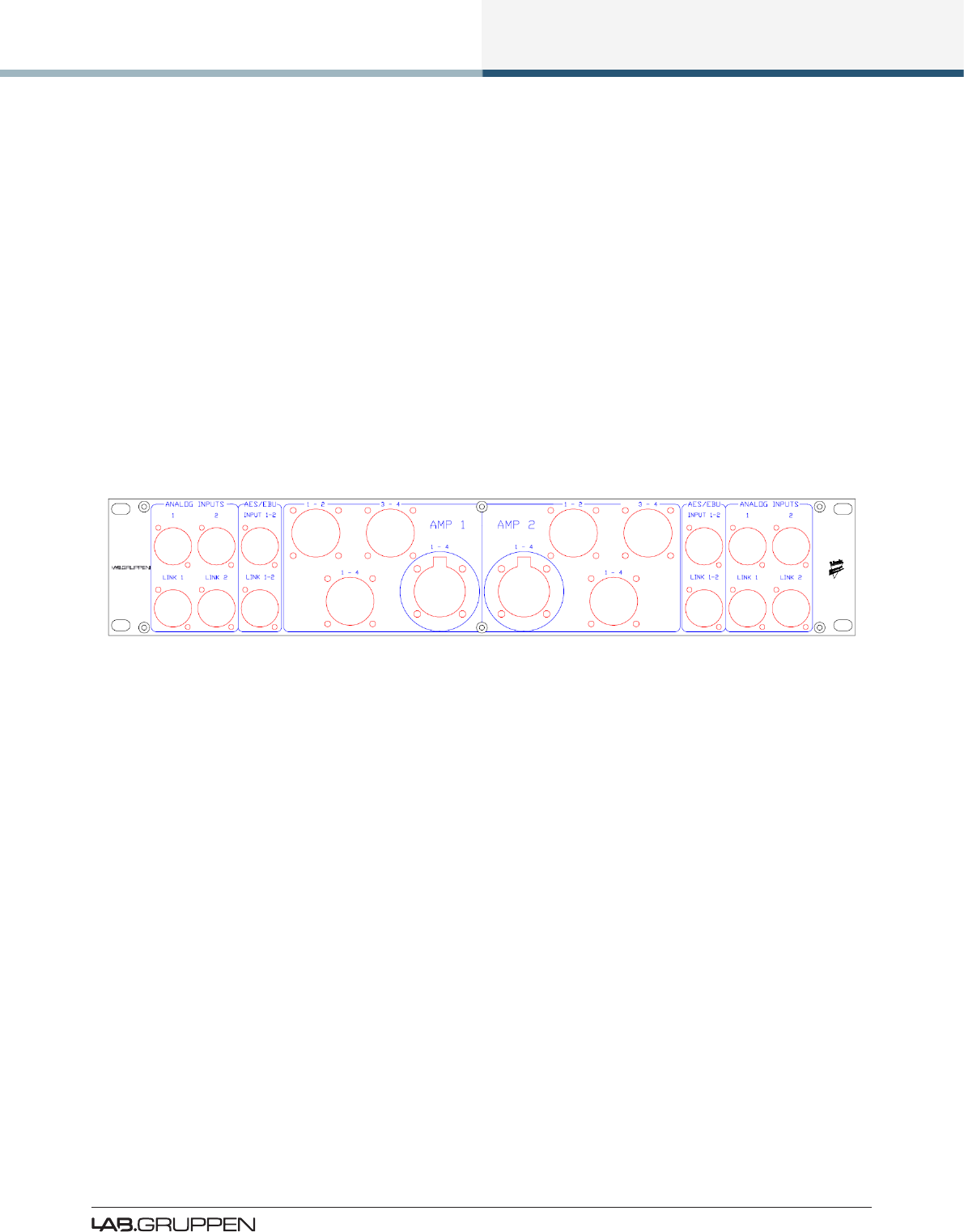
Application Guide
85
PLM Series Operation Manual Rev 1.3.0
10. Application Guide
This chapter describes the practical application and use of PLM Series devices.
10.1 Rack I/O Panels
For fast and simple system connection, pre-wired racks using connection panels can be used. With an
I/O connector panel tted to the front of the rack, all audio, loudspeaker, network and power cables can be
plugged in at one position, without requiring rear panel access.
Although rental companies and large system users may have existing preferred designs, Figure 10-1
provides a suggested layout. This example provides AES3 and analog audio connections; a separate panel
would be used for Ethernet connections.
Figure 10-1: Example I/O Connector Panel
10.2 Power Distribution
For professional applications it is recommended that the sum of the available mains power is above 3000
W per PLM (e.g. 230 V x 16 A, 120 V x 32 A). As PLM 20000Q devices are equipped with BEL, the cur-
rent draw of the device can be congured to perfectly match the power distribution. PLM 10000Q and
PLM 14000 are equipped with PAL, so the power supply will limit its mains current draw (both momentary
current draw and current draw over time) to be less than 28 A for the 230 V version and less than 53 A for
the 115 V version.
Safety approved equipment is not required to have a mains breaker, as long as this does not pose any re
hazard under fault conditions, as is the case with the PLM.
Please see the following examples suggesting power distribution methods across multiple PLM devices.
All of the examples given will work, although the rst examples for both 230 V and 115 V operation have a
slight advantage due to their “power sharing” ability.
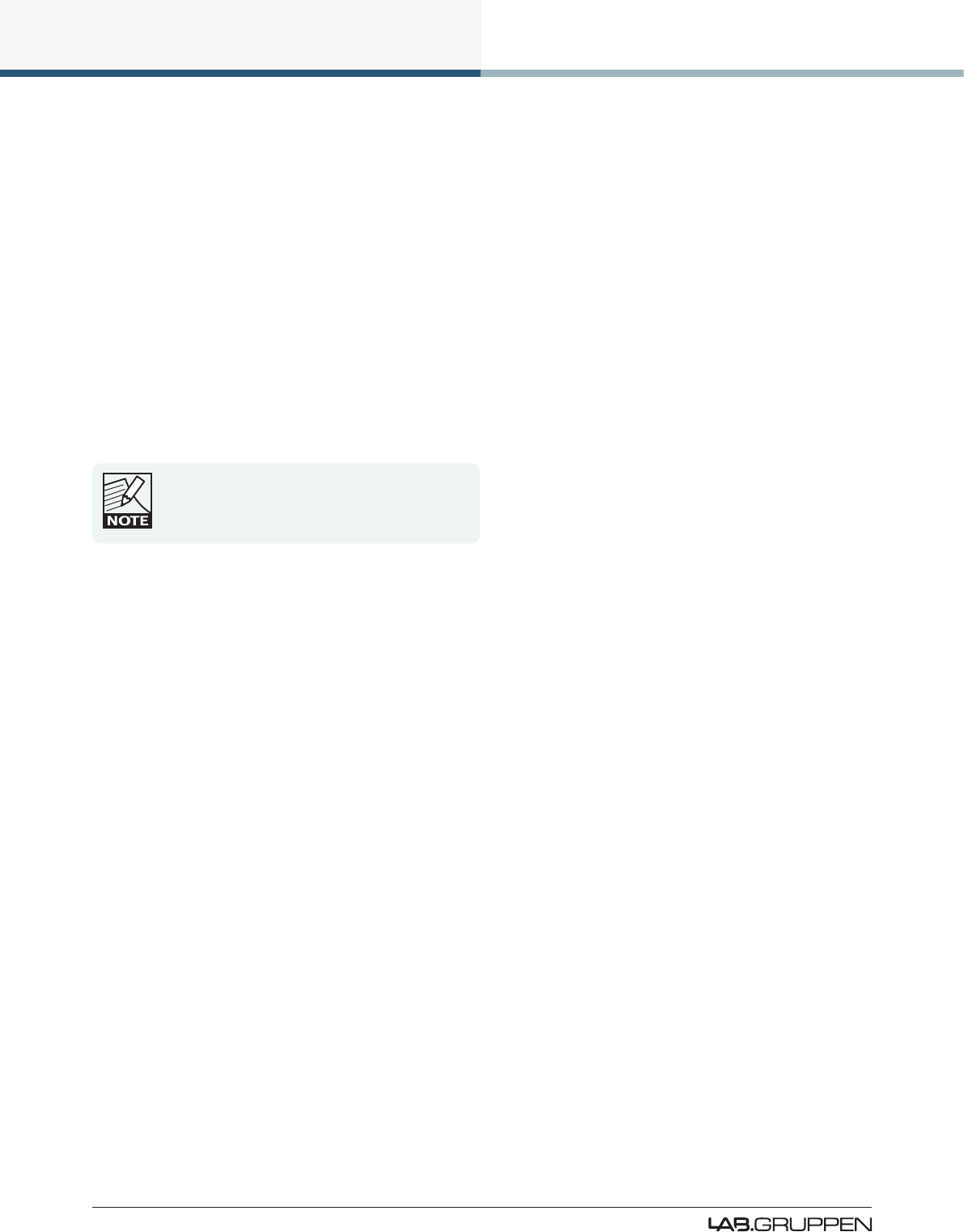
86
Application Guide
PLM Series Operation Manual Rev 1.3.0
10.2.1 Six PLM Series Devices with 230-240 V Mains Supply
If the mains supply is 230 V and the system requirement is six PLMs, then the mains capacity would need
to be able to provide 3 x 32 A. There are two methods of achieving this:
1. Three racks, each with two PLMs and a 32 A single-phase mains supply. The 32 A capacity is shared
between the two PLMs within the rack. This is benecial as the two PLMs don’t have to draw the
same current. The only limitation is that in combination they don’t draw over 32 A.
2. Three racks, each with two PLMs and a 16 A three-phase mains supply. This requires central power
distribution to be congured as two 3 x 16 A circuits from 3 x 32 A. One phase is used for each PLM
within the rack. This has the benet that each PLM has its own breaker, but they all have to operate
within the same limit of 16 A; therefore, more care must be taken to ensure that no breaker blows if
different loads are used.
The 230 V version of the PLM is equipped with a
slow-blow 30 A ceramic breaker.
10.2.2 Six PLM Series Devices with 100-120 V Mains Supply
If the mains supply is 115 V and the system requirement is 6 PLMs, then the mains capacity would need to
be able to supply two 3 x 30 A circuits. There are two methods of achieving this:
1. Two racks, each with three 230 V version PLMs and a 30 A three-phase mains supply. In the rack
the PLMs are connected between the phases, i.e. one between phase 1 and 2, one between phase
2 and 3 and the last between phase 3 and 1. Each 30 A mains breaker is shared between two PLMs
and the mains current is to some extent canceled. This has the benet that the three PLMs don’t
have to draw the same current; one can be allowed to draw a little more than the other two. The
only limitation is that in combination they don’t draw over 30 A.
2. Two racks, each with three 115 V version PLMs and a 30 A three-phase mains supply. One phase is
used for each PLM within the rack. This has the benet that each PLM has its own breaker, but they
all have to operate within the same limit of 30 A; therefore, more care must be taken to ensure that
no breaker blows if different loads are used.
10.3 Gain Structure
The PLM Series architecture provides gain adjustments at various points in the signal path and therefore,
various places for muting and level adjustment. Each mute or gain adjustment point serves a different
purpose. The signal ow diagrams in chapter 6 provide a useful reference for the signal path. The following
sections describe the various adjustment points, all of which are available via the Lake Controller software.

Application Guide
87
PLM Series Operation Manual Rev 1.3.0
10.3.1 Input Headroom (Analog Inputs Only)
Input Headroom should be set to 12 dBu if the source can be limited to 12 dBu; otherwise it should be set to
26 dBu. This setting does not affect the other gain stages, or the overall noise oor; it allows control of the
appropriate headroom at the input stage only.
To adjust, navigate to I/O CONFIG > INPUT CONFIGURATION in the Lake Controller. Please refer to the
Lake Controller Operation Manual for further details.
10.3.2 Input Mixer
Input Mixer gains can remain at 0.00 dB for most congurations; if only one input channel is used per
Module, the other can be set to -INF.
To adjust, navigate to I/O CONFIG and tap the Input Mixer blocks for the Module in the Lake Controller.
Please refer to the Lake Controller Operation Manual for further details.
10.3.3 Module Input Gain
Input Gain is used to adjust the level between different speaker cabinets in the system. This gain can remain
at 0.00 dB unless a lower level is required for the cabinet/s driven by this Module.
To adjust, navigate to MODULES > EQ/LEVELS > LEVELS in the Lake Controller. Please refer to the
Lake Controller Operation Manual for further details.
10.3.4 Module Output Gain
Factory and User Gain are provided for each Module output. These two stages provide a level of security
and control for the system designer (Factory) and a further level of adjustment for the user (User), both of
which combine to balance the level between frequency bands in a multi-way crossover (Contour congura-
tion) or the Module output level (Mesa conguration).
1. Factory Gain is set by the system designer and can be hidden within the Module le. The Factory
Gain parameter is only accessible when the Module is unlocked and the Lake Controller is in
Designer Mode. Adjust via MODULES > LEVELS > METER OPTIONS > ADJUST FACTORY.
2. User Gain is editable by a user unless the system designer has locked away the parameter; adjust
via MODULES > LEVELS.
Generally, output gain values are congured within a Module / loudspeaker preset le and should not need
to be adjusted further.

88
Application Guide
PLM Series Operation Manual Rev 1.3.0
10.3.5 Attenuator
An attenuator gain adjustment is provided for each power output channel in the PLM. This control replaces
the traditional volume control found on conventional ampliers and should typically be left at 0 dB during
use.
To adjust, navigate to I/O CONFIG > EVENTS & CONTROL > STATUS in the Lake Controller. Please refer to
the Lake Controller Operation Manual for further details.
10.3.6 Amp Gain
The Amp Gain corresponds to the gain adjustment in a conventional separate loudspeaker processor and
amplier system. When using a pre-dened Module loudspeaker preset le, the Amp Gain settings will
normally remain as dened in the le. The limiter and output gain settings of the Module were congured
with this gain setting and will not be automatically compensated if changes are made. This conguration
scheme, though unusual, allows for compatibility with legacy Dolby / Lake products.
When creating a loudspeaker preset Module le, adjust by navigating to I/O CONFIG >
EVENTS & CONTROL > CONTROL in the Lake Controller. Please refer to the Lake Controller Operation
Manual for further details.
10.4 Gain / Level Optimization
10.4.1 Maximize Volume Capability
To maximize the volume capability of the device, ensure there is sufcient headroom in the signal path to
avoid clipping before the limiters engage. It must be possible to achieve enough gain through the device to
engage the limiters and realize a high average SPL. As an optimal setting, allow for a headroom of 10 dB or
more for all channels; the simplest way to accomplish this is to increase the Module input gain.
10.4.2 Minimize Noise
To help provide the best volume to noise ratio, use an AES or Dante digital input signal wherever possible. If
using analog inputs, ensure that unused or unnecessarily high headroom is not introduced at the input to the
device. If full or high average power is not required, the Module input gain may be reduced.
10.4.3 Gain Optimization Examples
This section provides examples on performance effects resulting from changes to the PLM gain structure.
10.4.3.1 Digital Input Gain Structure Examples
Figure 10-2 illustrates the recommended conguration of the PLM when using an AES or Dante digital input.
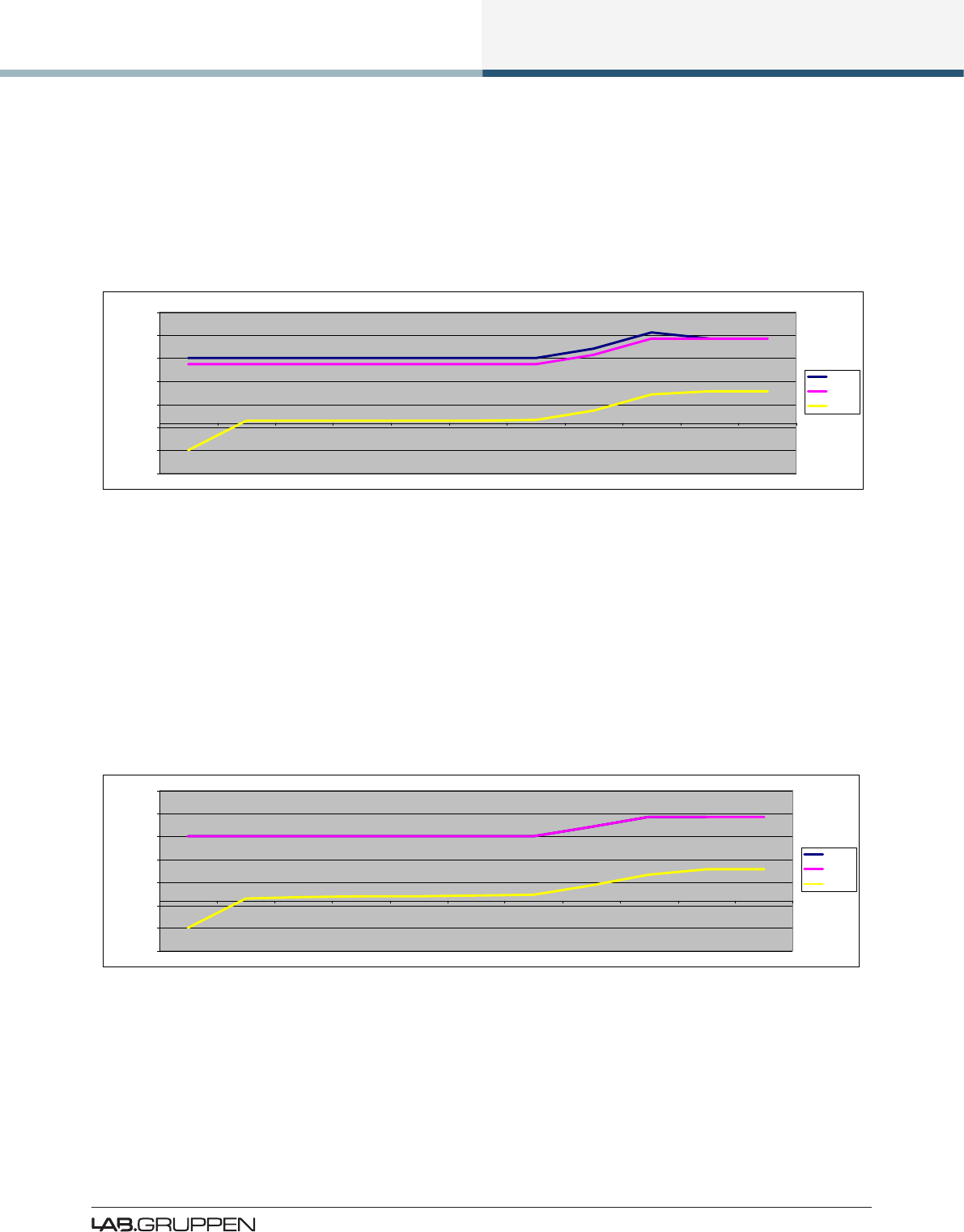
Application Guide
89
PLM Series Operation Manual Rev 1.3.0
▸Input Clip: 0 dBFS
▸Amp Gain: 35 dB
▸SNR: 114.2 dB
▸Absolute Noise Floor: -71.3 dBu
-250,0
-200,0
-150,0
-100,0
-50,0
0,0
50,0
100,0
Analog AES Input Input Mixer Module In Module Out Amp Attenuation Analog Ref Amp Gain ISVPL Output
dB/dBu
Clip
Nominal
Noise
Figure 10-2: Digital Input: Low Noise with Good Headroom (High Input / High SPL)
Figure 10-3 illustrates how to achieve the lowest possible output noise, although this is not a recommended
conguration.
▸Input Clip: 0 dBFS
▸Amp Gain: 22 dB
▸SNR: 114.8 dB
▸Absolute Noise Floor: -71.9 dBu
-250,0
-200,0
-150,0
-100,0
-50,0
0,0
50,0
100,0
Analog AES Input Input Mixer Module In Module Out Amp Attenuation Analog Ref Amp Gain ISVPL Output
dB/dBu
Clip
Nominal
Noise
Figure 10-3: Digital Input Optimized for Minimum Noise - Not Recommended
The improvement in noise performance (at the cost of losing headroom and compression features) is only
0.6 dB; it is therefore not recommended to optimize performance in this manner.
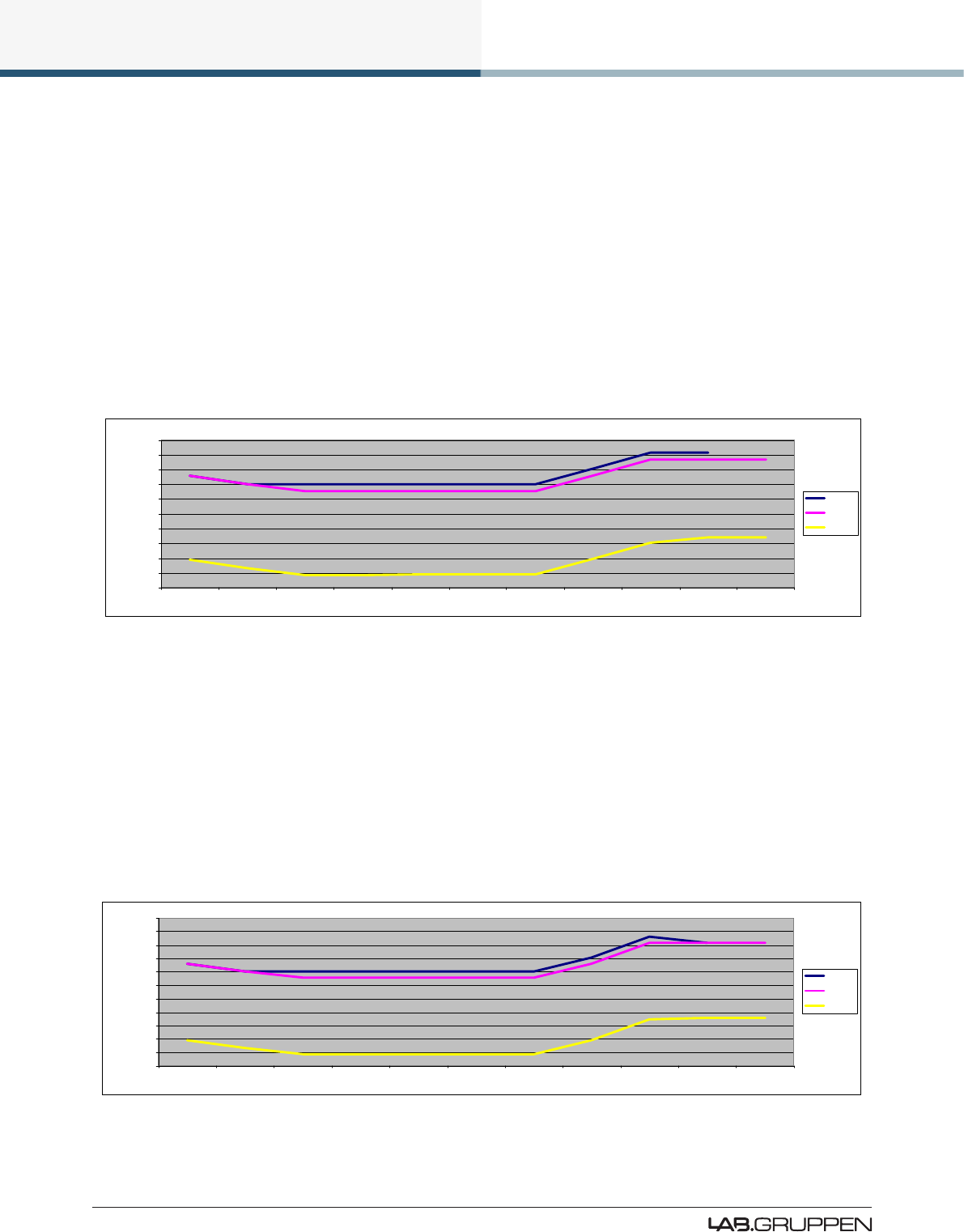
90
Application Guide
PLM Series Operation Manual Rev 1.3.0
10.4.3.2 Analog Input Gain Structure Examples
Figure 10-4 illustrates how to minimize absolute noise while limiting the available SPL.
Input Clip: 12 dBu
▸Amp Gain: 22 dB
▸SNR: 105.5 dB
▸Absolute Noise Floor: -71.5 dBu
▸SPL is limited to -8.9 dB relative to clip in this minimum absolute noise level example
-140,0
-120,0
-100,0
-80,0
-60,0
-40,0
-20,0
0,0
20,0
40,0
60,0
Analog AES Input Input Mixer Module In Module Out Amp Attenuation Analog Ref Amp Gain ISVPL Output
dB/dBu
Clip
Nominal
Noise
Figure 10-4: Analog: Low Noise with Limited Output (Low Input / Low SPL)
Figure 10-5 illustrates how to minimize absolute noise while achieving full power. In this illustration it can be
seen that there is no available headroom.
▸Input Clip: 12 dBu
▸Amp Gain: 30.9 dB
▸SNR: 111.3 dB
▸Absolute Noise Floor: -68.4 dBu
-140,0
-120,0
-100,0
-80,0
-60,0
-40,0
-20,0
0,0
20,0
40,0
60,0
80,0
Analog AES Input Input Mixer Module In Module Out Amp Attenuation Analog Ref Amp Gain ISVPL Output
dB/dBu
Clip
Nominal
Noise
Figure 10-5: Analog: Low Noise with Full Output Power (Low Input / High SPL)
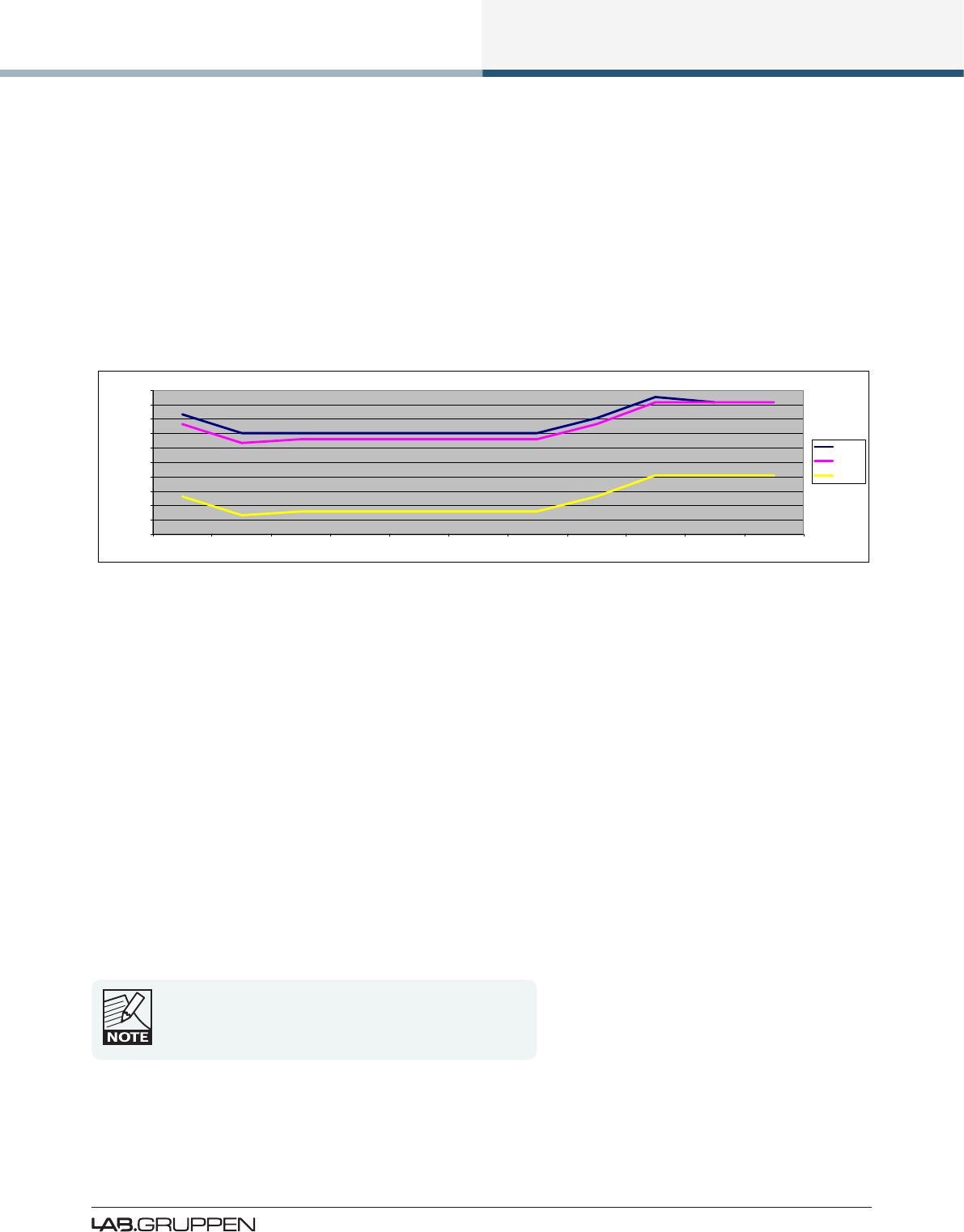
Application Guide
91
PLM Series Operation Manual Rev 1.3.0
Figure 10-6 illustrates how moderate noise with extreme SPL can be achieved. SPL is extremely high in
this example as maximum headroom is available at the input and within the processing stage. This makes it
possible to increase the average SPL by utilizing internal compression capabilities.
▸Input Clip: 0 dBFS
▸Amp Gain: 35 dB
▸SNR: 114.2 dB
▸Absolute Noise Floor: -71.3 dBu
-140.0
-120.0
-100.0
-80.0
-60.0
-40.0
-20.0
0.0
20.0
40.0
60.0
Analog AES Input Input Mixer Module In Module Out Amp Attenuation Analog Ref Amp Gain ISVPL Output
dB/dBu
Clip
Nominal
Noise
Figure 10-6: Analog Input: Moderate Noise with Very High Output (Very High SPL)
10.5 Speaker Congurations
Connecting two speakers in parallel to a PLM power output presents a load to the amplier which is half the
impedance of that presented by one speaker. Therefore, the current that two speakers will attempt to draw
from the output stage is double that for one speaker, and this higher current may be sufcient to cause the
Current Peak Limiter to become active. The more speakers connected to an output in parallel, the lower the
impedance and the higher the current draw.
Multiple loudspeakers may be driven by a PLM power output more satisfactorily if a series-parallel wiring
conguration is adopted. Please ensure care is taken to match polarity correctly.
When using series-parallel wiring, the nominal impedance is the same as with one speaker; however, the
principle of power sharing still applies, and it is not possible to get the amplier section to deliver more than
its rated power.
Nominal loads as low as 2 ohms are supported by the PLM.
However, a 2 ohm nominal load has impedance dips at its
resonances below 2 ohms; in such cases it is likely that the
resulting higher current will cause CPL to activate.

92
Application Guide
PLM Series Operation Manual Rev 1.3.0
10.6 Digital Audio Connections
Whenever possible, it is preferable to connect a digital rather that analog input signal to the device. This is
particularly relevant if the source signal is already in the digital domain, such as the source from a digital
mixing console or digital distribution system. The primary cause of signal distortion and signal delay (latency)
is the digital-to-analog and analog-to-digital conversion process. Therefore, using digital inputs normally
provides higher quality audio with lower latency.
Two types of digital audio inputs are available: Dante networked multi-channel digital audio, and 2-channel
digital audio via the AES3. Dante-based system congurations and interconnections are explained in a
separate document, the Lake Network Conguration Guide.
The information in this section is supplied for users unfamiliar with AES3. Users already familiar with AES3
will nd that the device conforms to established conventions.
10.6.1 AES3 Digital Audio
The original AES/EBU digital audio interface standard was developed by the Audio Engineering Society in
conjunction with the European Broadcast Union. Originally published in 1985, it was revised in 1992 and
2003, and in its current iteration it is properly designated the AES3 standard.
AES3 is a serial transmission format for linearly represented (uncompressed) digital audio data. It describes
a method for carrying two channels of periodically sampled and uniformly quantized audio signals on a single
twisted-pair cable.
The data format allows for auxiliary data which can be used for information on signal characteristics as well
as the sampled audio data. The physical interconnection, as dened by IEC 60958 Type I, species three-
conductor 110-ohm twisted pair cabling terminated by an XLR connector. Please refer to section 8.3 for
wiring details.
AES3 provides for multiple sampling rates and resolutions of up to 24 bits; this device accepts sample rates
from 44.1 to 192 kHz.
10.6.2 System Latency and Delay Compensation
All types of digital audio processing inherently involves a small processing delay referred to as latency. If the
processing chain does not involve analog-to-digital or digital-to-analog conversion, the amount of latency is
usually very small and often may be disregarded.
However, in complex systems involving multiple digital audio components and connections, enough delay
may be generated to cause audio phasing problems. Therefore, the lowest latency is always preferred, and
it is always important to consider system latency delays when calculating and adjusting overall delay for
time-aligning multiple loudspeaker systems.
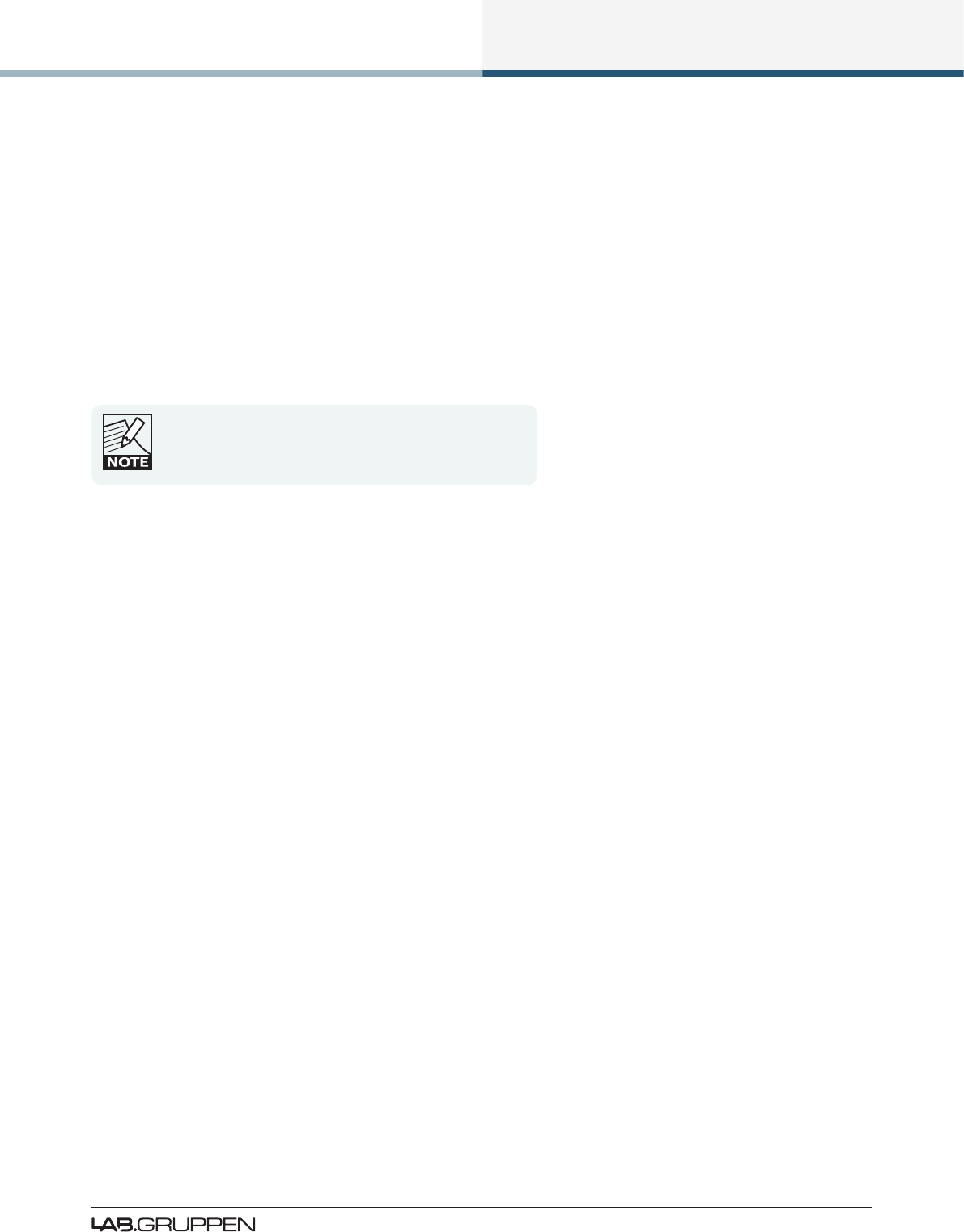
Application Guide
93
PLM Series Operation Manual Rev 1.3.0
10.6.3 Connections and Cabling
10.6.3.1 Input and Link Connectors
An AES3 input signal is connected to the XLR3F connector labelled INPUT 1-2 in the AES3 input section
on the rear panel. An XLR3M connector, labelled LINK 1-2 is provided as a loop-through output for daisy-
chaining multiple PLM Series devices.
The Input and Link connectors are identical for the analog and digital inputs, so care must be taken when
connecting audio, particularly when analog inputs are used as a backup signal source. Connectors should be
clearly labeled to prevent any confusion.
Never connect a digital signal source to an analog input or an
analog signal source to a digital input.
10.6.3.2 Interconnection Options
If multiple PLM Series devices are receiving the same AES3 signal, connections may be congured in two
ways:
1. Daisy-Chain – Connect the signal source (e.g. mixing console, digital snake or distribution amplier)
to the AES3 input on the rst PLM. Connect the adjacent Link output on the same unit to the Input
on the next PLM, and continue connecting in this manner. Up to 20 PLM units may be daisy-chained
in this manner, though the total may be dependent on environmental conditions and the quality of
connecting cables.
2. AES3 Distribution Amplier – Connect the input of the distribution amplier to the signal source, and
connect the outputs individually to the PLMs. The number of available outputs must be equal to or
greater than the number of PLM devices to be driven. The distribution amplier must be specically
designed for AES3 signals; a device made for analog signals will not function in this capacity. Please
refer to section 10.6.4 for further information.
Consider the application requirements carefully before choosing an interconnection conguration. Note that
the daisy-chain option presents a potential single-point-of-failure scenario; failure of one cable or connection
will affect all subsequent devices in the chain. Use of distribution ampliers avoids this scenario, although
extra expense is involved and potential failure of the distribution amplier itself is introduced.
10.6.3.3 Cable Types and Distance Limitations
All digital connections should be made with 100 ohm balanced cables wired according to the AES3
standard (see Figure 8-11 on page 68). Although standard analog microphone cabling may function in limited
circumstances, the potential for problems is greatly increased. AES3 contains a high-speed data stream, and
requires an effective bandwidth of up to 12 MHz, far beyond the 20 kHz required for analog audio.

94
Application Guide
PLM Series Operation Manual Rev 1.3.0
The distance allowed between a signal source and the PLM is dependent on both cable quality and the
sampling rate used. At a 96 kHz sampling rate, any good quality AES3 cable should allow a cable run of
100 meters with no data losses beyond the capability of internal error correction. The best cables may allow
longer cable runs, though careful trials are recommended before use in the eld. Sampling rate also governs
allowed cable length; a 100 meter length at 96 kHz might extend to 200 meters at 48 kHz, but be cut to
50 meters at 192 kHz.
10.6.3.4 Signal Degradation and Loss
A weak or degraded AES3 signal will exhibit no audible loss of quality as long as the robustness of the
data stream remains above the threshold required for internal error correction. As degradation approaches
the threshold, audible artifacts may be heard, including pops, clicks and momentary dropouts. Any such
indications require immediate attention, as often the window of acceptable data loss between artifacts and
complete audio loss can be very narrow.
As a precautionary measure four touring applications, it is advisable to congure all digital audio wiring
prior to use. It is recommended that all cables be tested for error-free performance at lengths 20% to 25%
greater than lengths to be used in the eld in order to provide a comfortable margin of safety.
10.6.4 External Signal Distribution Hardware
10.6.4.1 Distribution Ampliers
Dedicated distribution ampliers for AES3 signals are available from several manufacturers. The most com-
mon format is one input and six outputs. Digital distribution ampliers are designed to refresh or reconstruct
the signal as well making up for line losses.
One type of distribution amplier is a simple repeater, which restores the waveform shape and brings the
signal amplitude back up the required level. Some distribution ampliers also offer a re-clocking feature,
which also re-times the signal to prevent signal degradation from clocking errors known as jitter.
Distribution ampliers that offer re-clocking often make the feature optional as using re-clocking can intro-
duce small additional amounts of latency, so should not be used unless necessary.
10.6.4.2 Passive splitters
In some limited applications, a single AES3 input may be split into two signals using a simple passive
splitter. Splitters provide a convenient and low cost solution when only one additional signal is required, and
in situations where cable lengths are short. Attenuation is minimal, but there is no refreshing of the signal.
10.6.5 Additional Reference Material
Complete technical information on the AES/EBU (AES3) standard can be downloaded from the AES web
site at http://www.aes.org/publications/standards/.
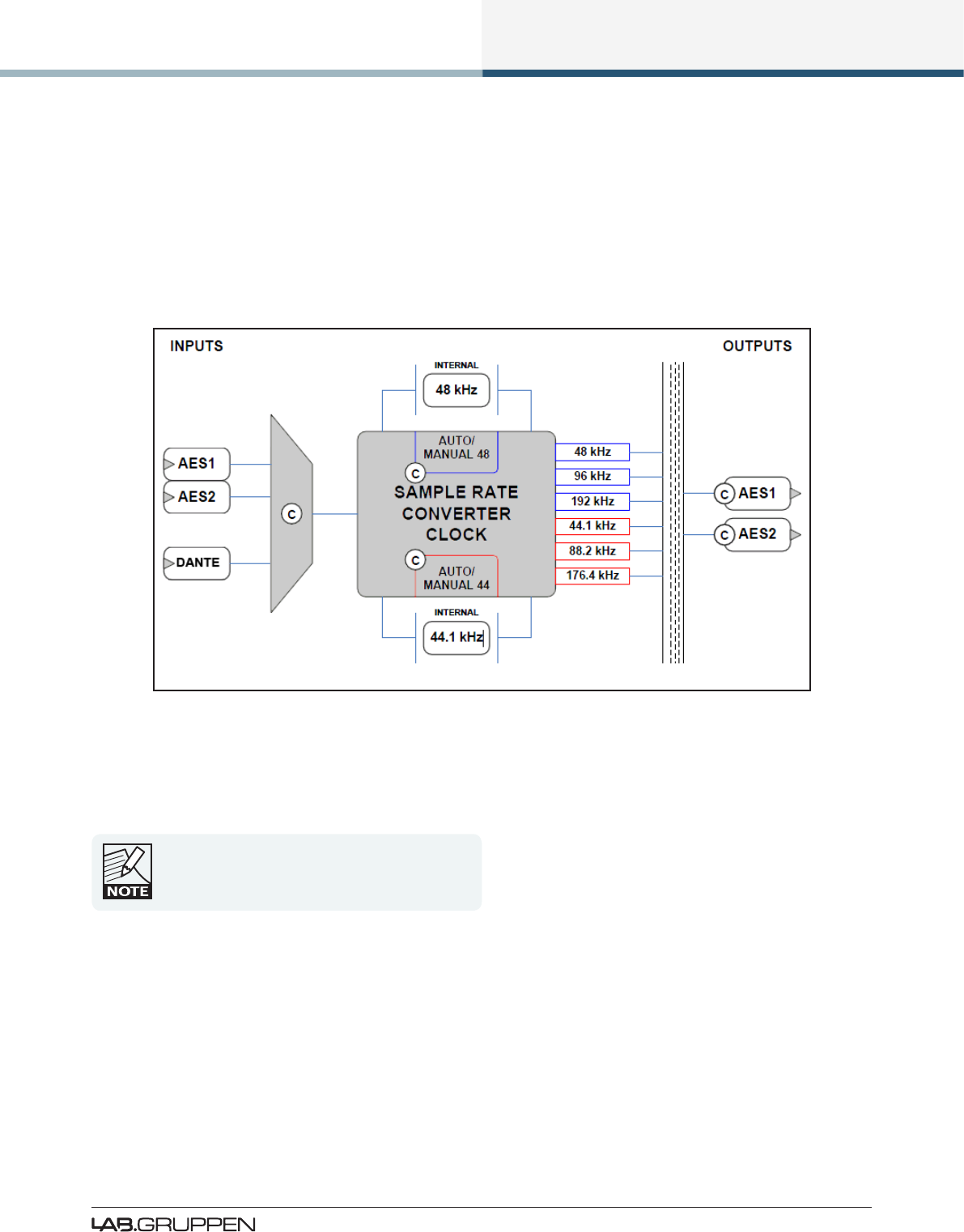
Application Guide
95
PLM Series Operation Manual Rev 1.3.0
10.7 Digital Clock Conguration
10.7.1 Digital Clock Overview
In order to provide a exible and robust audio processing system, the device is equipped with a congurable
digital clocking system. The digital clock can generate various independent internal sample rates, or can
sync to an incoming AES3 signal. Figure 10-7 shows the various sample rates and options available.
Figure 10-7: Digital Clocking System
In Figure 10-7, each circled C represents a choice point. A choice point is a user‐interface control that can
be congured using the Lake Controller software. Please refer to the Lake Controller Operation Manual for
further information.
Figure 10-7 indicates internally generated clocks
with base-rate multiples of 44.1 kHz or 48 kHz. This
should not be confused with the internal DSP
sample rate of 96 kHz.
The PLM digital clocking system can either generate its own internal clock, or synchronize to an incoming
external clock source via the AES3 digital input.
10.7.2 Clock Source Priorities
There are two options for clock source conguration: Manual Conguration or Automatic Detection.
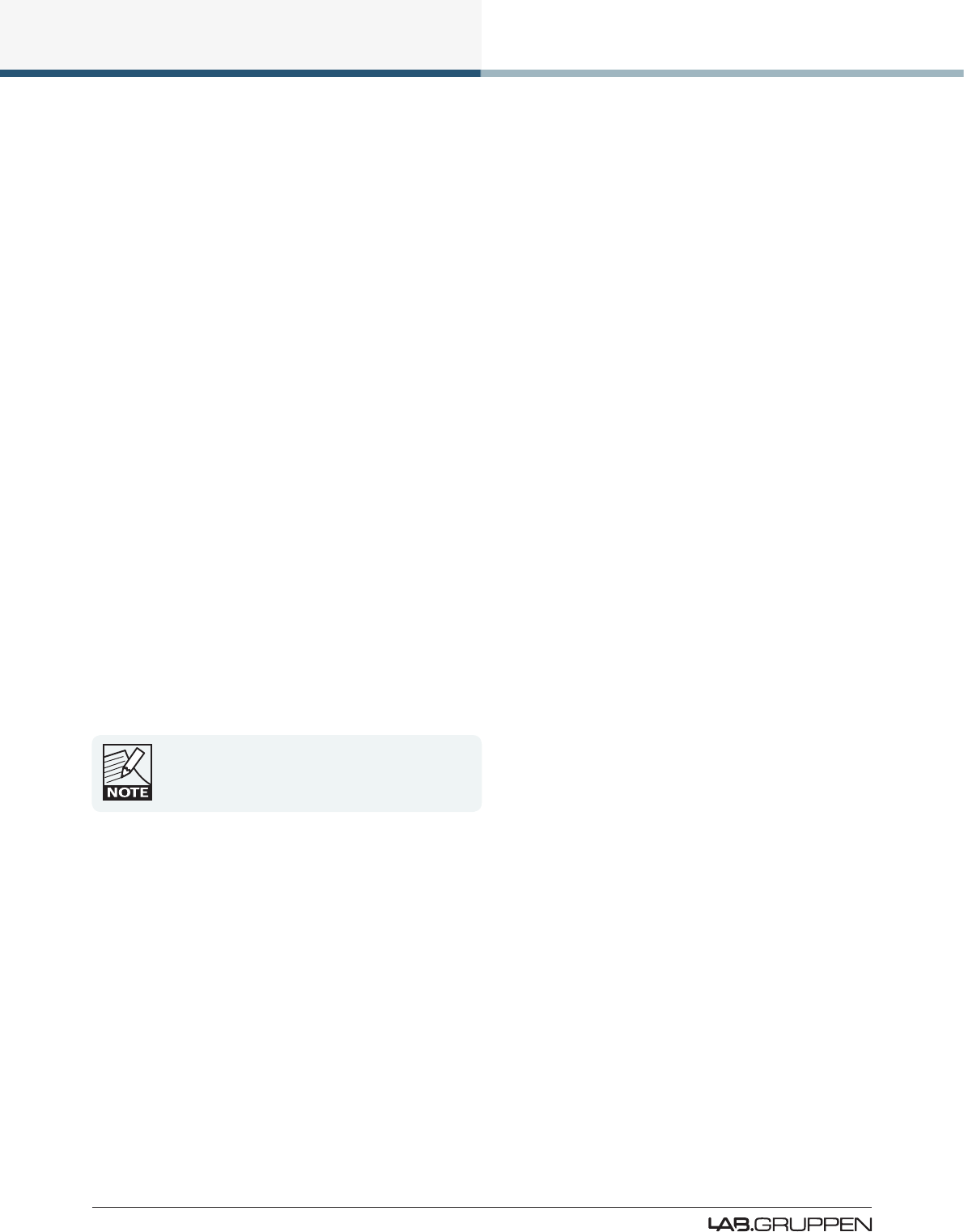
96
Application Guide
PLM Series Operation Manual Rev 1.3.0
For Manual Conguration, the selected internal or external clock source remains xed regardless of whether
a compatible clock signal is preset.
For Automatic Detection, the most appropriate clock matching the selected base-rate is automatically
selected according to the following priorities.
1. AES1 (Input 1+2)
2. Internal Clock
When using automatic detection, the AES3 digital input is monitored and will switch the clock source back
and forth depending on the availability of an AES3 signal.
Please refer to the Lake Controller Operation Manual for additional information.
10.7.3 Dante Clock Conguration
Dante uses its own digital clocking technology across the Ethernet network to ensure that all Dante devices
are synchronized. As part of this logic, an order of priority is dened to identify which device becomes
the Dante Master. A Dante-capable device with a valid BNC Word Clock is chosen as the highest priority,
followed by a device with a valid AES3 signal, then SPDIF, then an internally generated clock.
Dante only operates at 48 kHz or 96 kHz, with the PLM digital clock on all Dante Slaves being overridden by
the Dante Clock.
The front panel Input View indicates if that device is selected as Dante Clock Master. Conrmation of Dante
Master / Slave status is also displayed in the Lake Controller.
For further information on Digital Clock congura-
tion and the Lake Controller user interface, please
refer to the Lake Controller Operation Manual.
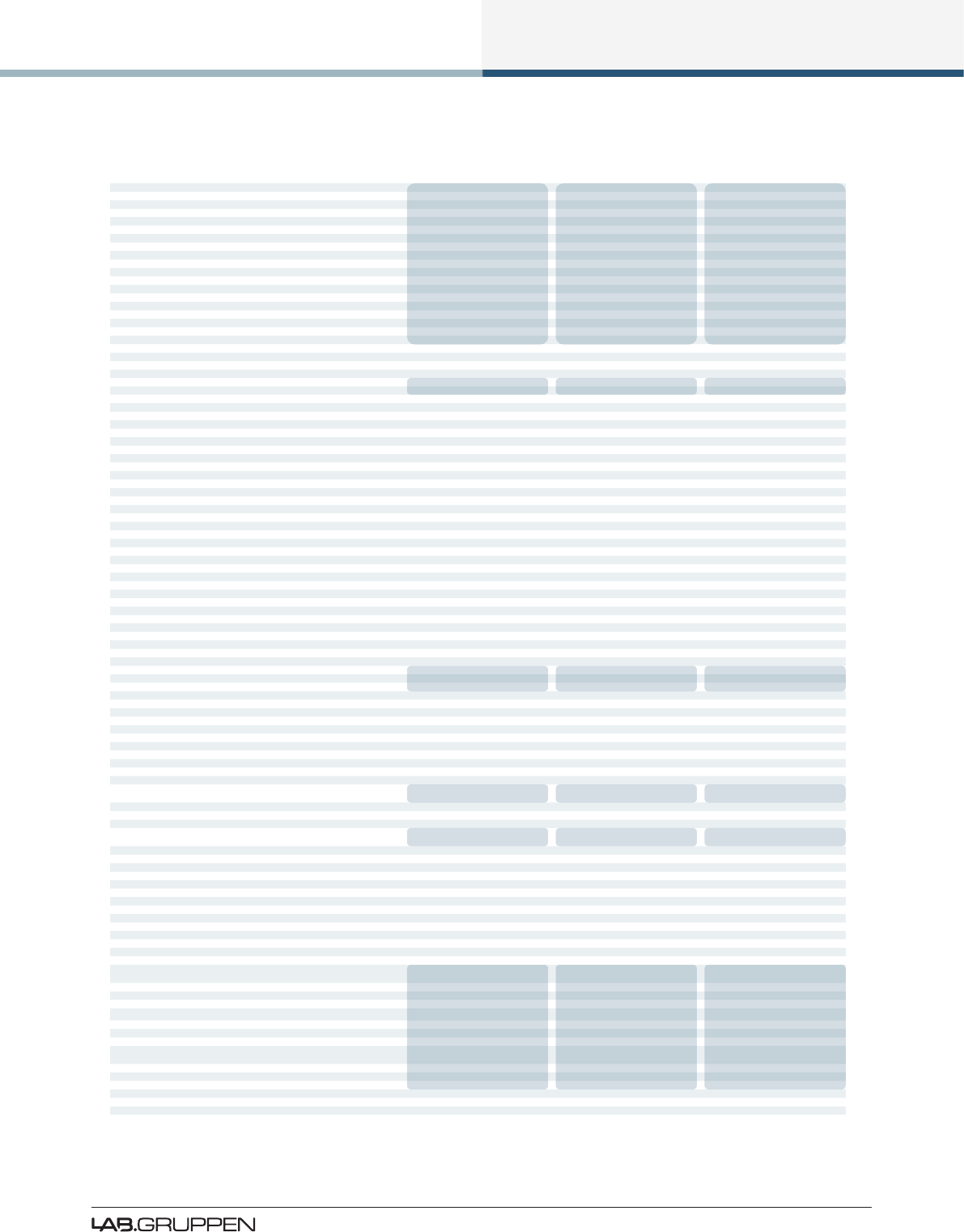
Technical Specications
97
PLM Series Operation Manual Rev 1.3.0
11. Technical Specications
Model
Number of input channels
Number of output channels
Peak total output all channels driven
Max. Peak output voltage per channel
Max. output current per channel
Max. Output Power
16 ohms per ch. (all ch.’s driven)
8 ohms per ch. (all ch.’s driven)
4 ohms per ch. (all ch.’s driven) 1)
2 ohms per ch. (all ch.’s driven) 1)
All channels driven into optimal impedance interval
8 ohms bridged per ch.
4 ohms bridged per ch.
Bridged into optimal impedance interval
Audio Performance
THD + N 20 Hz - 20 kHz for 1 W <0.05%
THD + N at 1 kHz and 1 dB below clipping <0.04%
Dynamic range with digital inputs (for all supported sample rates)
Dynamic range with analog inputs
Frequency response (1 W into 8 ohms, 20 Hz - 20 kHz) + /-0.05 dB
Common Mode Rejection (CMR) >74 dB, 20 Hz to 20 kHz
Internal sample rate 96 kHz
Internal data path 32 bit oating point
Product propagation delay, best case (96 kHz AES) 1.61 ms
Product propagation delay, analog input 1.68 ms
Sample Rate Converters
THD + Noise 0.00003 %, 20 Hz - 20 kHz, unweighted
Analog to Digital inputs
Inputs 2 inputs x 2 link
Input sensitivity settings +12 or +26 dBu
THD + Noise 0.00022 %, typical at 1 kHz unweighted at +26 dBu headroom setting
0.00033 %, typical at 20 Hz and 20 kHz unweighted at +26 dBu headroom setting
AES / EBU inputs
Inputs 2 inputs x 2 link
Supported resolutions ≤ 24 bit
Supported sample rates 44.1, 48, 88.2, 96, 176.4, 192 kHz
Dante Audio Network
Inputs and outputs 2 inputs, 2 outputs
Supported sample rates 48, 96 kHz
Supports redundant paths Yes
Flexible topology Yes
Network latency 0.8, 1.3 and 4 ms
Device presets
Local memory locations for the settings of the product 100
Limiters
Adjustable Inter-Sample Voltage Peak Limiter (ISVPL)
Current Peak Limiter < 300 ms
Current Average Limiter (CAL) > 300 ms
LimiterMax (rms and peak limiters)
– MaxRMS (rms voltage limiter) Yes
– MaxPeak (peak voltage limiter) Yes
Gain
Ampli er gain 22 - 44 dB, step size 0.1 dB
Output attenuator -Inf to 0 dB, step size 0.25 dB
Rear-panel interface
AES / EBU / I/O (input + link) 2 x 3-pin XLR
Analog, 2-channel I/O (input + link) 4 x 3-pin XLR, electronically balanced
Output connectors
Auto 10/100, Auto Uplink 2 x RJ45 etherCON
Control and monitoring interface Via Ethernet for Lake Controller software, or DLM (the 3rd Party Protocol)
Detachable mains cord Neutrik powerCON 32 A
Cooling
Front-panel user interface
Display 2.5 inch, daylight readable LCD
Fault/Warning/Limit/Clip indicators RGB LEDs and detailed fault description on display
Mute and soft function buttons 8 provided
Standby Power button On/Standby
Mute Enable button Enables muting of outputs and inputs via soft-button keypad
Meter button Toggles through meter views
Menu button Provides a menu driven interface for full function front panel control
Rotary Encoder Yes
Exit button Provides a “back” function
Power
Operating voltage (45 - 66 Hz)
Soft start / Inrush Current Draw
Power Average Limiter (PAL)
Power Factor Correction (PFC)
Breaker Emulation Limiter (BEL), software controlled 5 - 32 A
Under-Voltage Limiter (UVL)
Dimensions
Rack rail to rear panel
Overall depth including handles and rear support
Weight
Finish Black painted steel chassis with black painted steel / aluminum front
Approvals CE, ANSI/UL 60065 (ETL), CSA C22.2 NO. 60065, FCC
Note 1): Asymmetrical loading of the outputs will yield even higher ratings. If one (or two) channel(s) has reduced power requirements, then the voltage drop from the power supply will be reduced,
resulting in higher power availability for the other channel(s).
Note 2): Separate 230 V or 115 V versions available. Not selectable on the product.
All specifications are subject to change without notice.
PLM 20000Q PLM 14000 PLM 10000Q
222
424
20000 W 14000 W 10800 W
194 V 193 V 153 V
67 A peak 90 A peak 49 A peak
1150 W 1150 W 660 W
2300 W 2300 W 1300 W
4400 W 4300 W 2300 W
4800 W 7000 W 2350 W
>5000 W into 2.2 - 3.3 ohms >7000 W into 1.8 - 2.1 ohms >2700 W into 2.4 - 3.2 ohms
8800 W 8600 W 4600 W
9600 W 14000 W 4700 W
>10000 W into 4.4 – 6.6 ohms >14000 W into 3.6 – 4.2 ohm >5400 W into 4.8 – 6.2 ohms
>114 dB >114 dB >116 dB
>110 dB >110 dB >112 dB
17.8 - 194 V, step size 0.1 V 17.8 - 193 V, step size 0.1 V 17.8 - 153 V, step size 0.1 V
67 A peak 90 A peak 49 A peak
33 Arms 44 Arms 25 Arms
Neutrik speakON (1 x NLT8, 2 x NLT4)
or 4 Binding Posts (pairs)
Neutrik speakON (2 x NLT4)
or 4 Binding Posts (pairs)
Neutrik speakON (1 x NLT8, 2 x NLT4)
or 4 Binding Posts (pairs)
Three fans front-to-rear airflow,
temperature controlled speed
Two fans front-to-rear airflow,
temperature controlled speed
Two fans front-to-rear airflow,
temperature controlled speed
Universal power supply 70 - 265 V 140-265 V / 70-135 V 2) 140-265 V / 70-135 V 2)
Yes / max. 8 A Yes / max. 5 A Yes / max. 5 A
Yes Yes Yes
Yes No No
Yes, selectable breaker pro le No No
Yes No No
W: 483 mm (19”), H:88 mm (2 U),
D: 424 mm (16.7”)
W: 483 mm (19”), H: 88 mm (2 U),
D: 386 mm (15.2”)
W: 483 mm (19”), H:88 mm (2 U),
D: 386 mm (15.2”)
498 mm (19.6”) 460 mm (18.1”) 460 mm (18.1”)
17 kg (37 lbs.) 13.5 kg (30 lbs.) 13.5 kg (30 lbs.)

98
Warranty and Support
PLM Series Operation Manual Rev 1.3.0
12. Warranty and Support
12.1 General
This product is manufactured by Lab.gruppen, and it is warranted to be free from any defects caused by
components or factory workmanship, under normal use and service, for a period of three (3) years from date
of purchase from an authorized Lake dealer.
If the product fails to perform as specied during the warranty period, Lab.gruppen will undertake to repair,
or at its option, replace this product at no charge to its owner, provided the unit is returned undamaged,
shipping prepaid, to an authorized service facility or to the factory.
This warranty shall be null and void if the product is subjected to: repair work or alteration by a person
other than those authorized by us; mechanical damage including shipping accidents; war, civil insurrection,
misuse, abuse, operation with incorrect AC voltage; incorrect connections or accessories; operation with
faulty associated equipment; or exposure to inclement weather conditions. Damage due to normal wear and
tear is not covered by the warranty. Units on which the serial number has been removed or defaced will not
be eligible for warranty service.
Lab.gruppen shall not be responsible for any incidental or consequential damages. Lab.gruppen’s responsi-
bility is limited to the product itself. Lab.gruppen takes no responsibility for any loss due to cancellation of
any events, or rent of replacement equipment or costs due to a third party’s or customer’s loss of prot, or
any other indirect cost or losses however incurred.
Lab.gruppen reserves the right to make changes or improvements in design or manufacturing without
assuming any obligation to change or improve products previously manufactured.
This warranty is exclusive, and no other warranty is expressed or implied. This warranty does not affect the
customer’s statutory rights.
12.2 International Warranties
Please contact your supplier or distributor for this information, as rights and disclaimers may vary from
country to country.
12.3 Technical Assistance and Service
12.3.1 International Service
If your Lab.gruppen product requires repair, contact your Lab.gruppen dealer or distributor, or contact Lab.
gruppen by fax or email to obtain the location of the nearest authorized service centre.

Warranty and Support
99
PLM Series Operation Manual Rev 1.3.0
12.3.2 Factory Service
In the event a Lab.gruppen product requires factory service, you may contact Lab.gruppen’s service depart-
ment for return instructions and a Return Authorization number.
Please note for product return:
1. Use the original packing.
2. Include a copy of the sales receipt, your name, return address, phone and fax number, email address
and description of the defect.
3. Mark the Return Authorization number on the outside of the packing.
4. Ship the product prepaid to:
Lab.gruppen
Faktorvägen 1
SE-434 37 Kungsbacka
SWEDEN
Phone: +46 300 56 28 00
Fax: +46 300 56 28 99
service@labgruppen.com
www.labgruppen.com
12.4 Trademarks
Intercooler, Class TD and Lake are national and/or international registered trademarks of Lab.gruppen AB.
PLM, Powered Loudspeaker Management, R.SMPS, LoadLibrary, LoadSmart, SpeakerSafe, ISVPL, BEL,
UVL and CAL are trademarks of Lab.gruppen AB.
Dolby is a registered trademark of Dolby Laboratories. Raised Cosine Equalization, LimiterMax and Iso-Float
are trademarks of Dolby Laboratories. Audinate is a registered trademark of Audinate Pty Ltd. Dante and Zen
are trademarks of Audinate Pty Ltd.
All other trademarks remain the property of their respective owners.
Copyright © 2012 Lab.gruppen AB. All rights reserved.
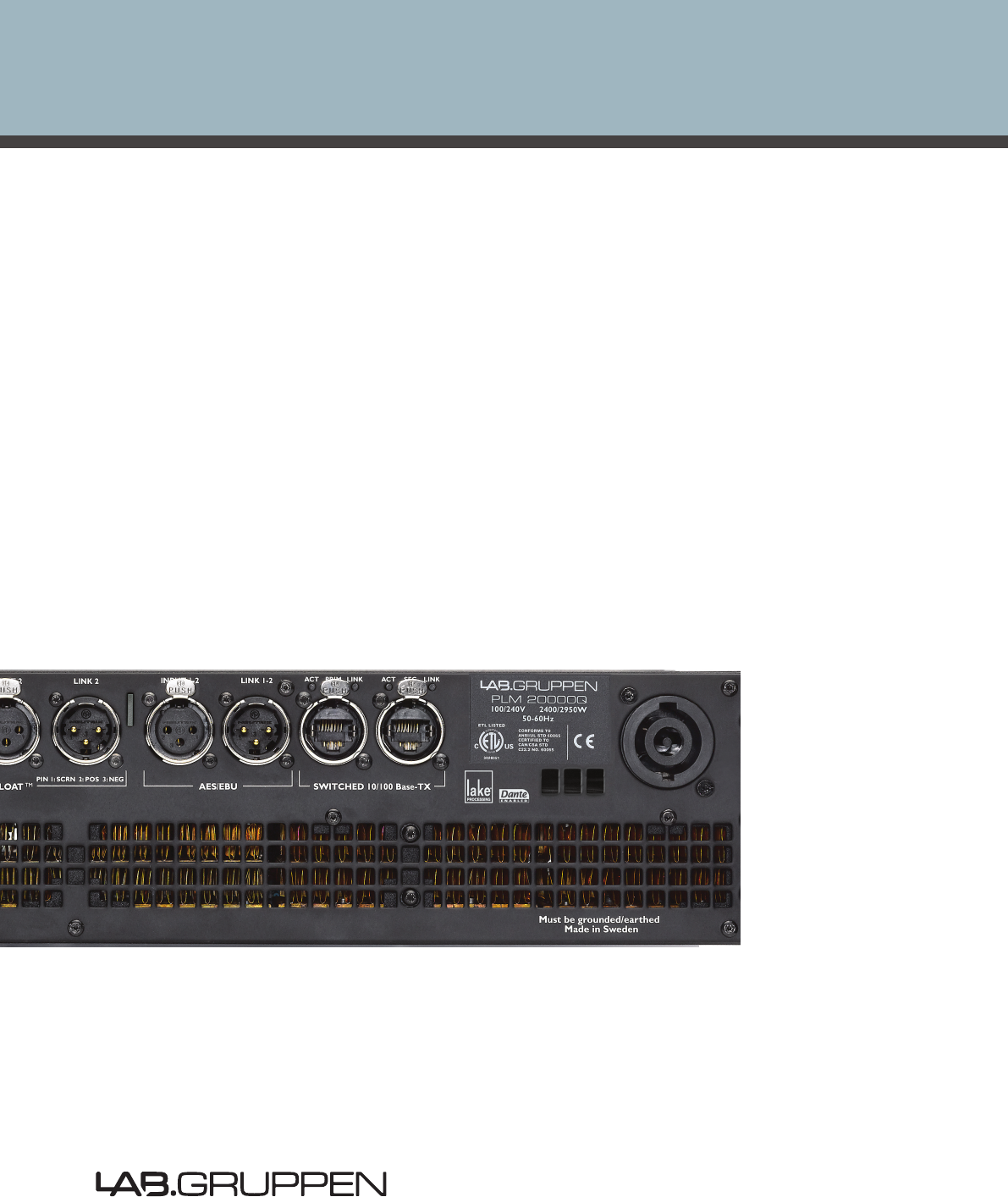
Operation Manual
Operation Manual
L A B . G R U P P E N A B ► S W E D E N
I N T E R N A T I O N A L C O N T A C T ► I N F O @ L A B G R U P P E N . C O M
U S & C A N A D A C O N T A C T ► I N F O @ T C G - A M E R I C A S . C O M
w w w . l a b g r u p p e n . c o m